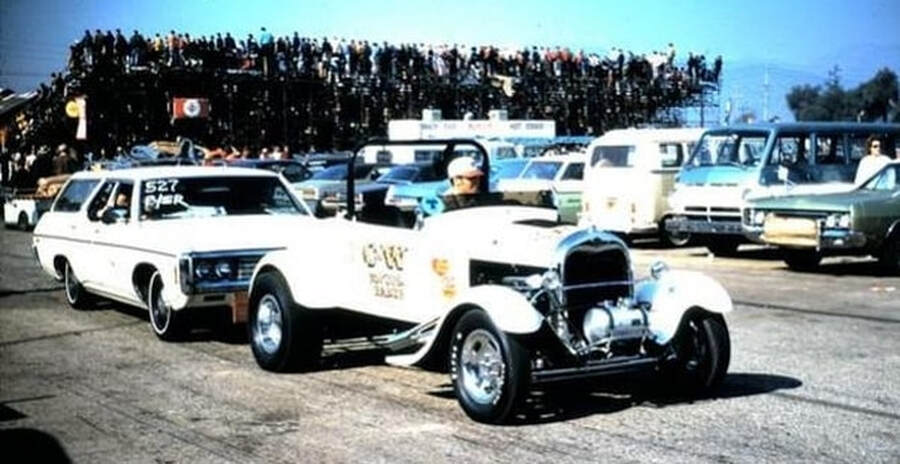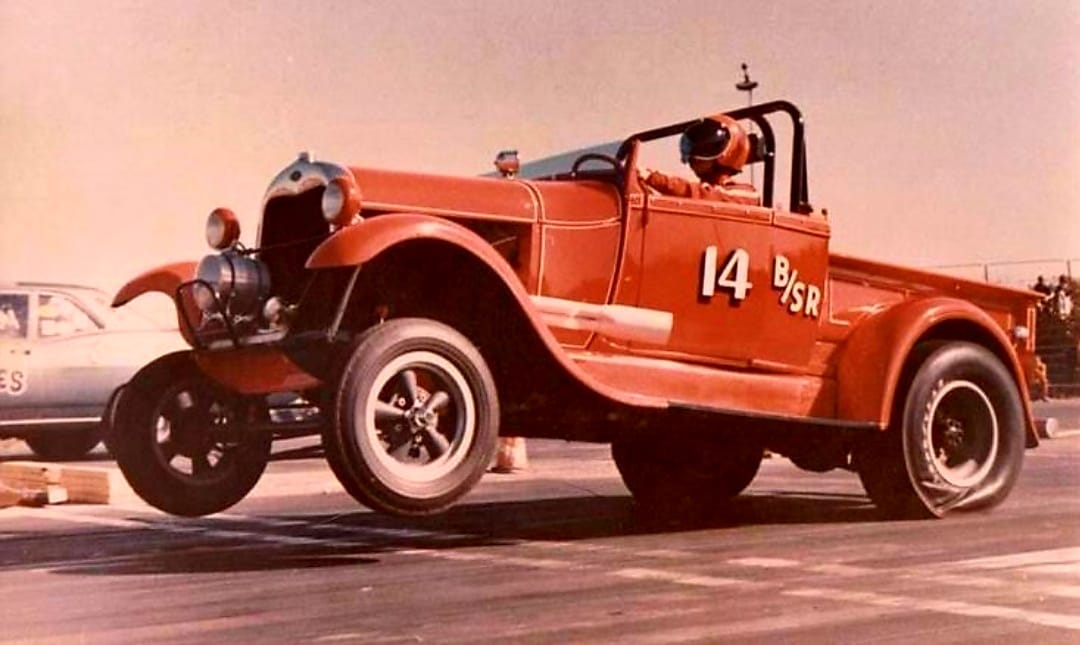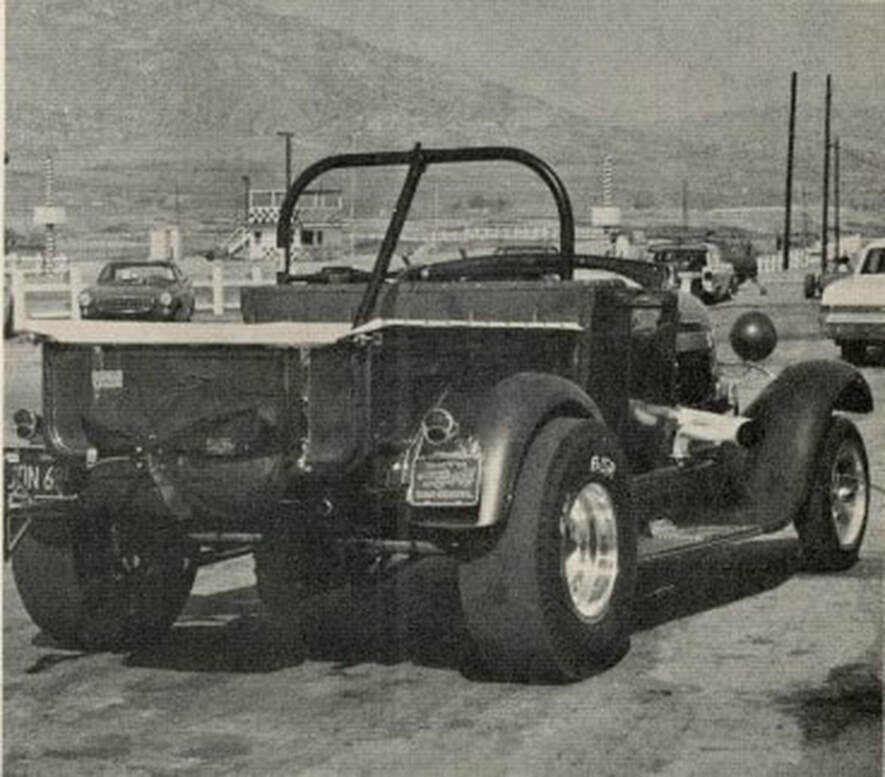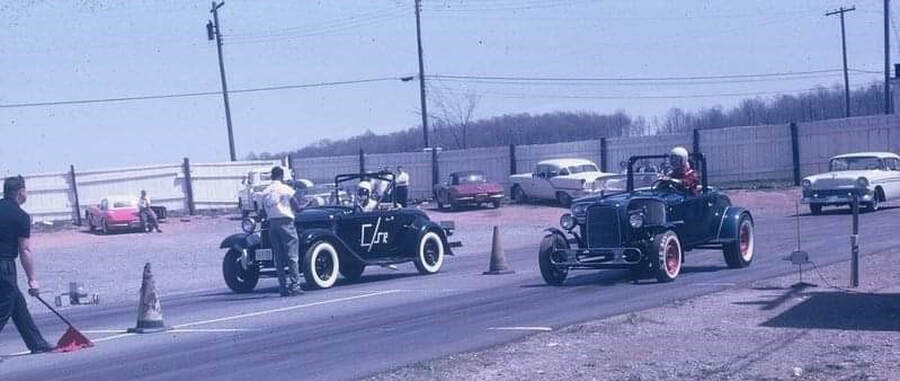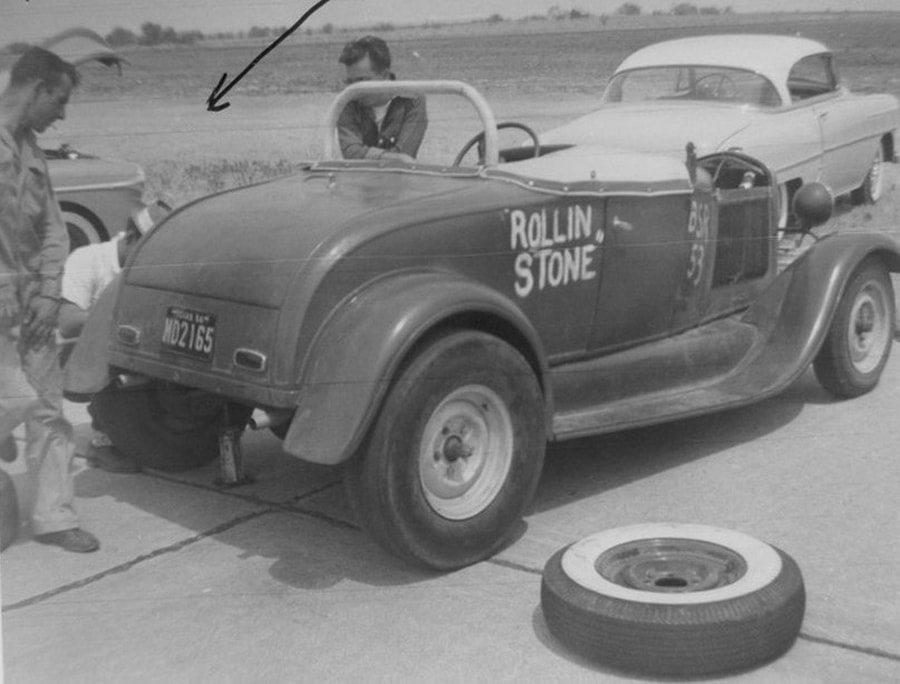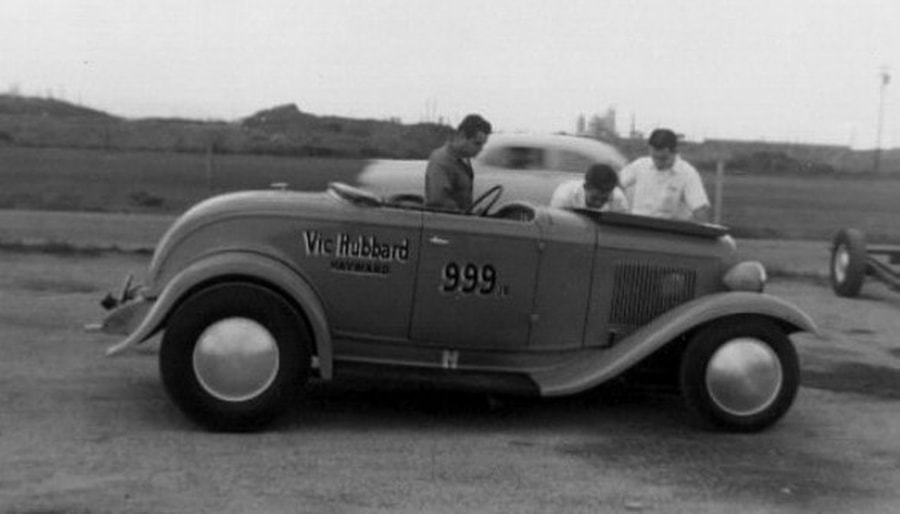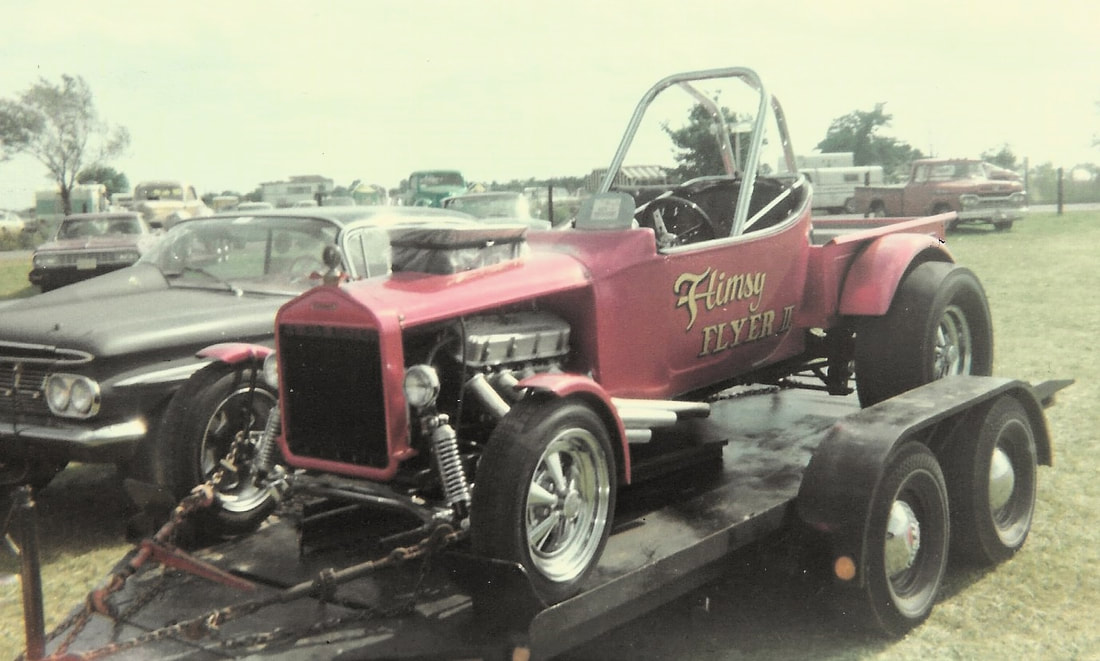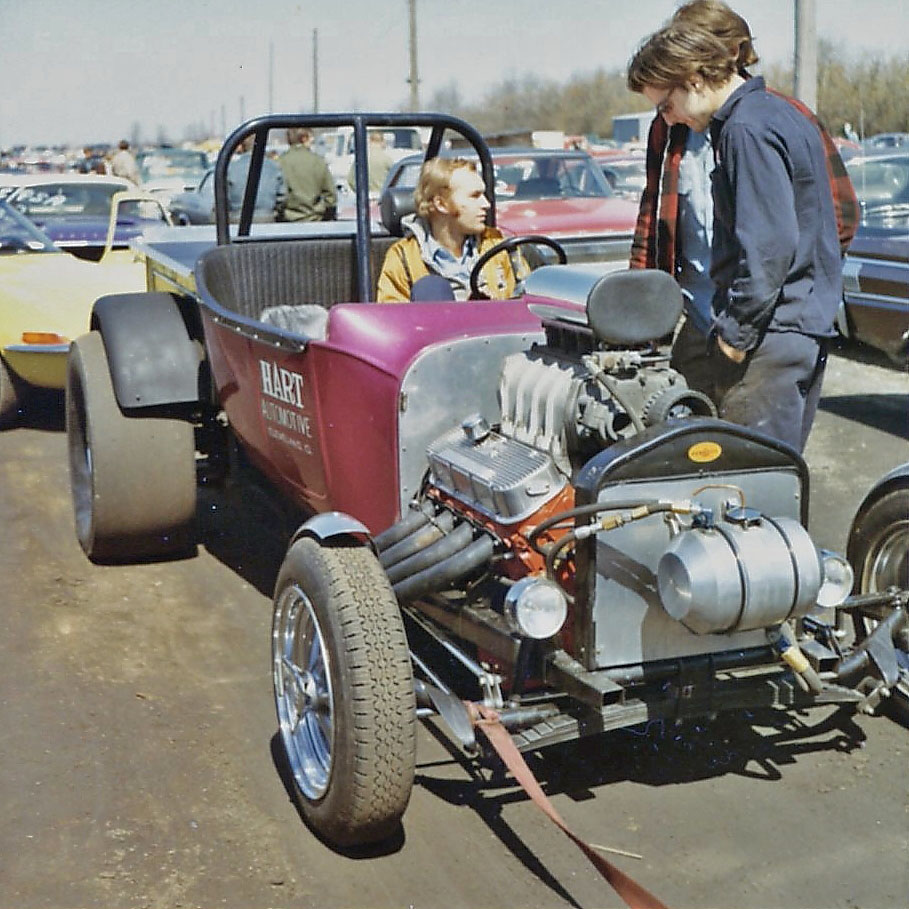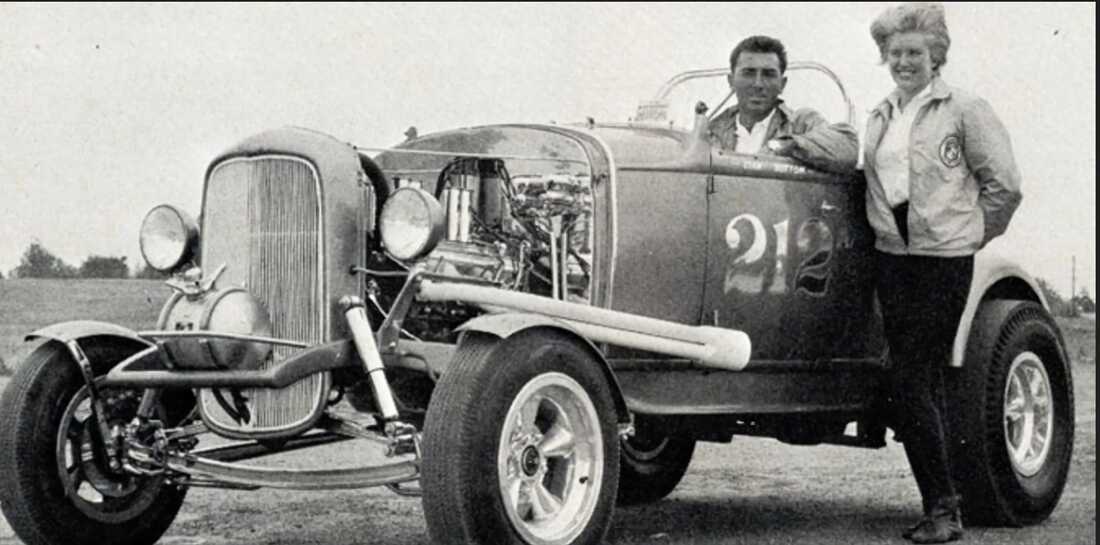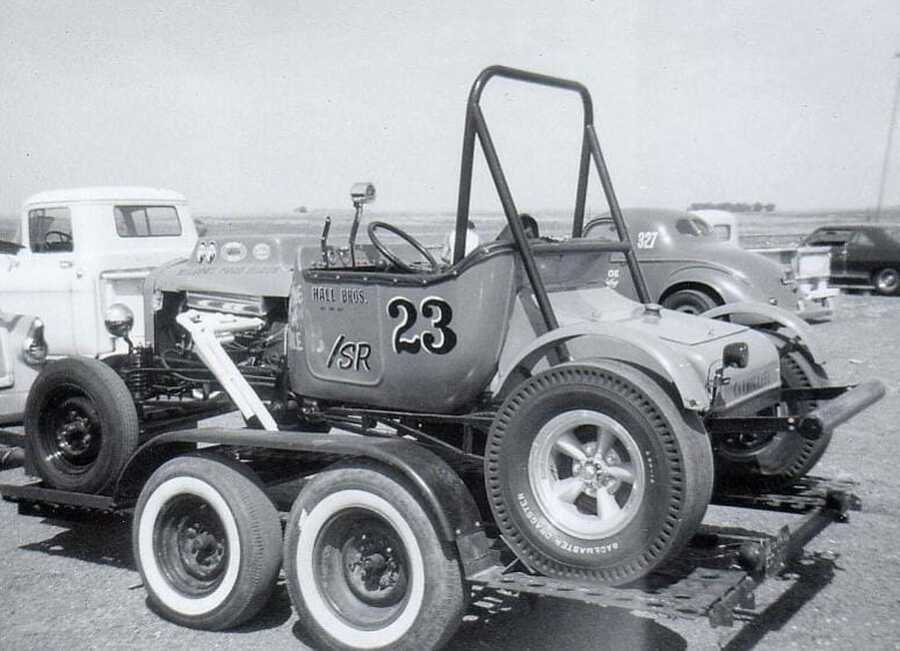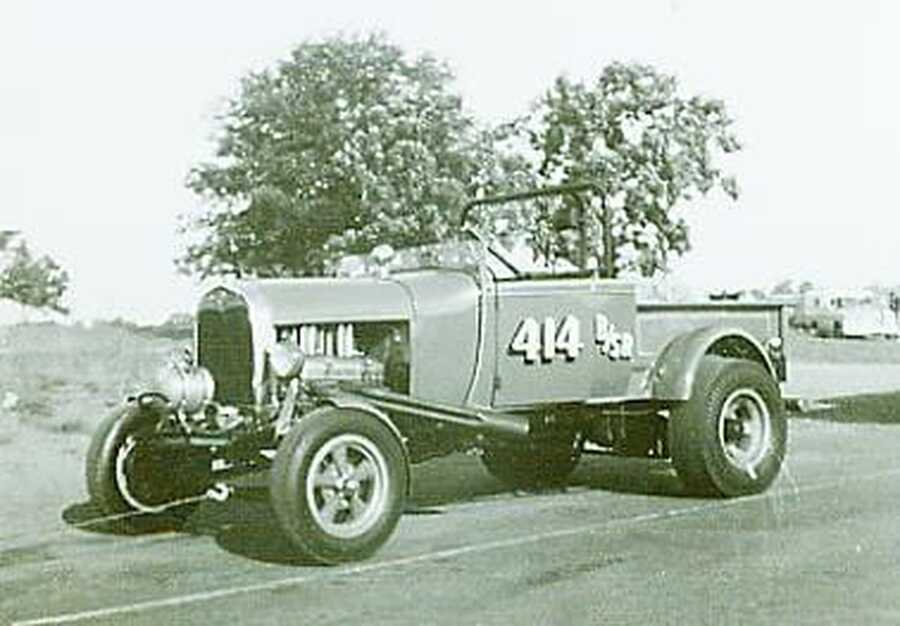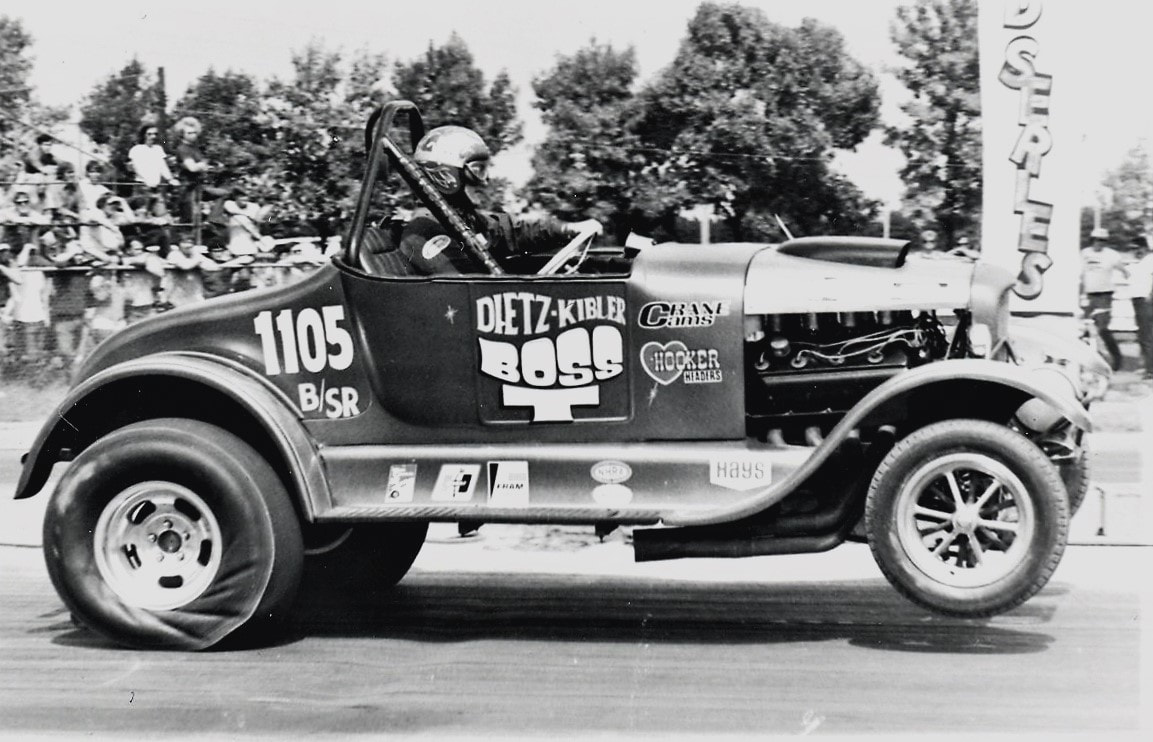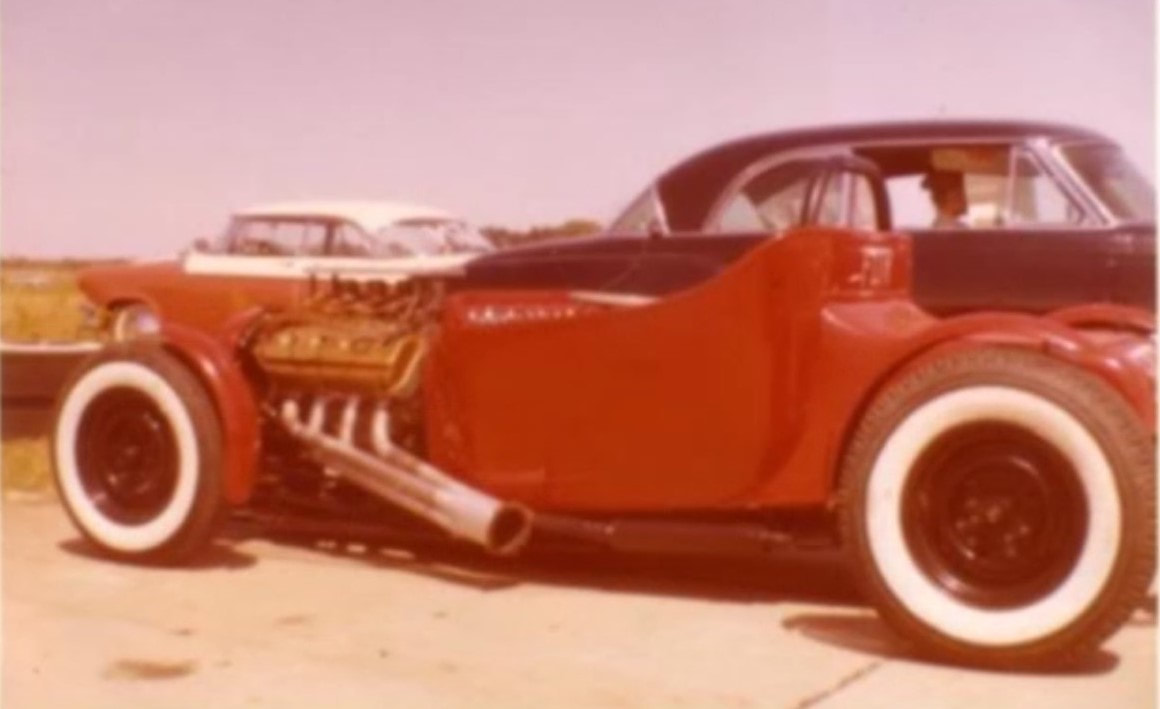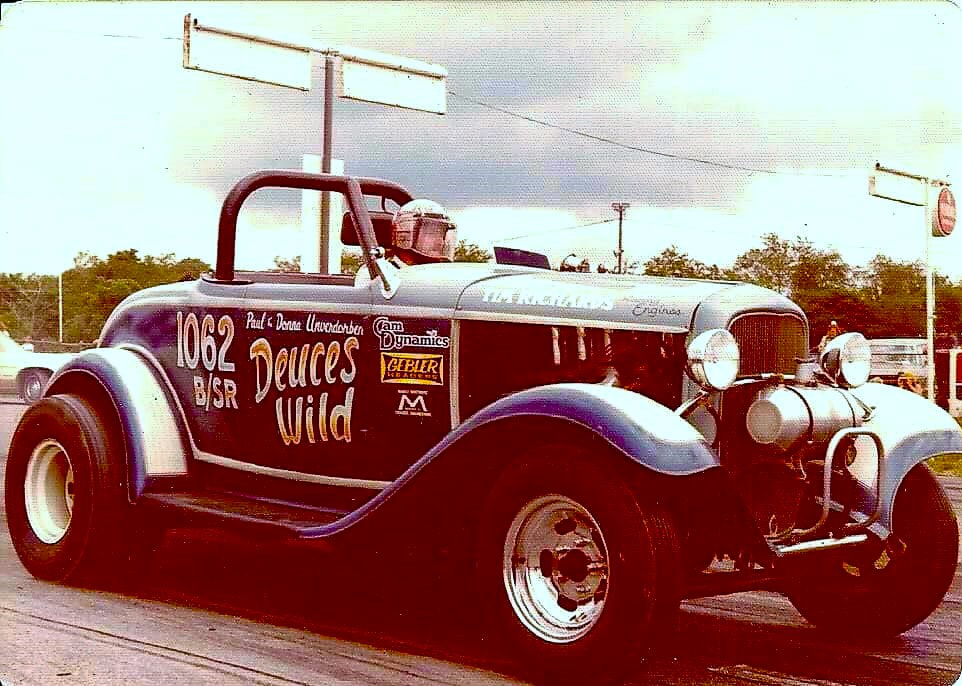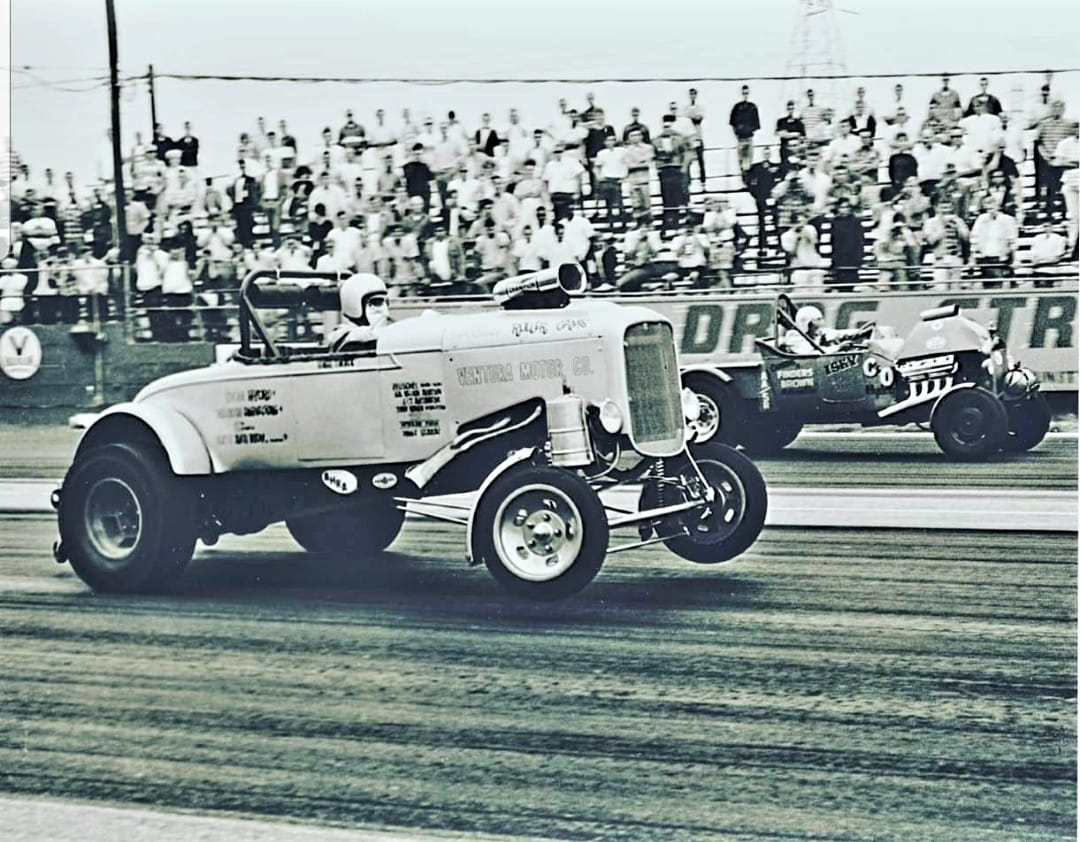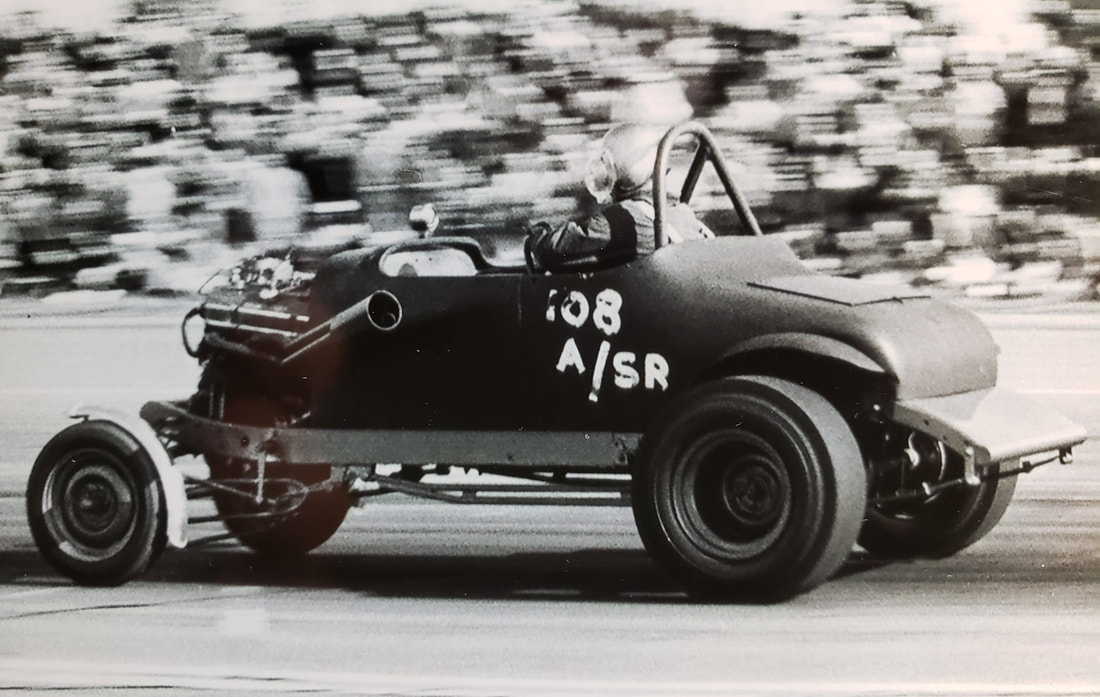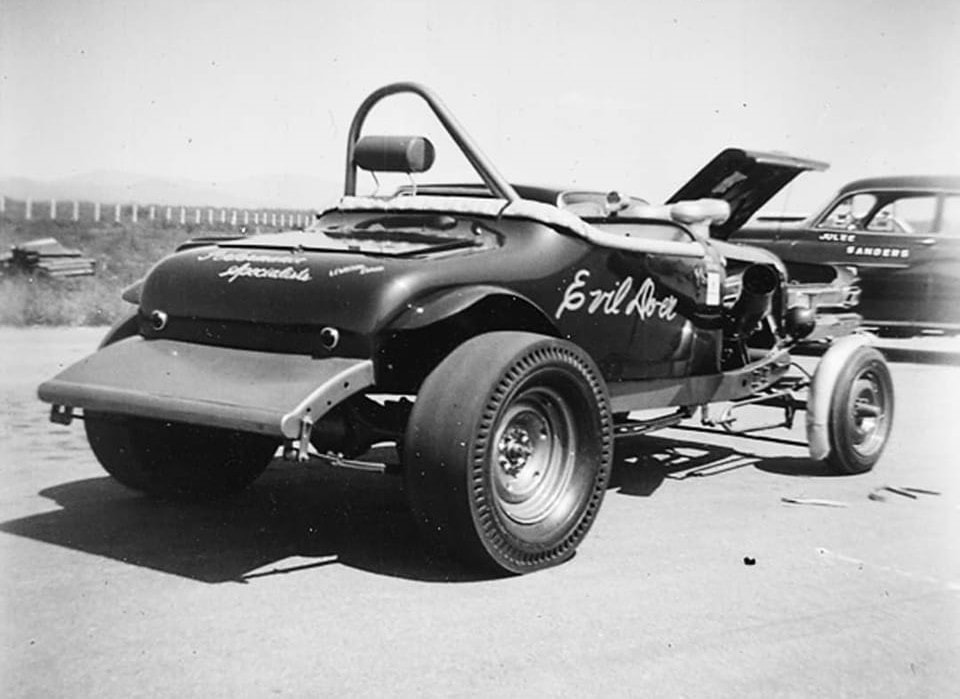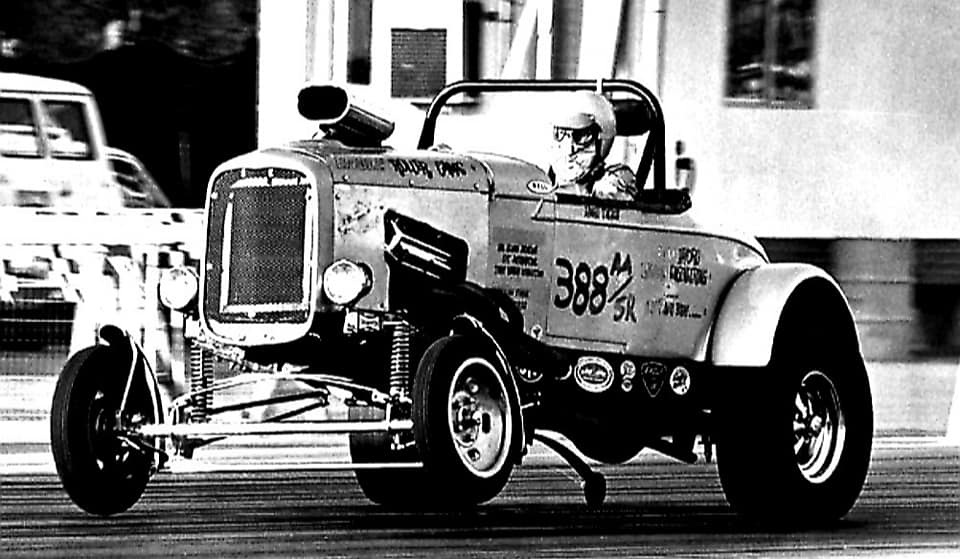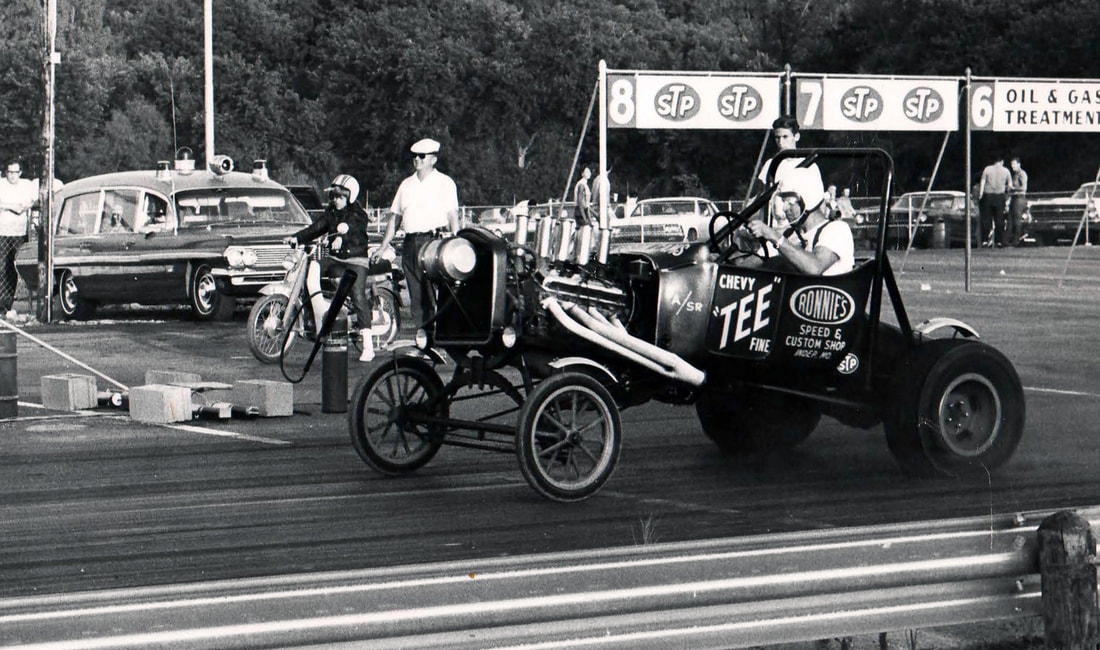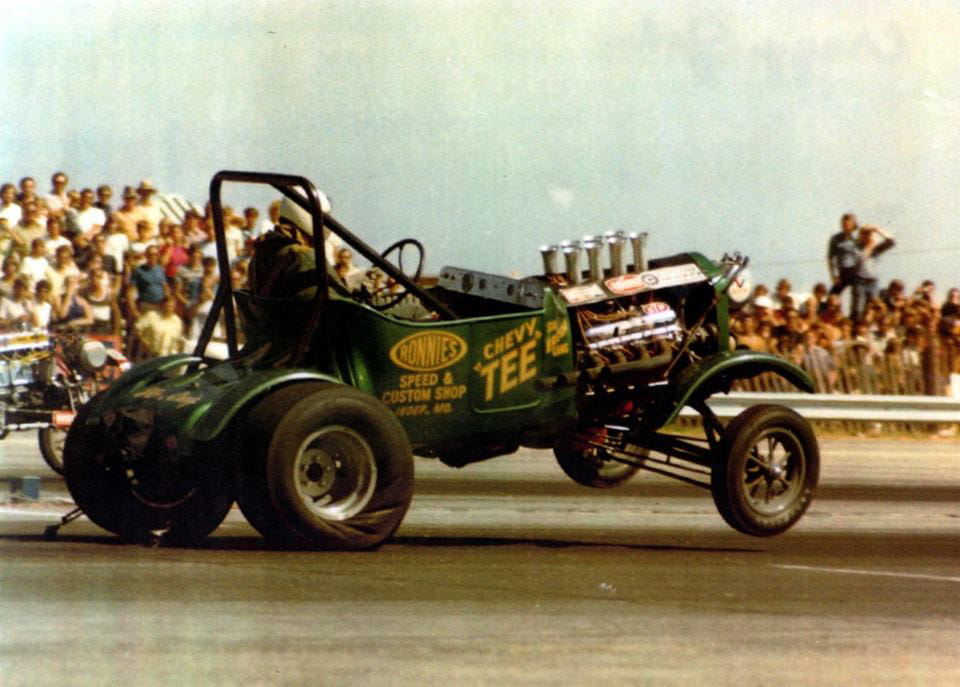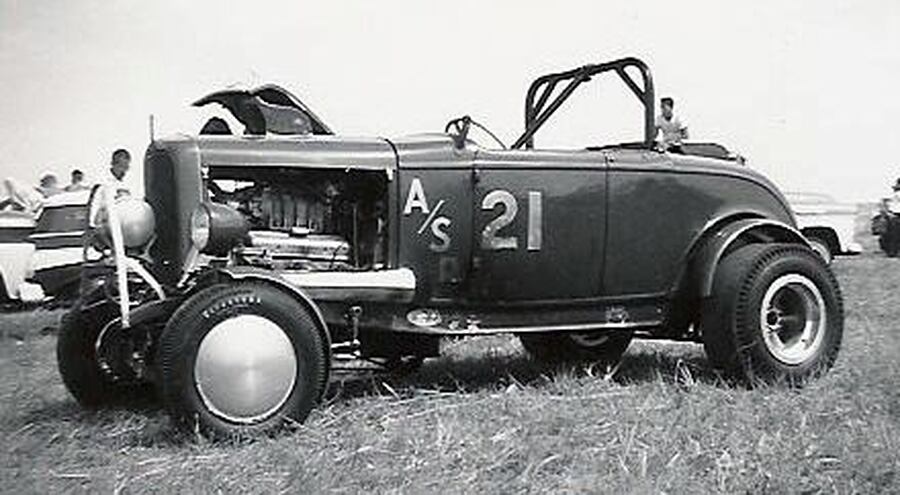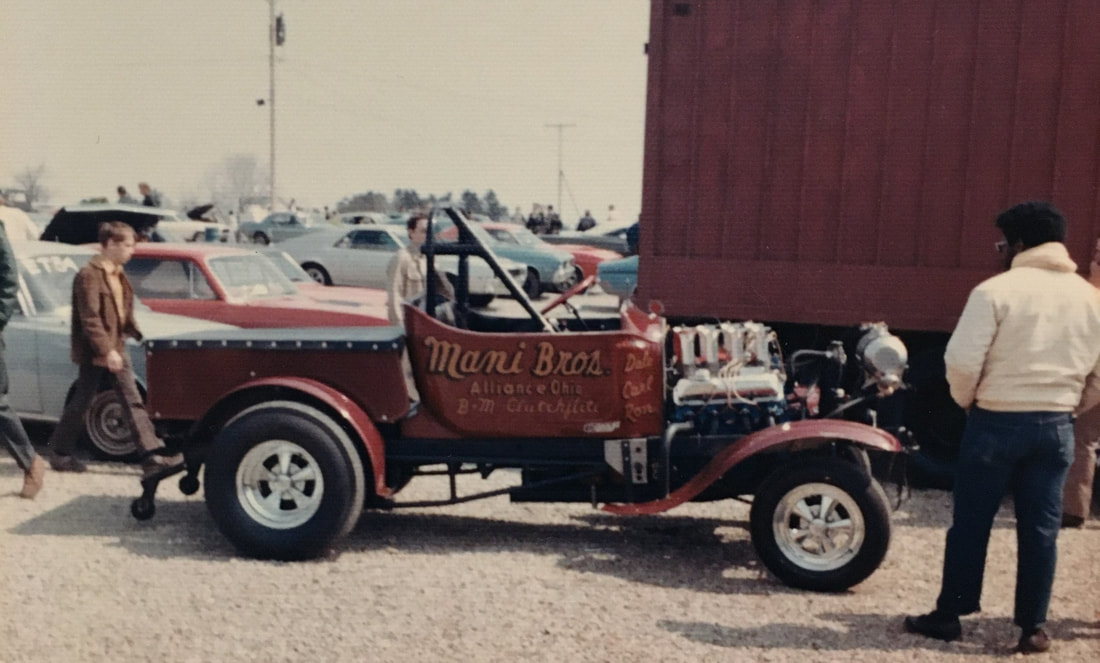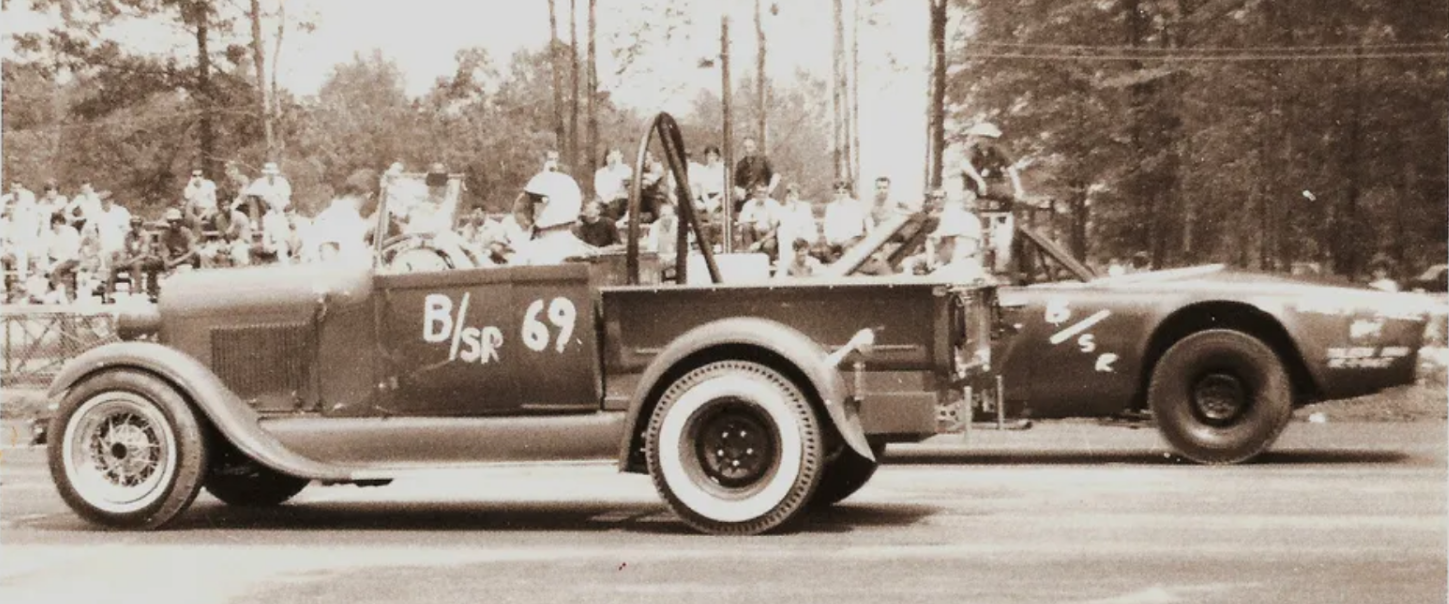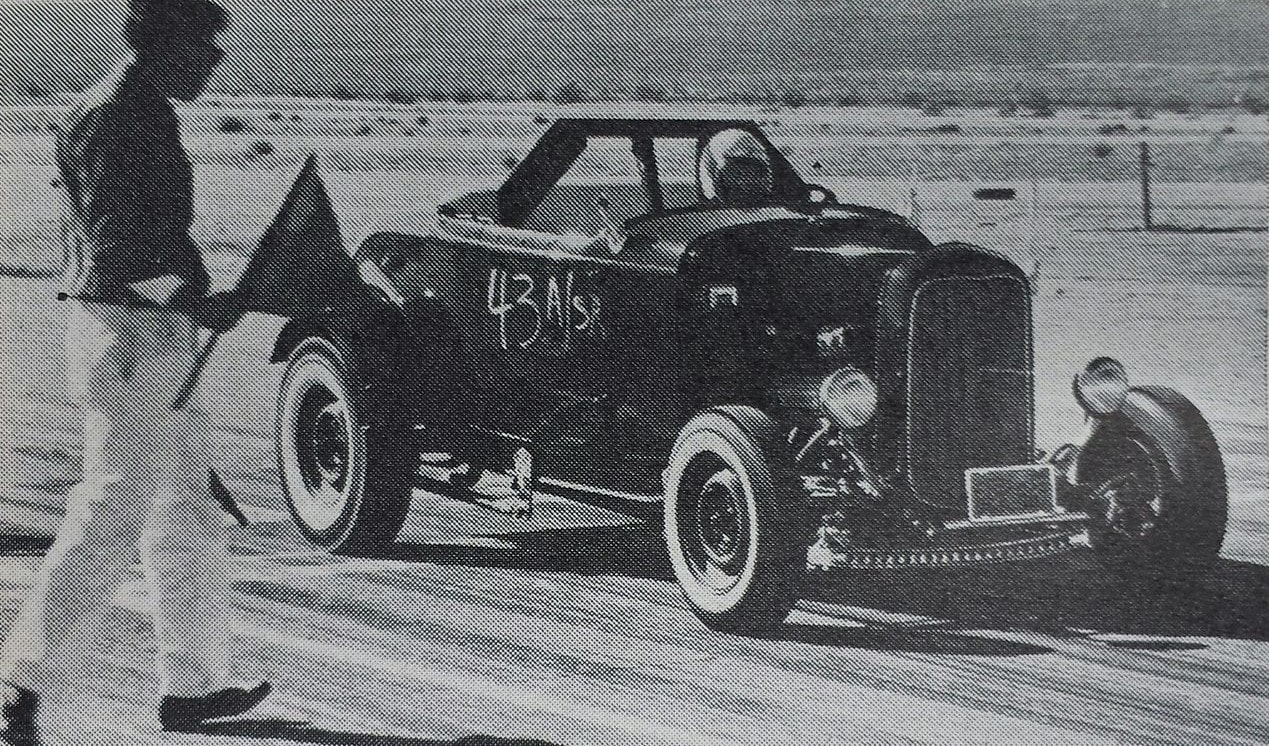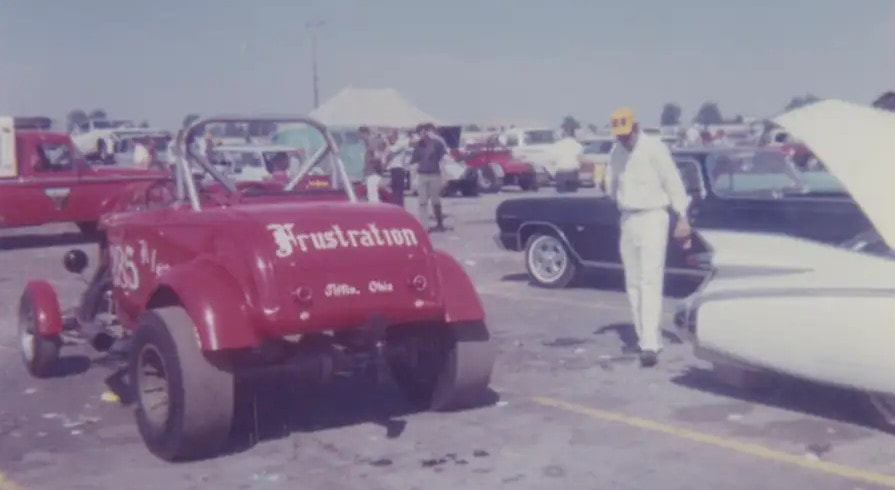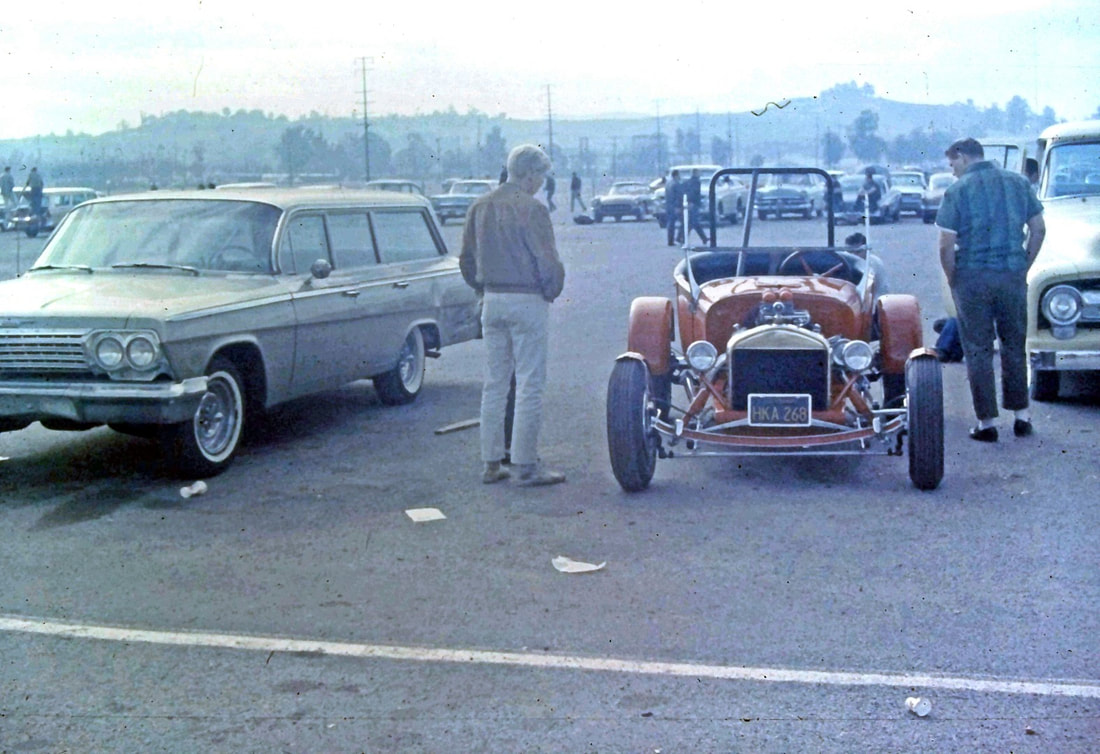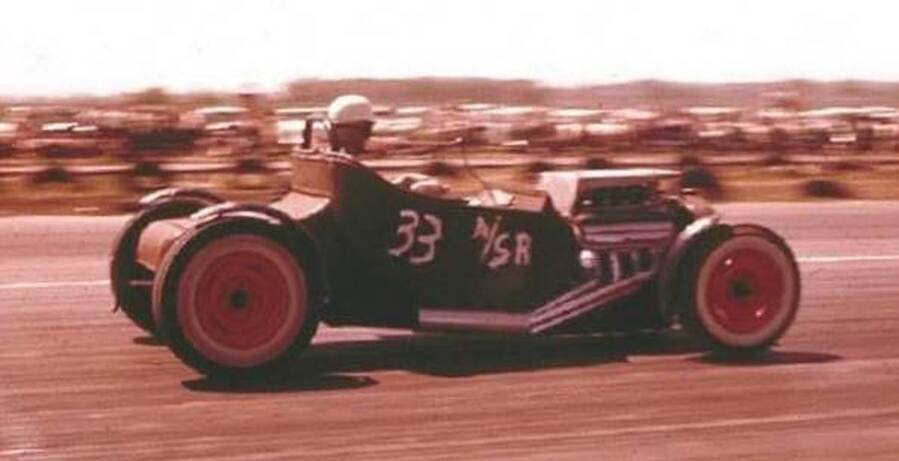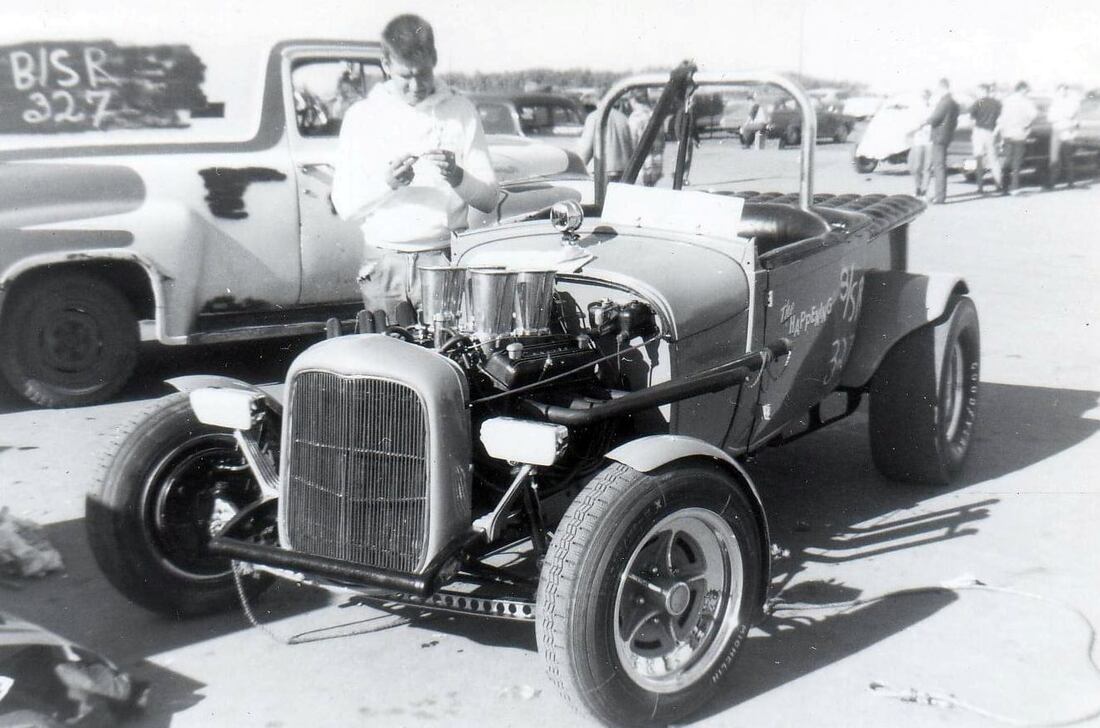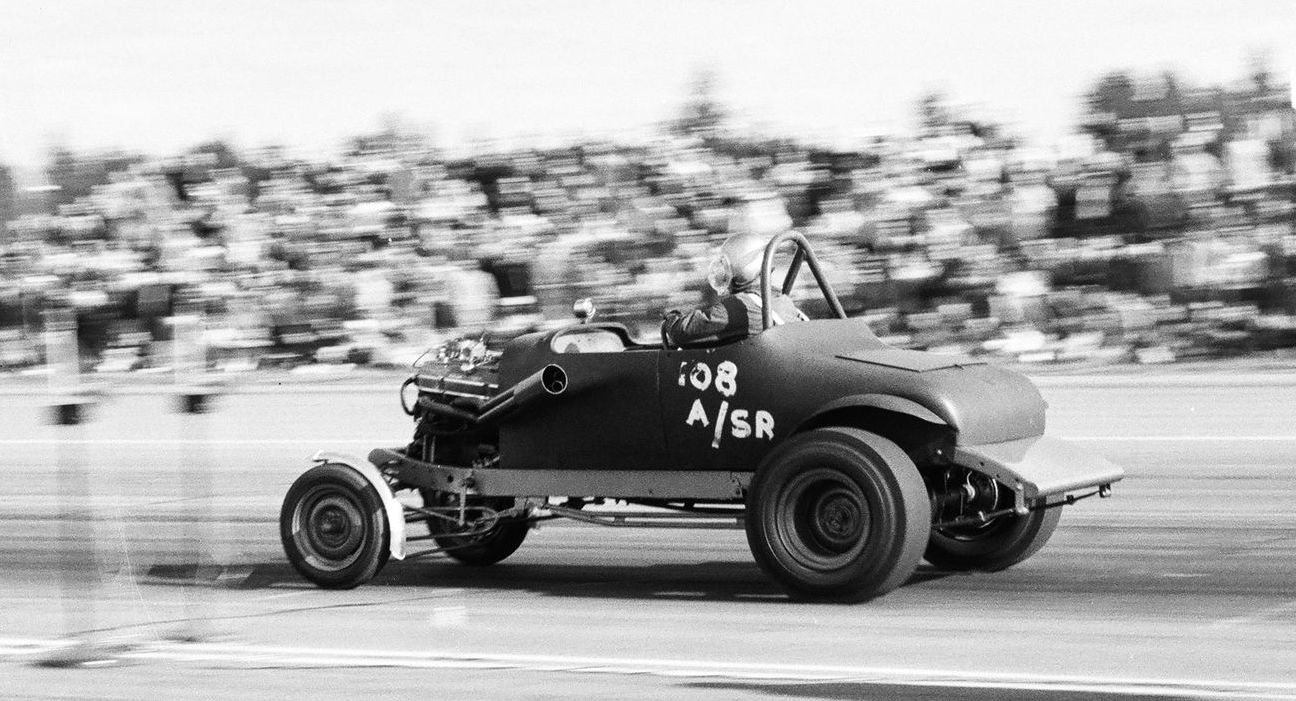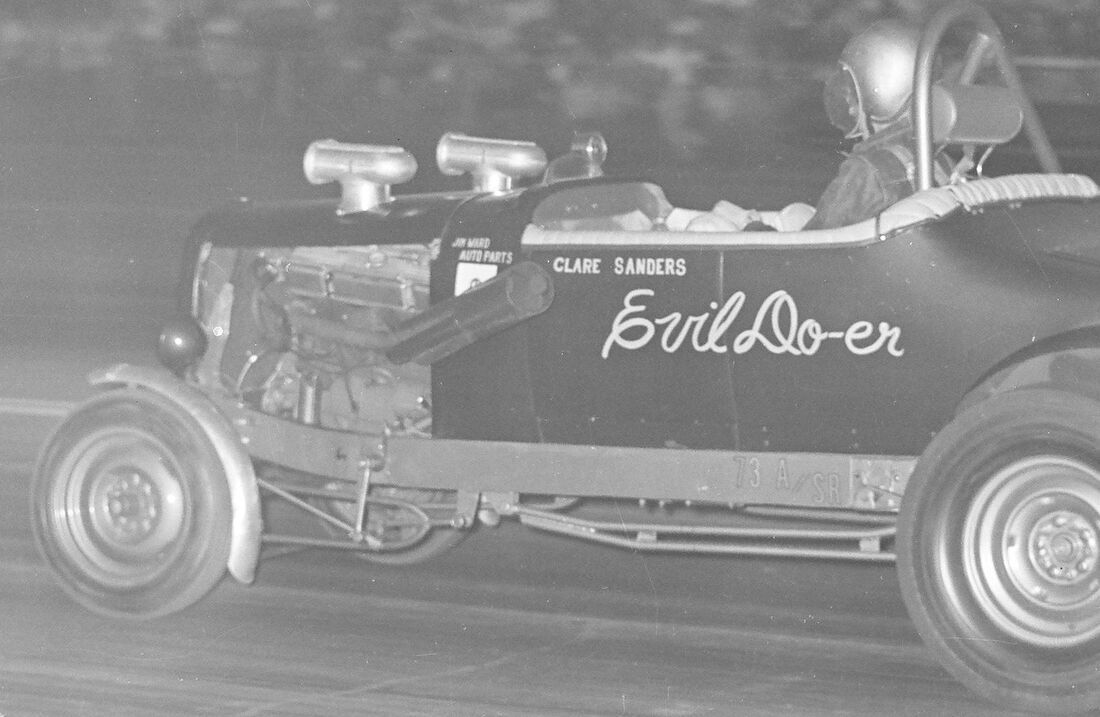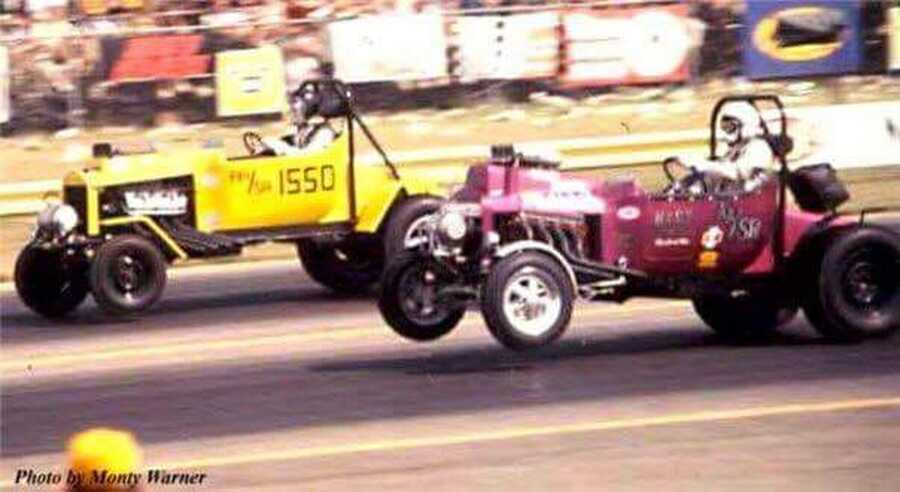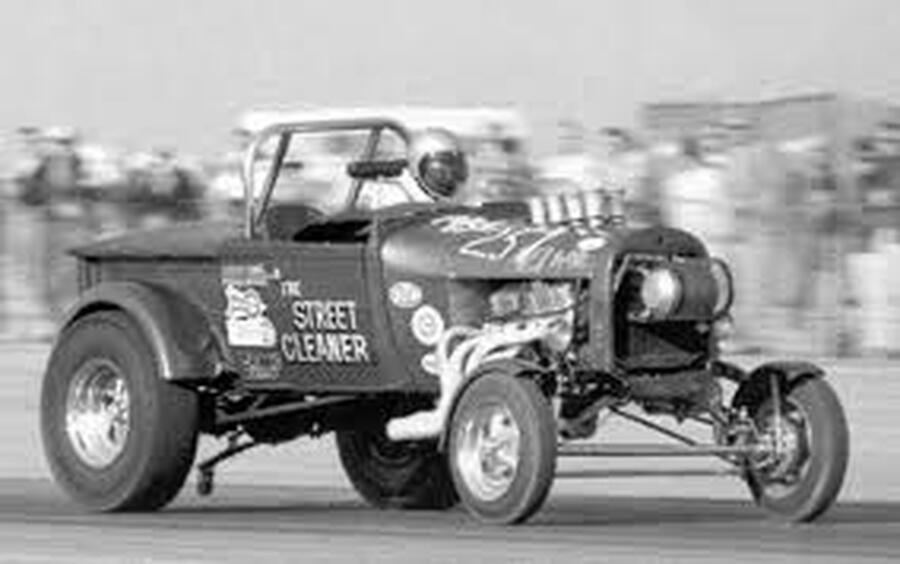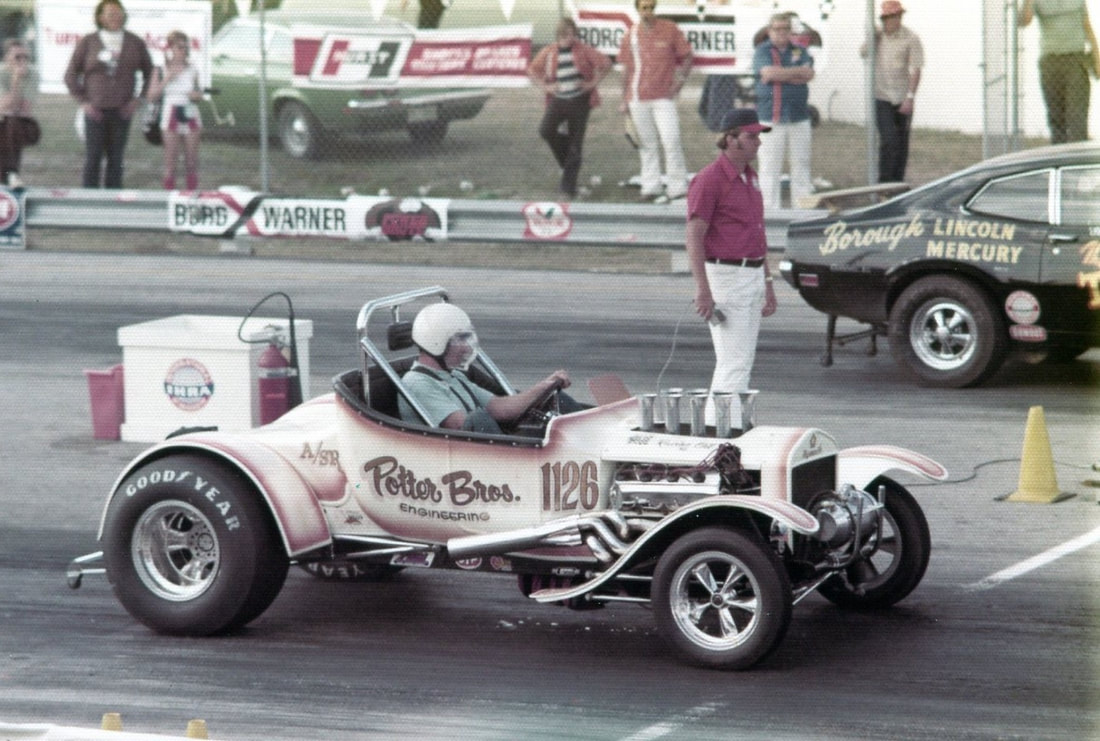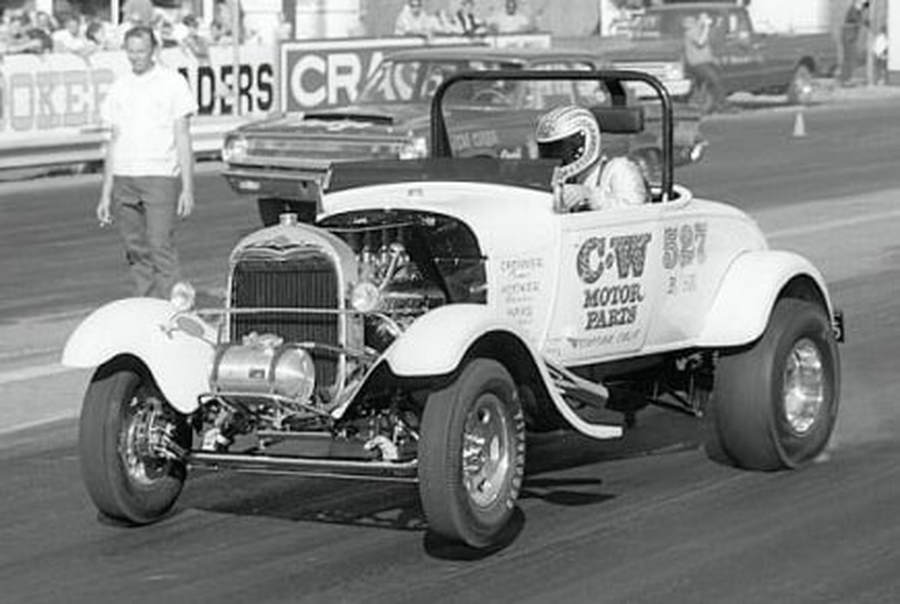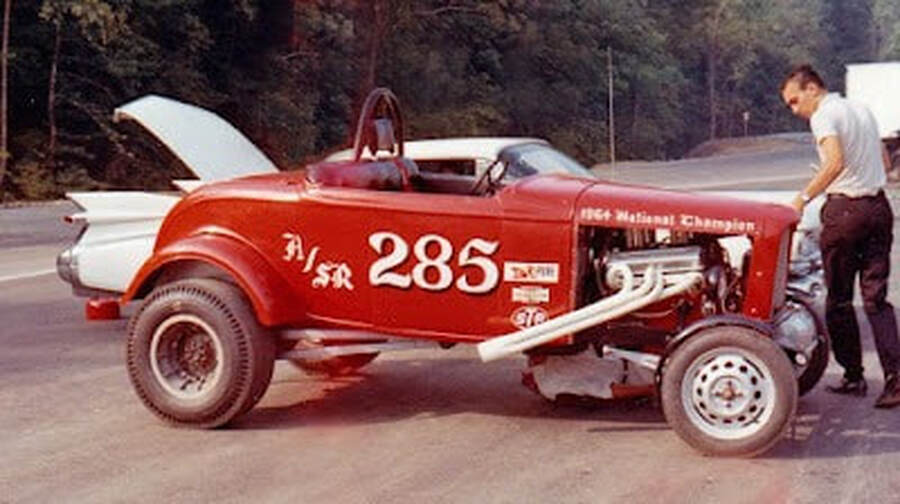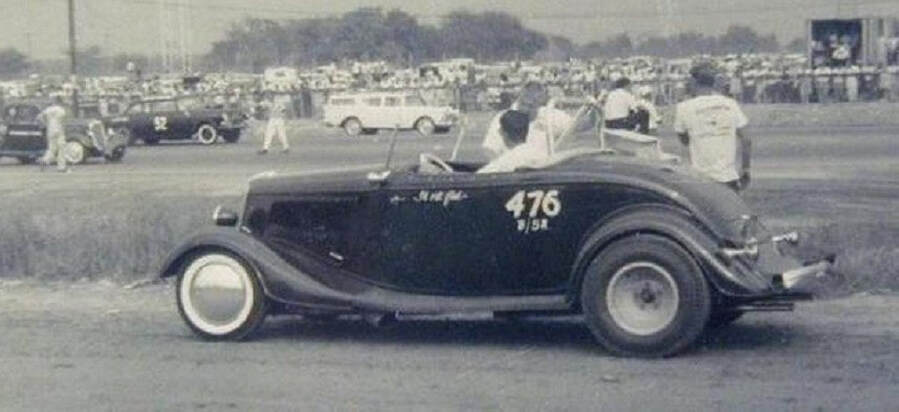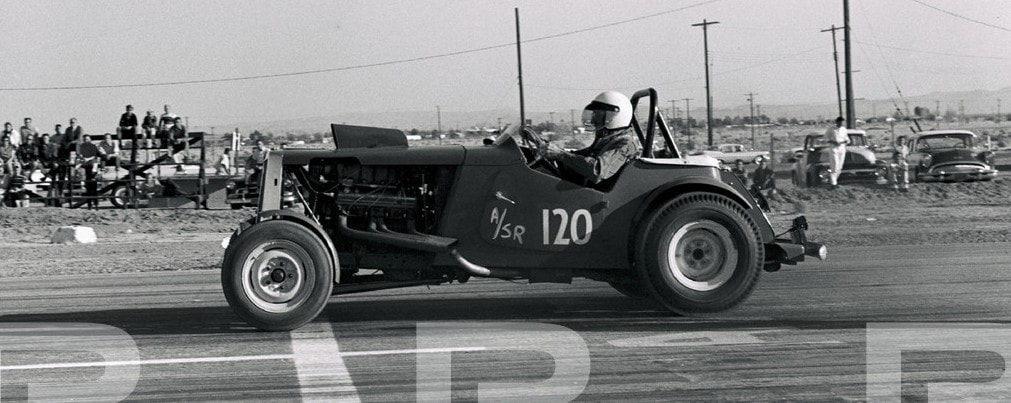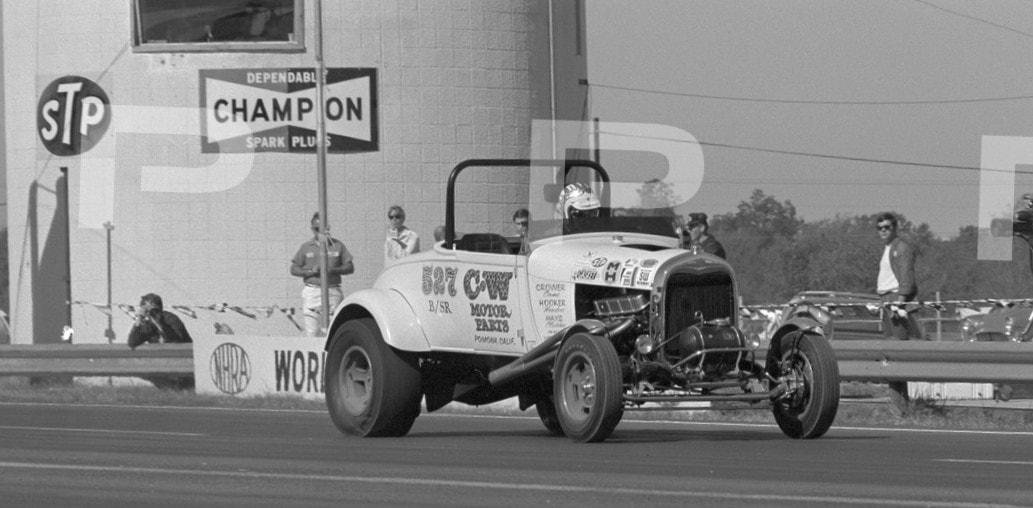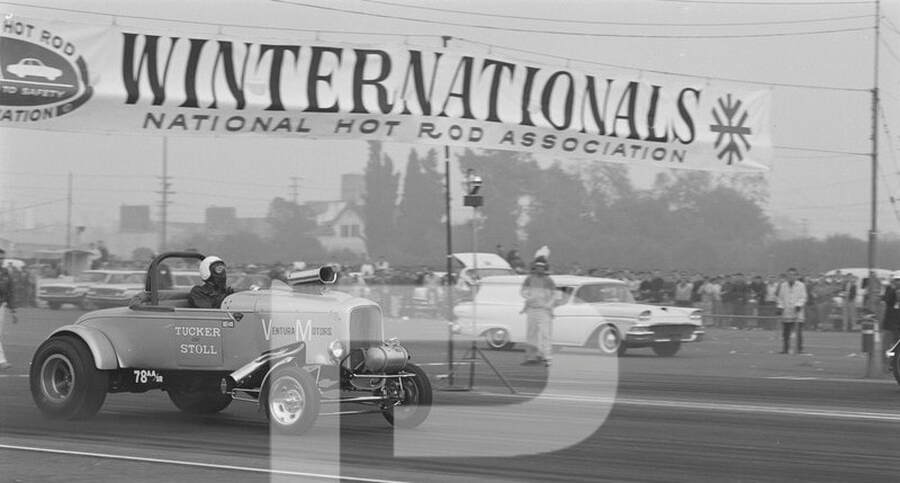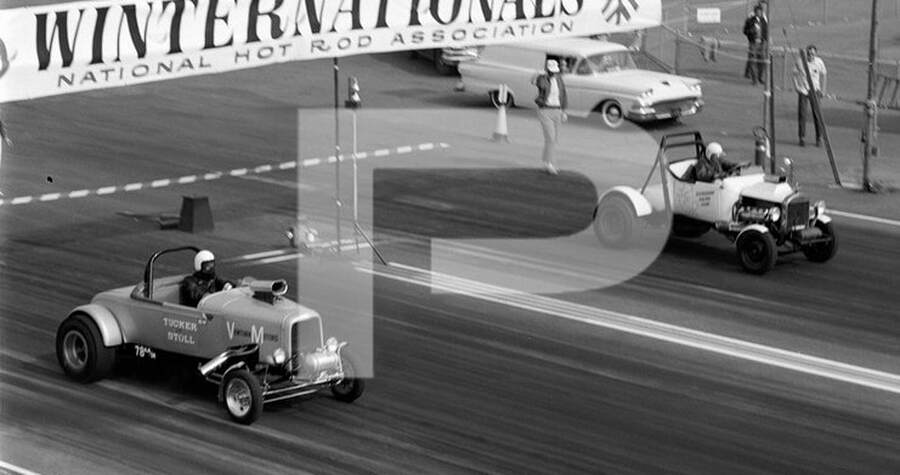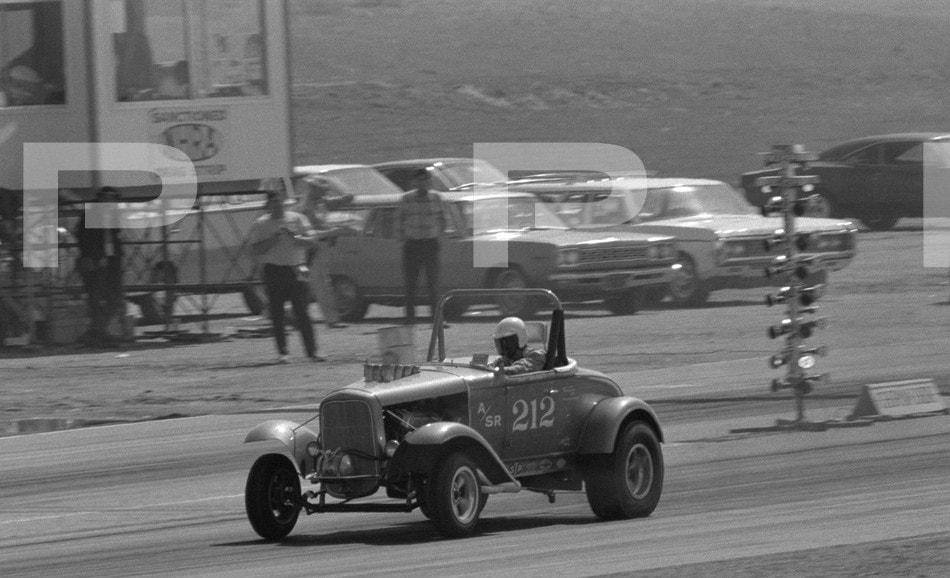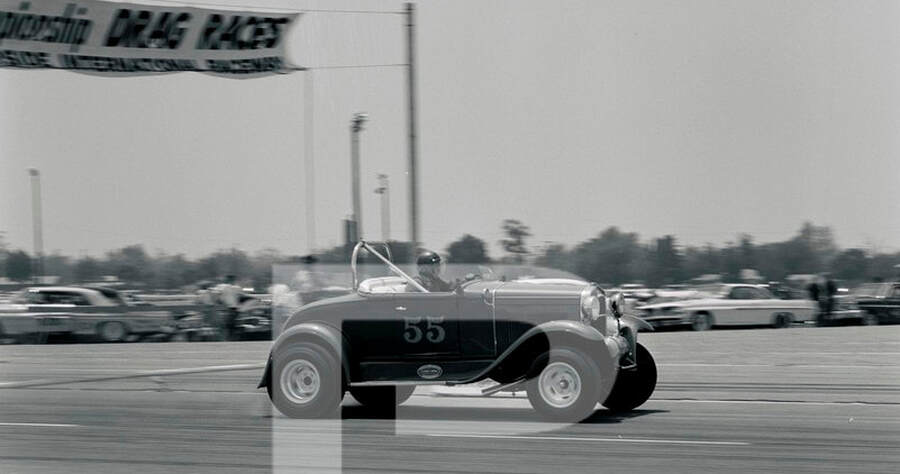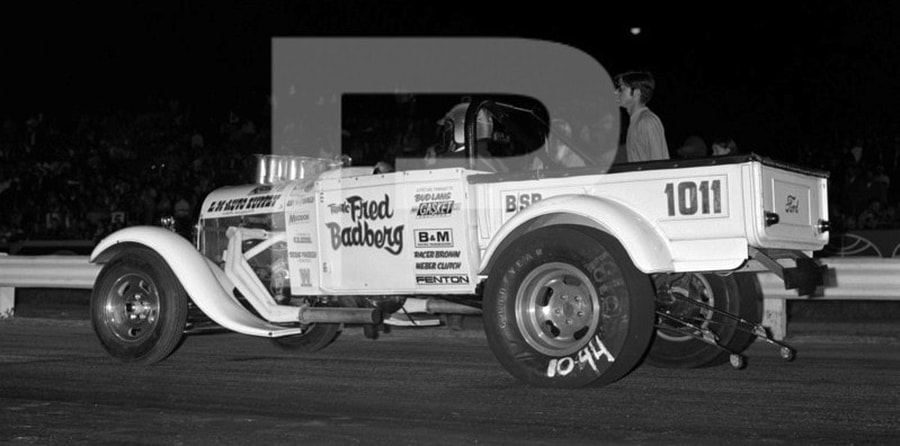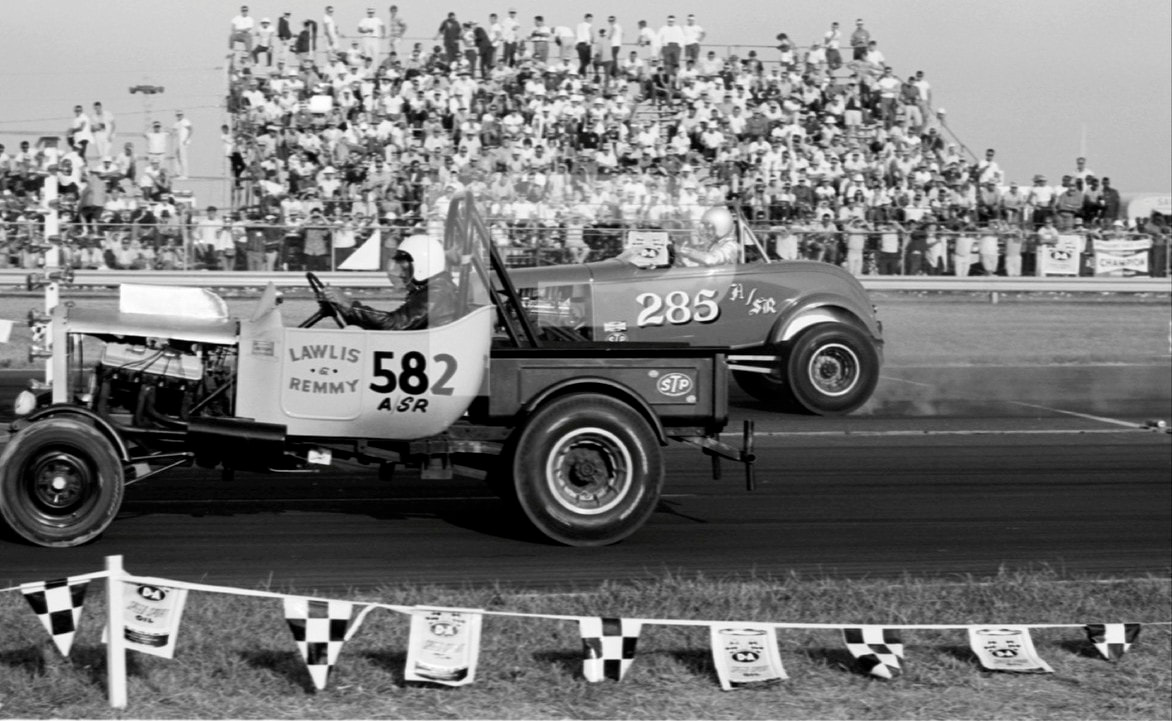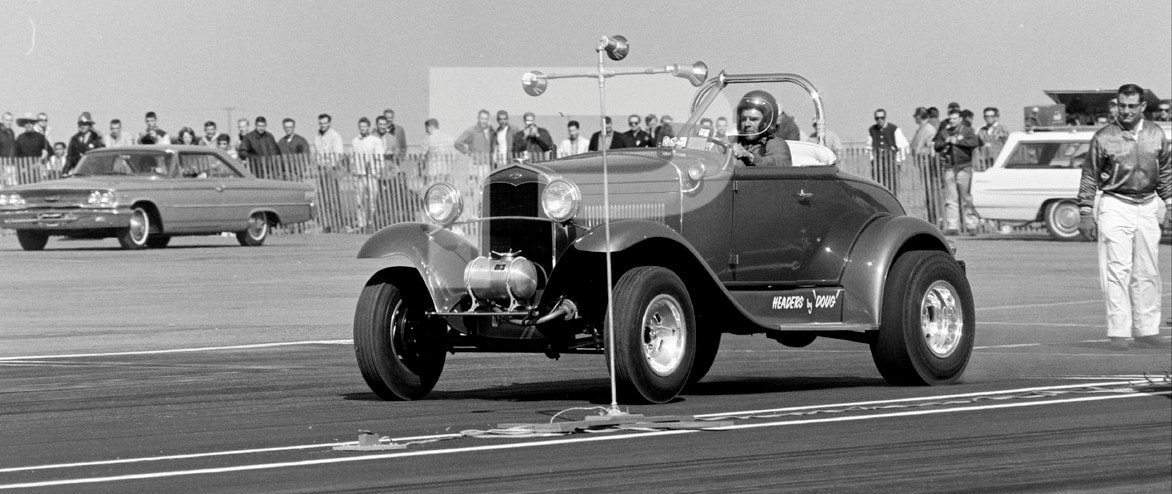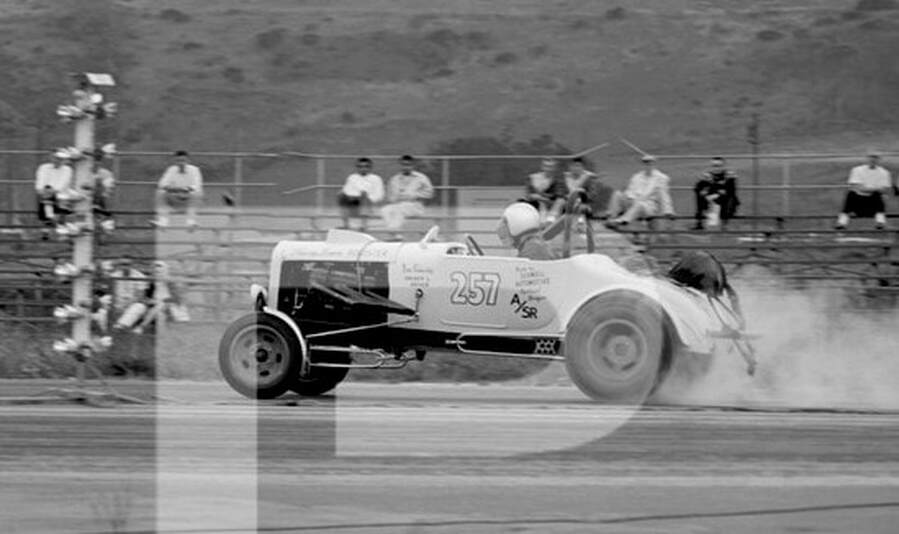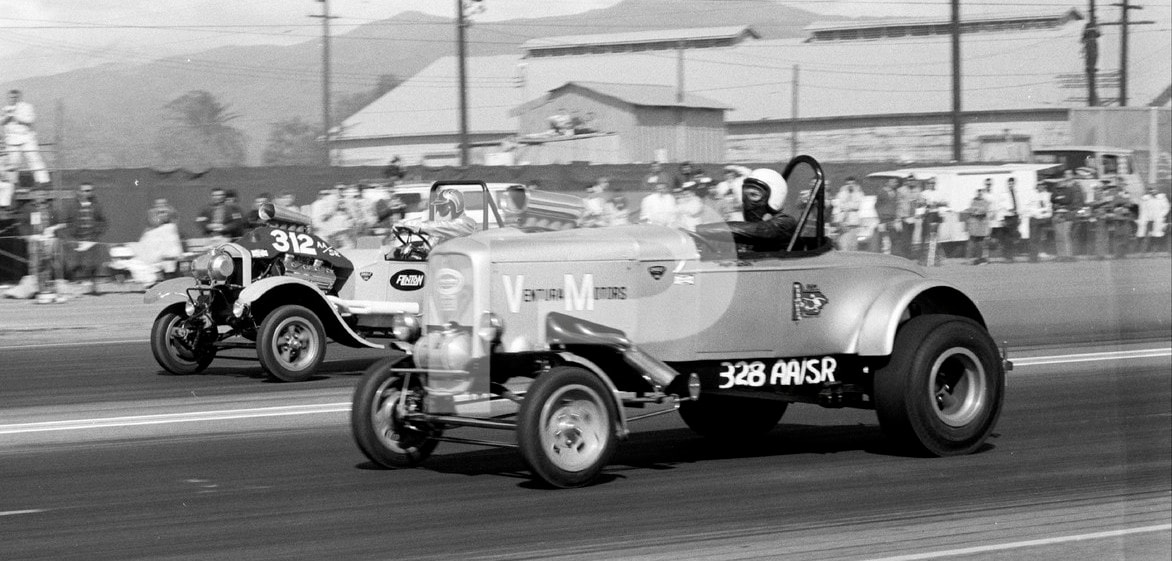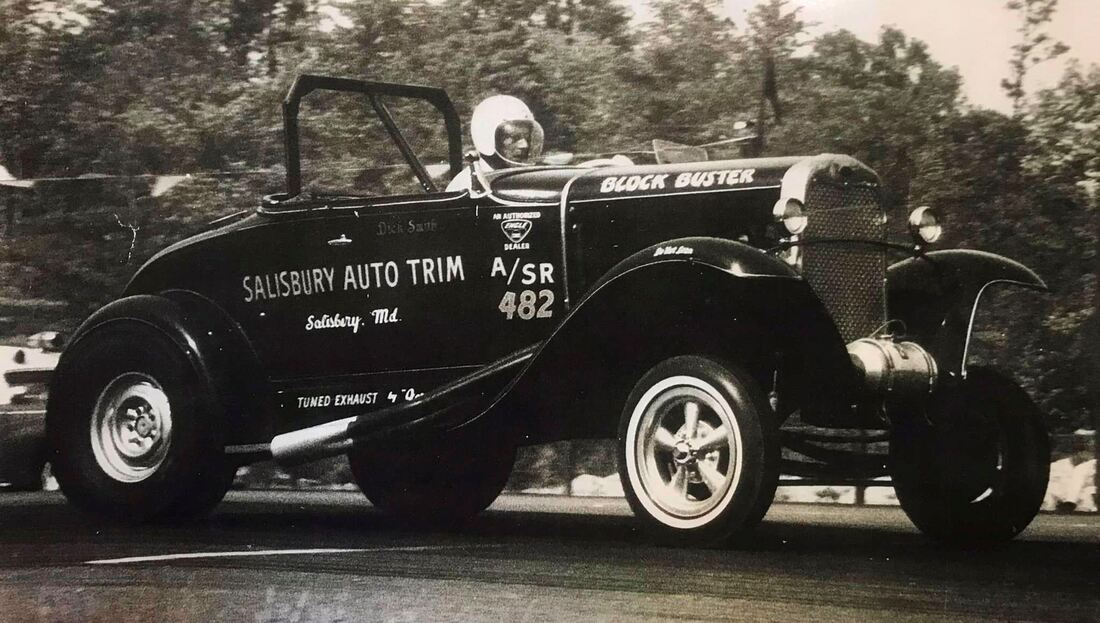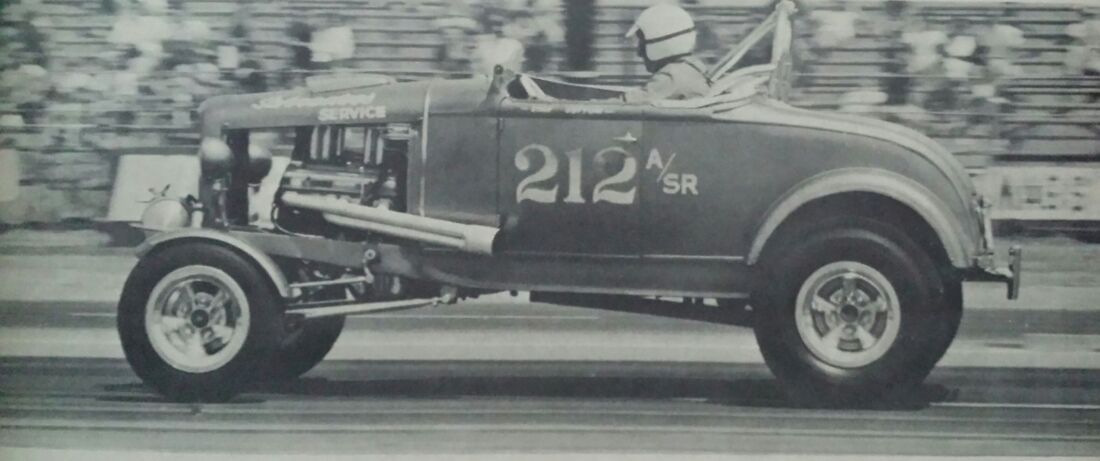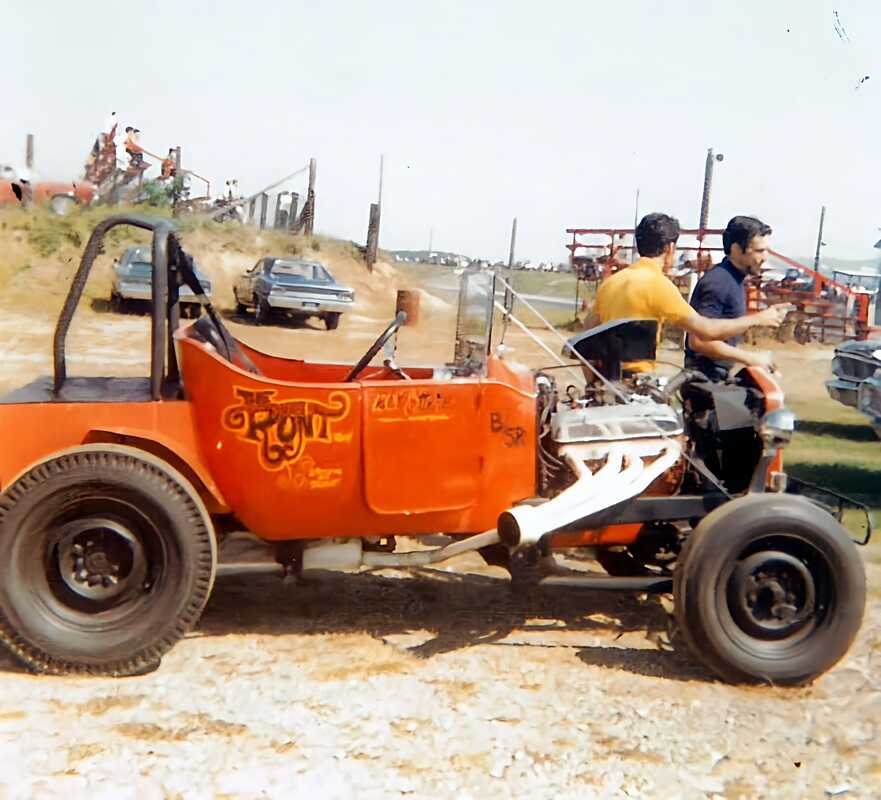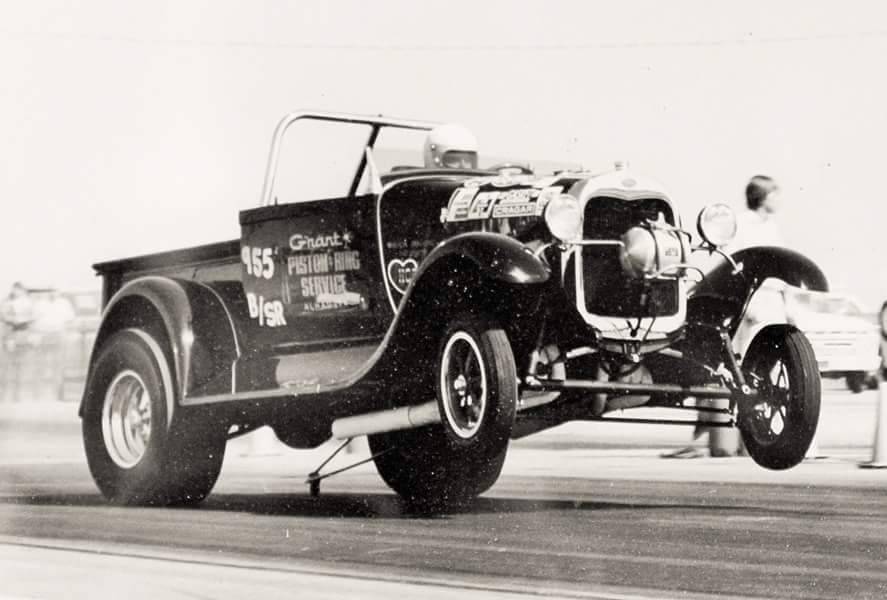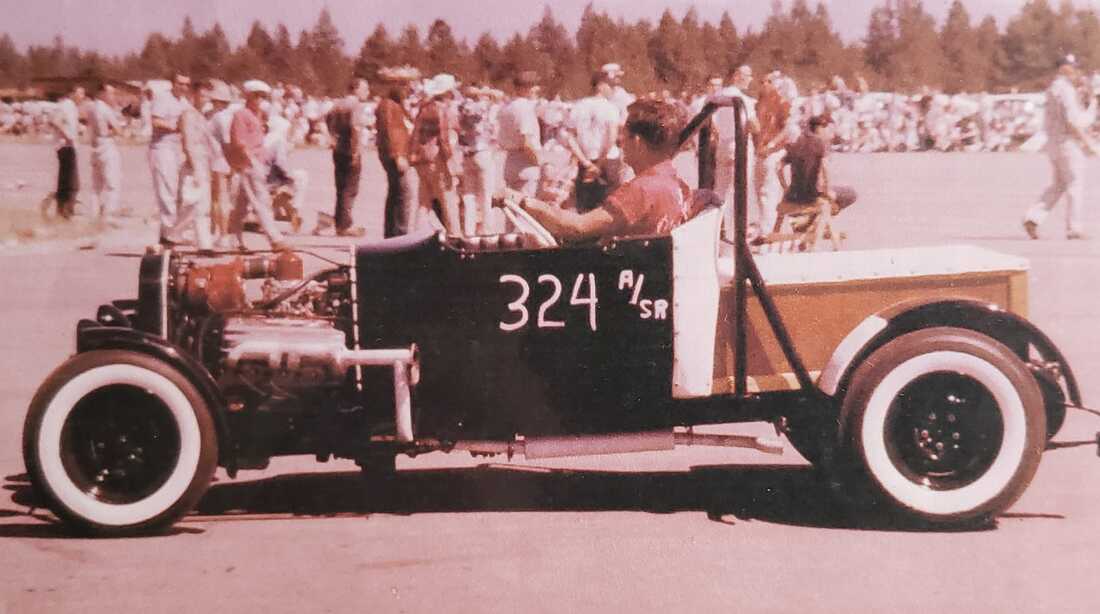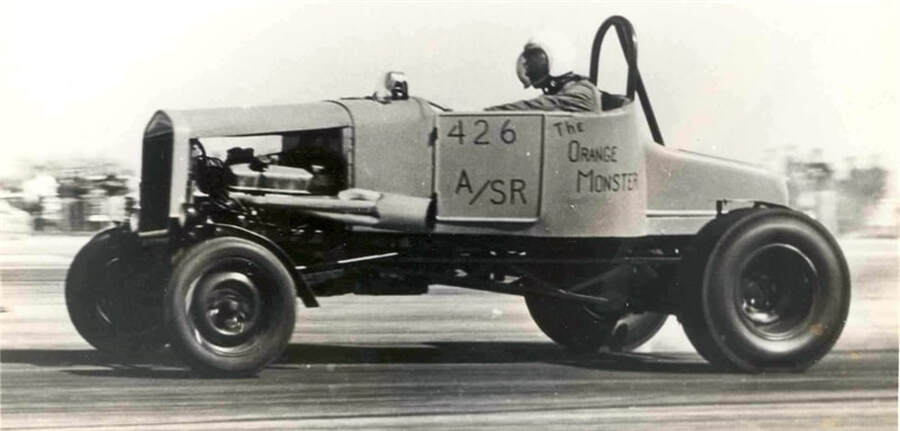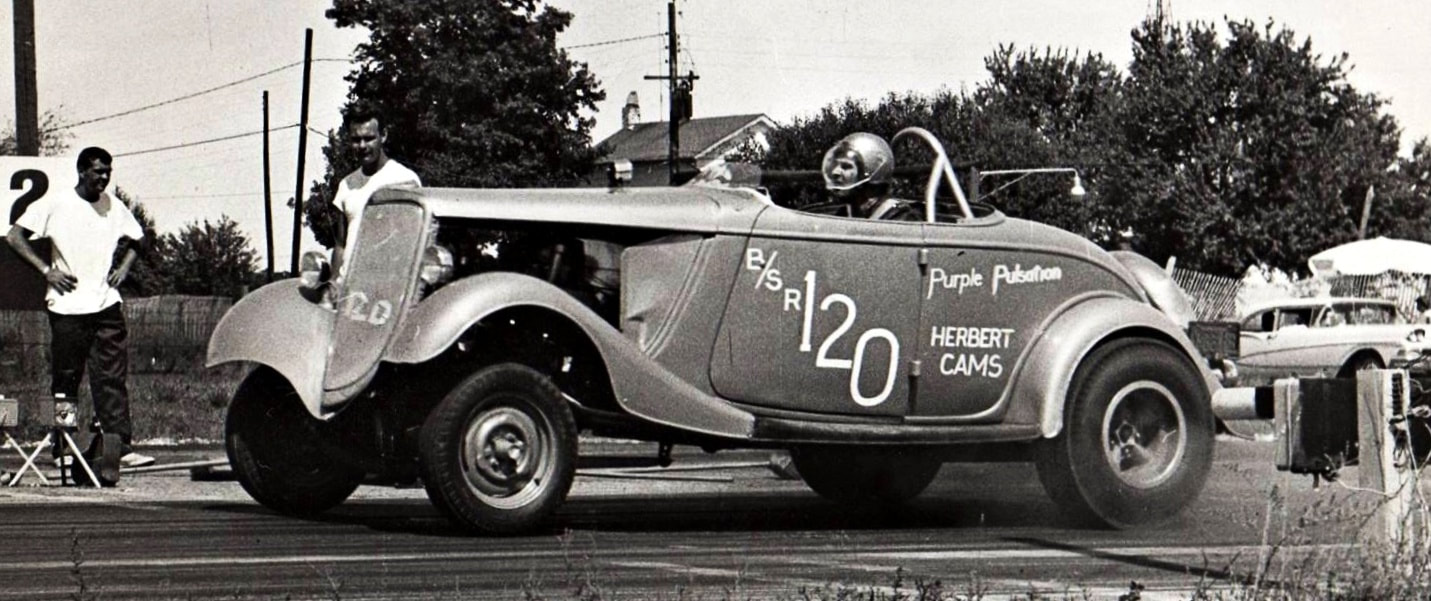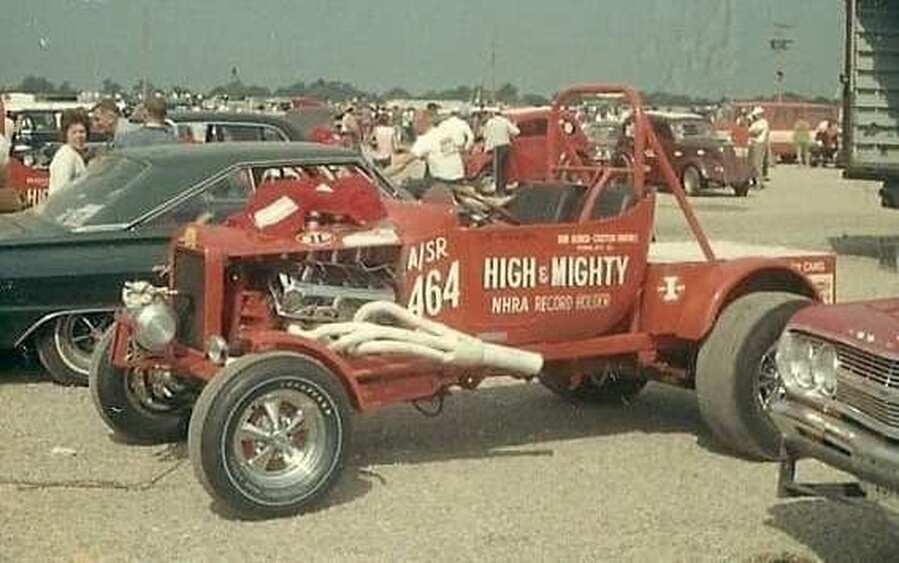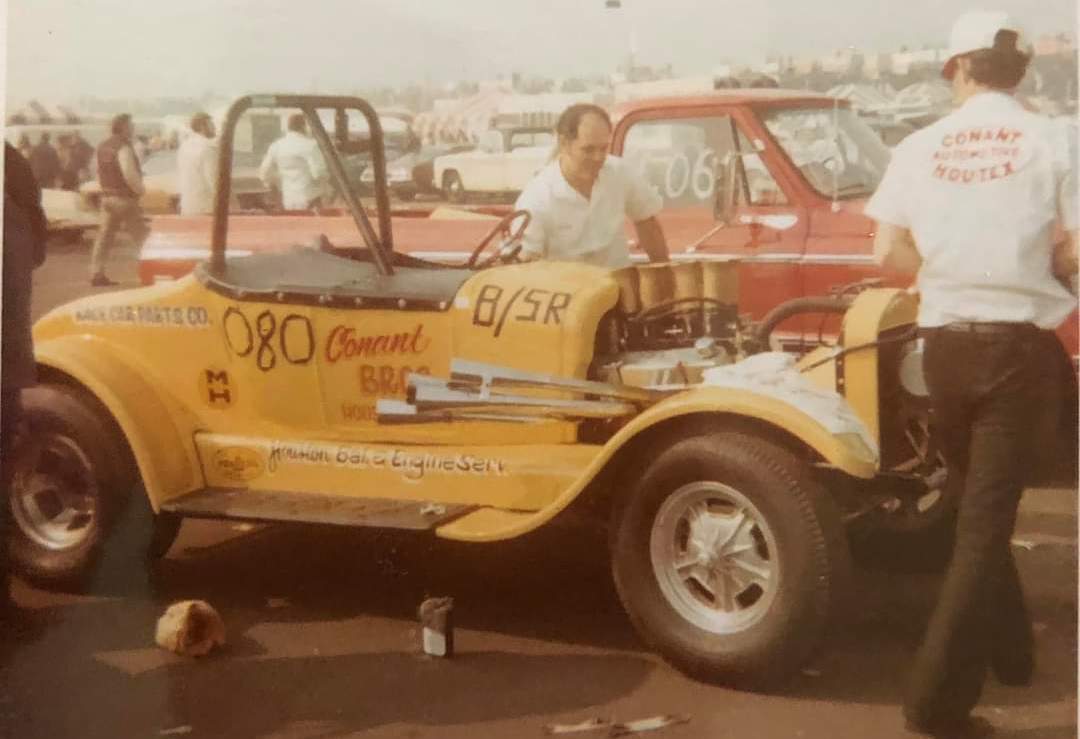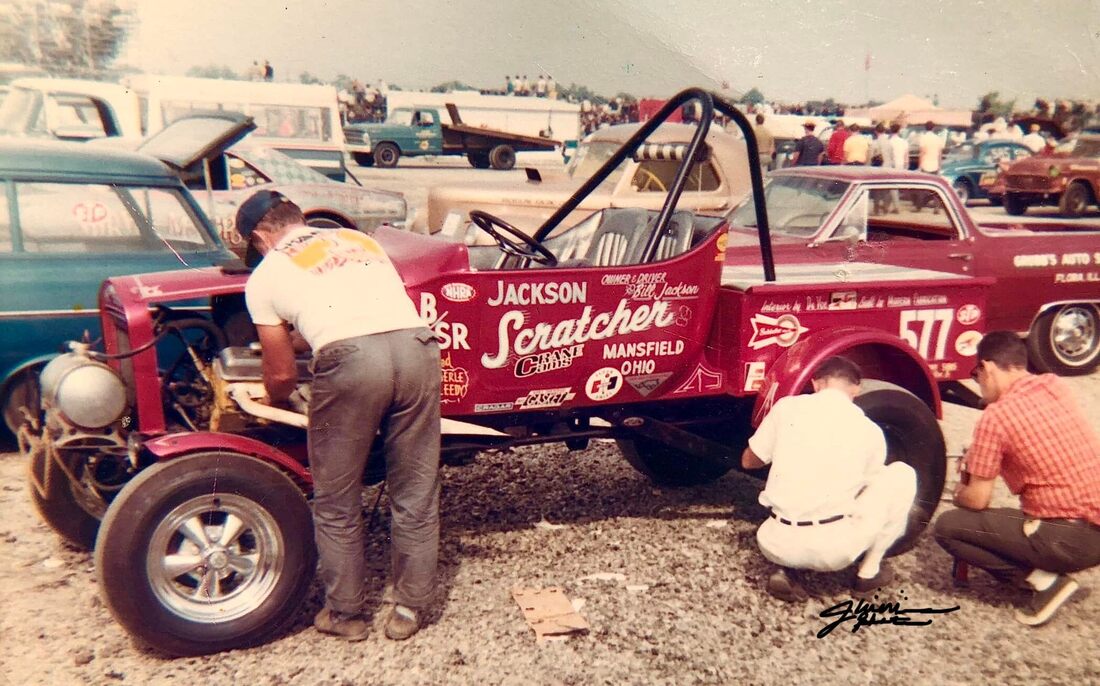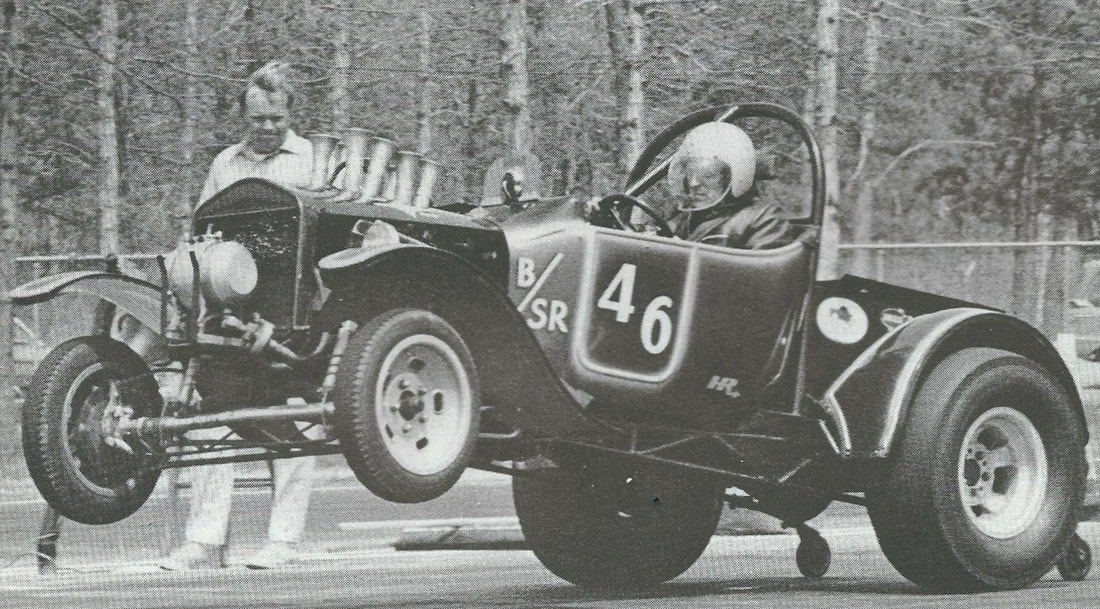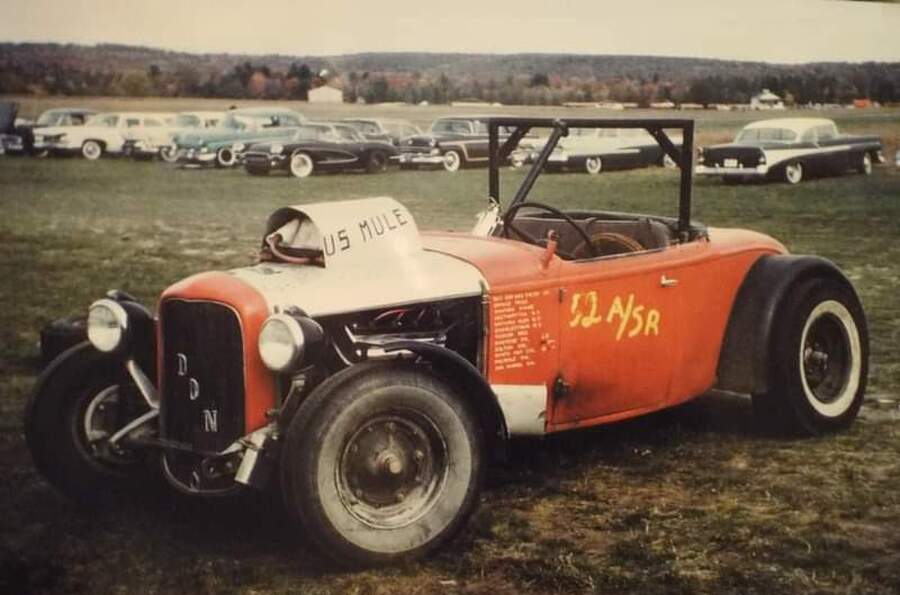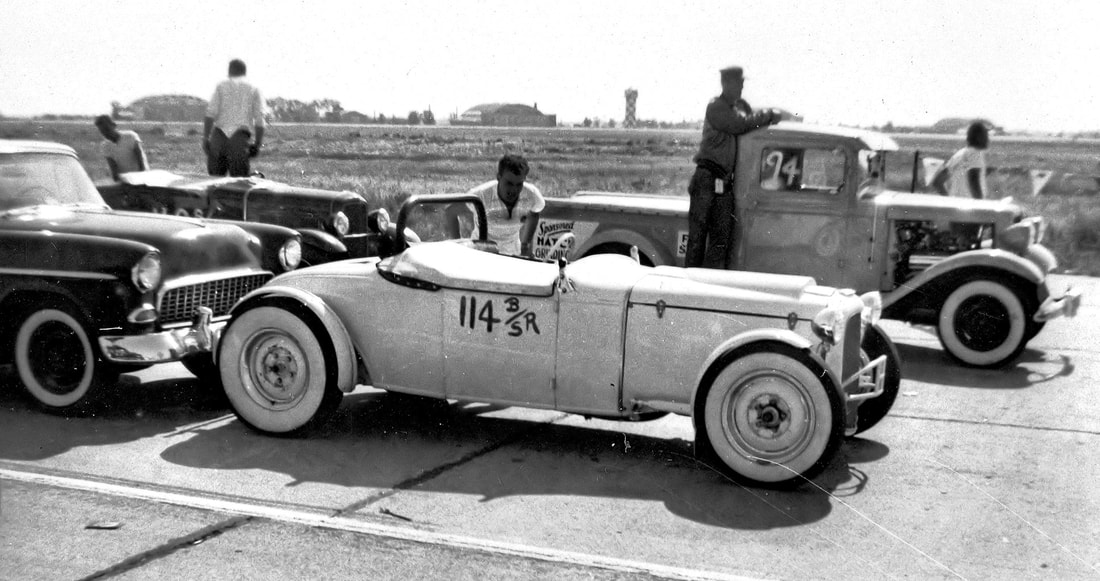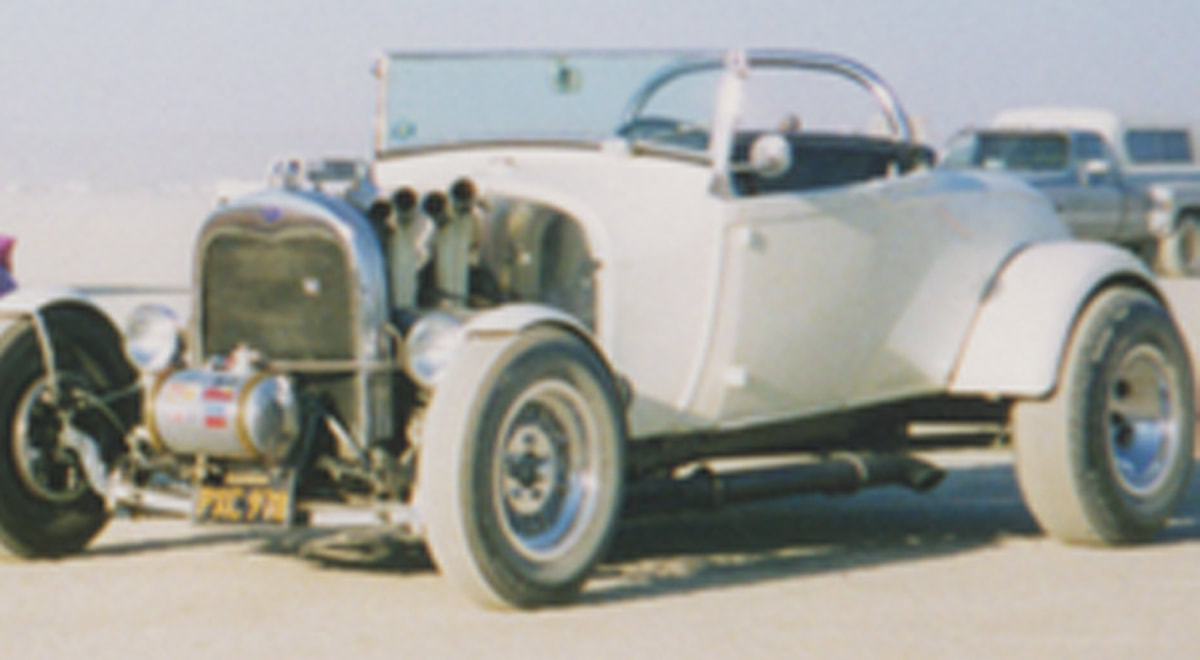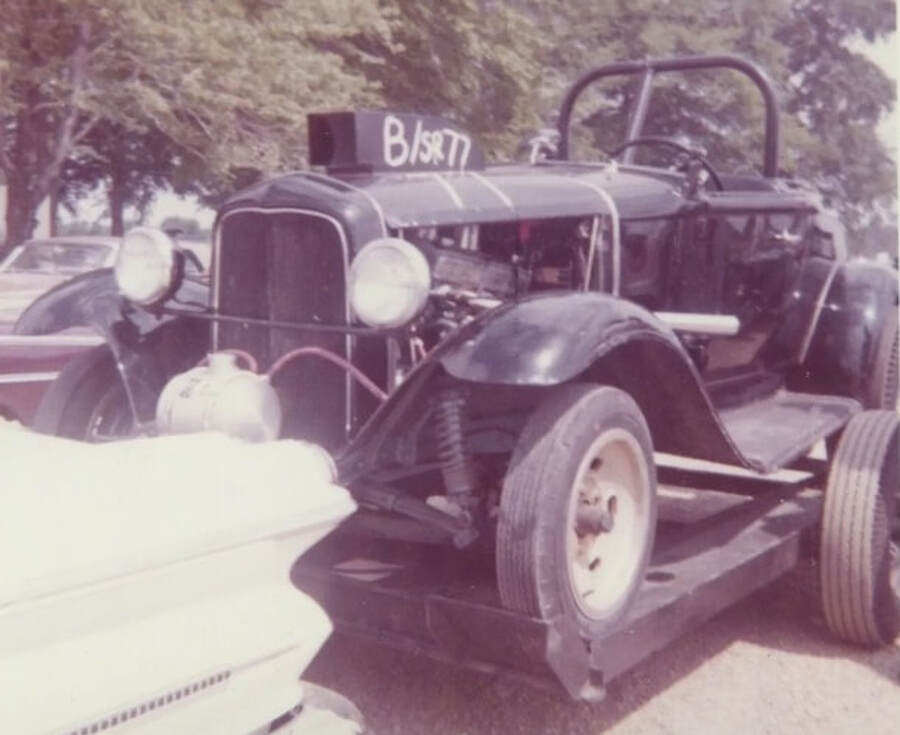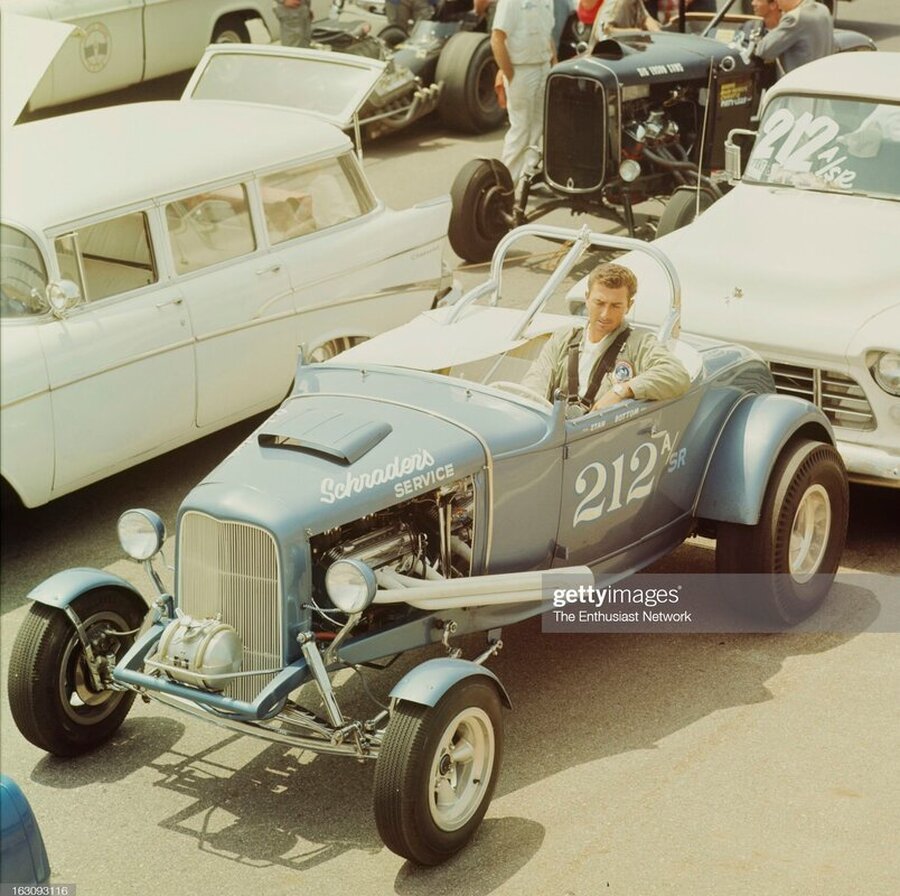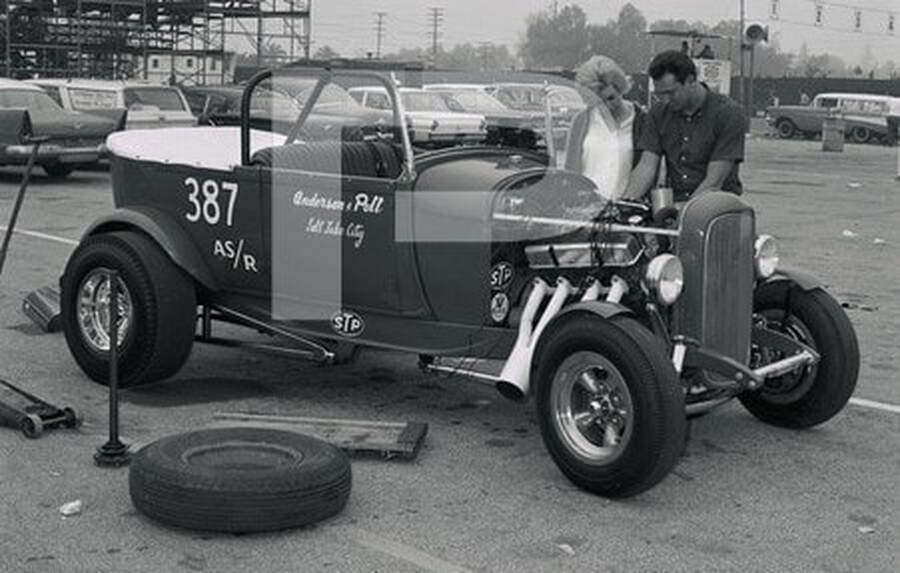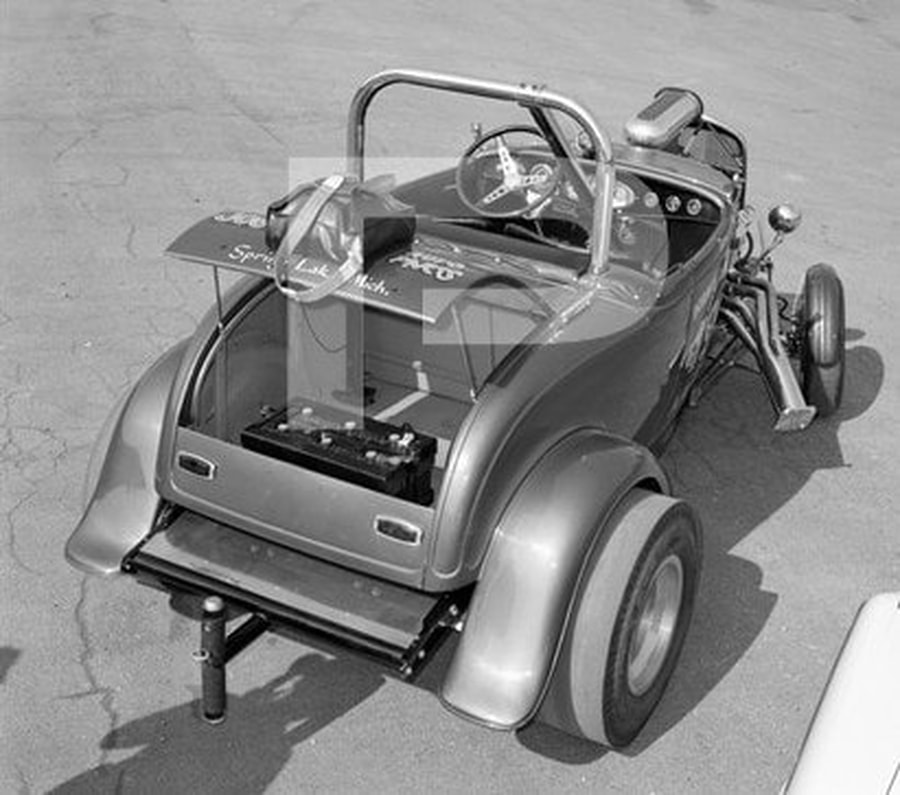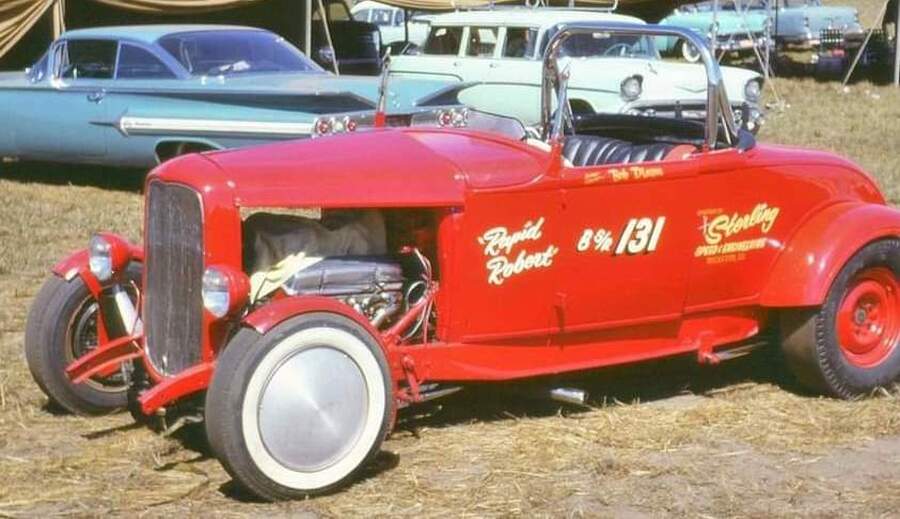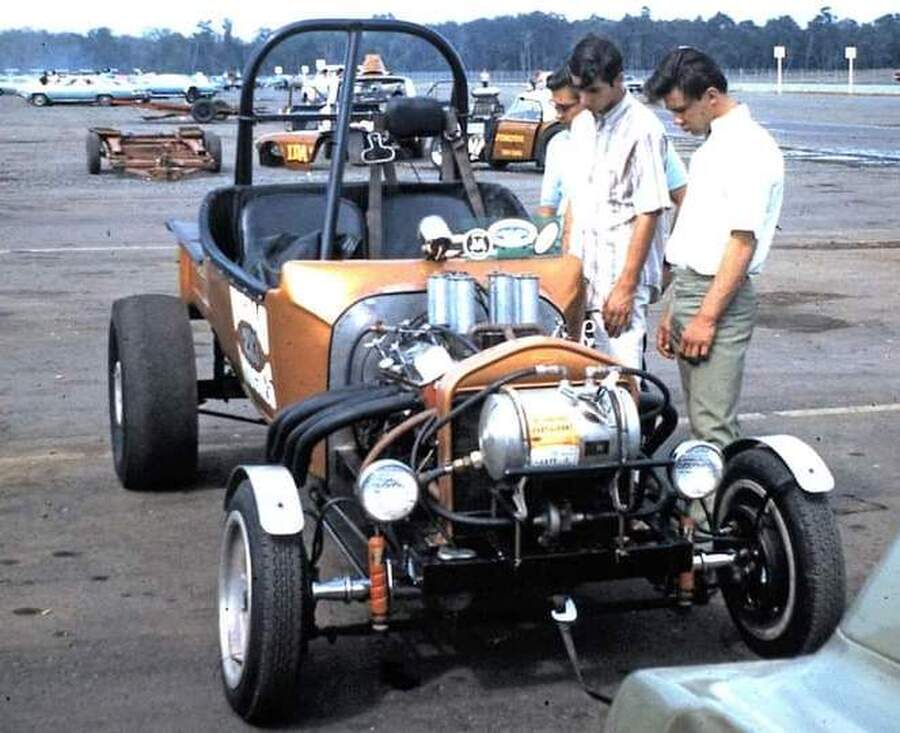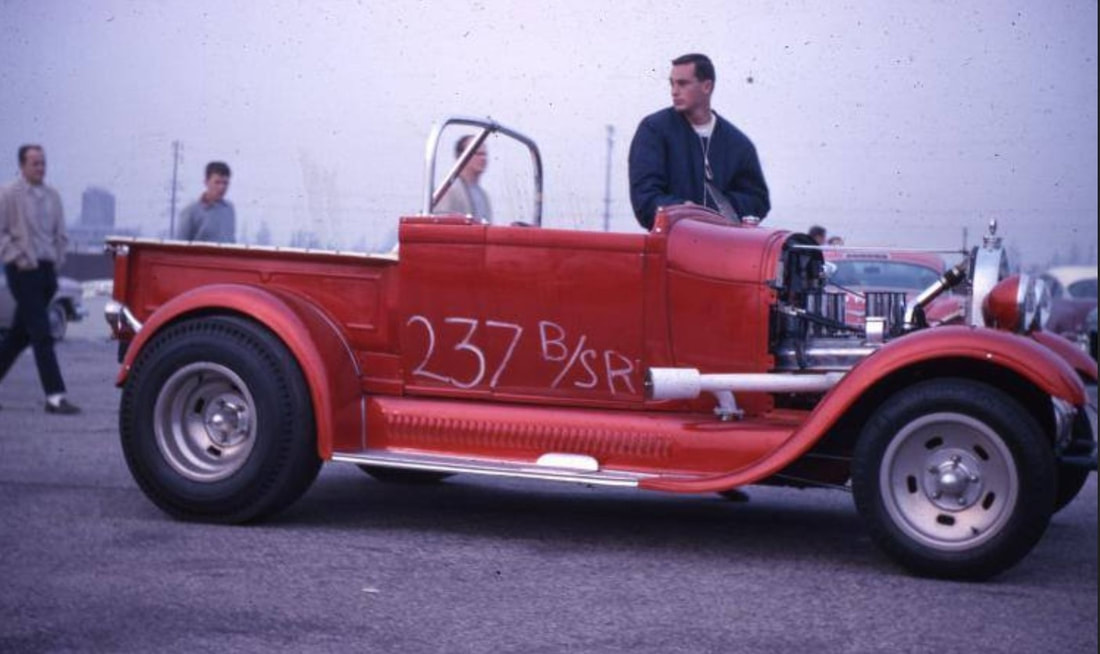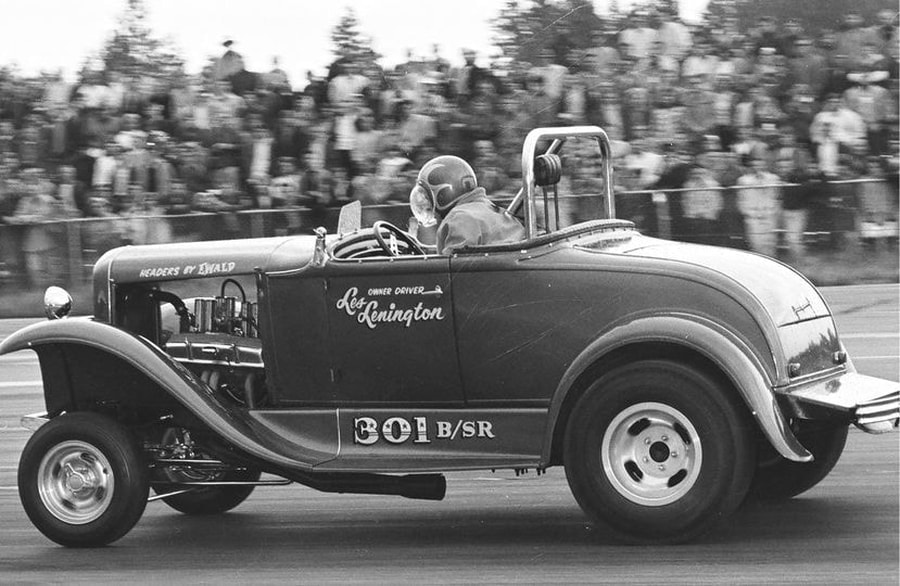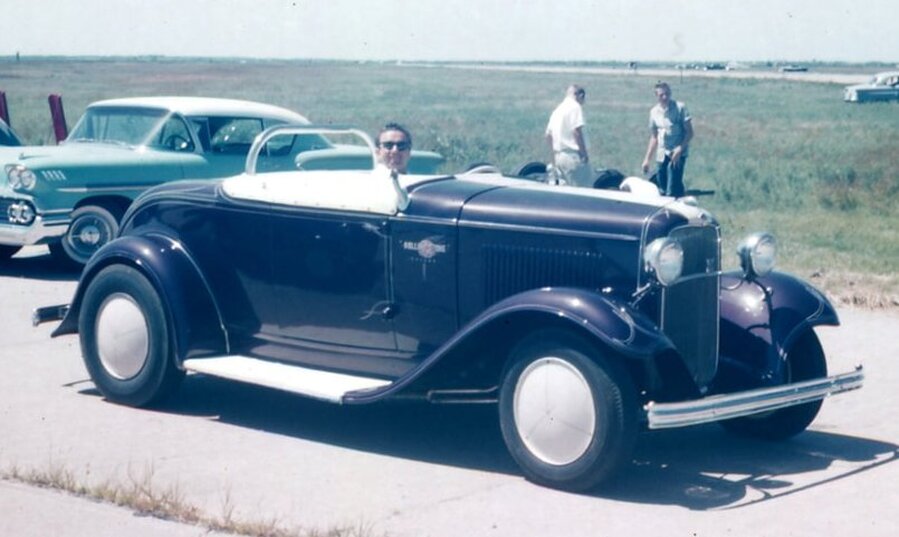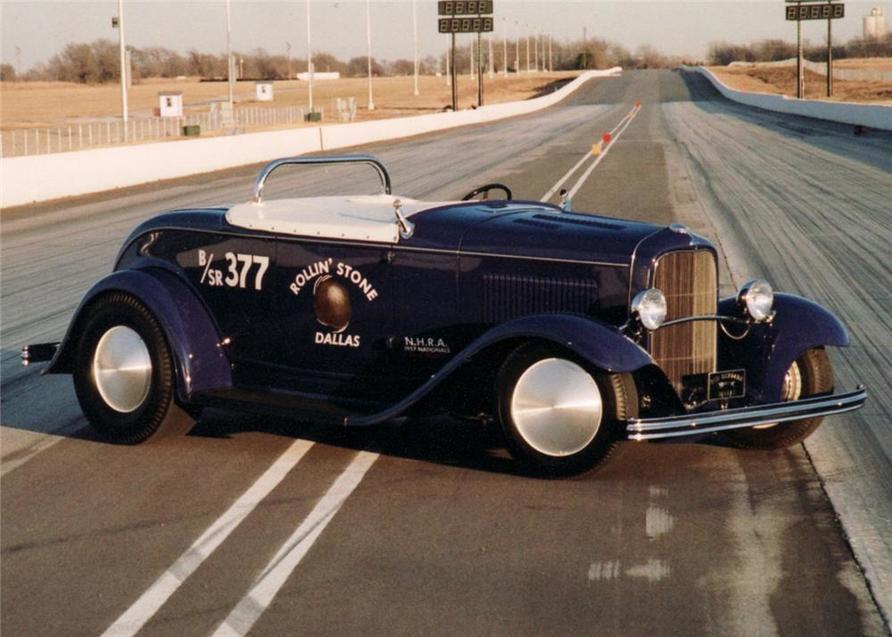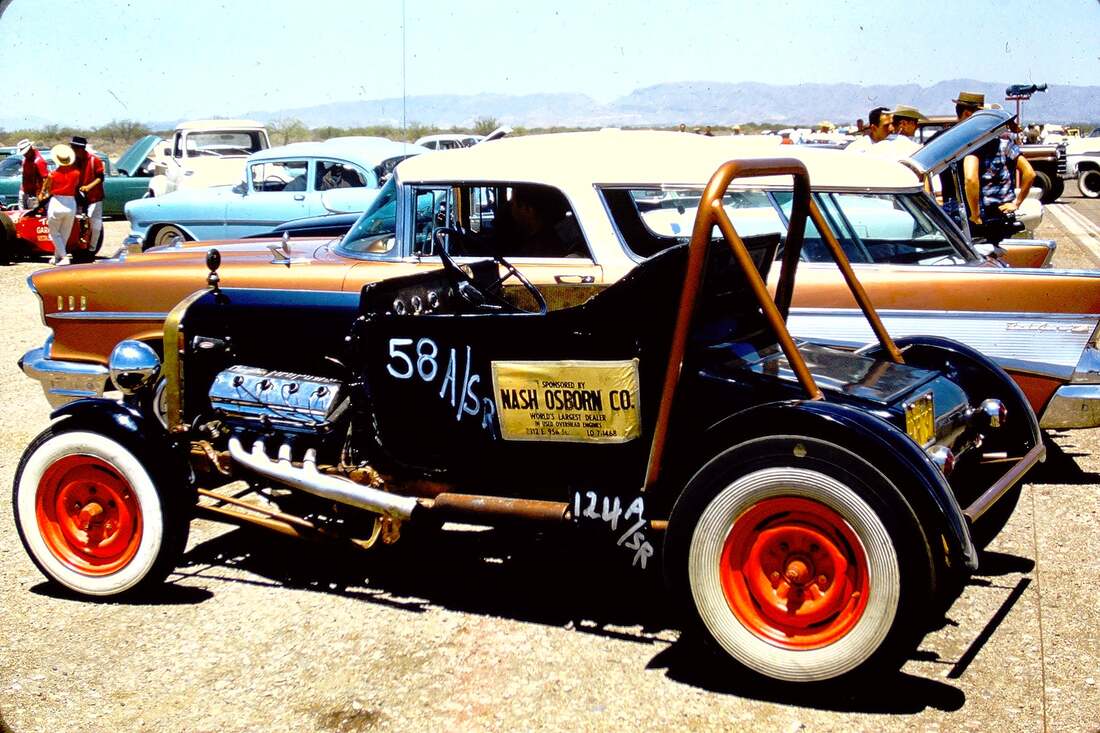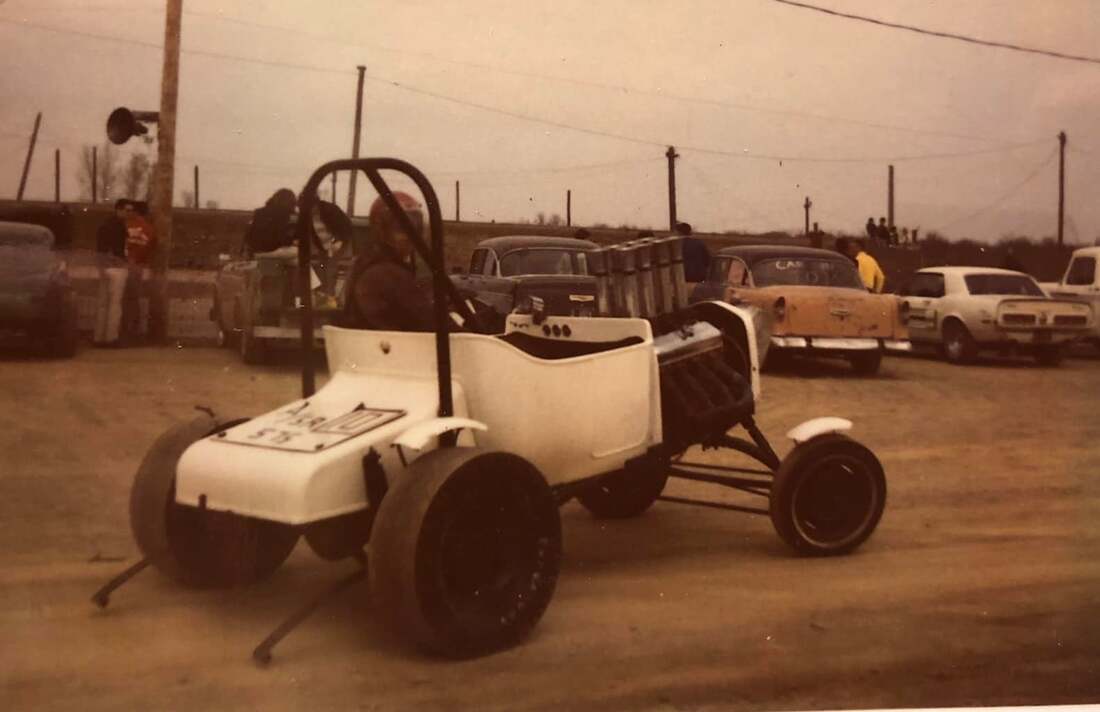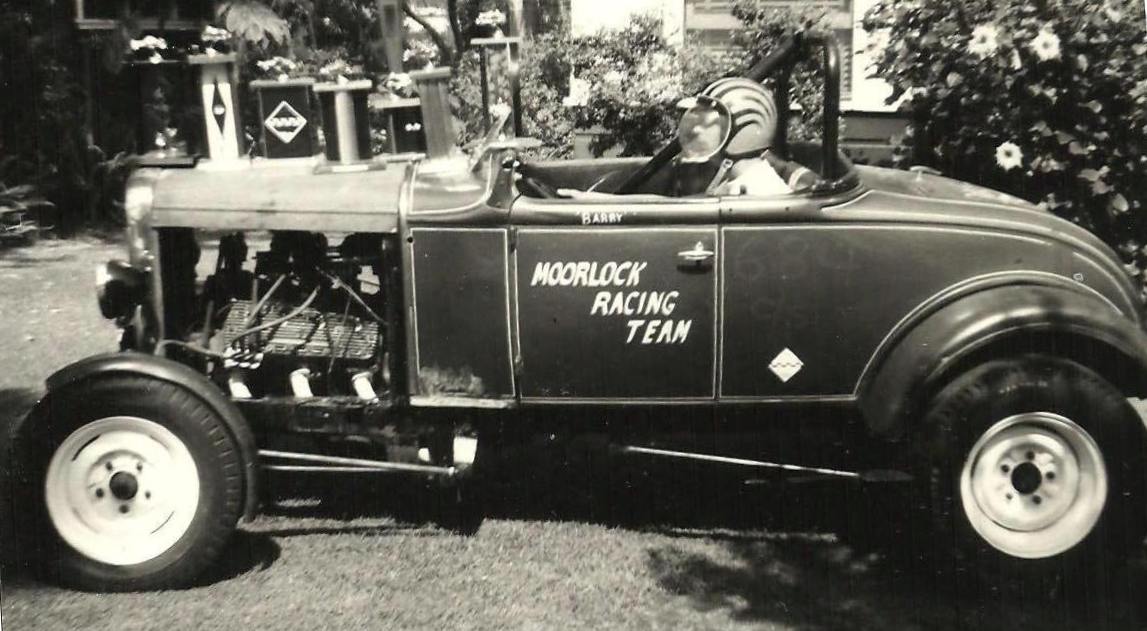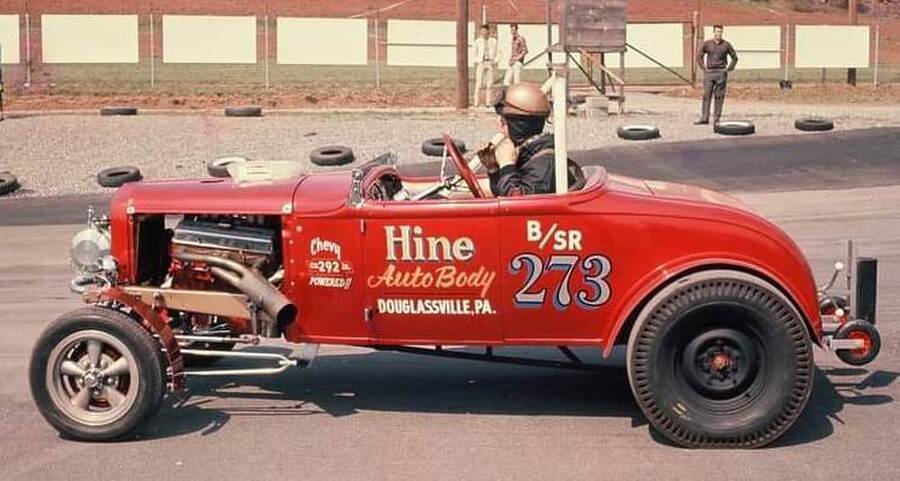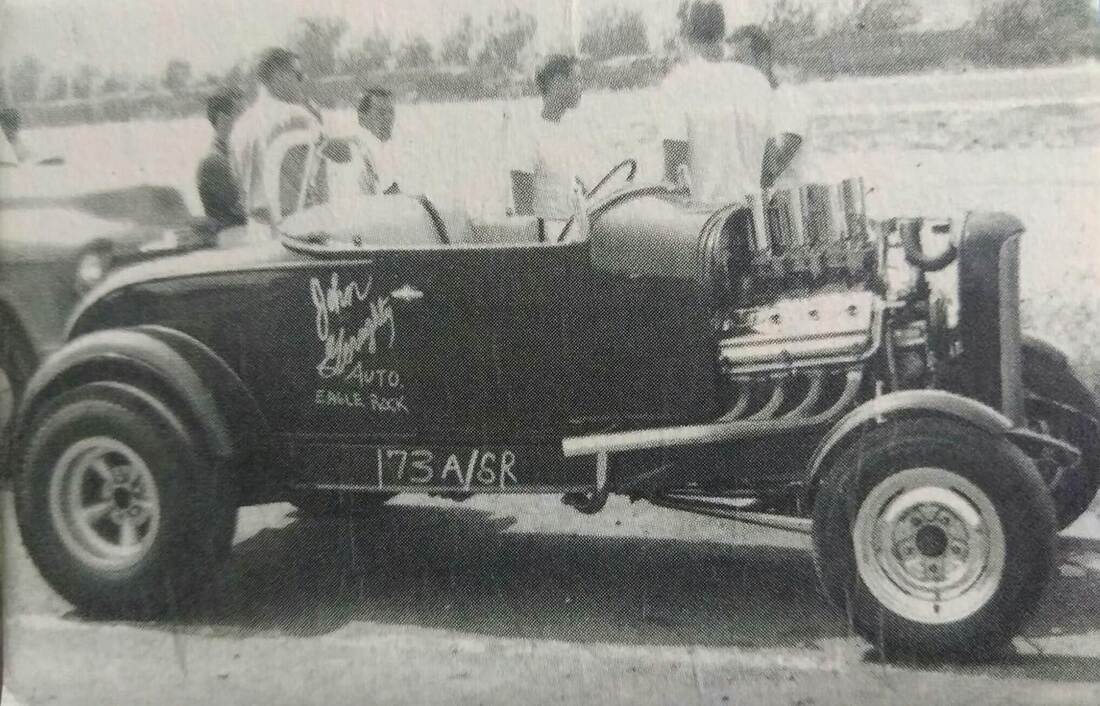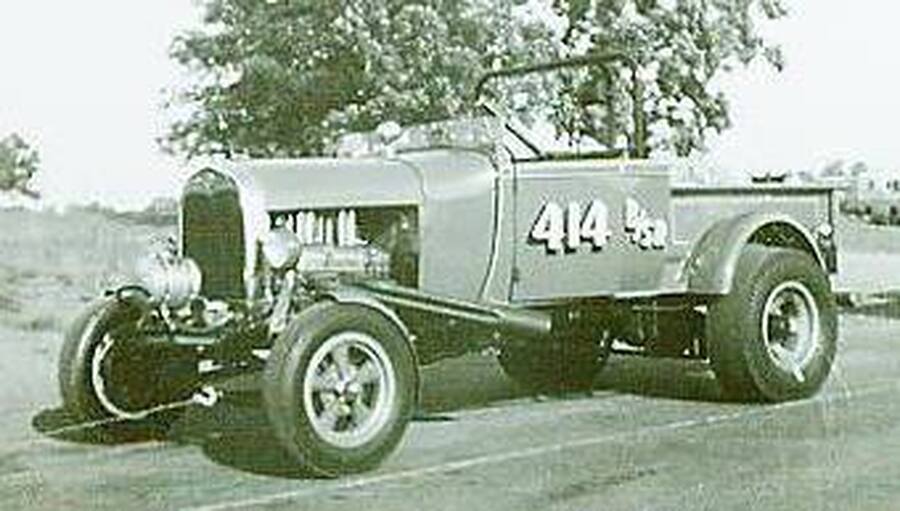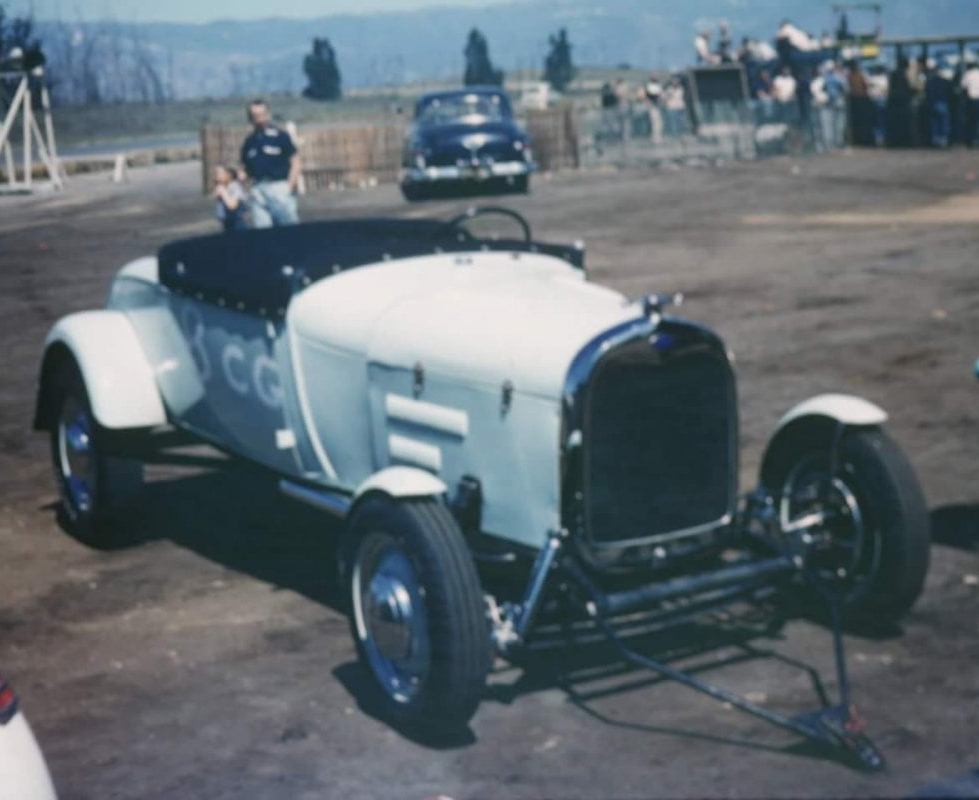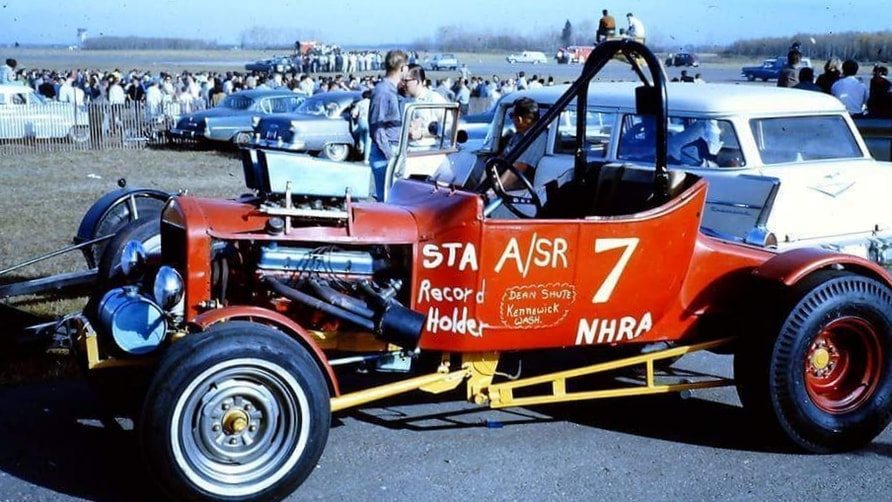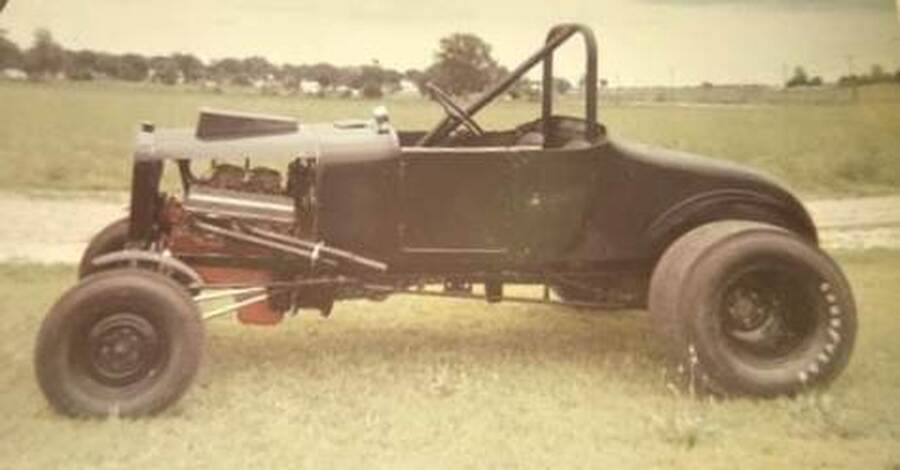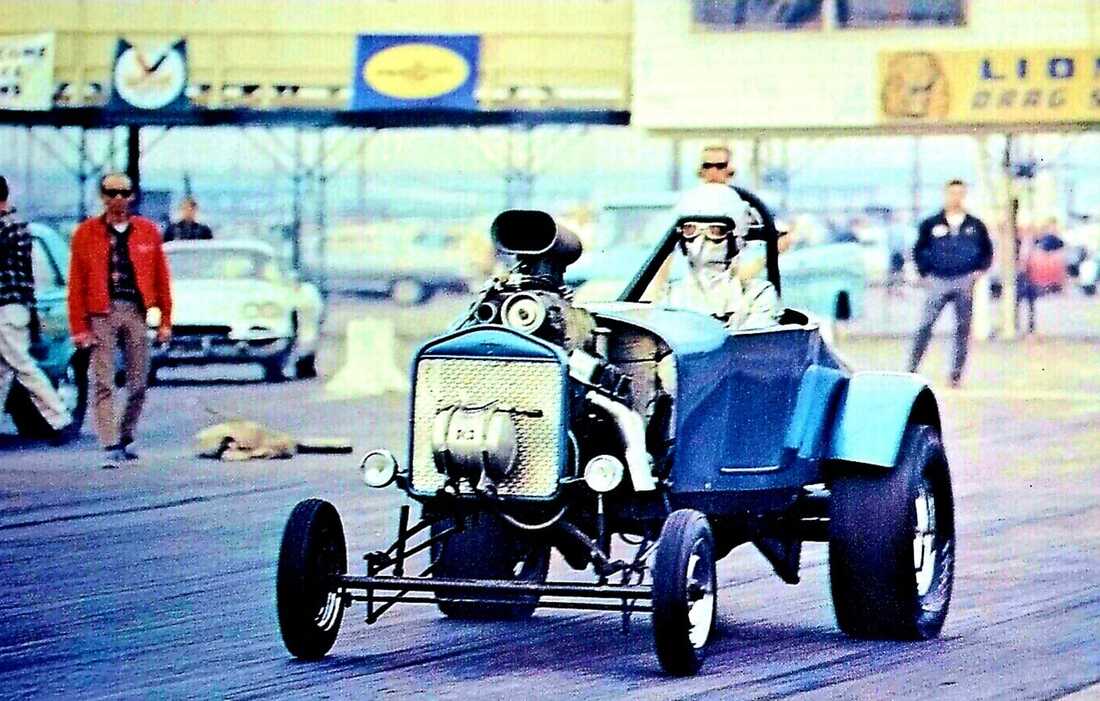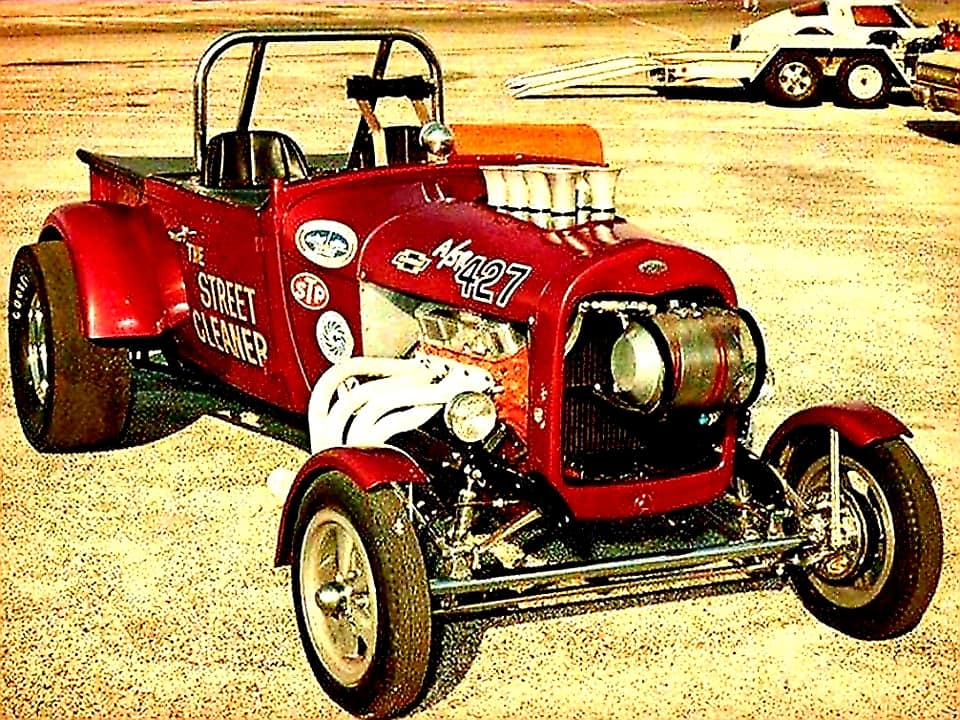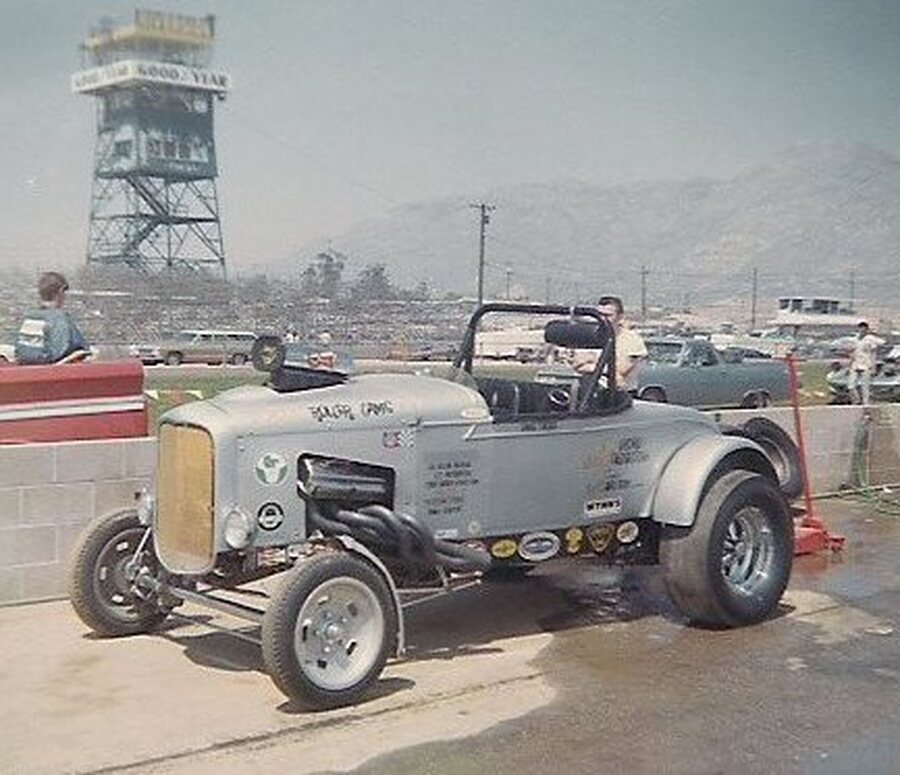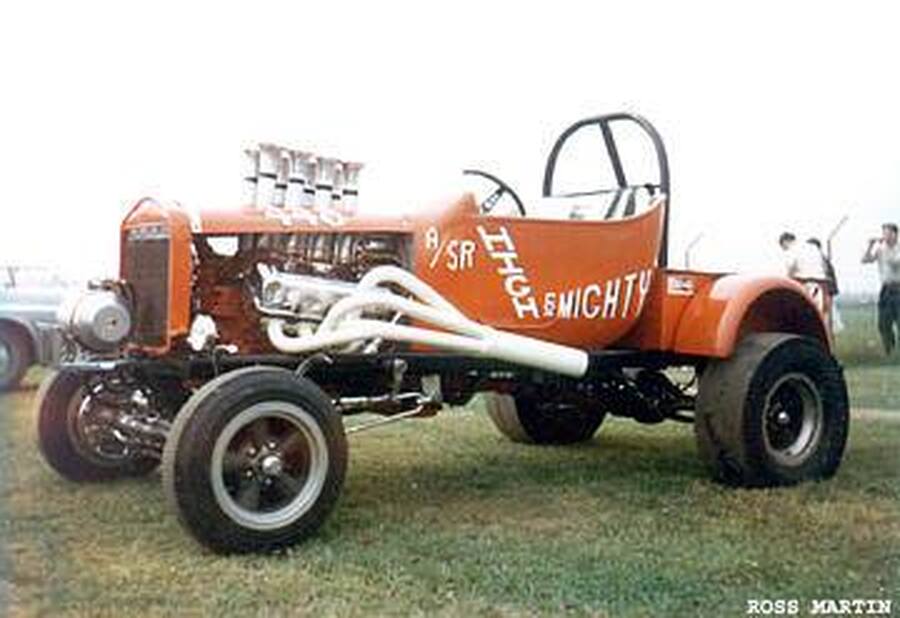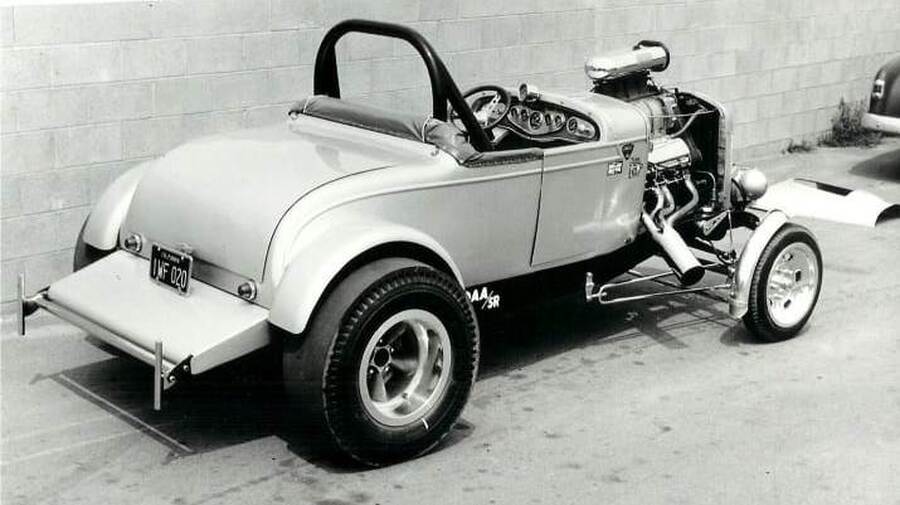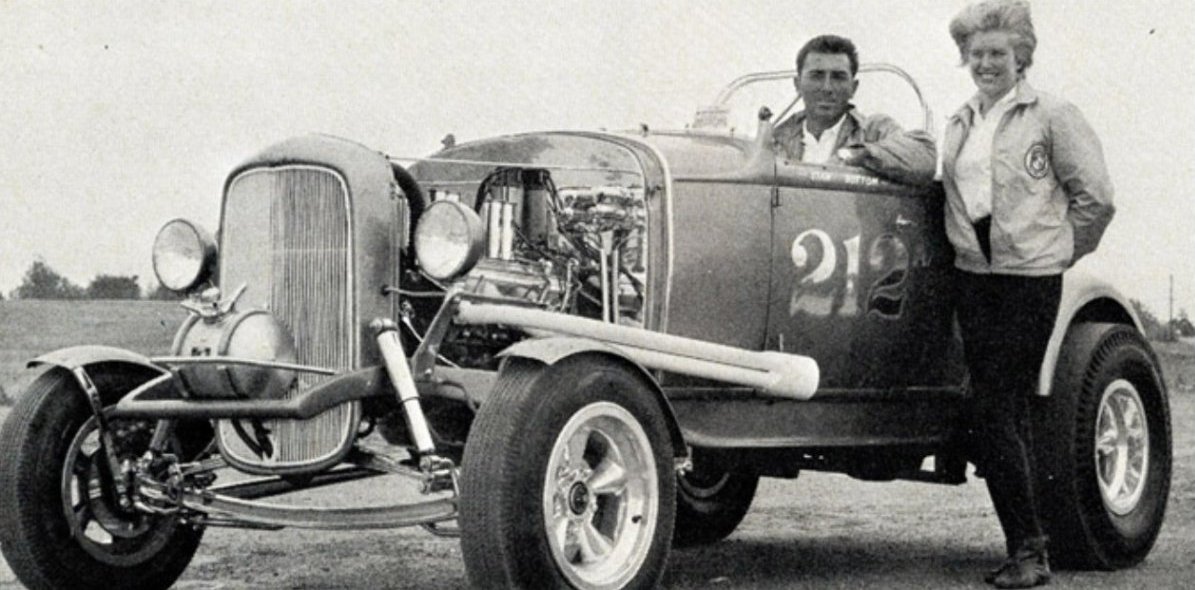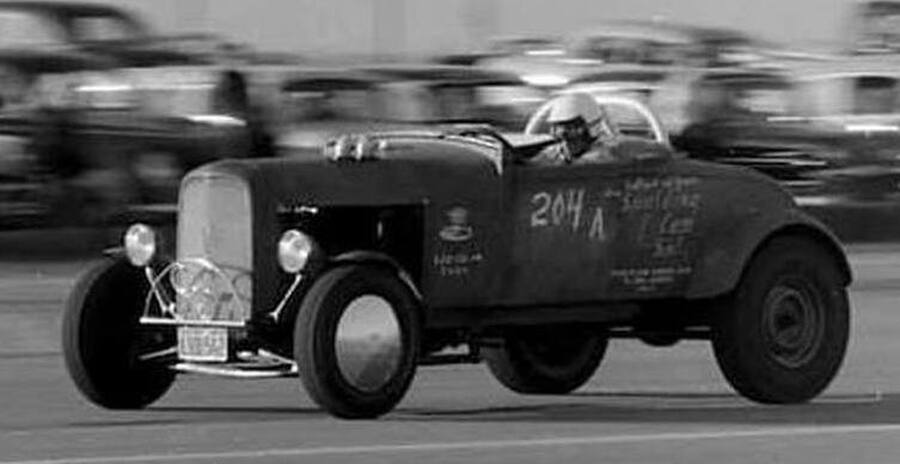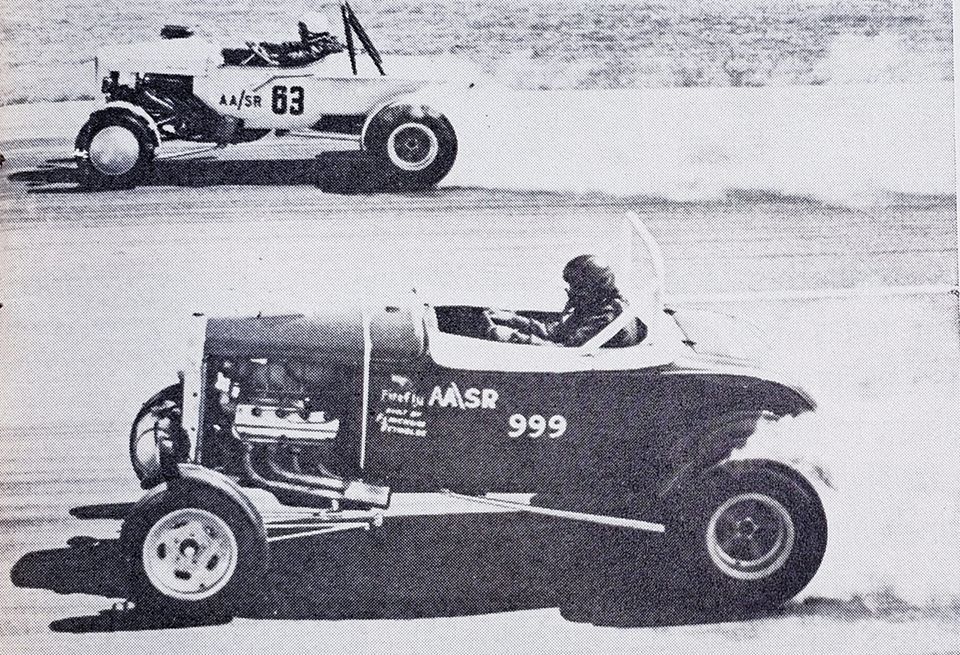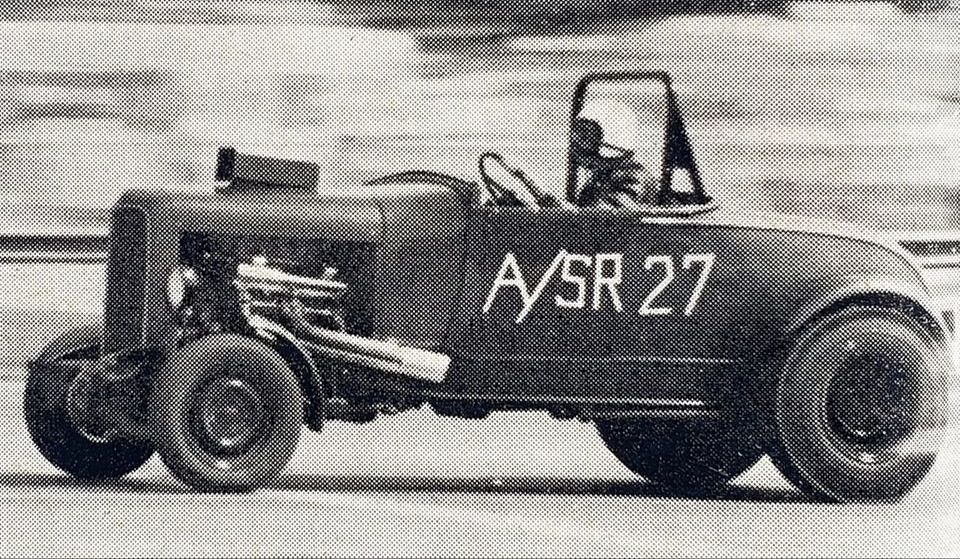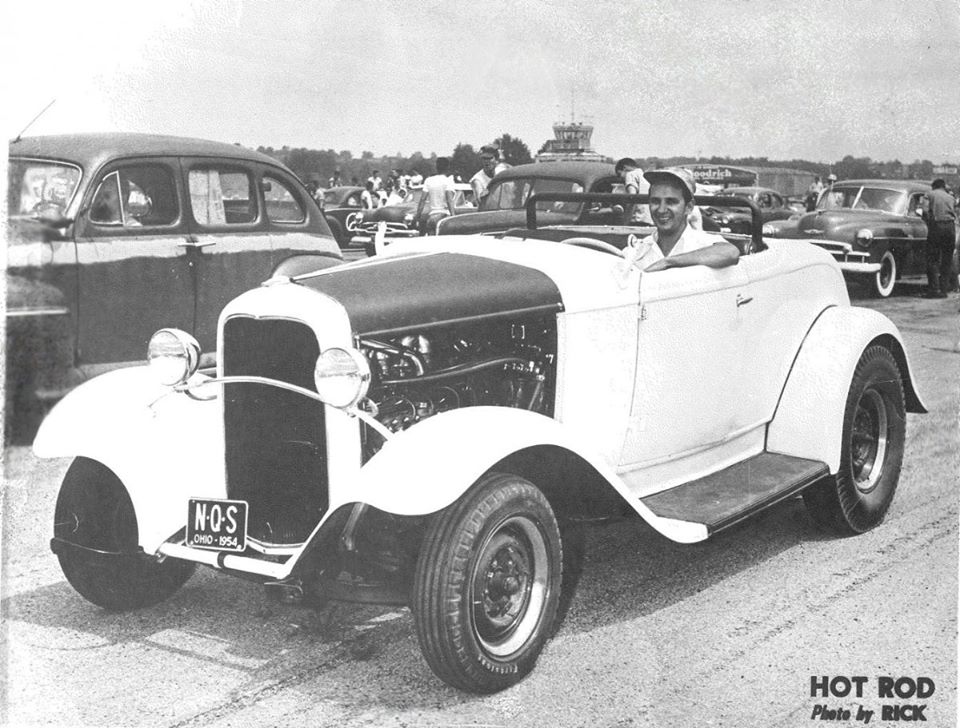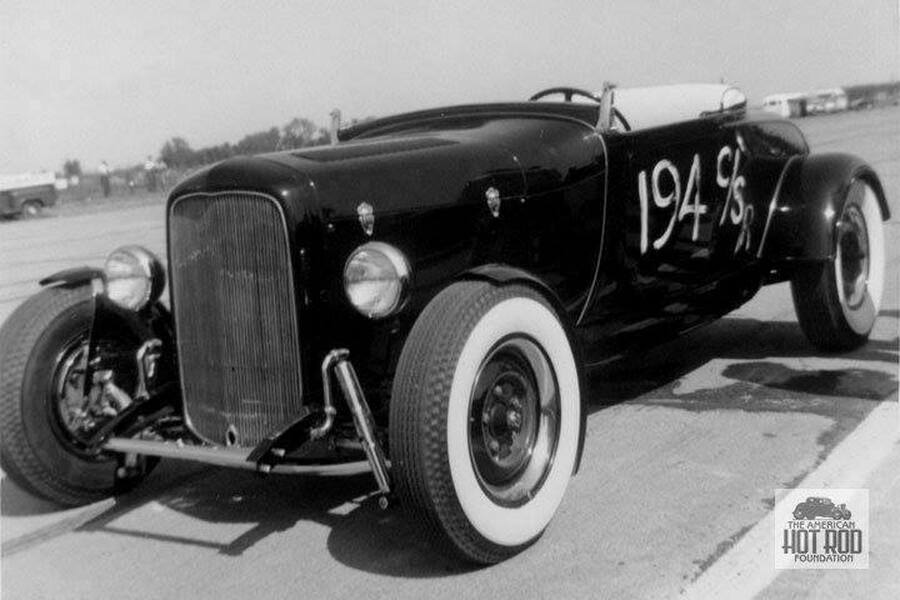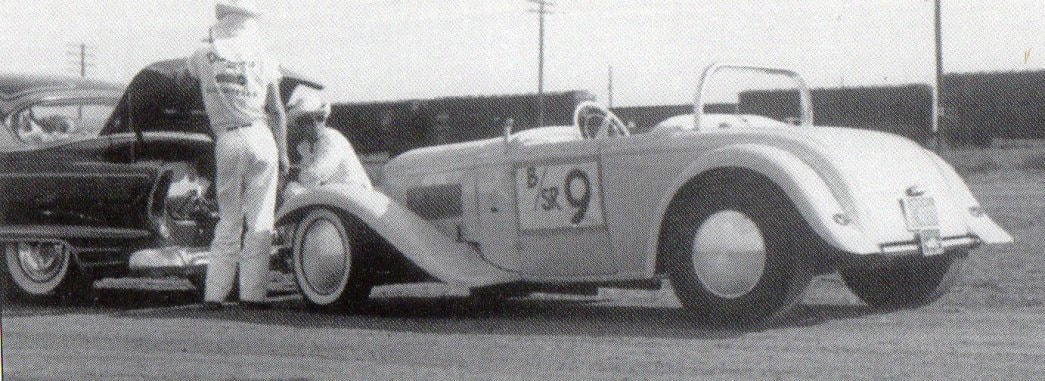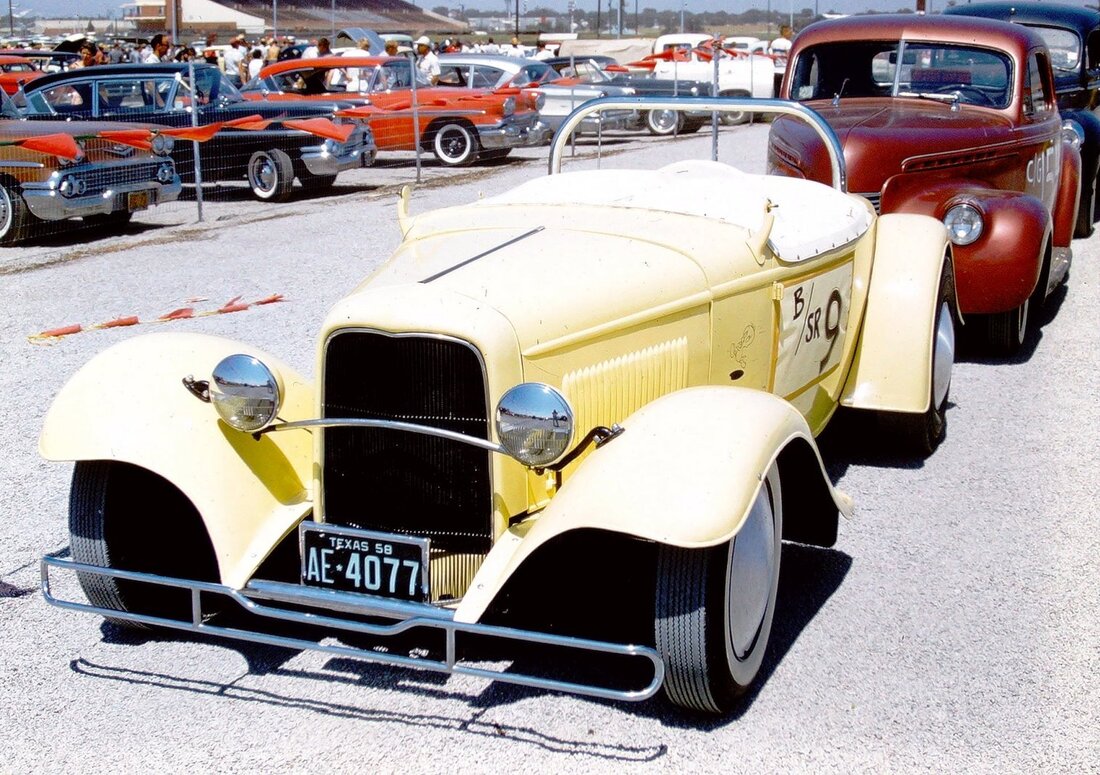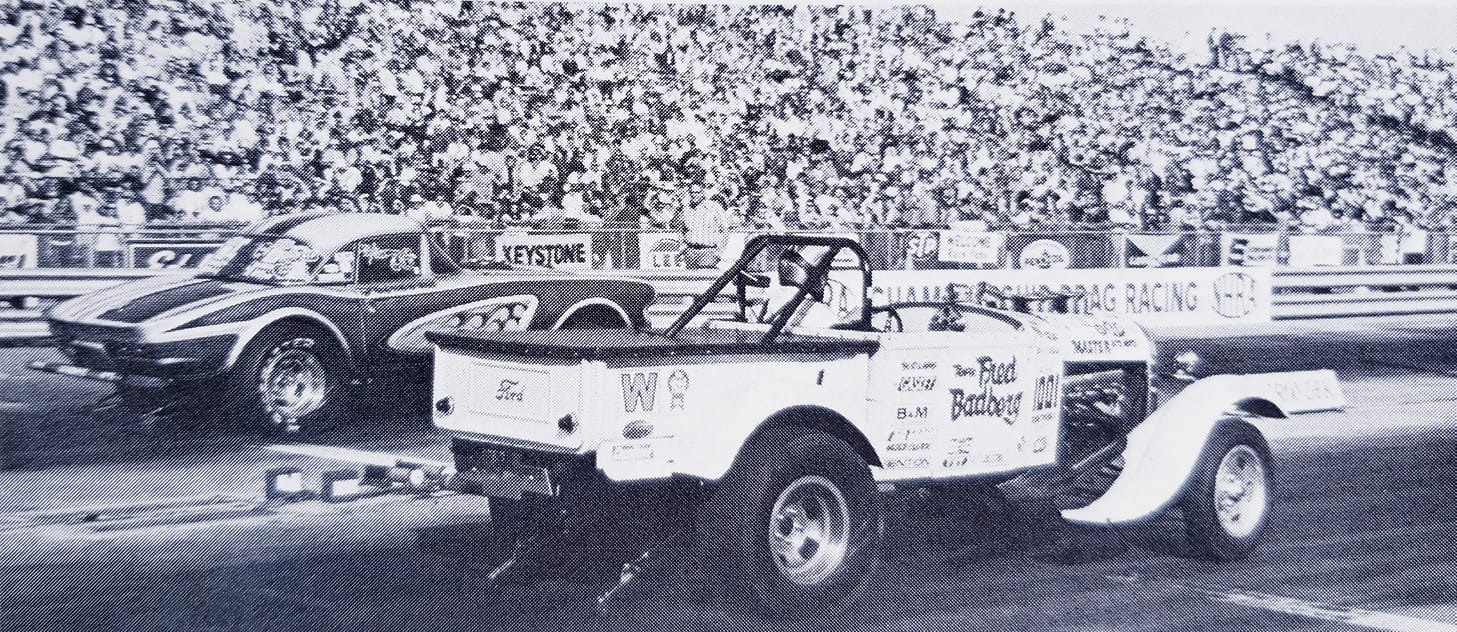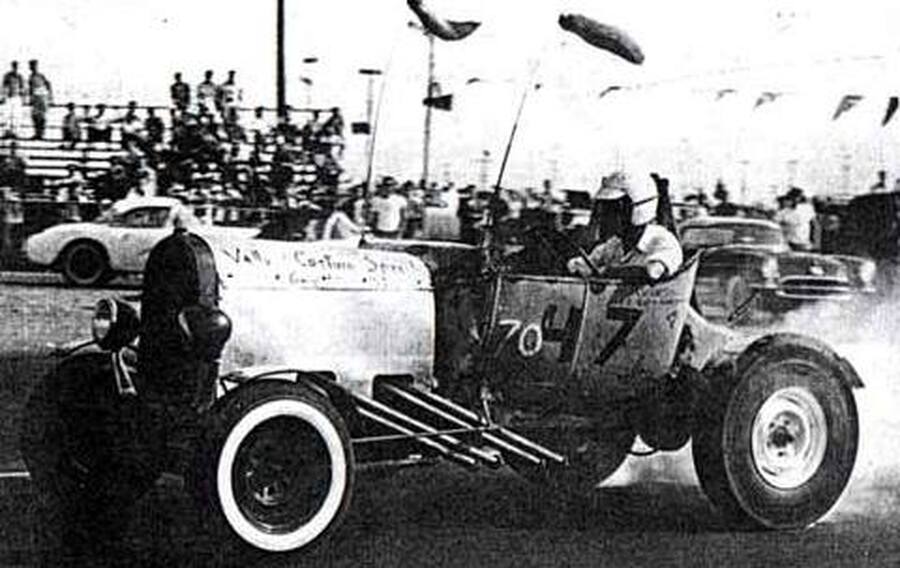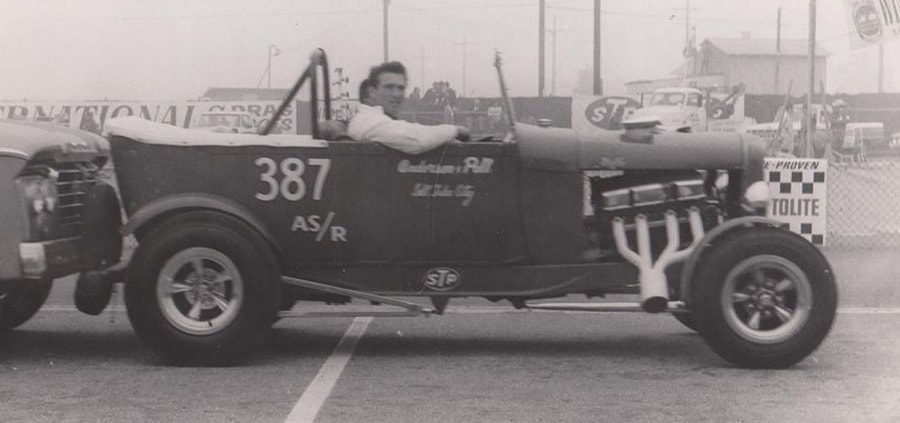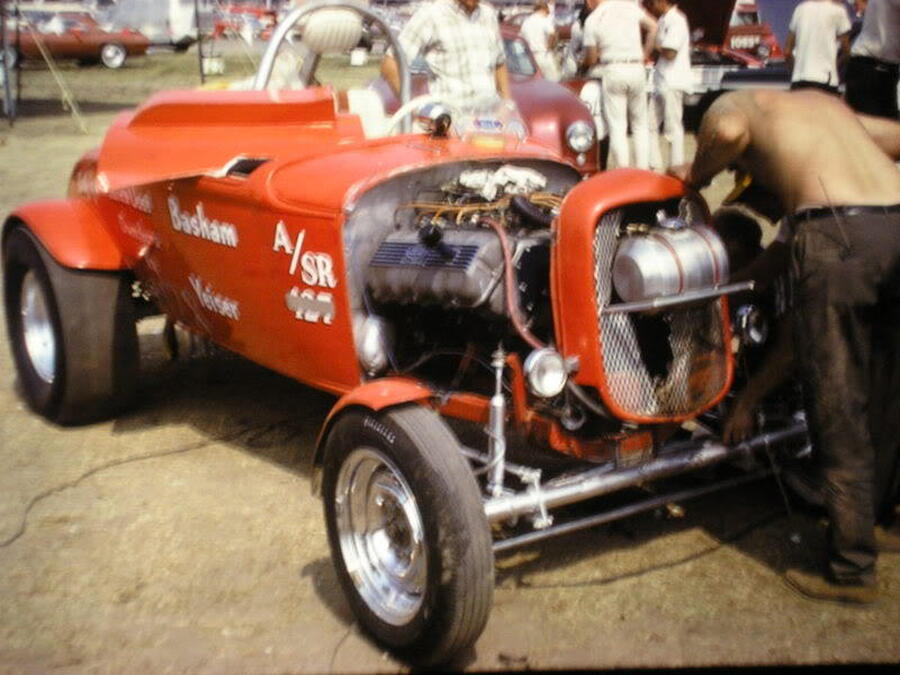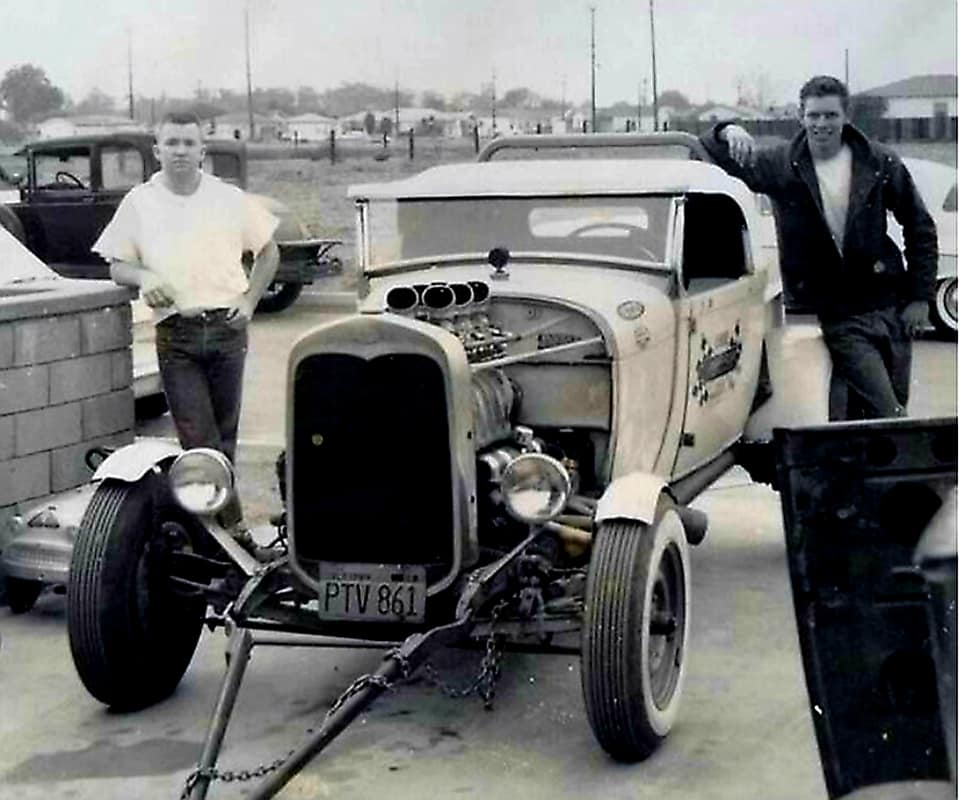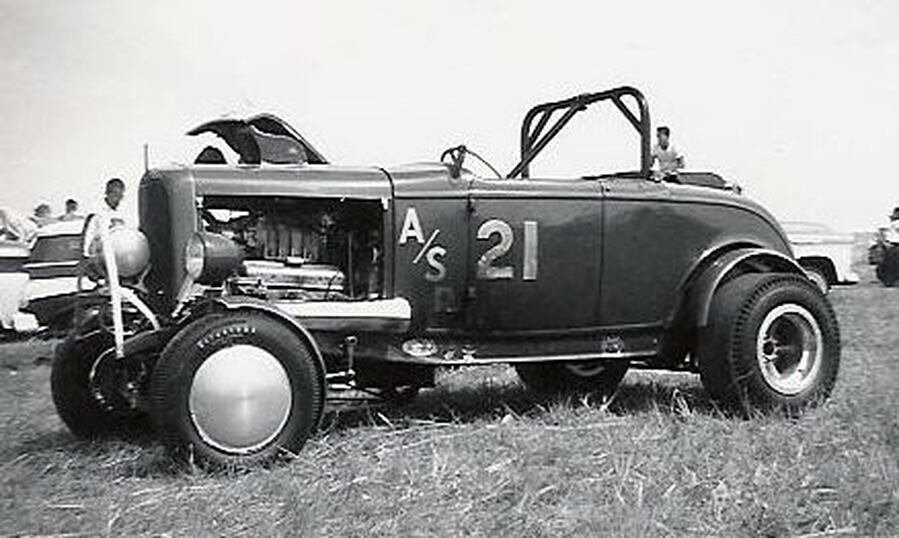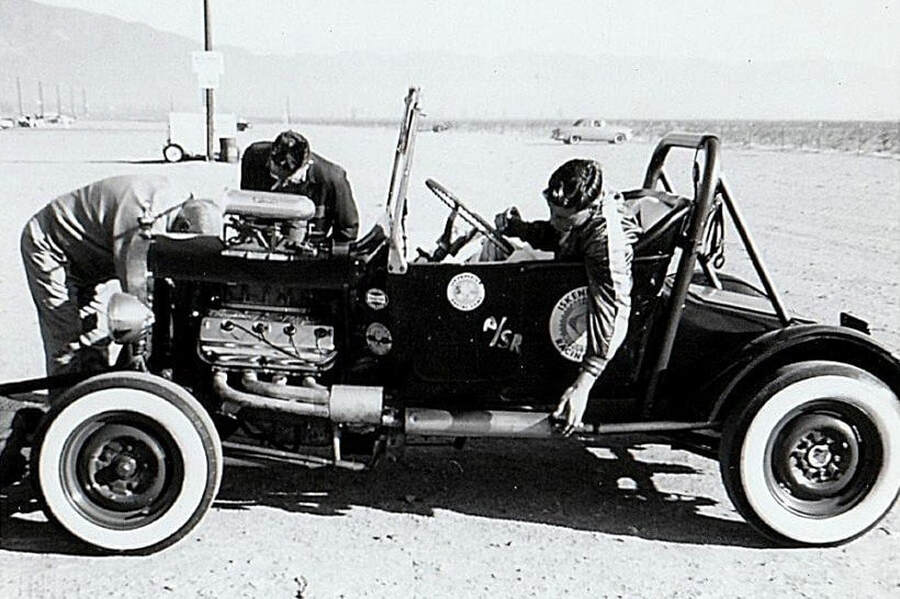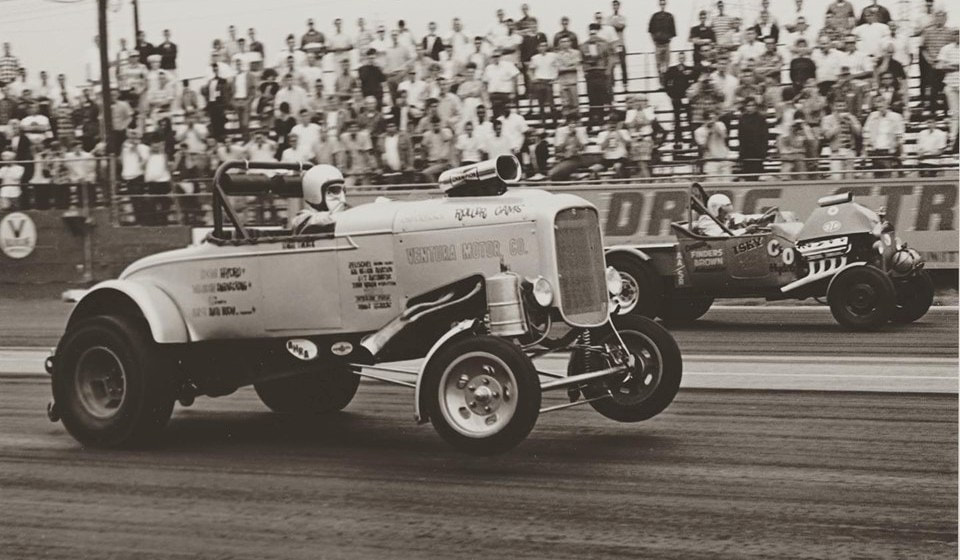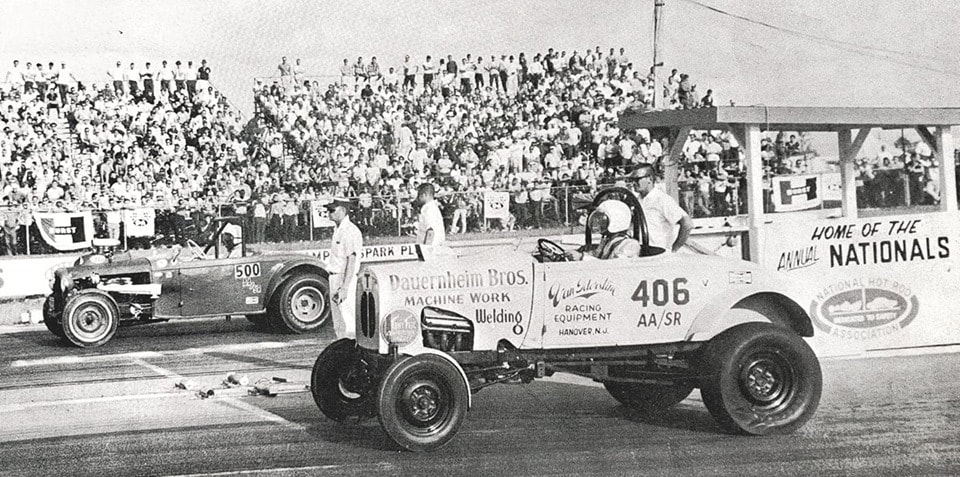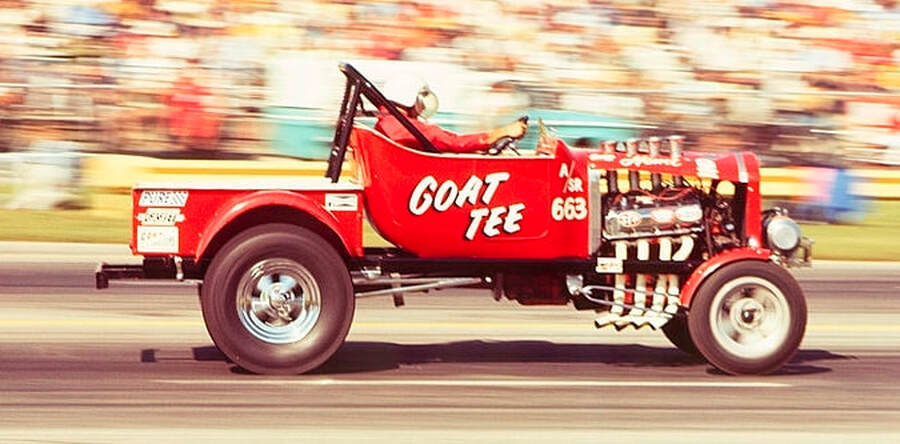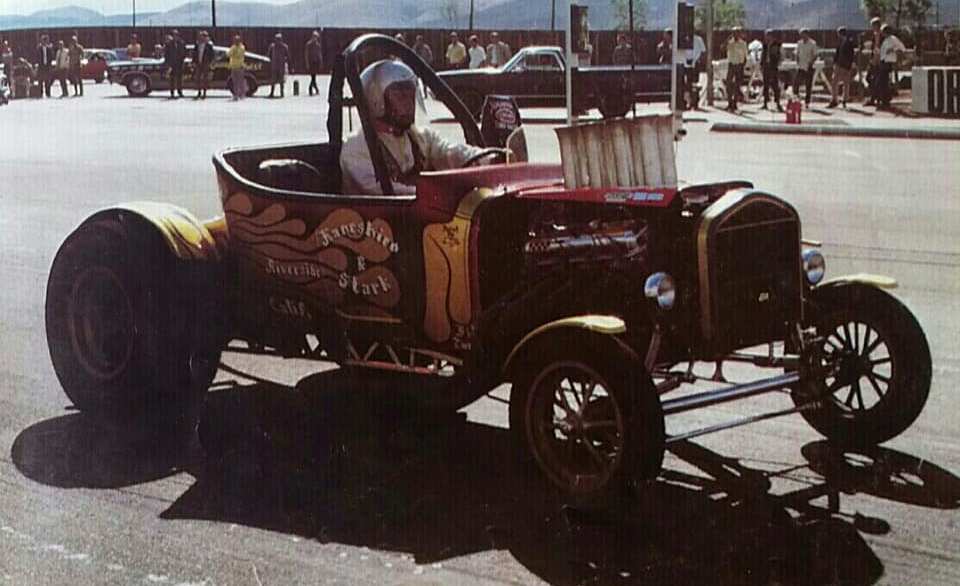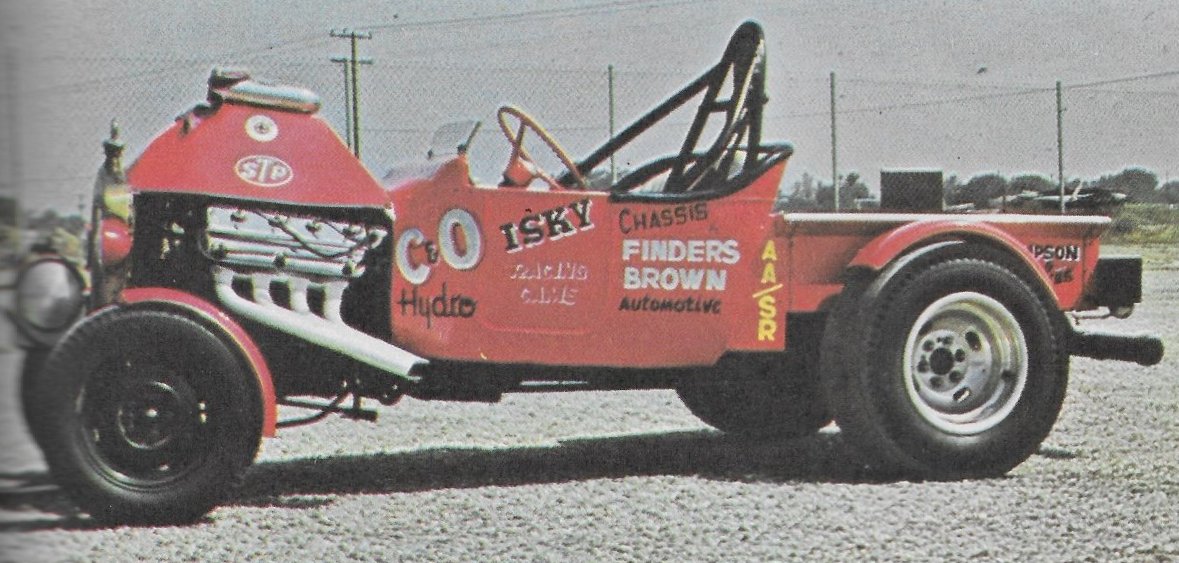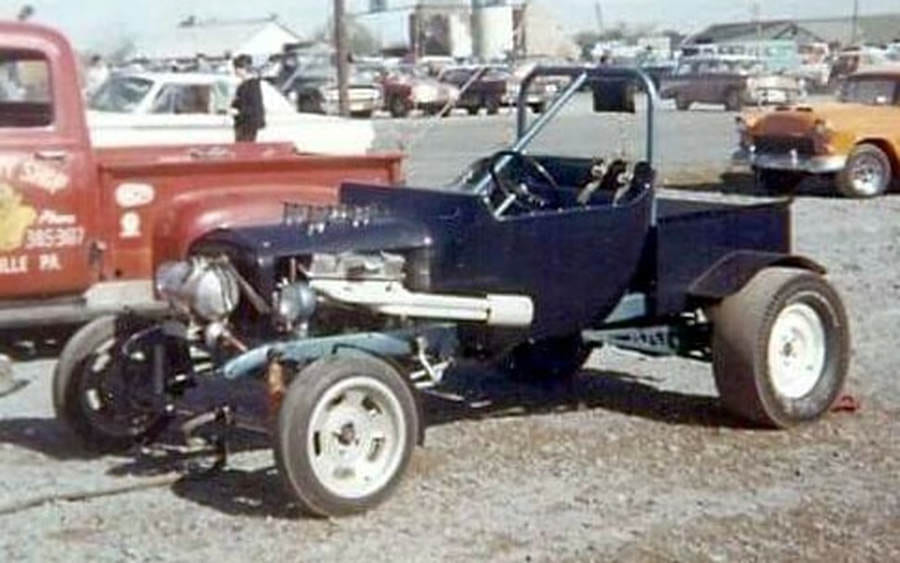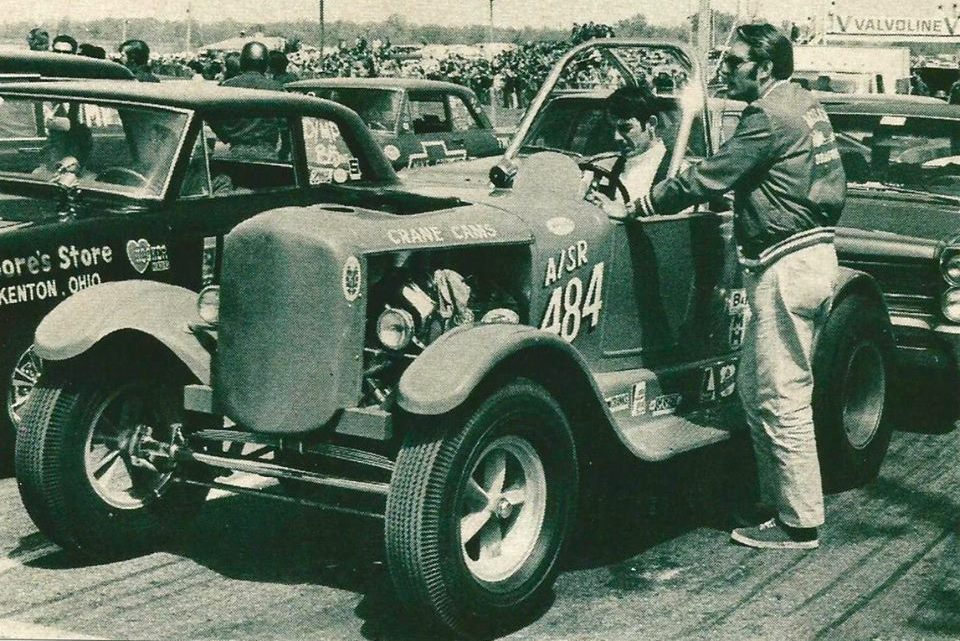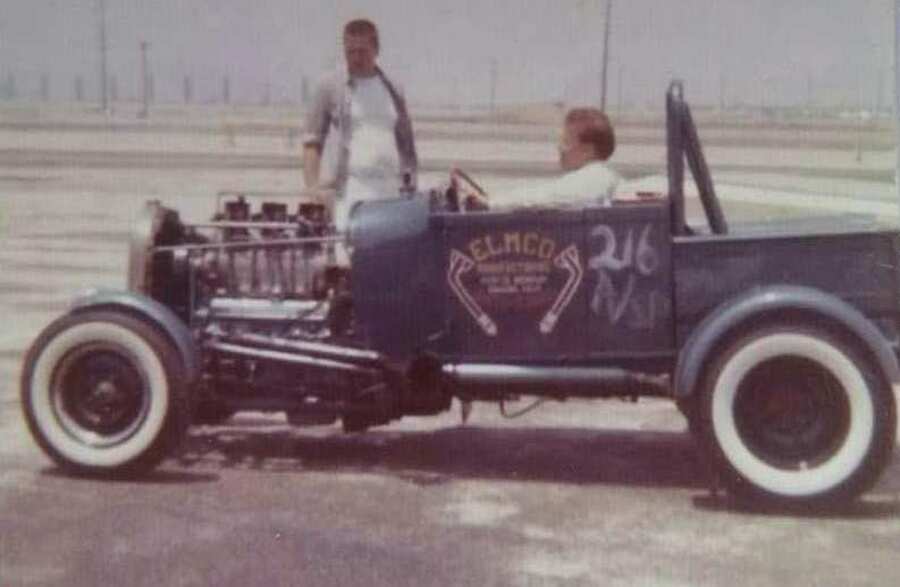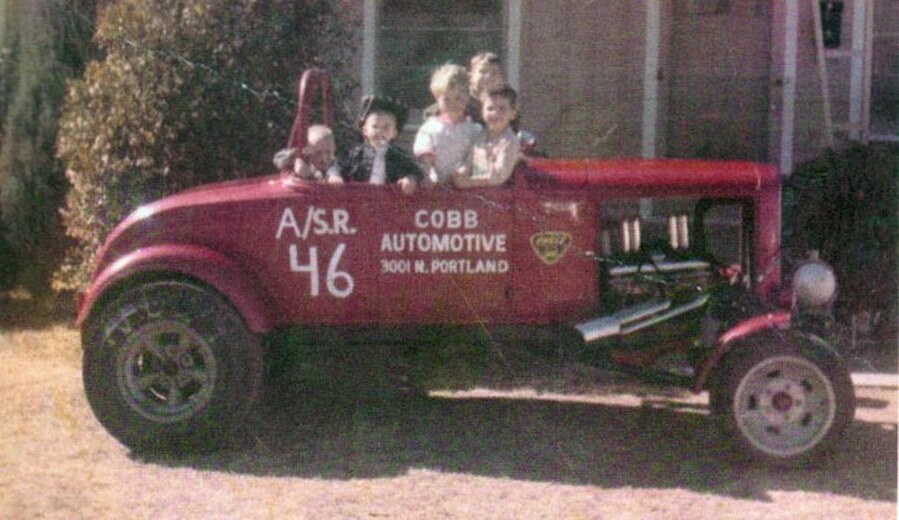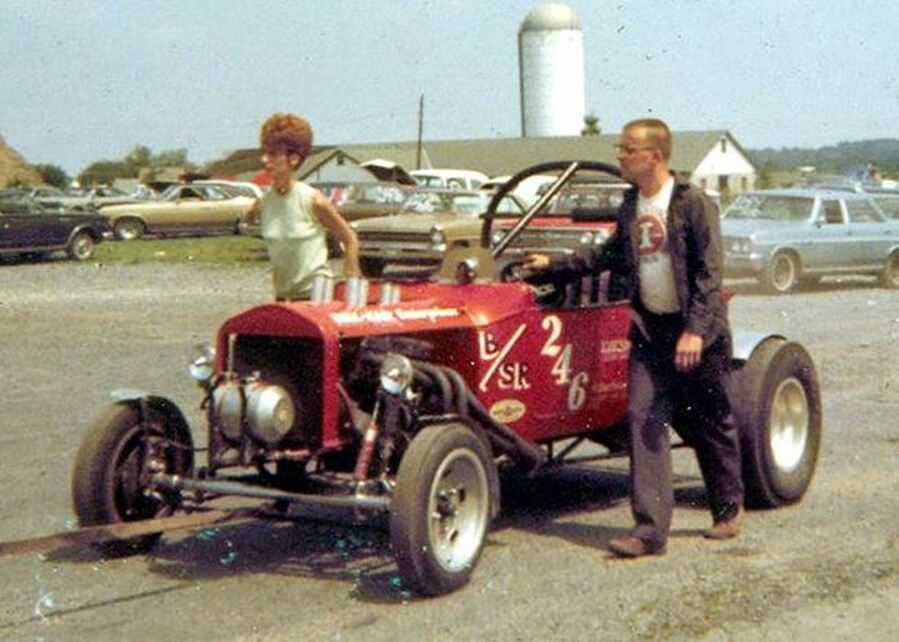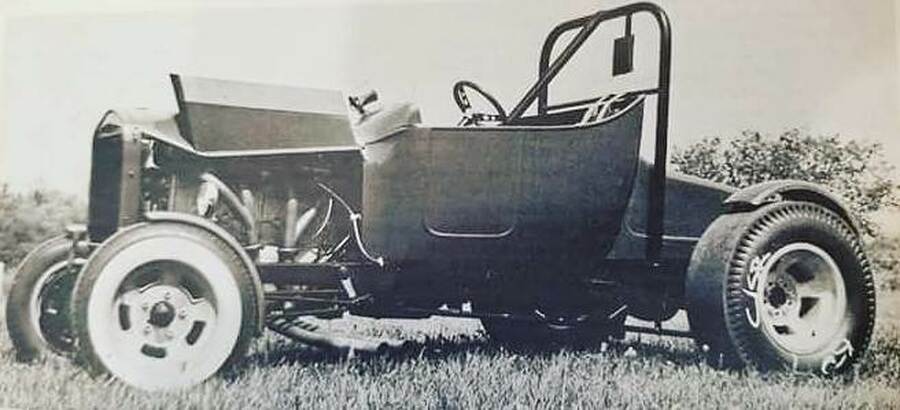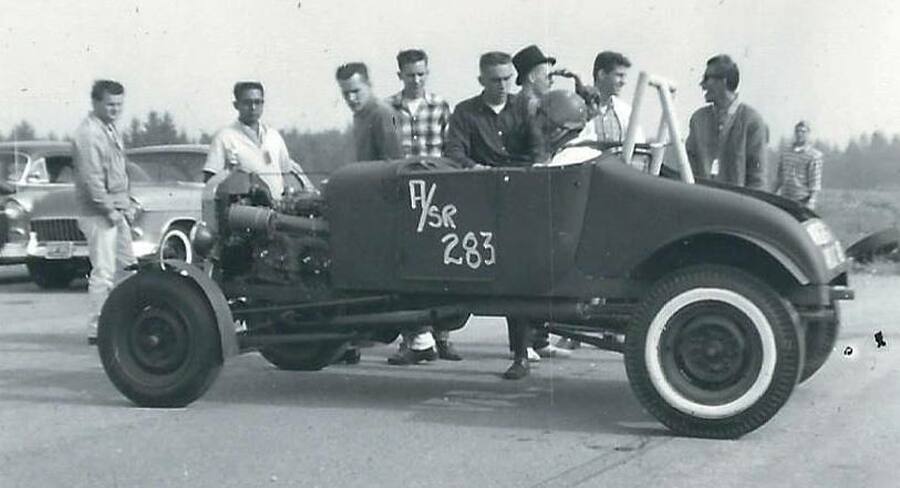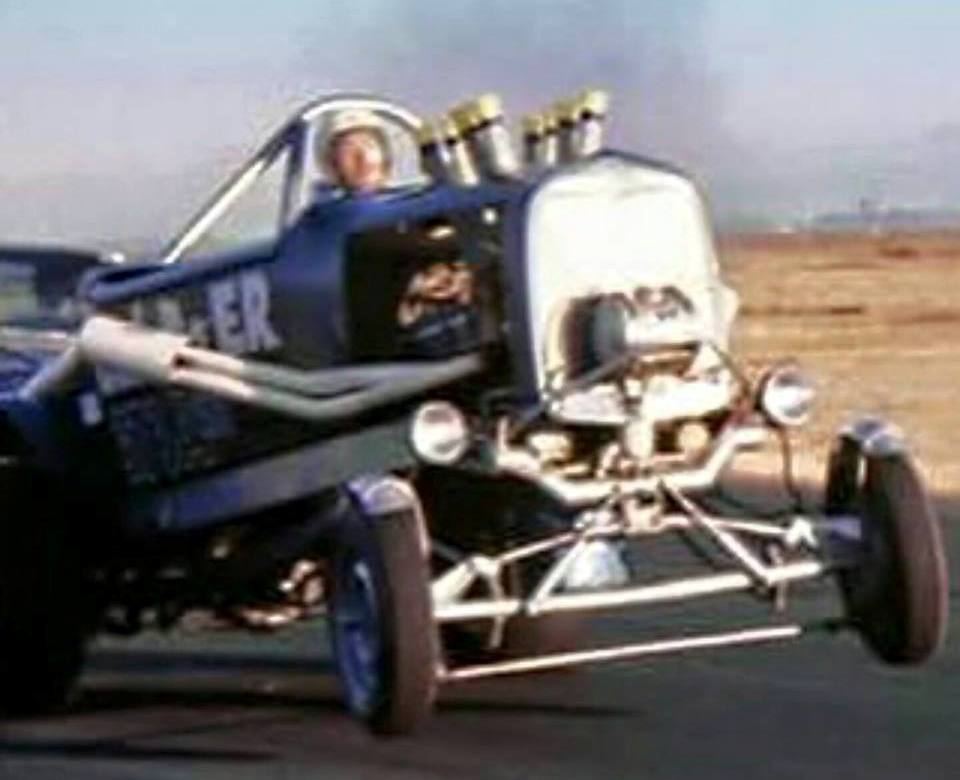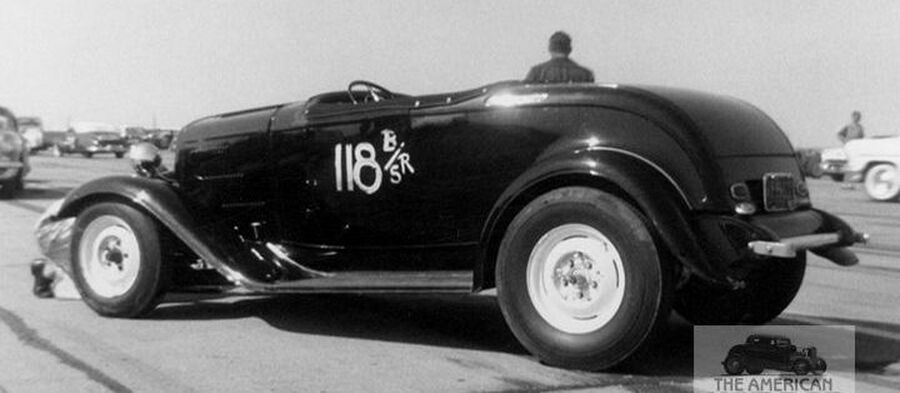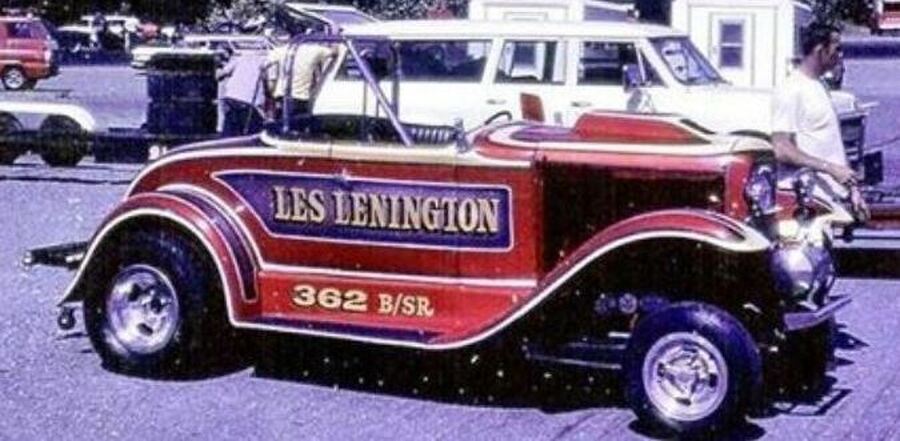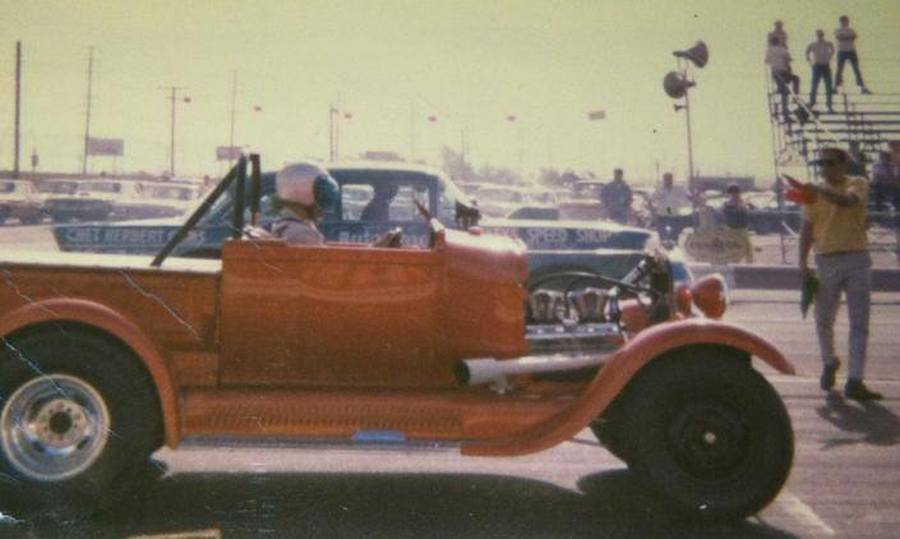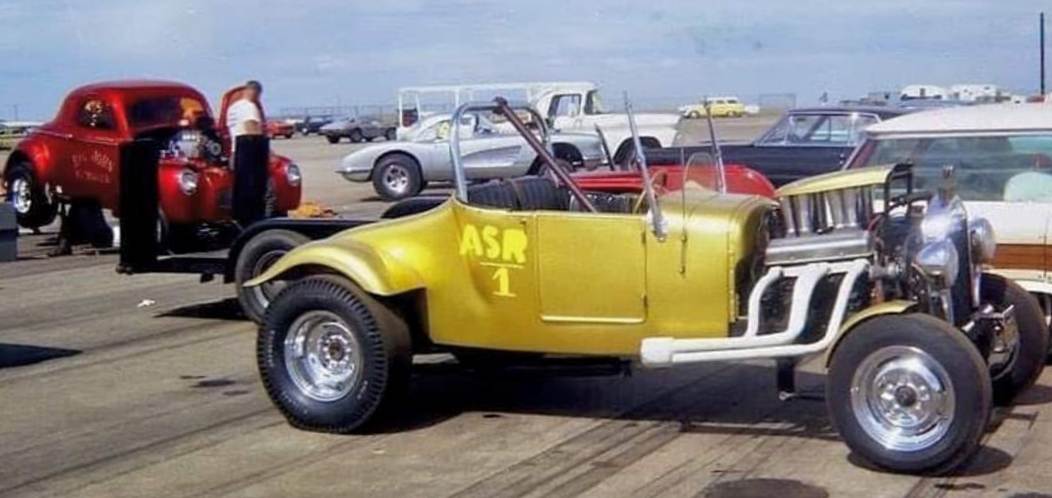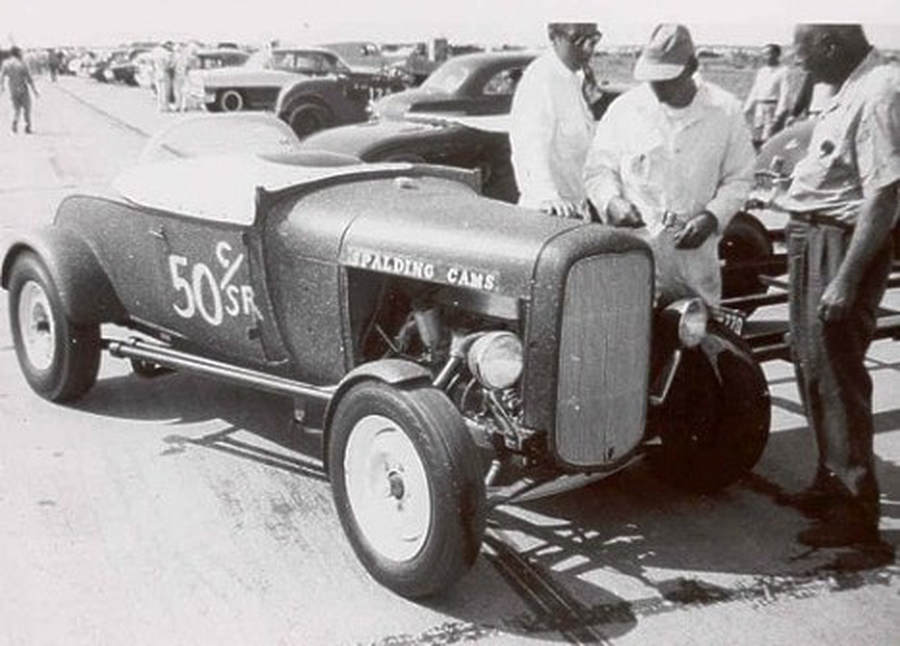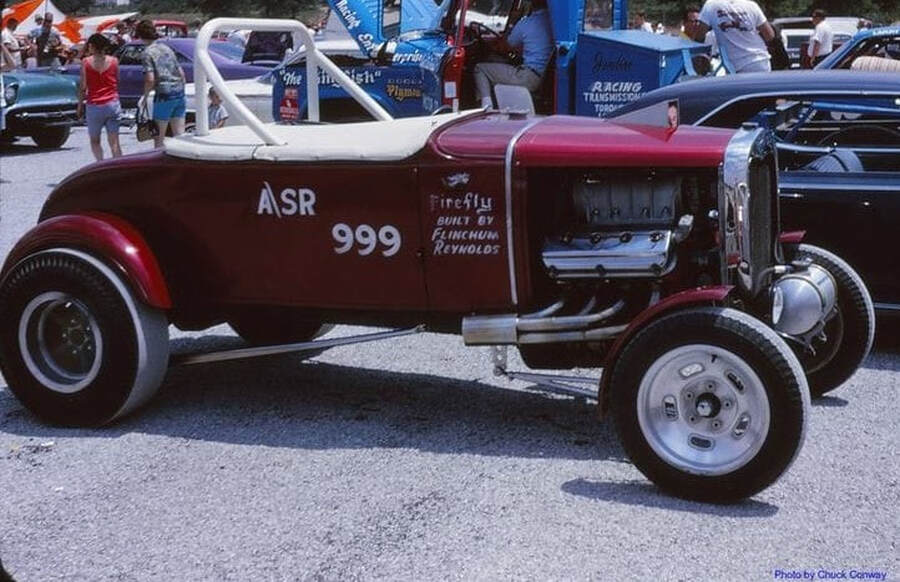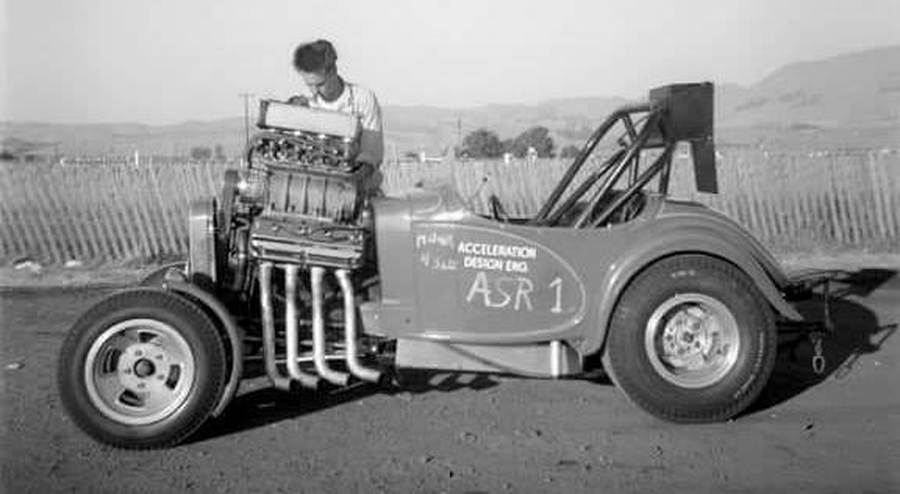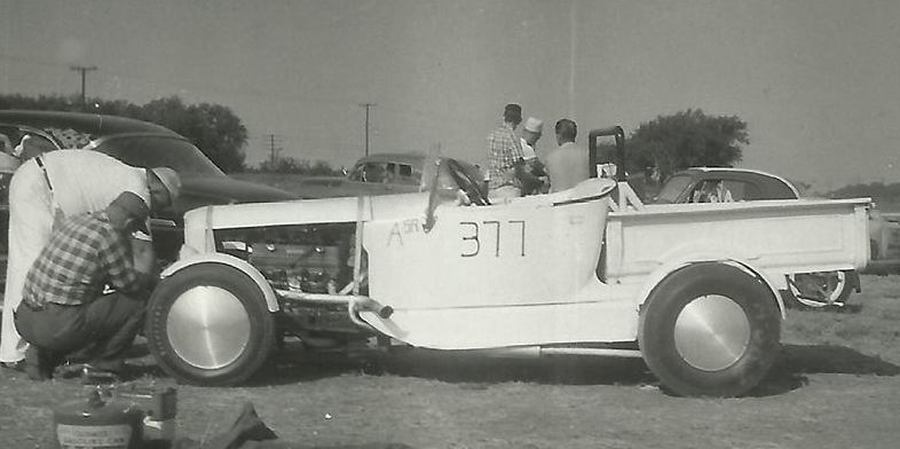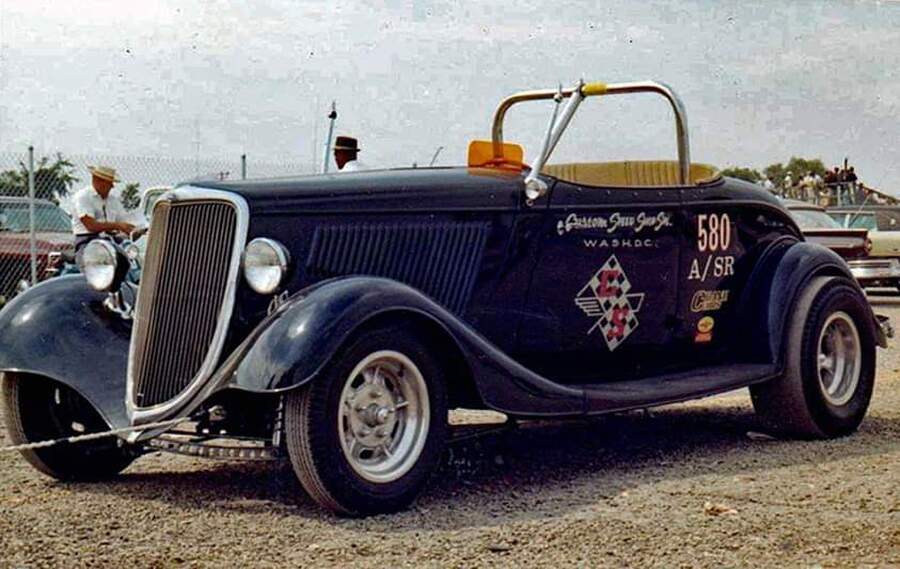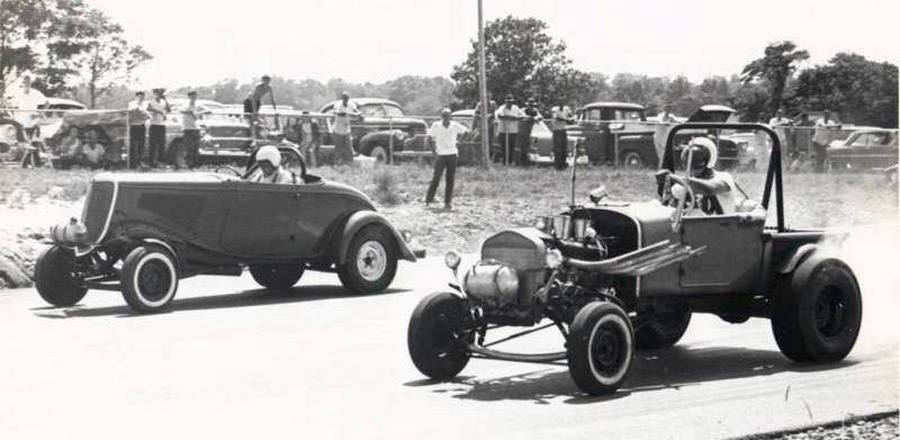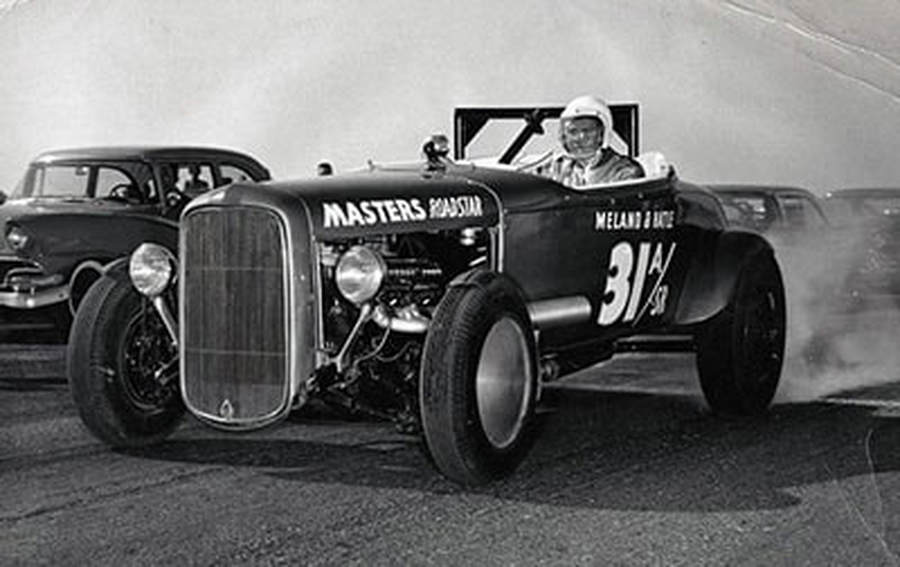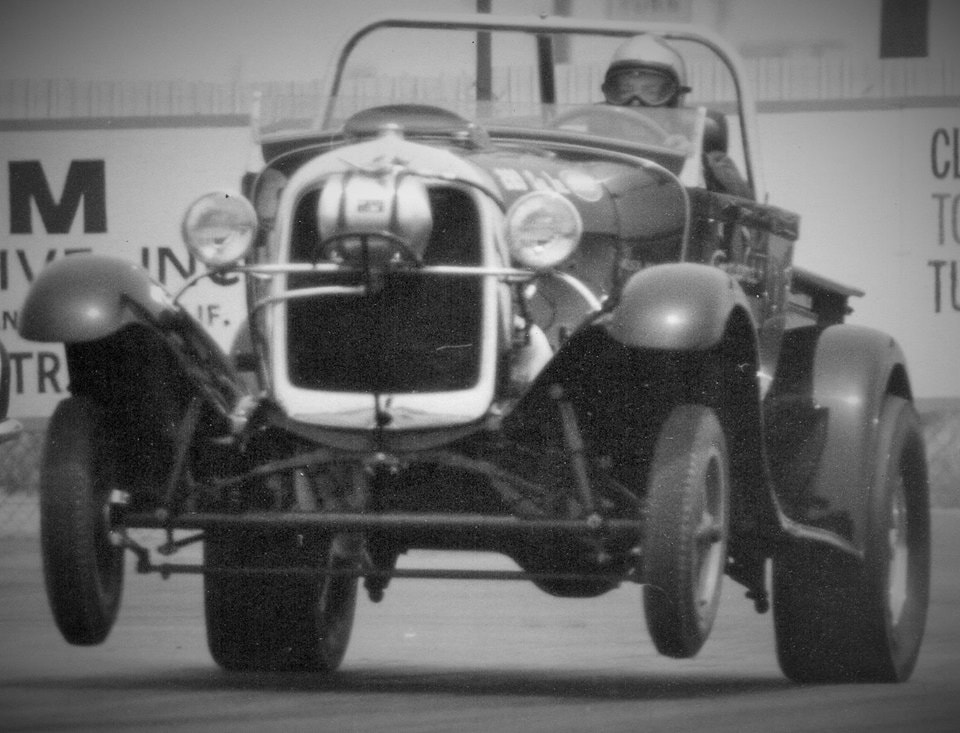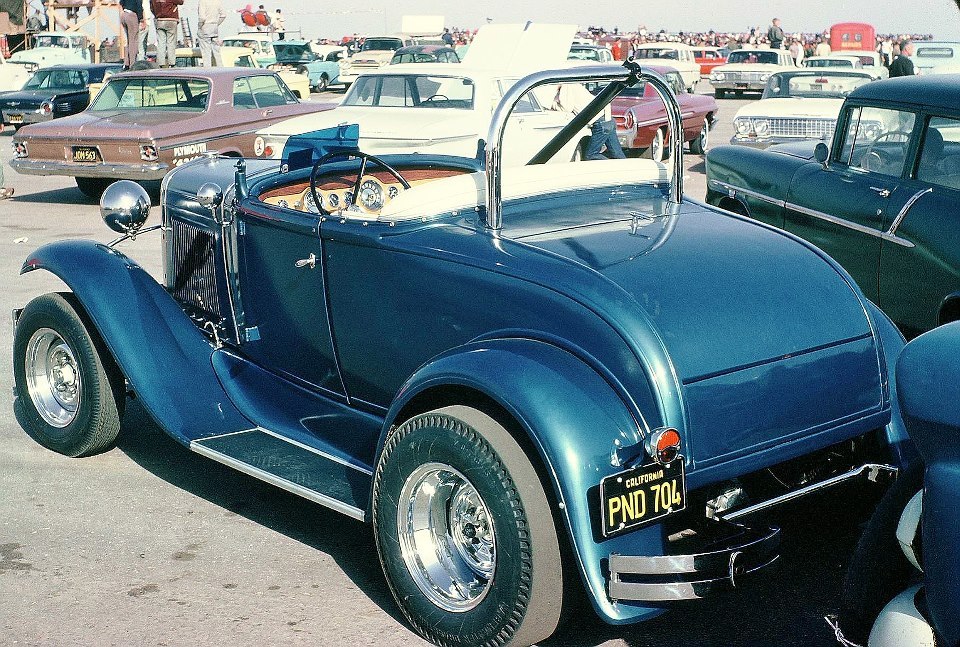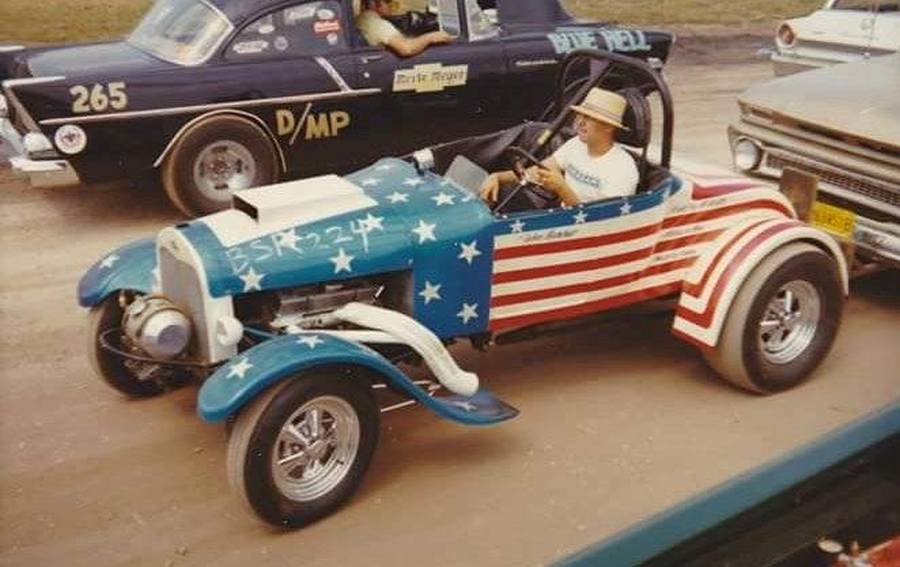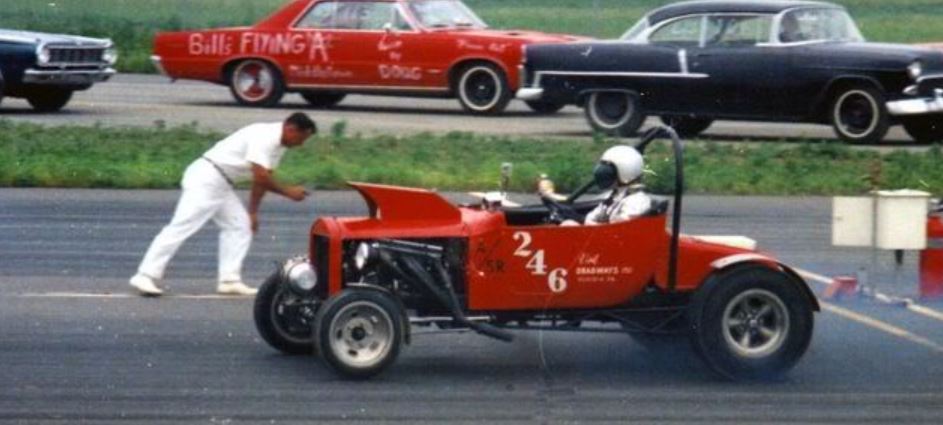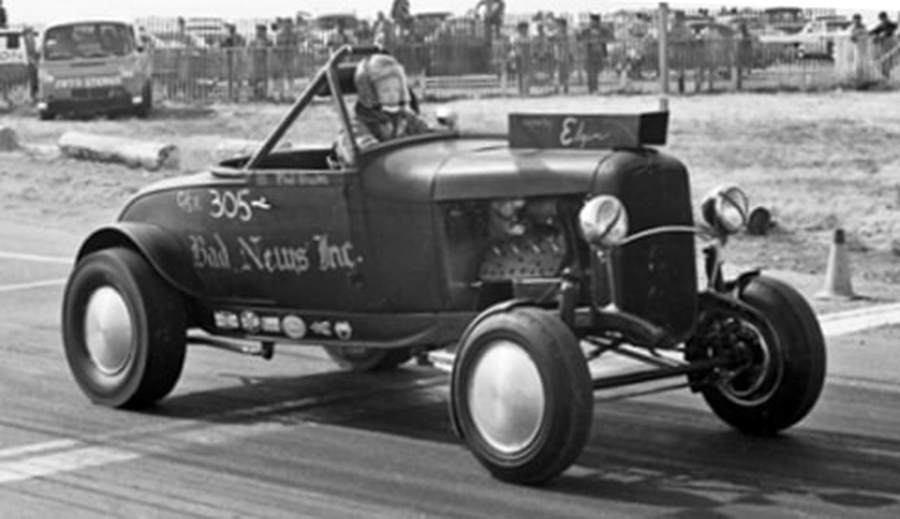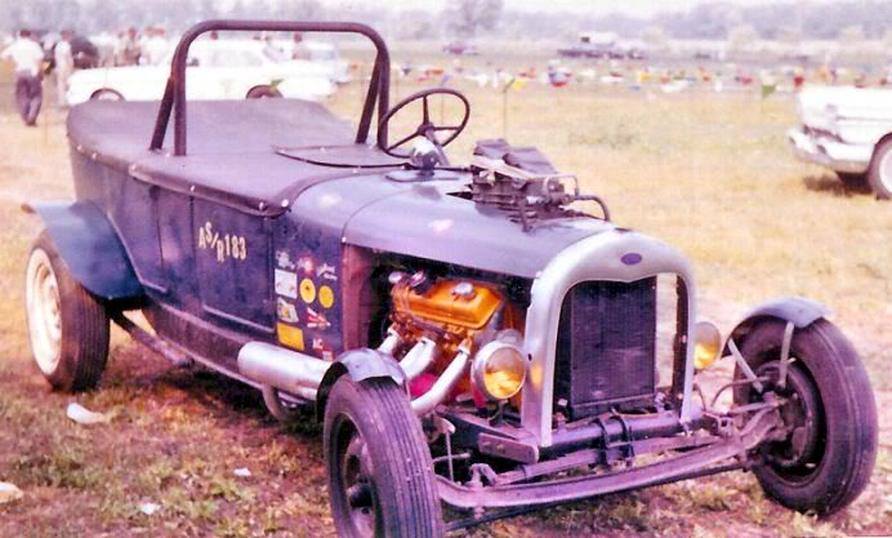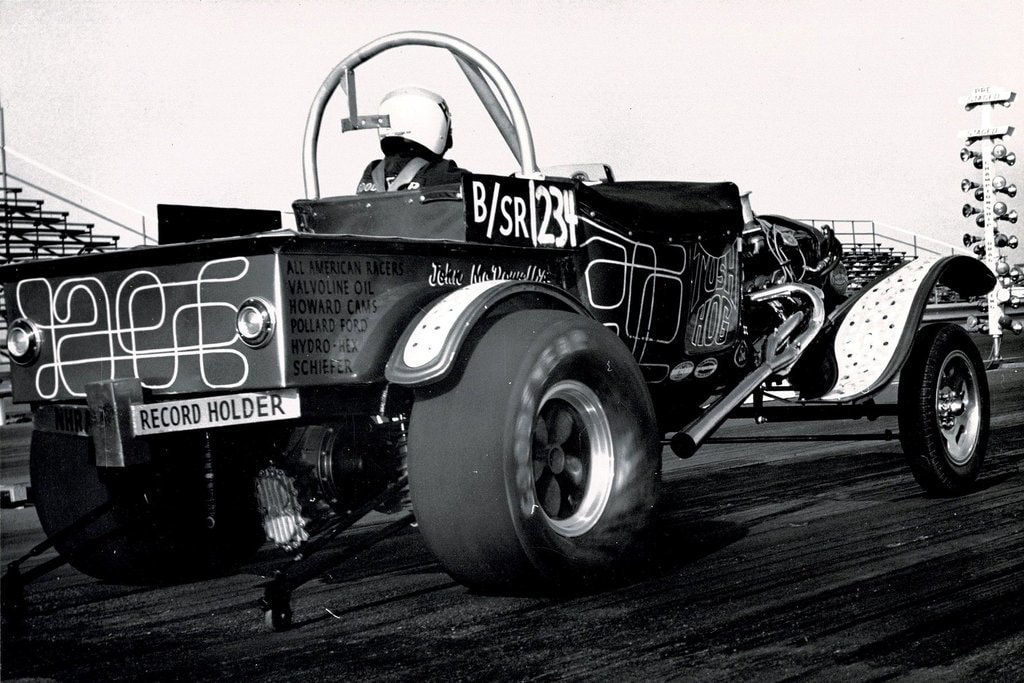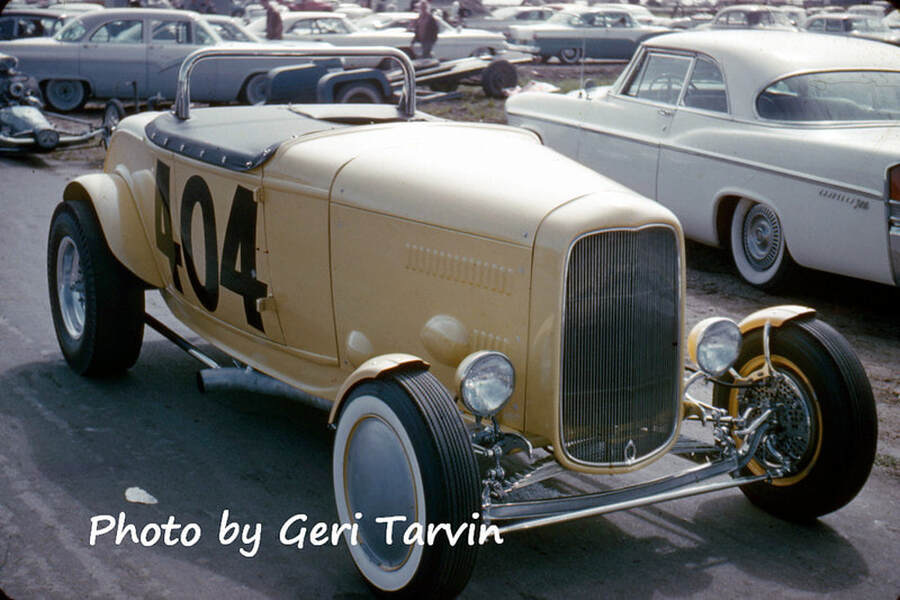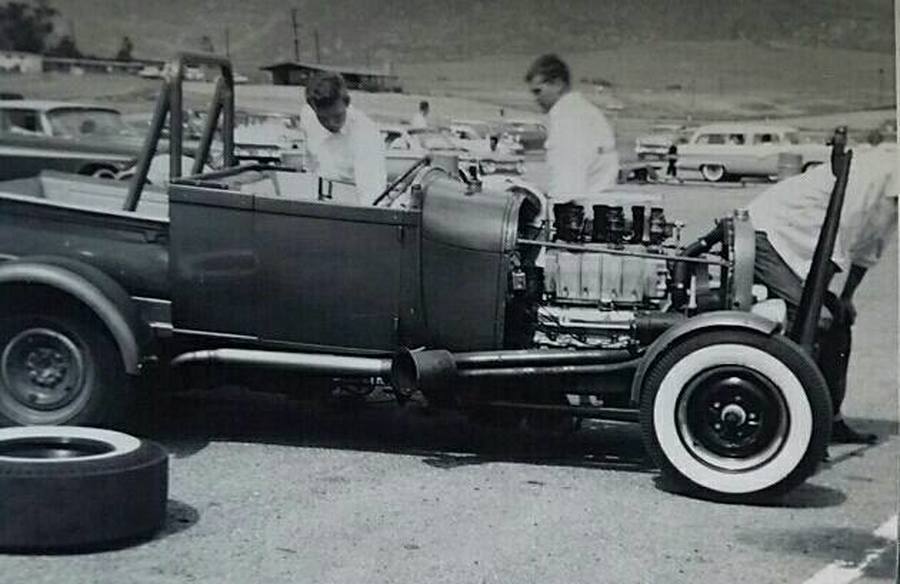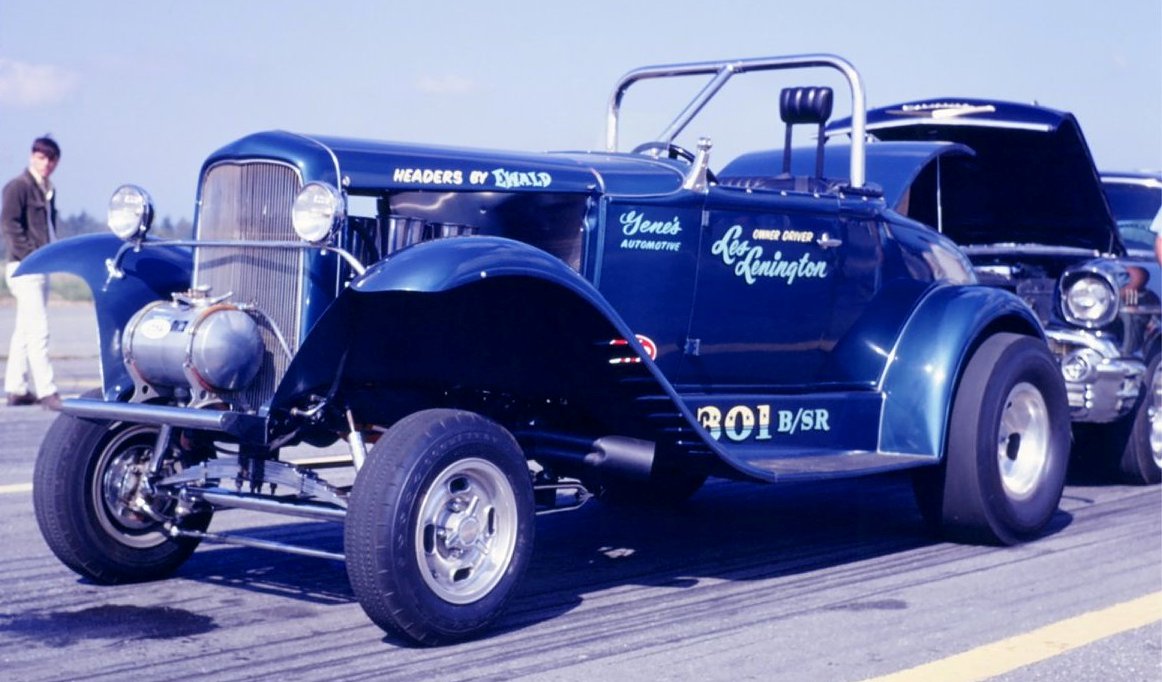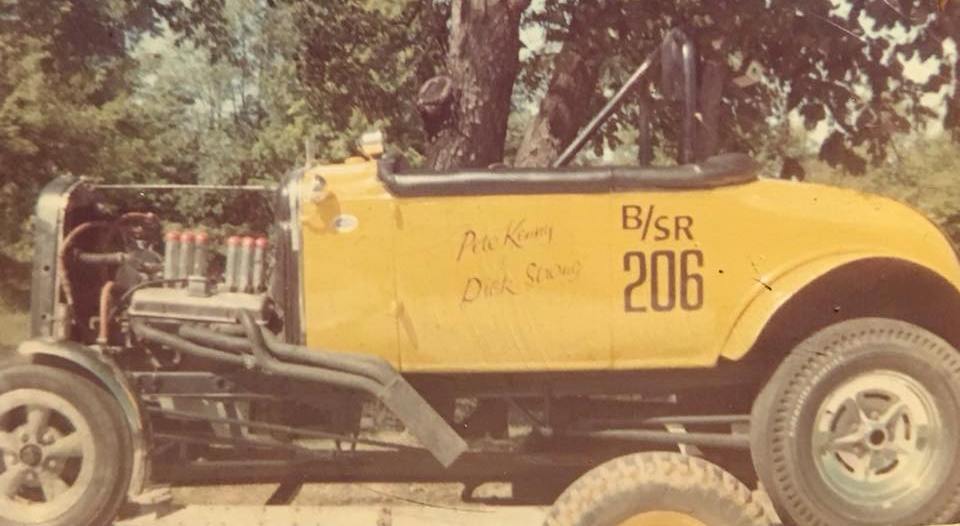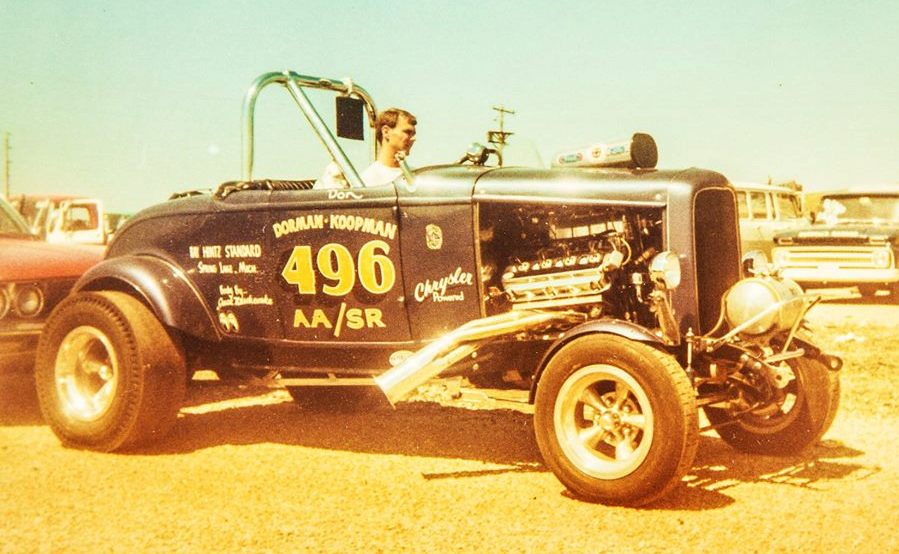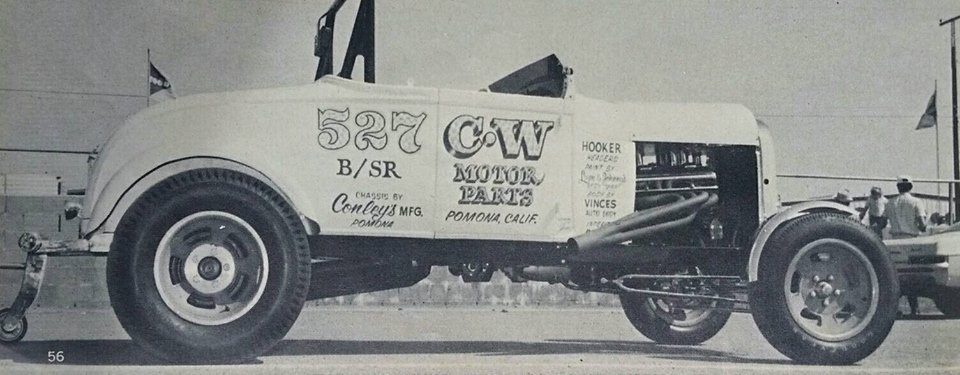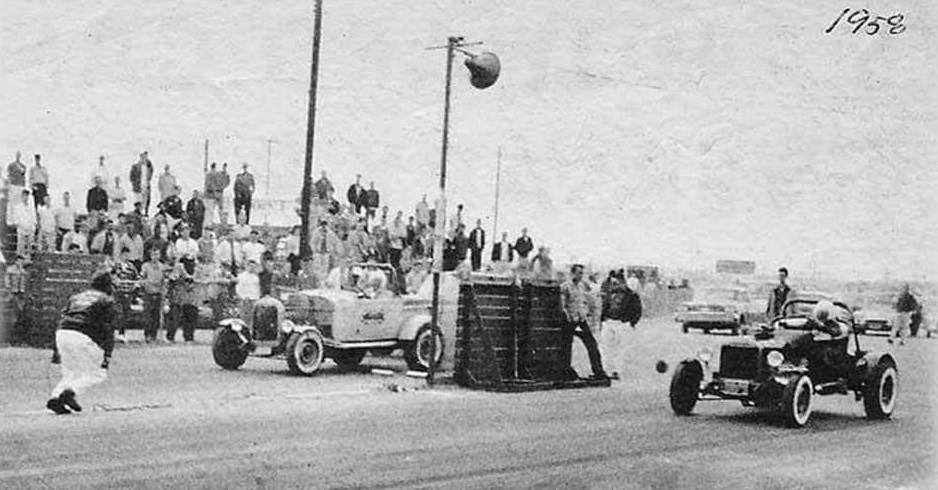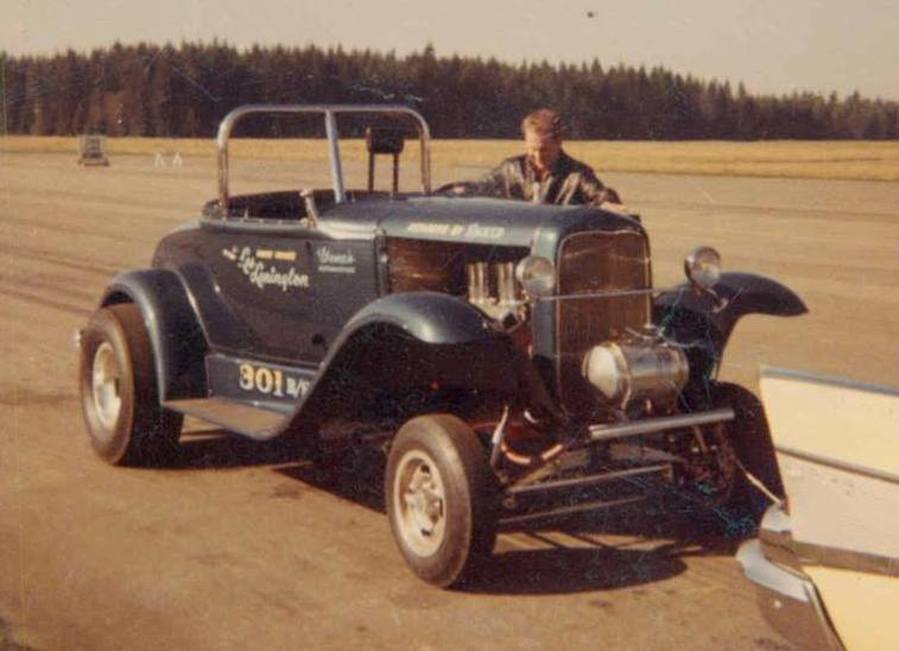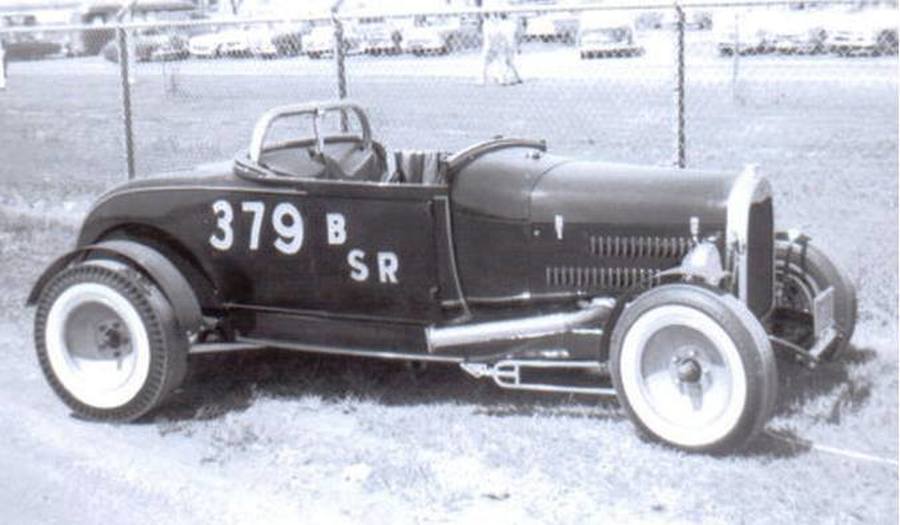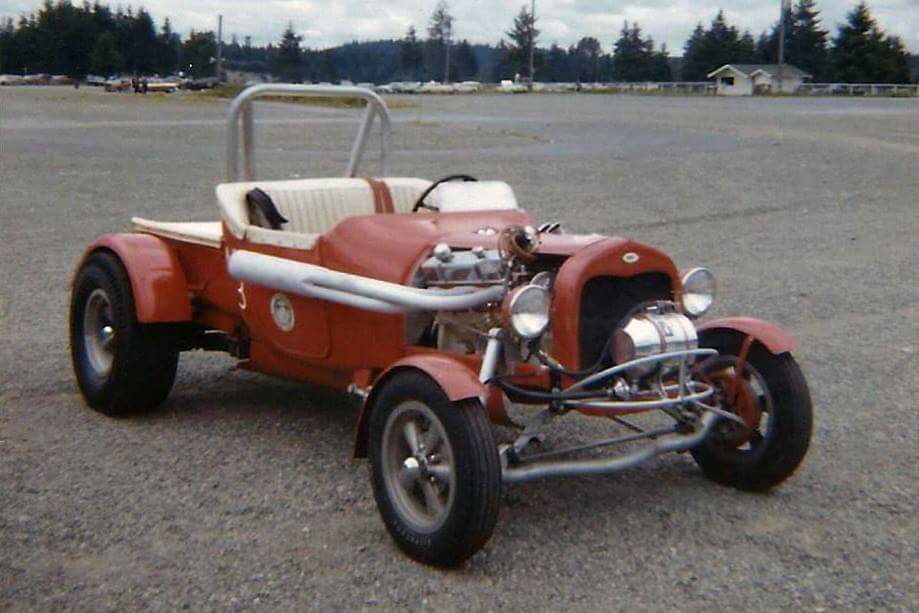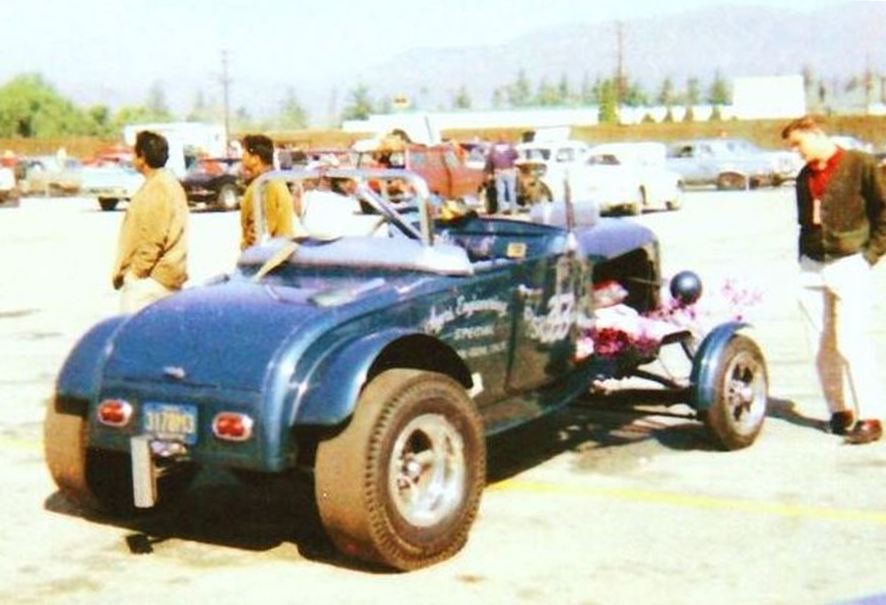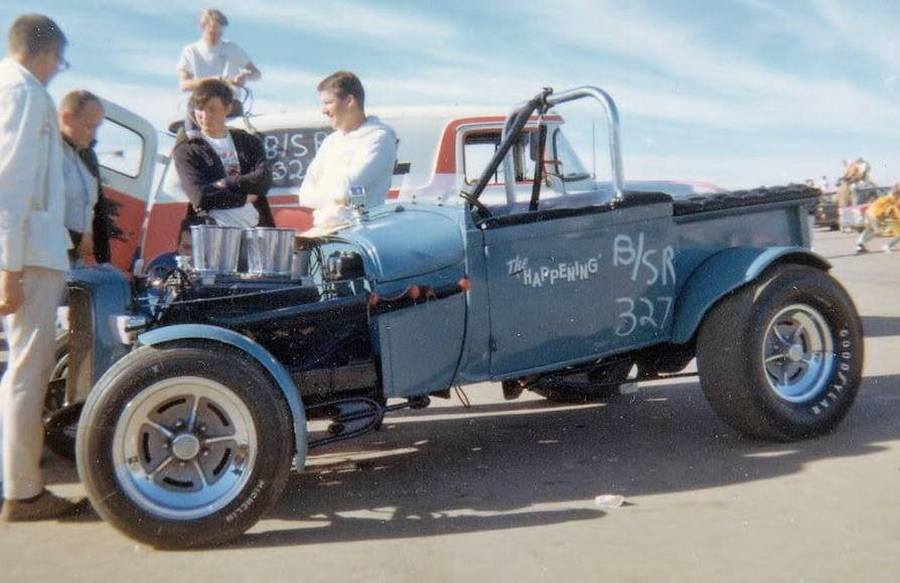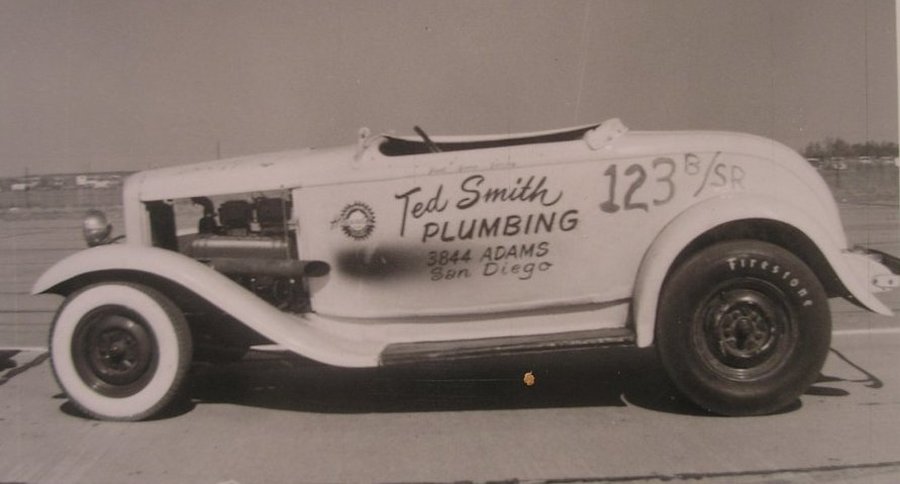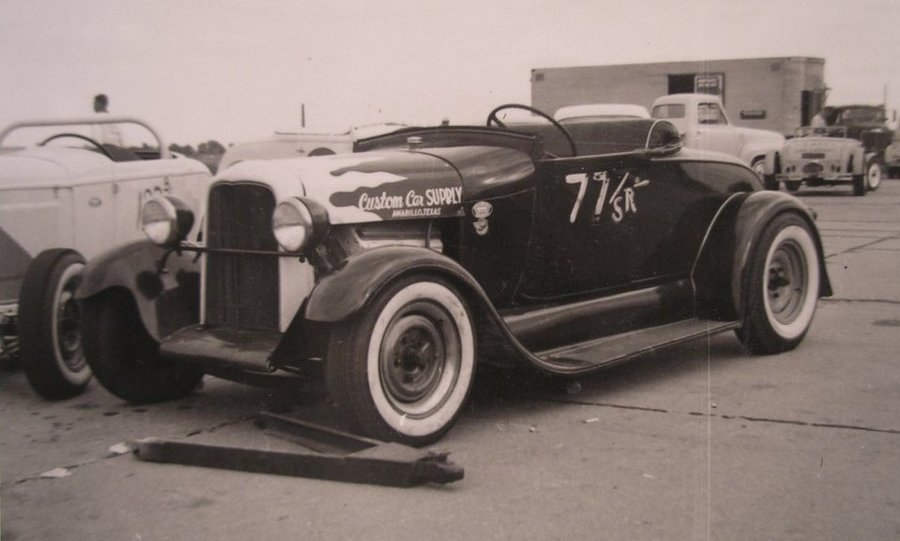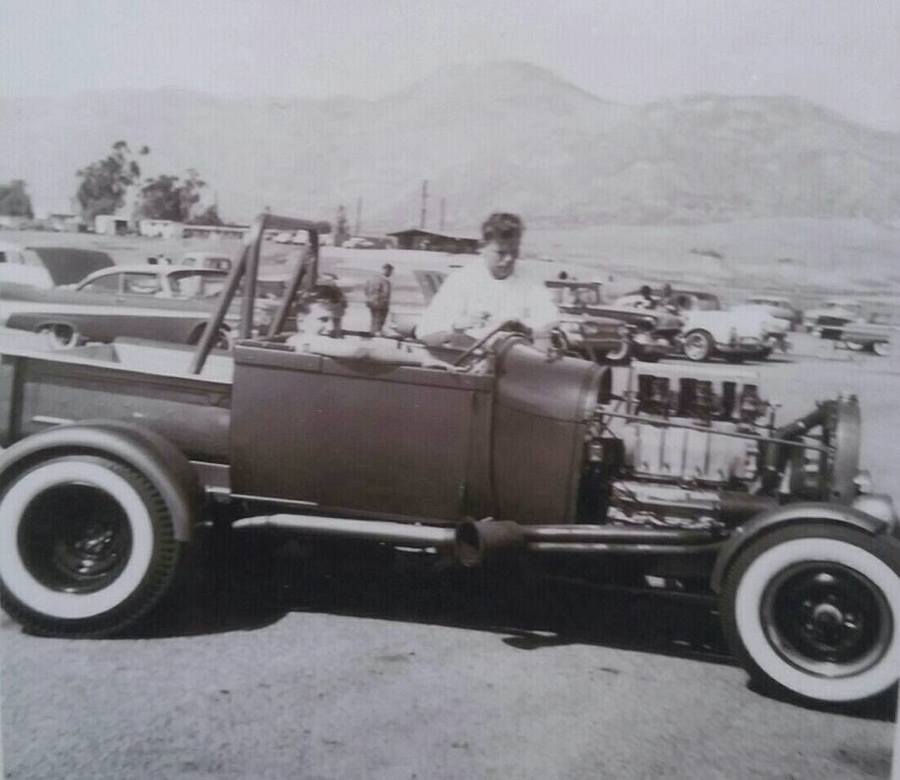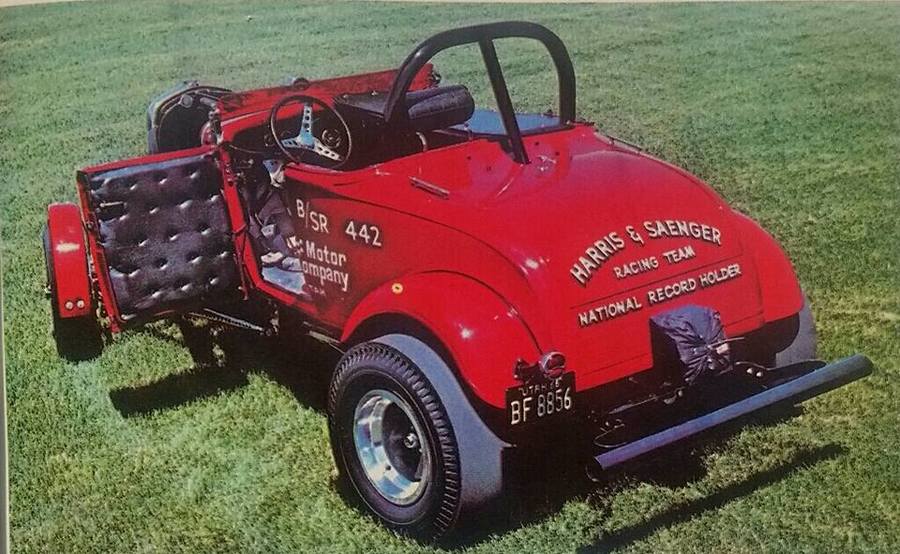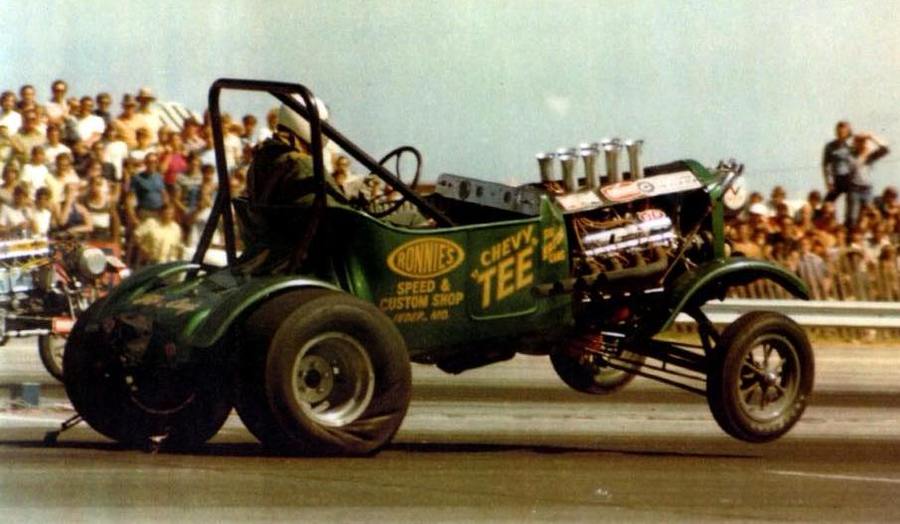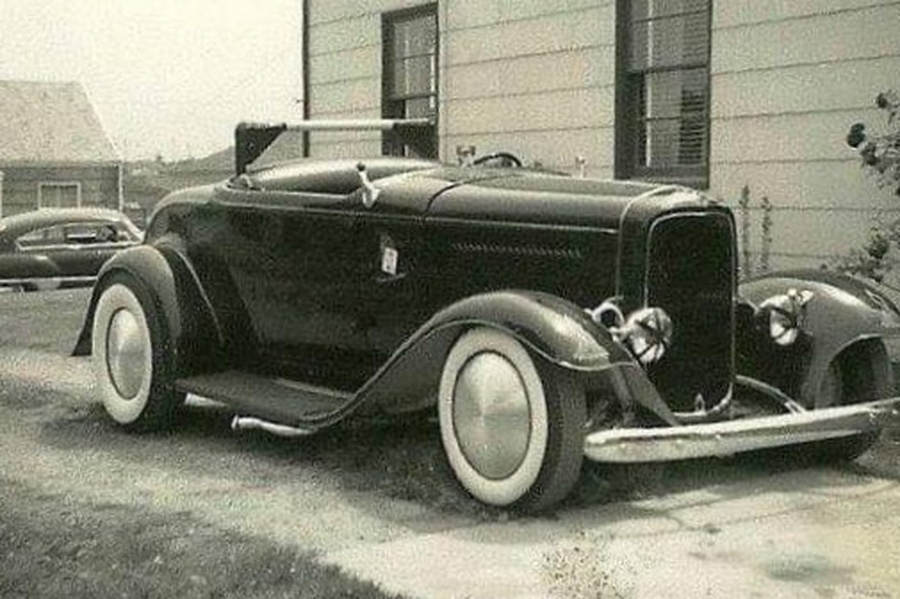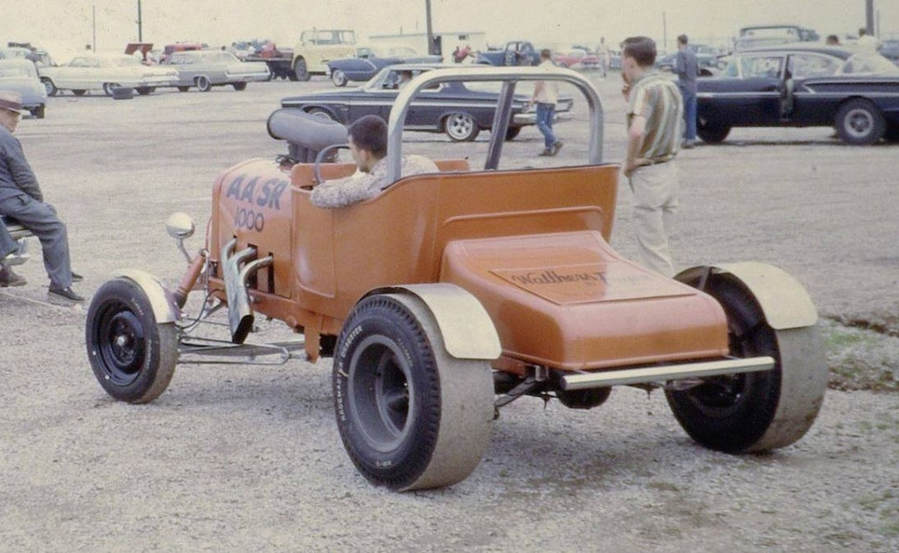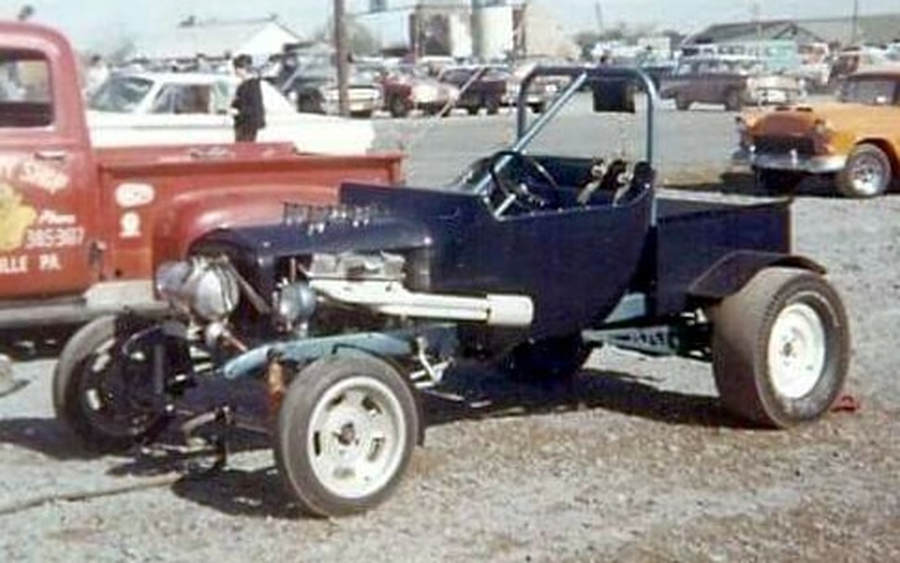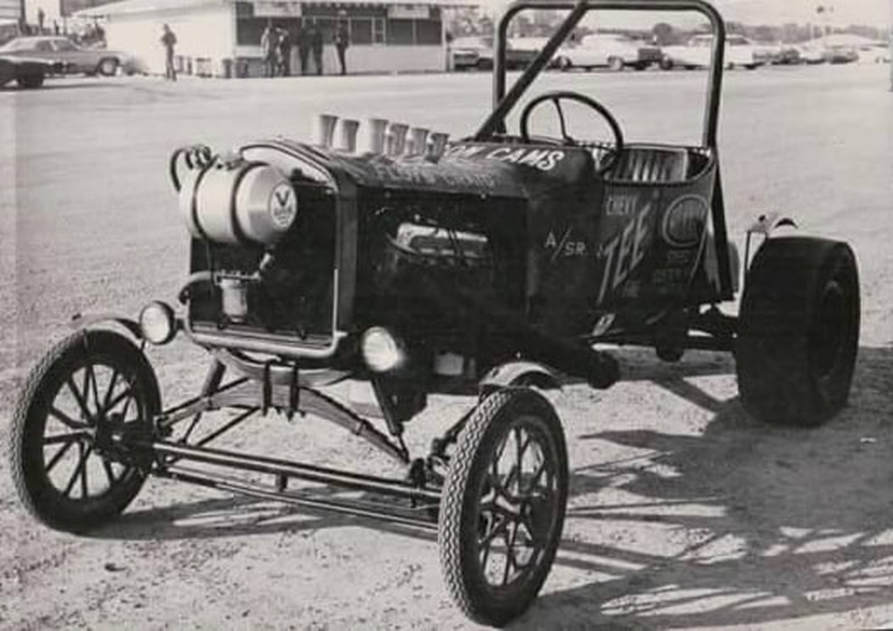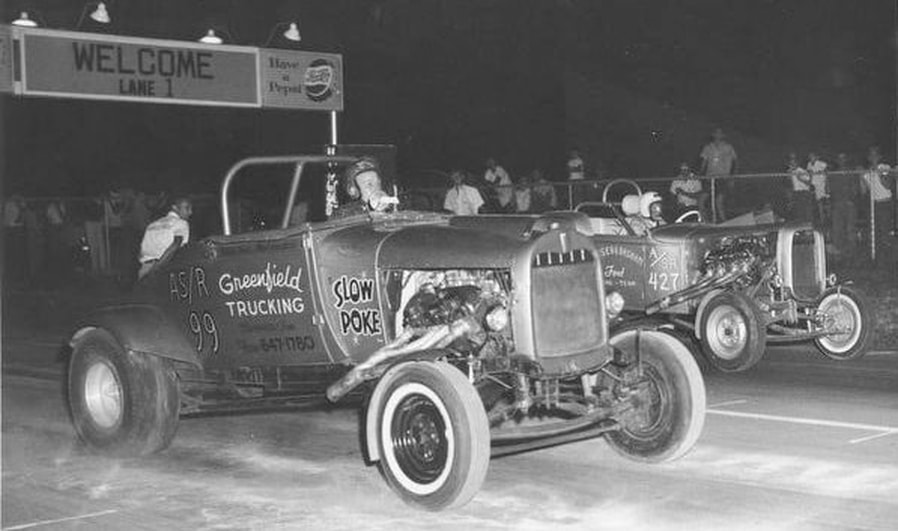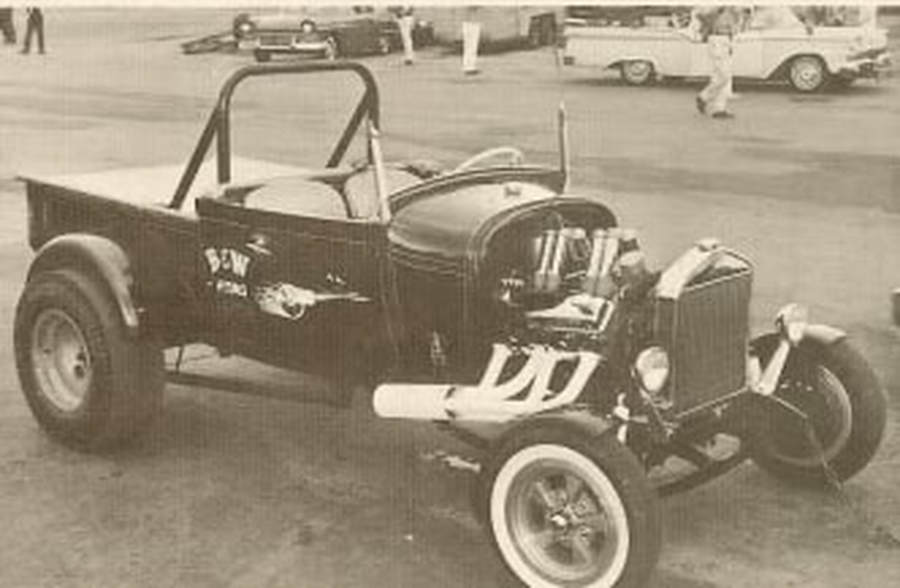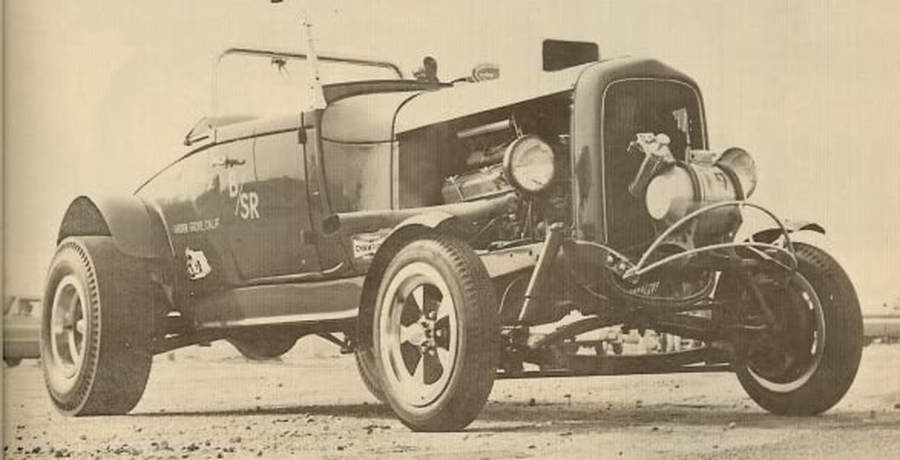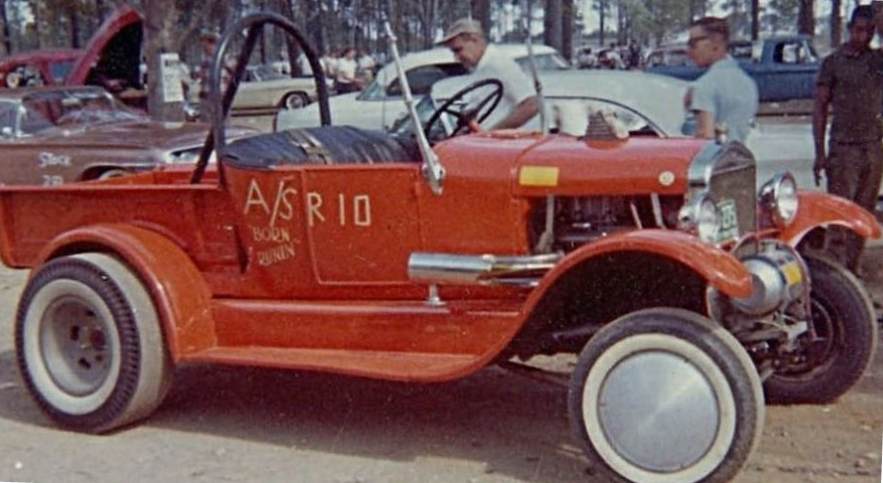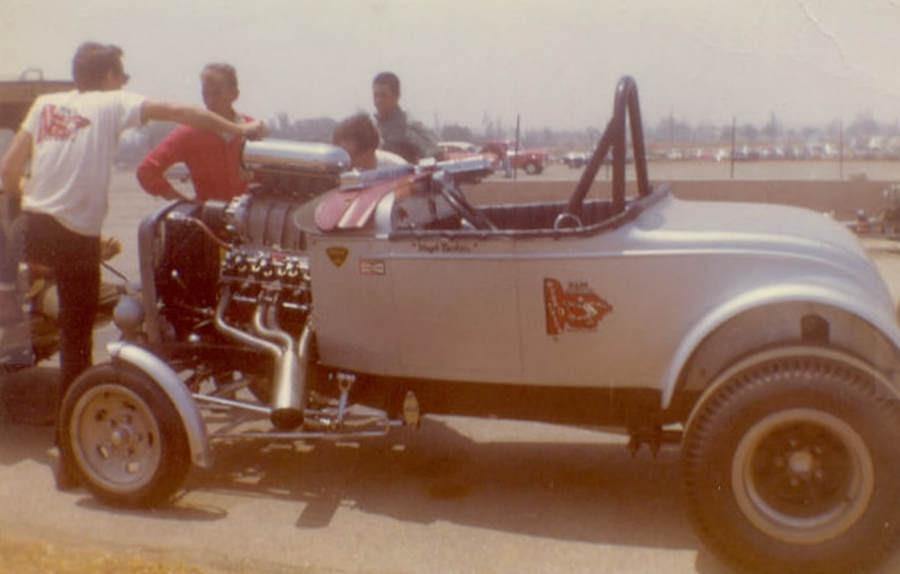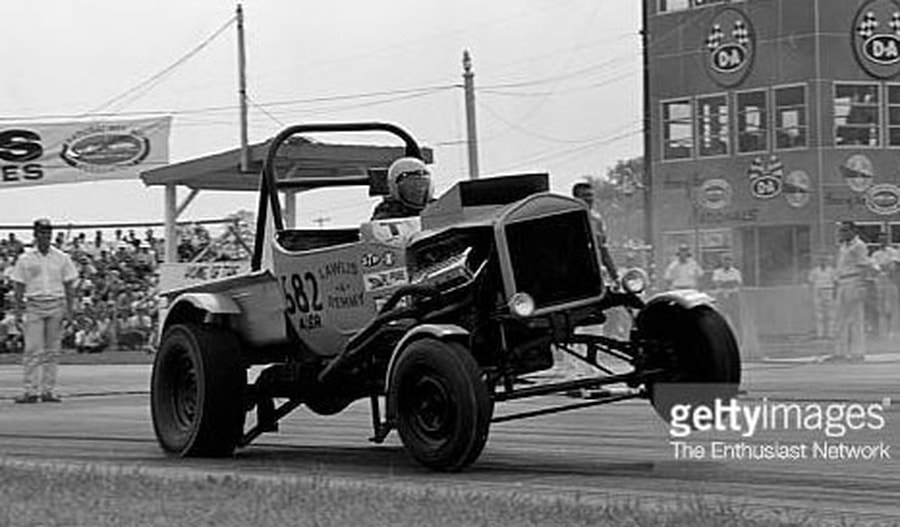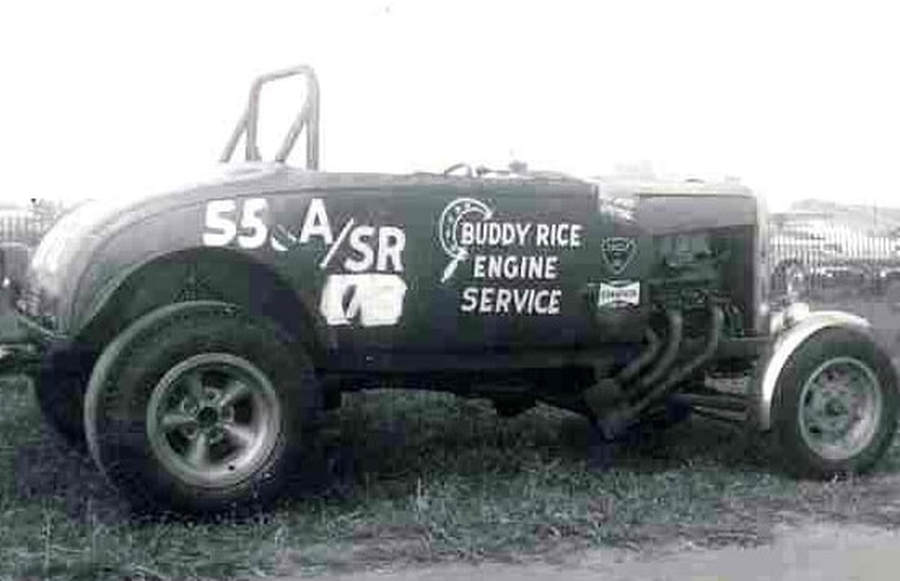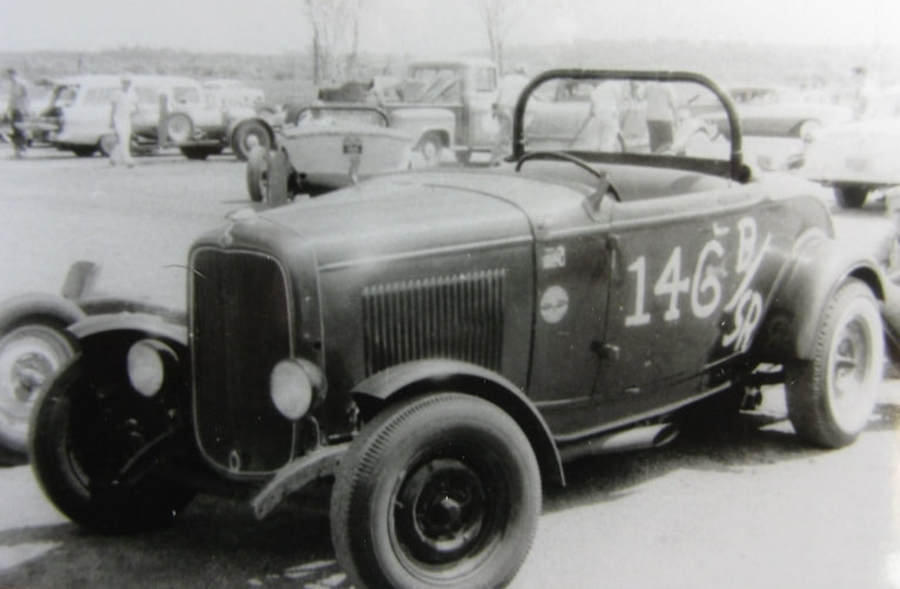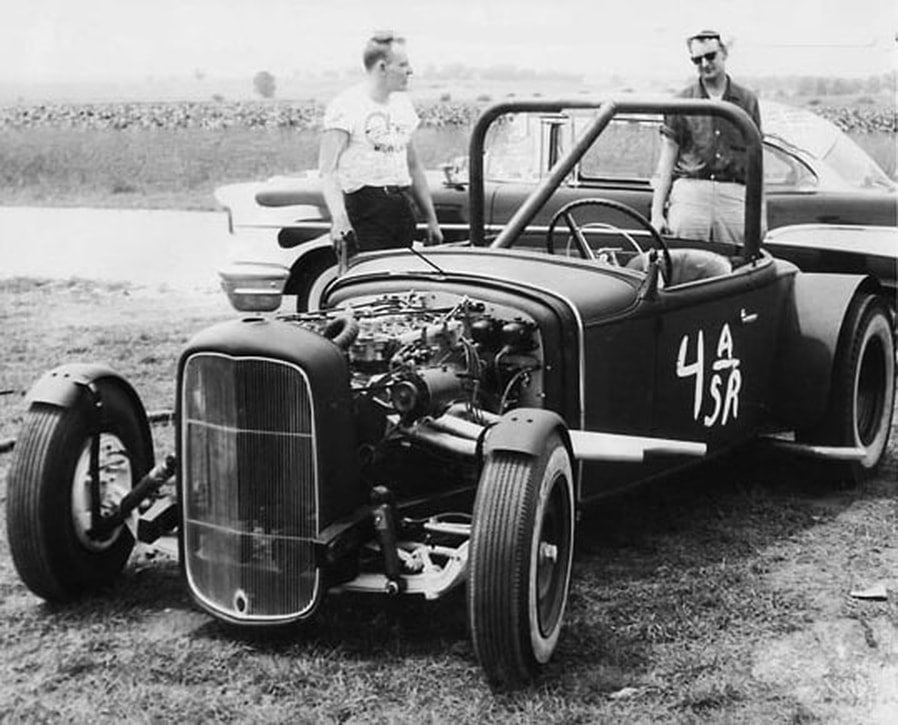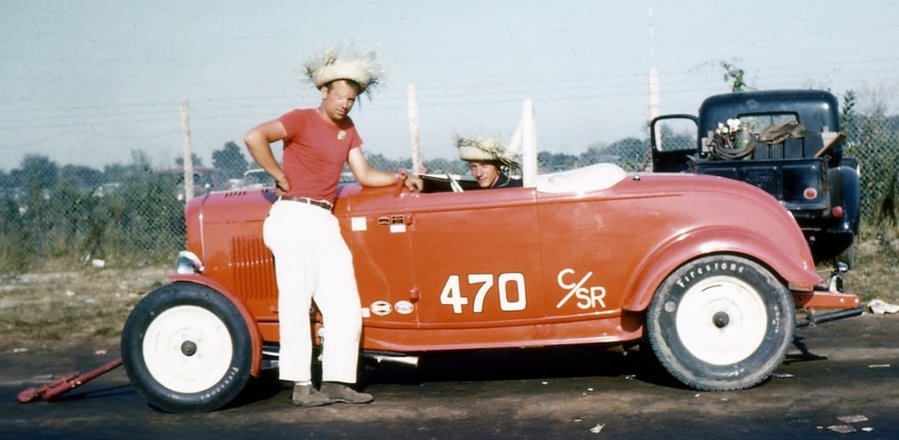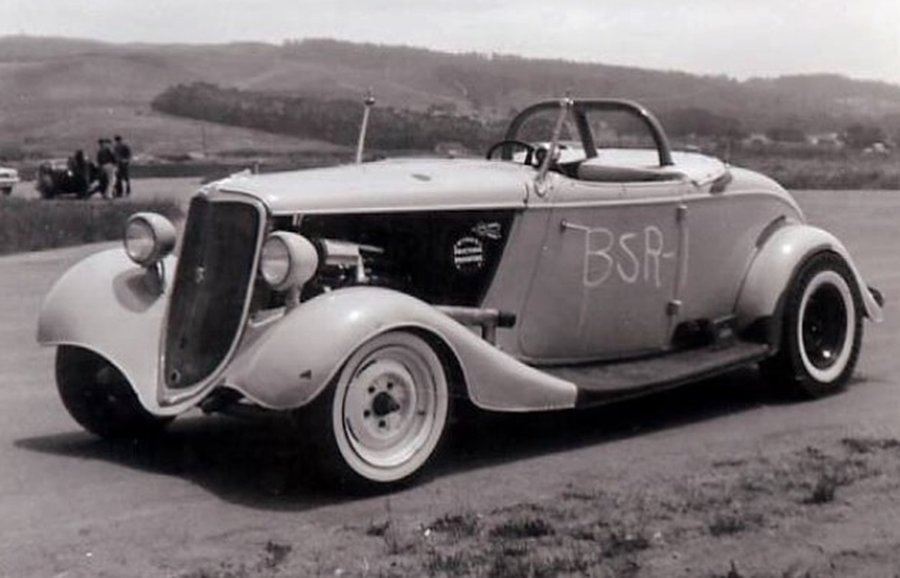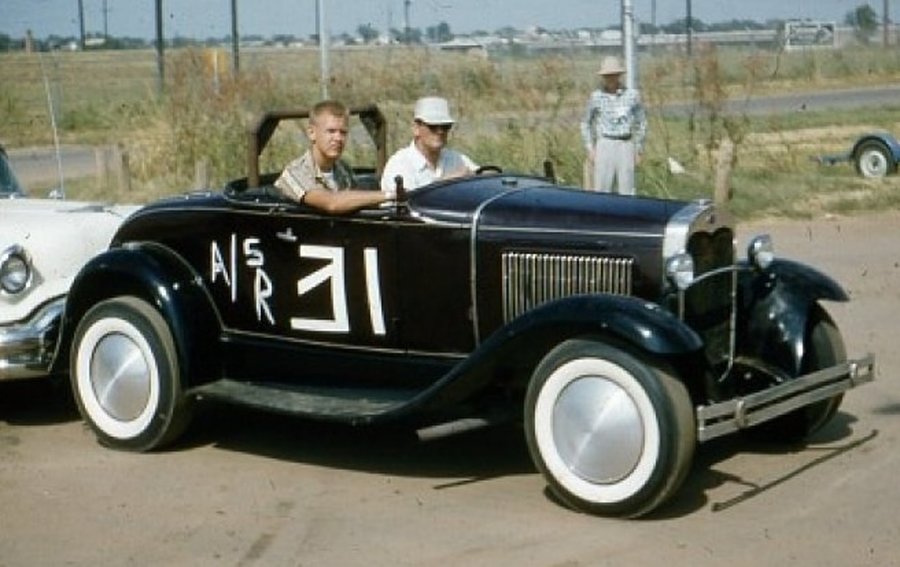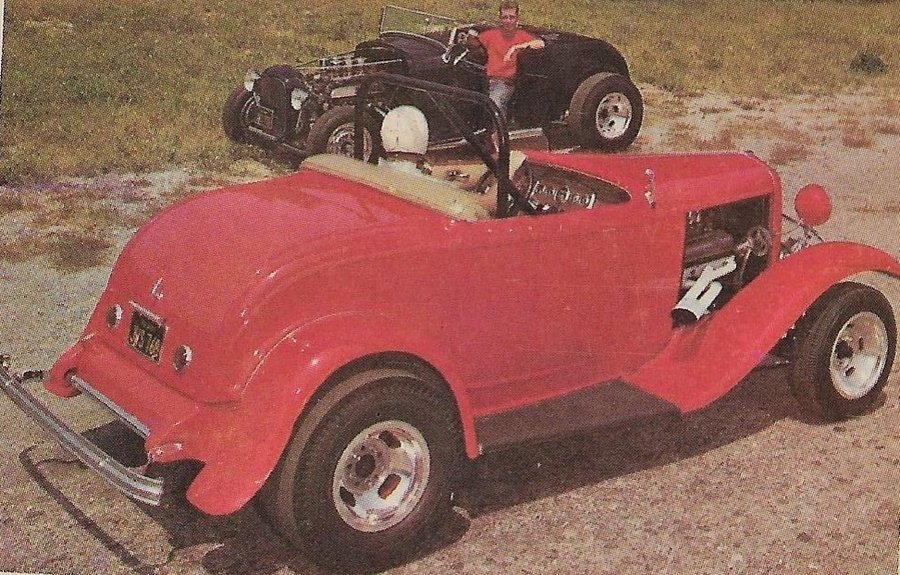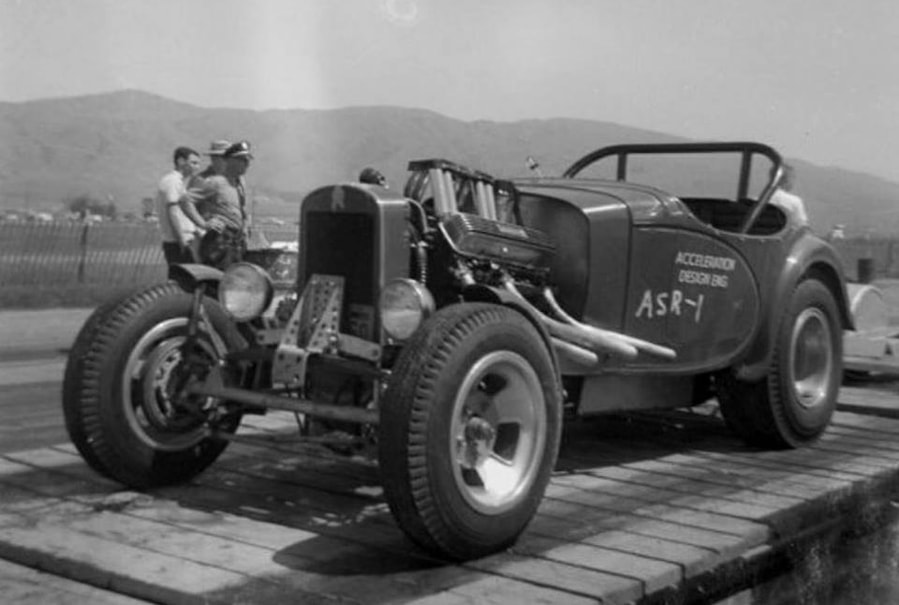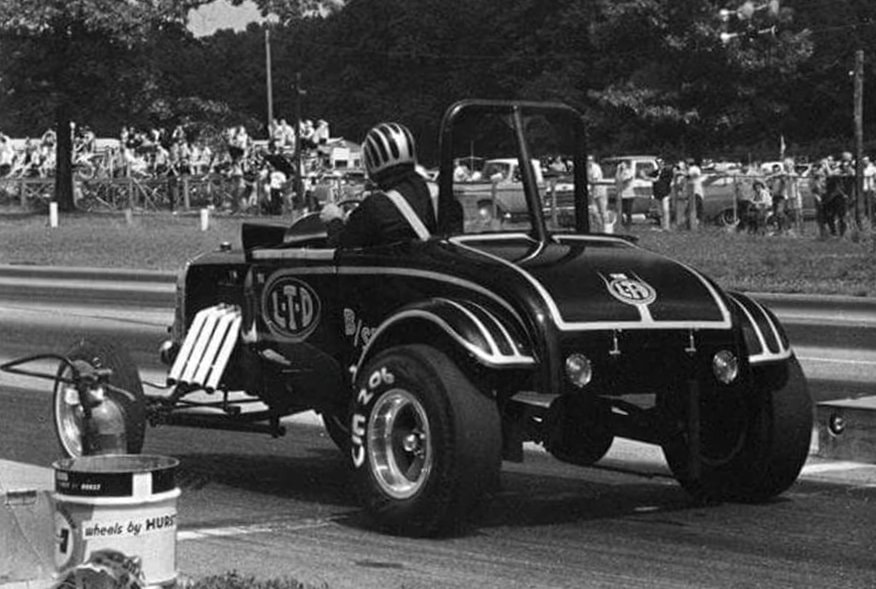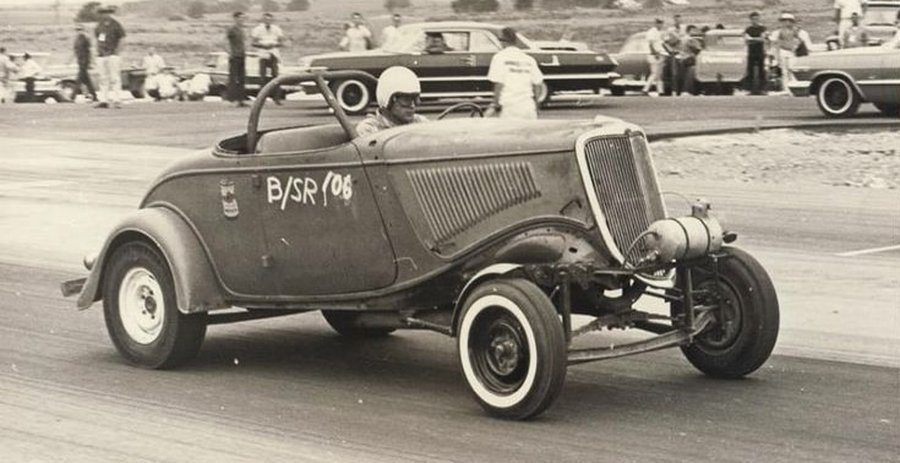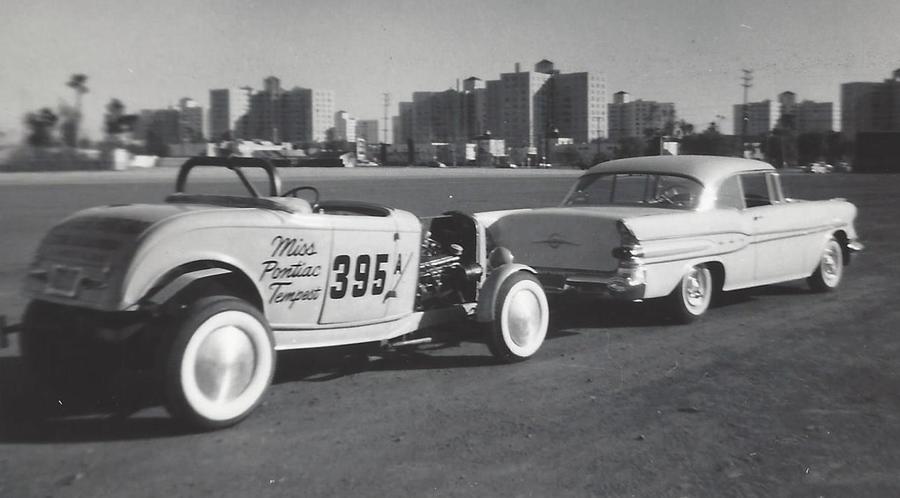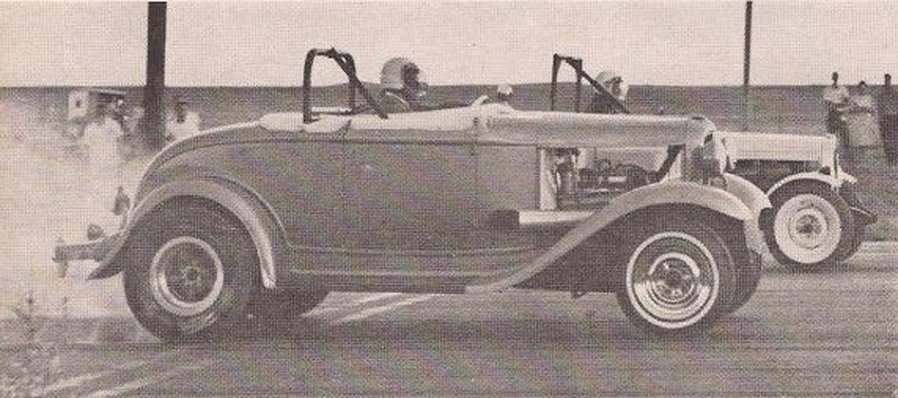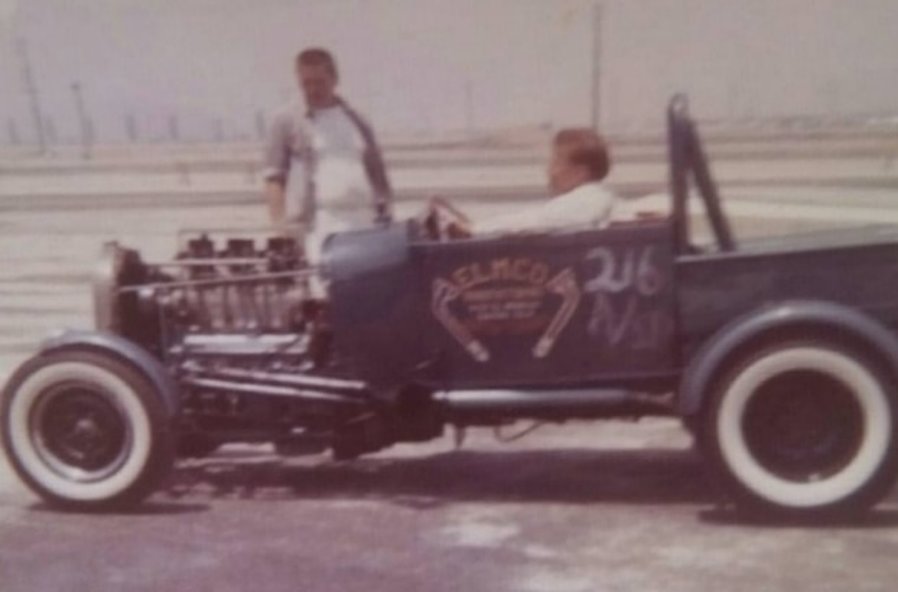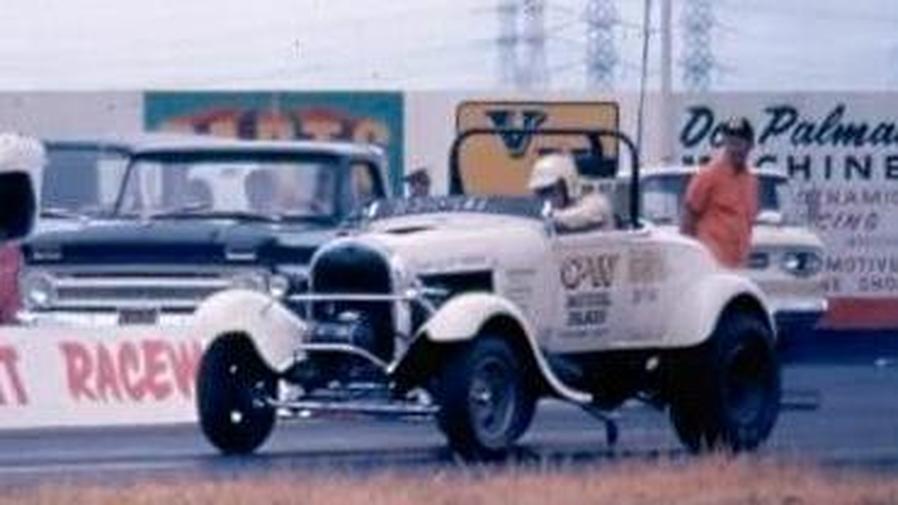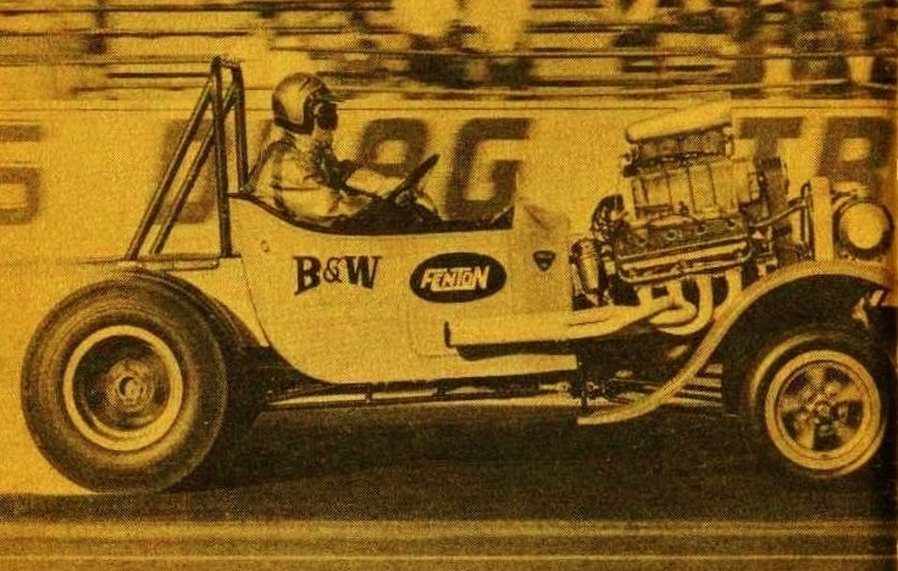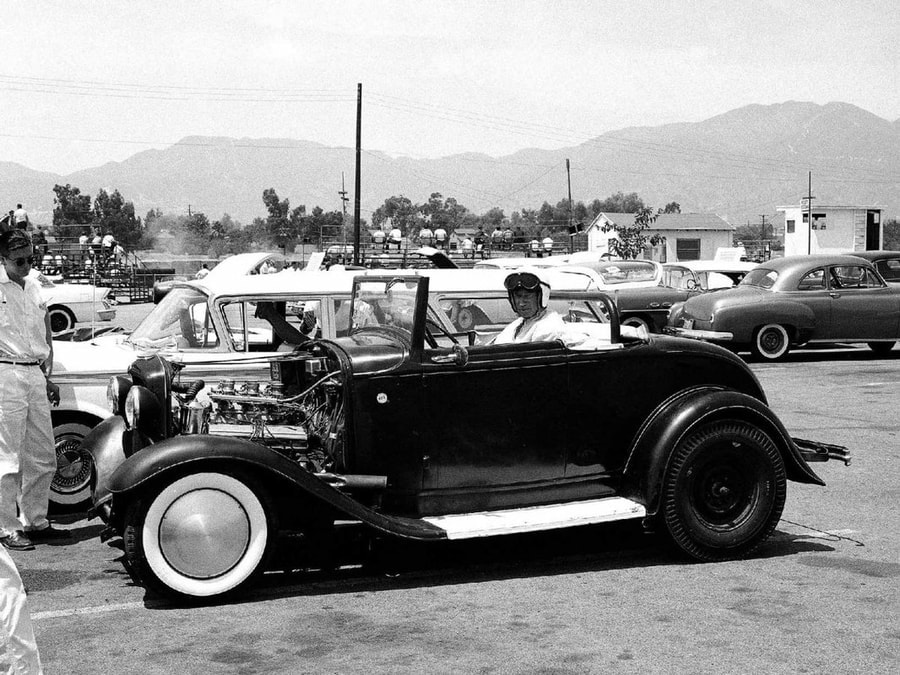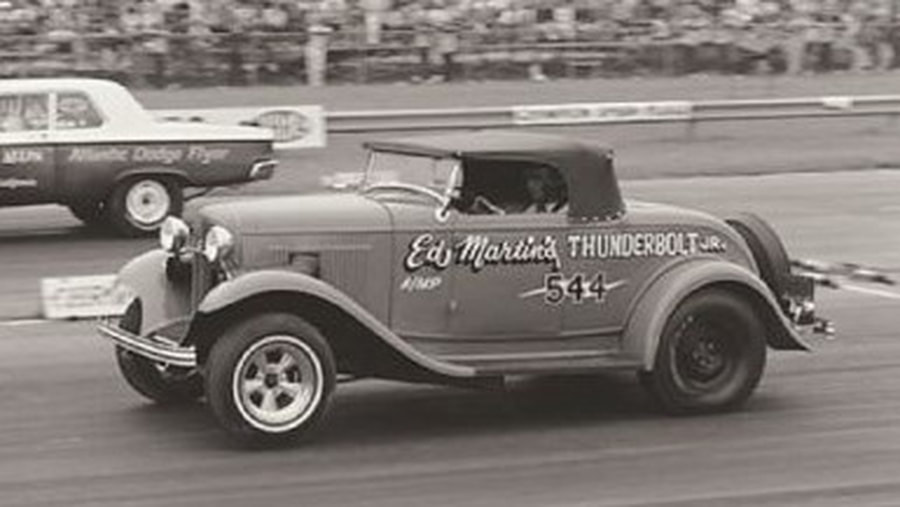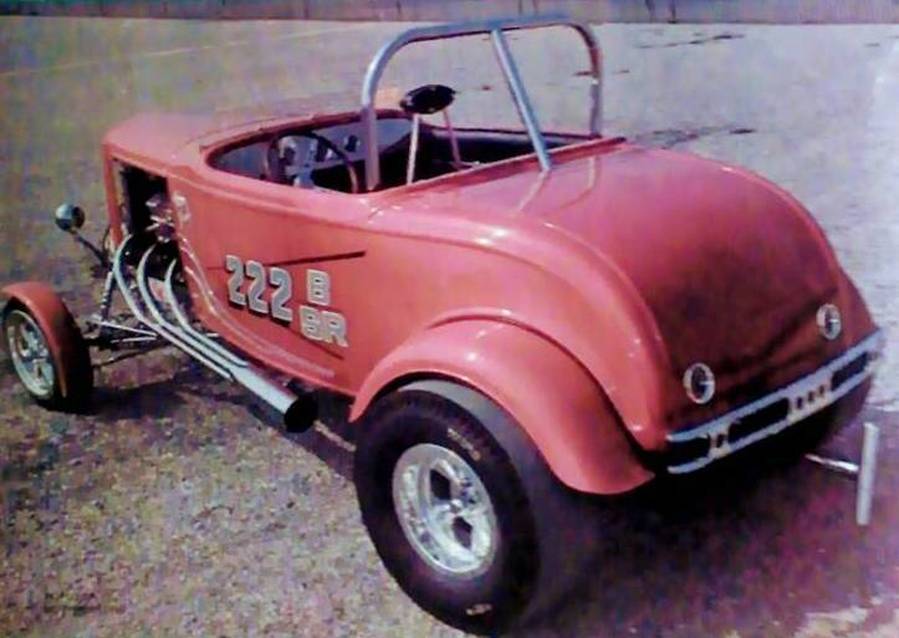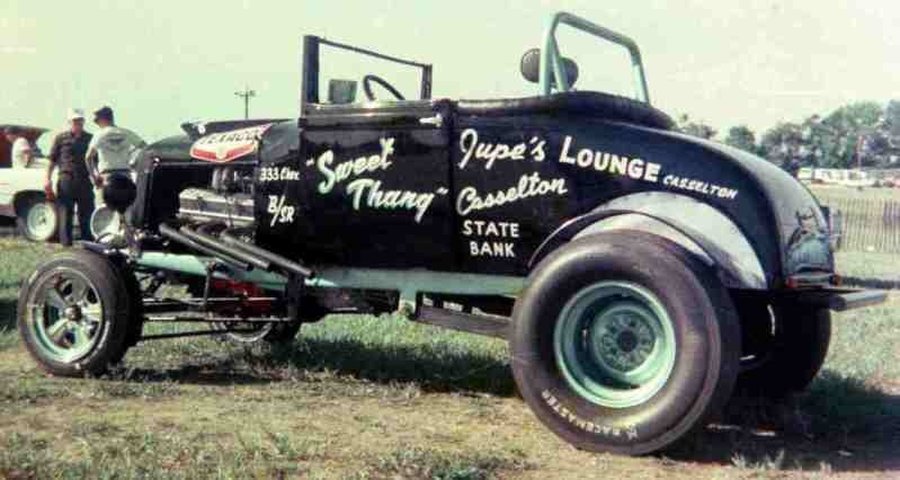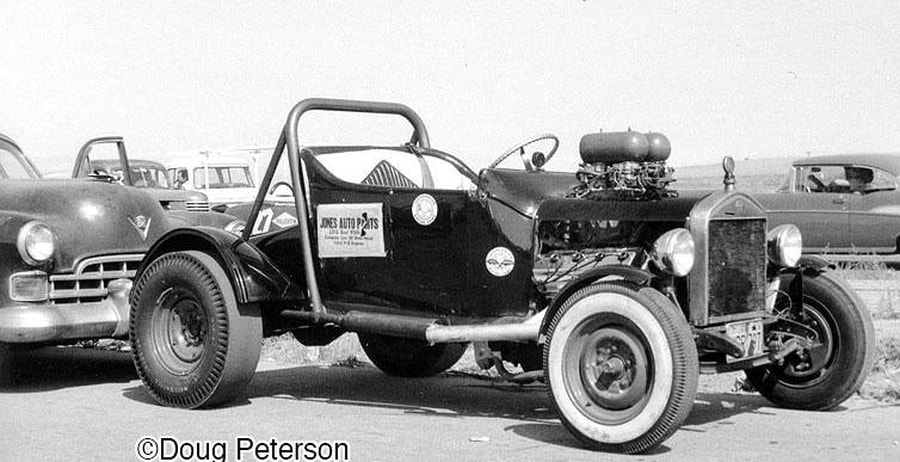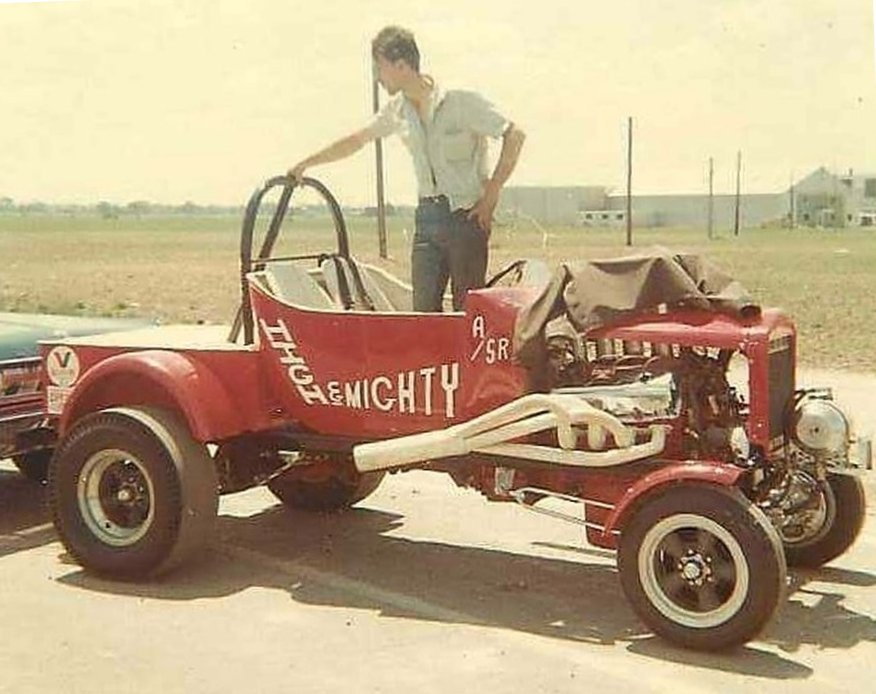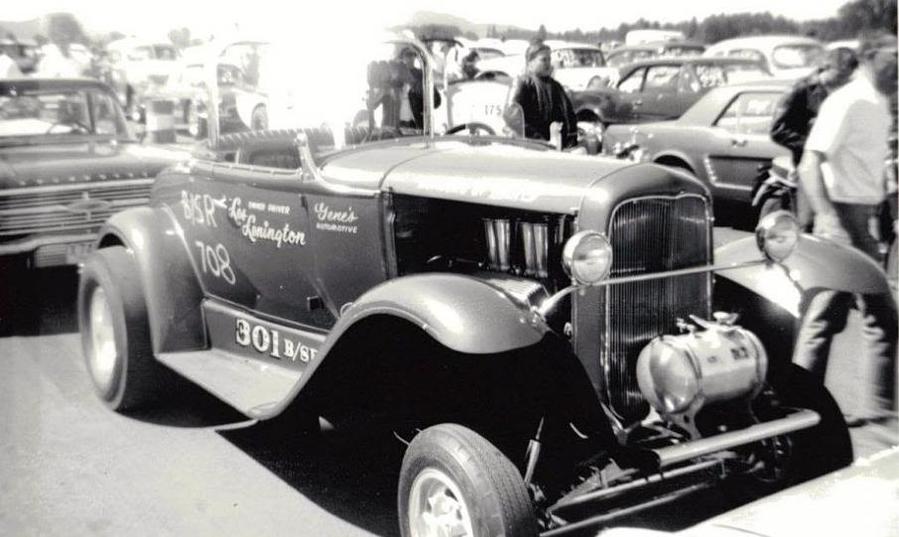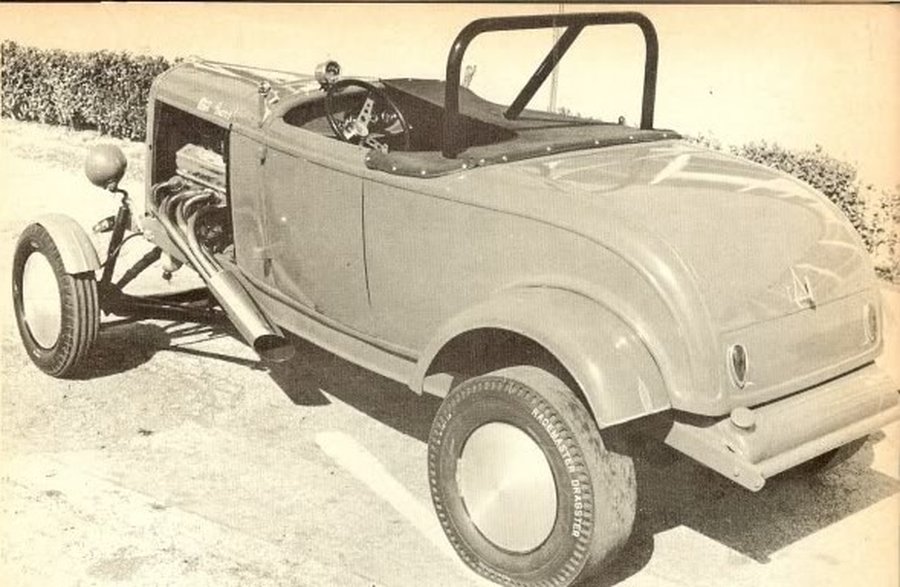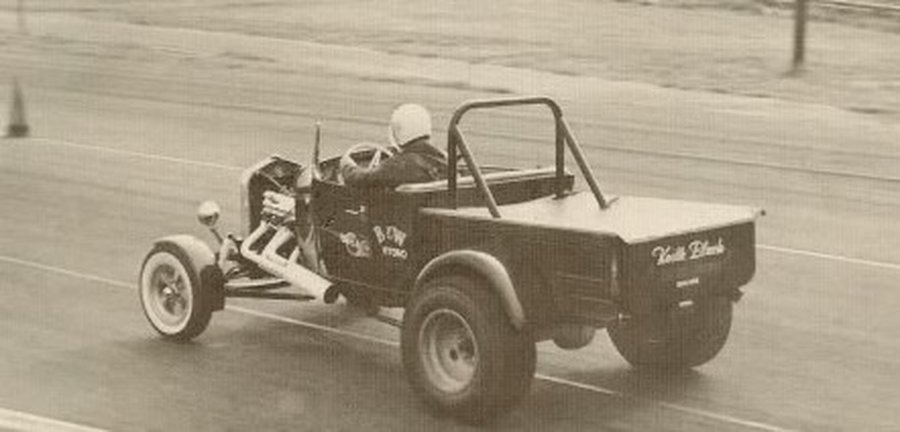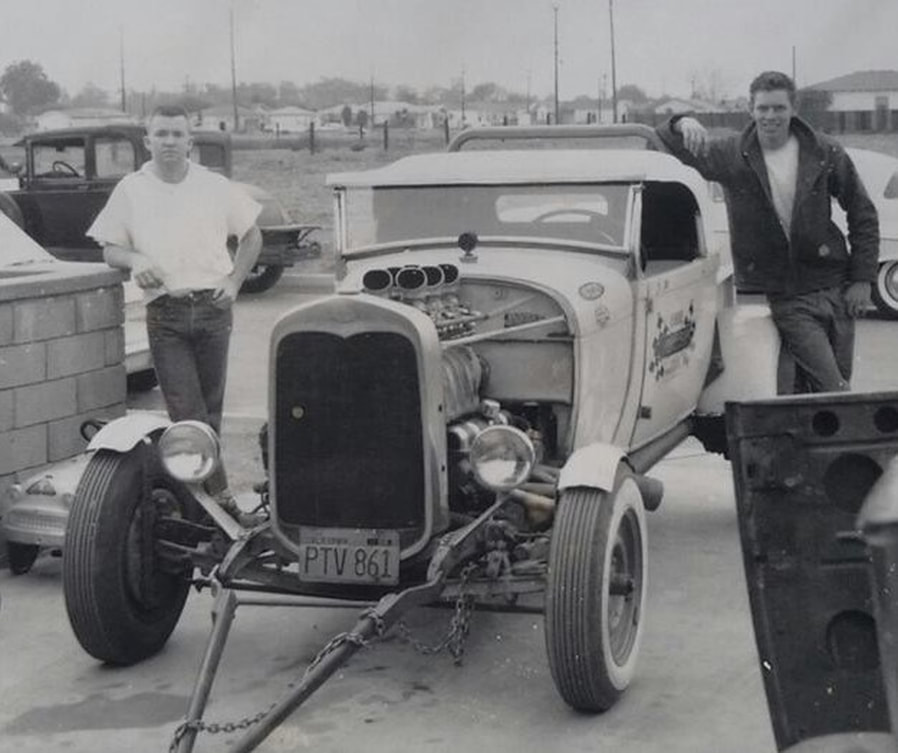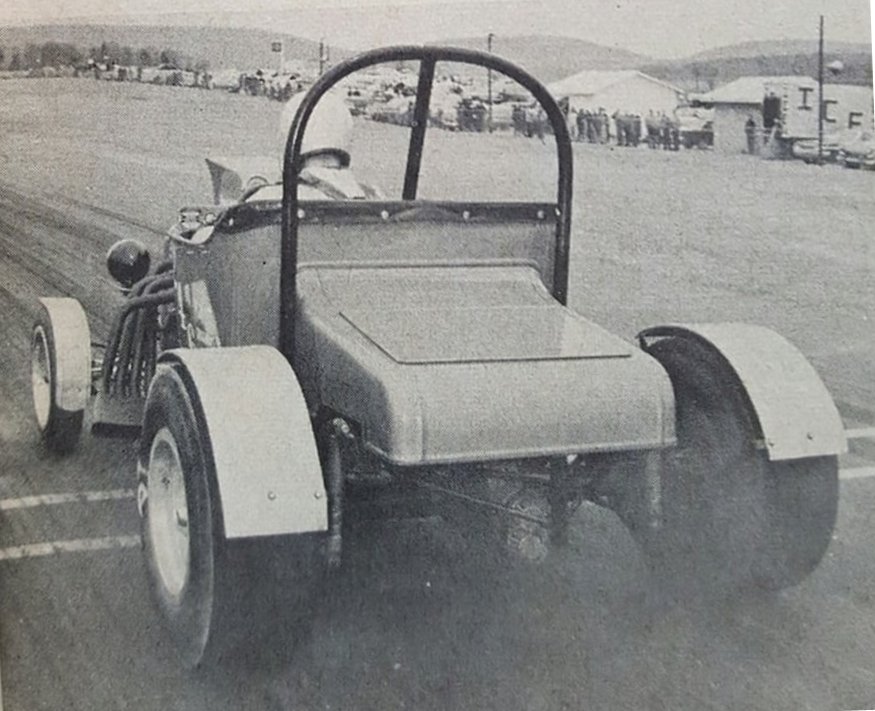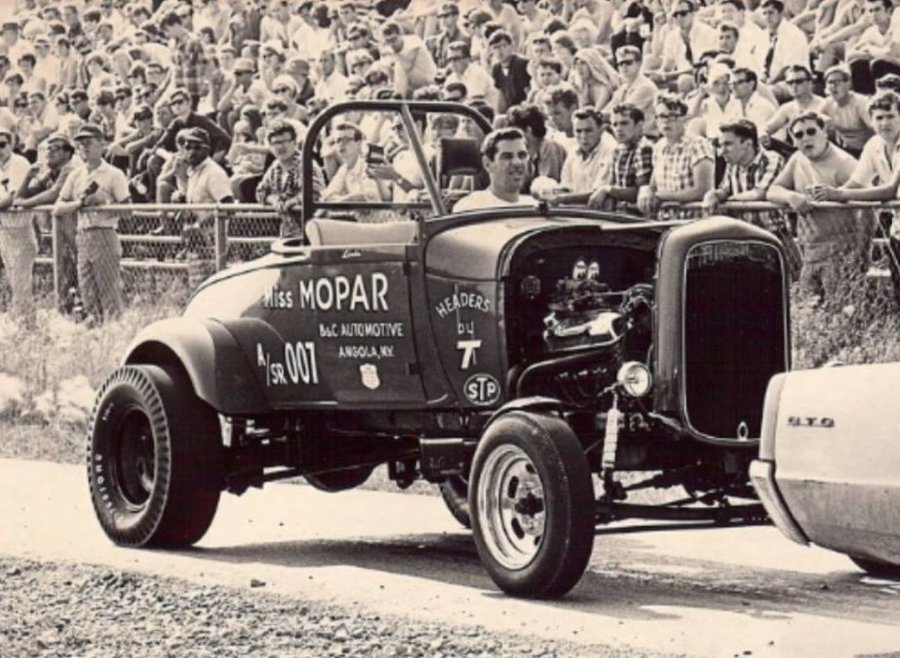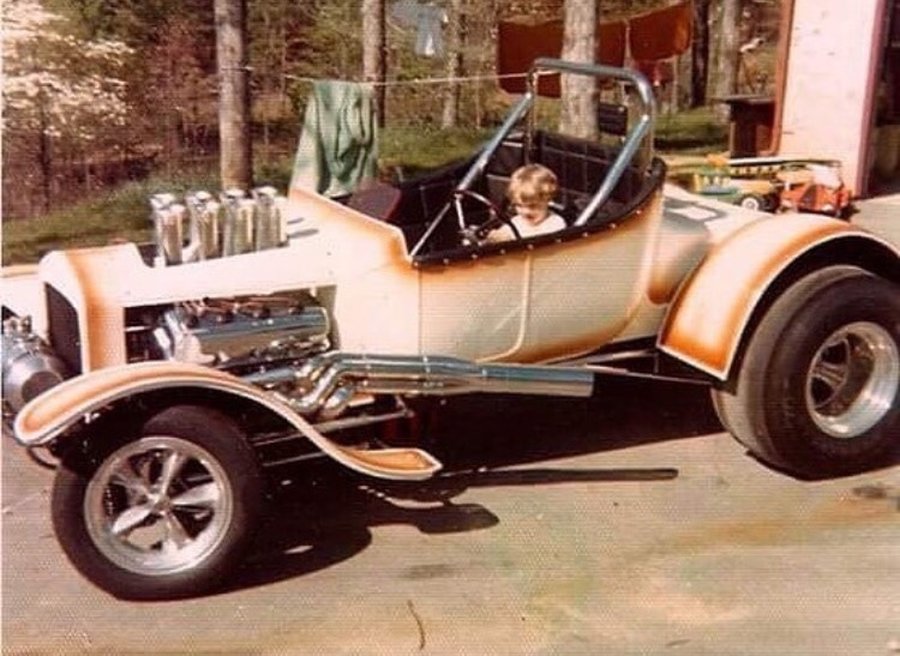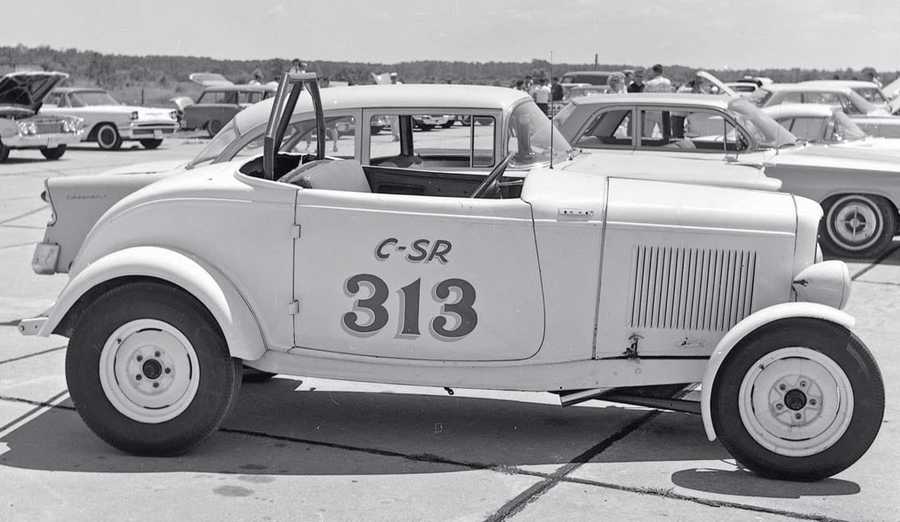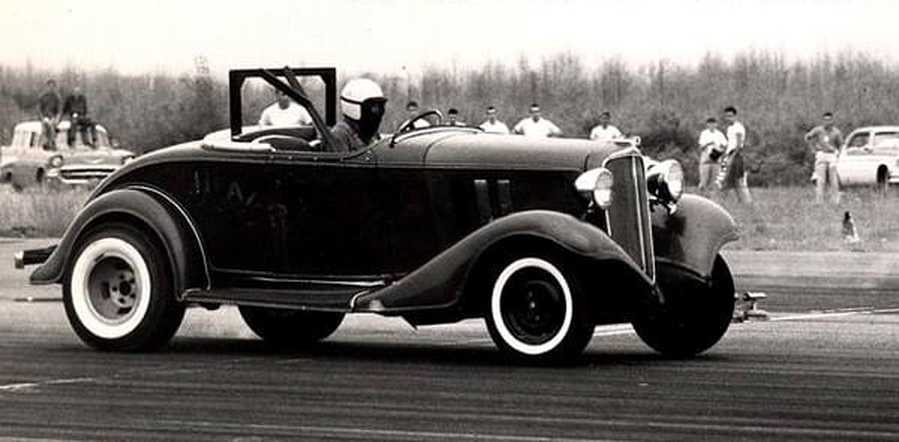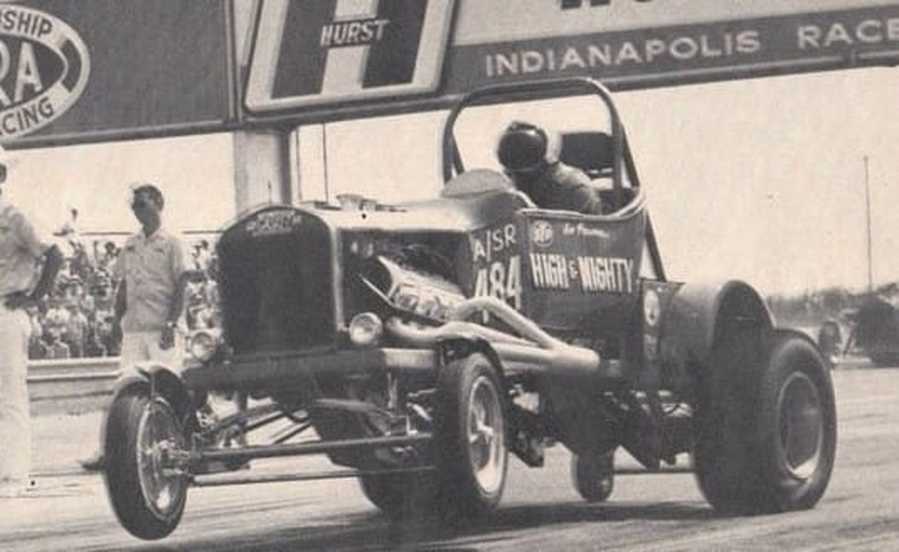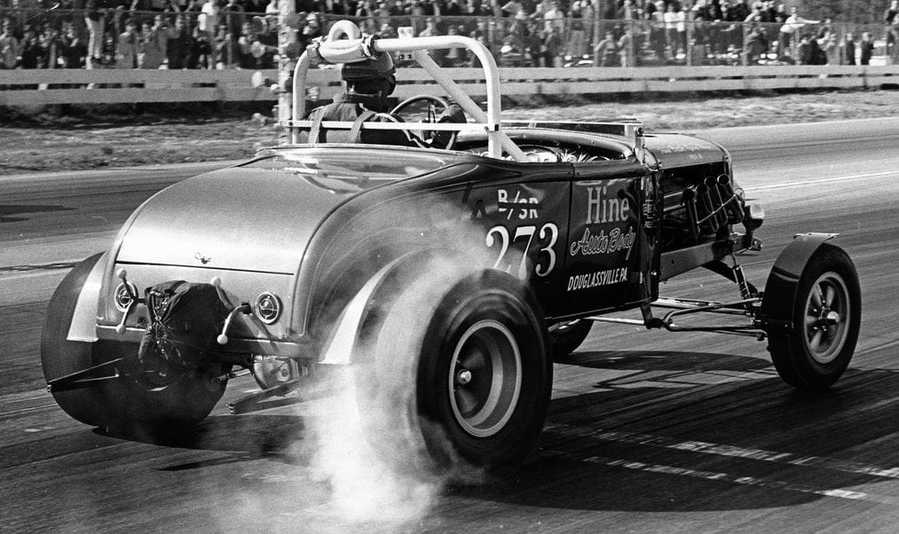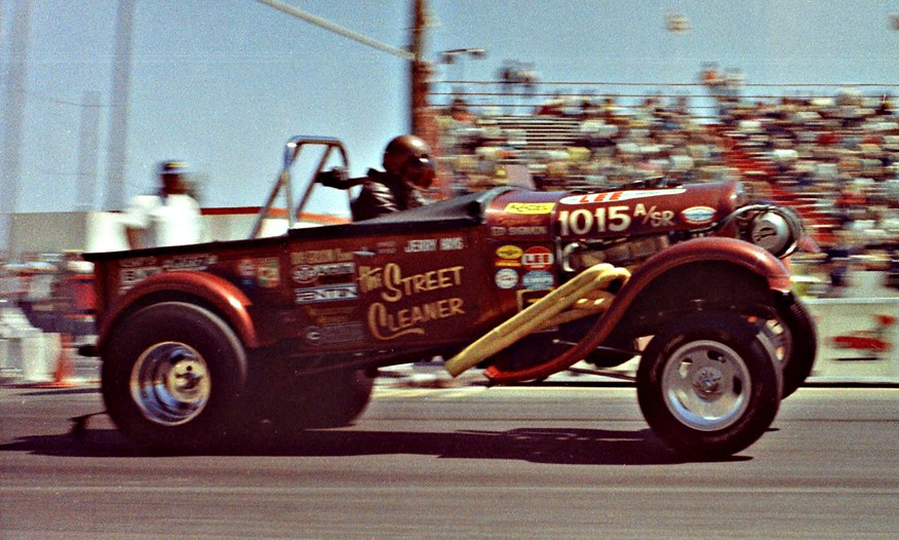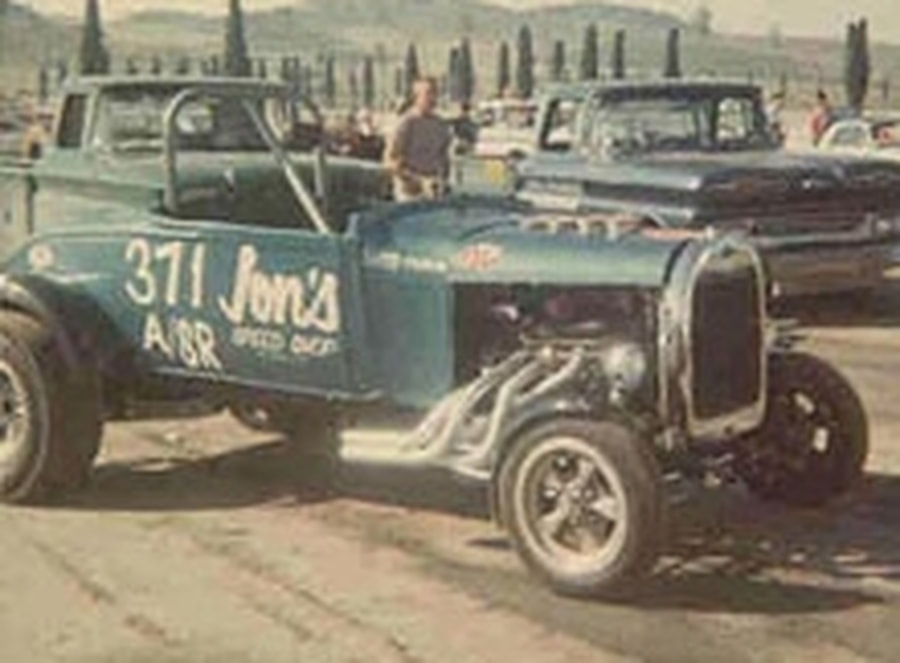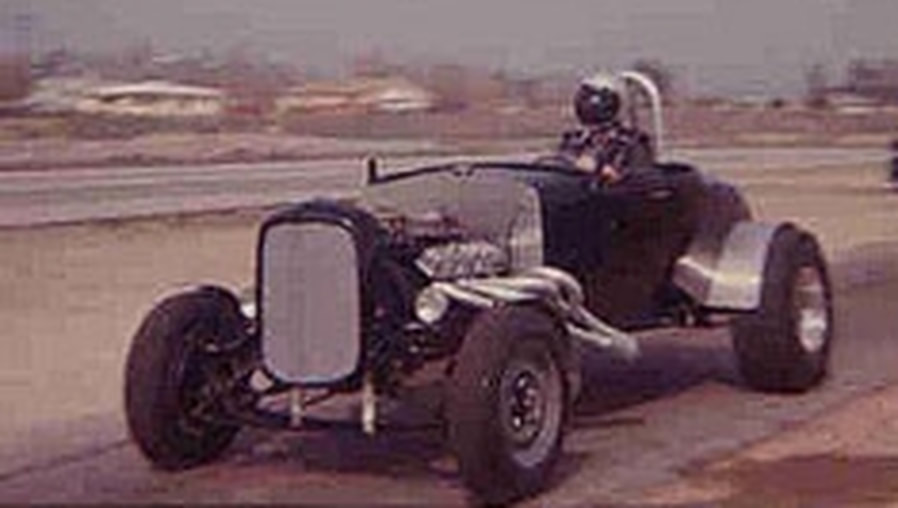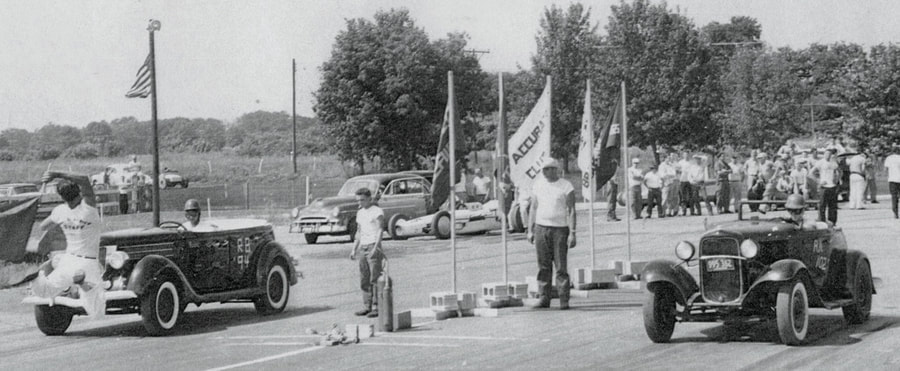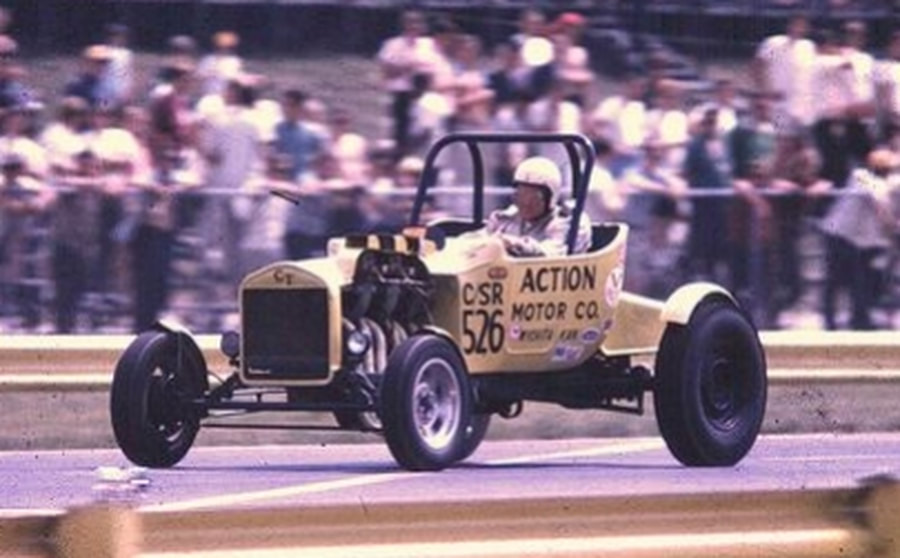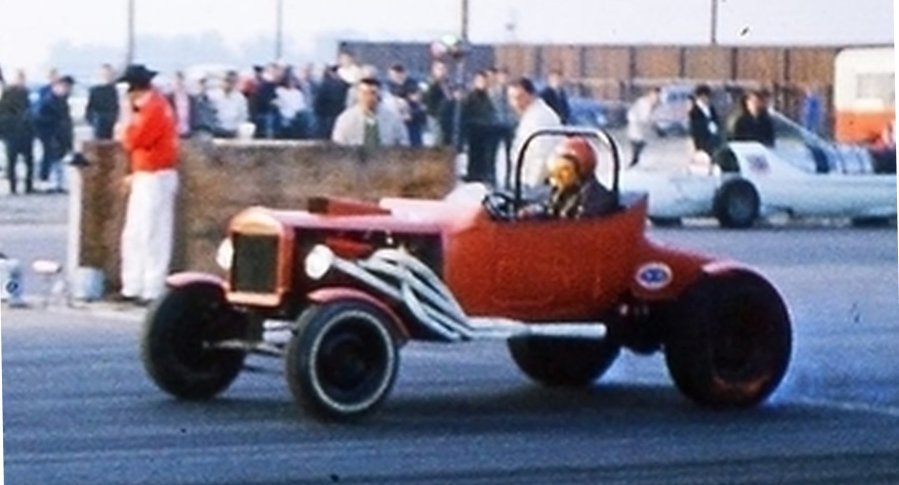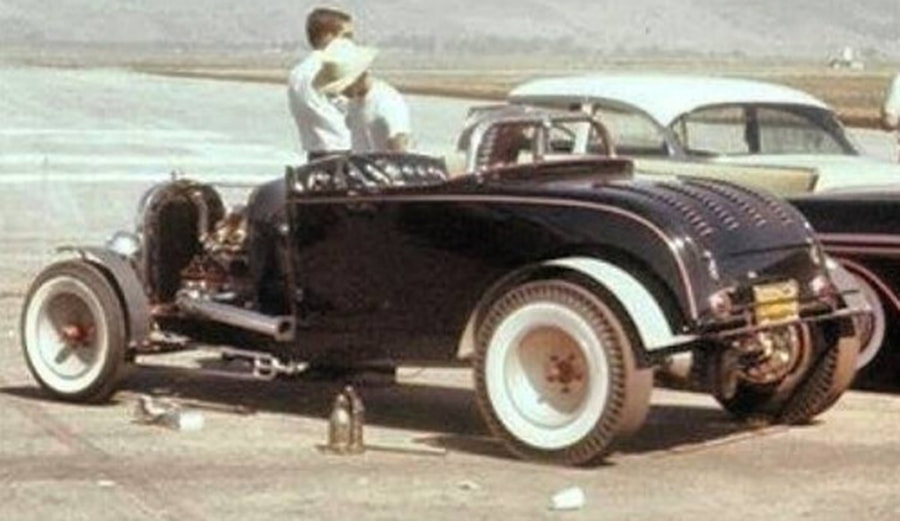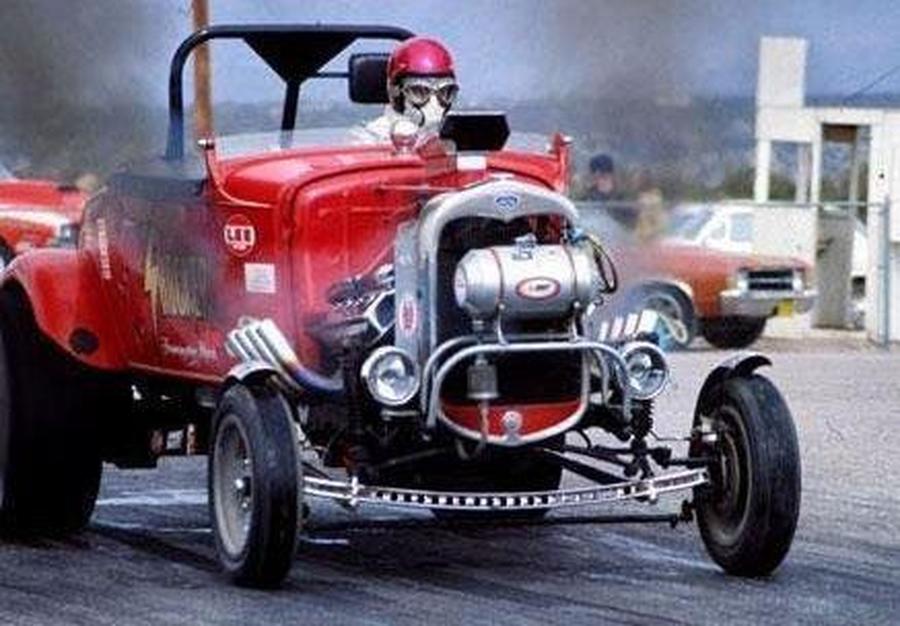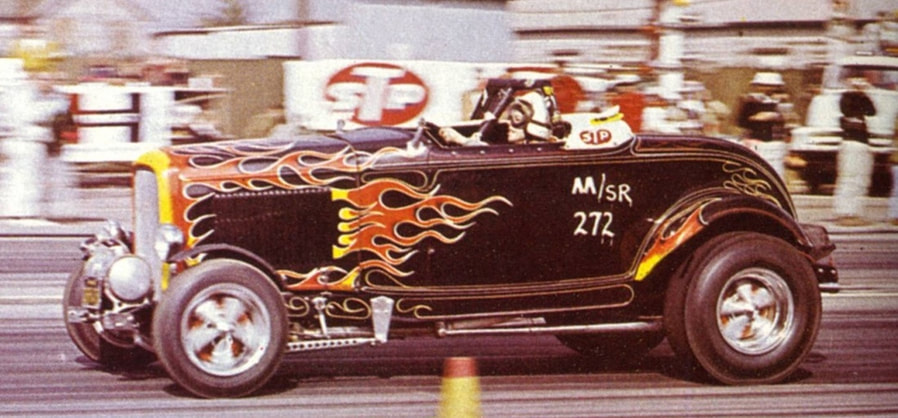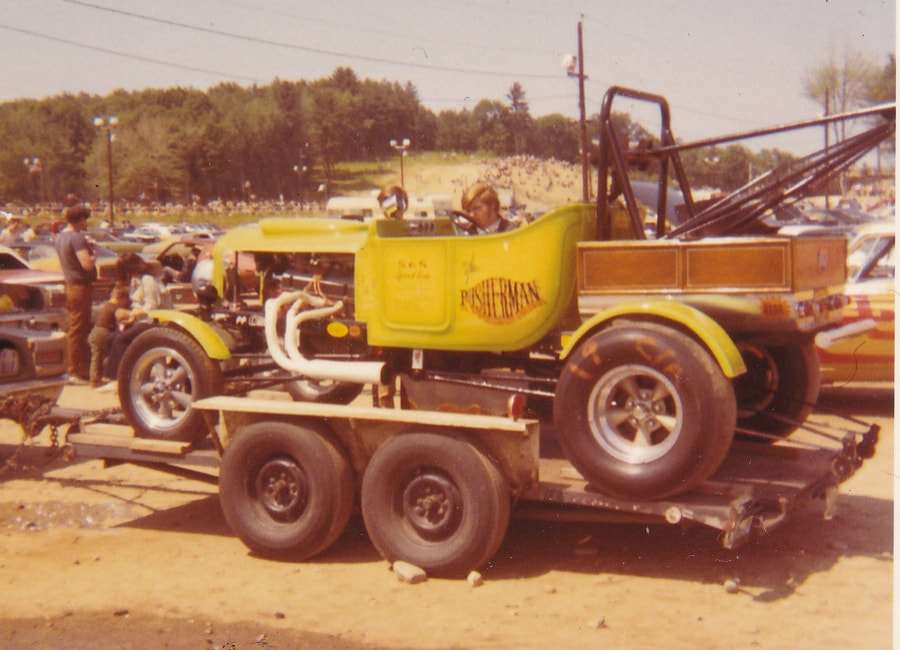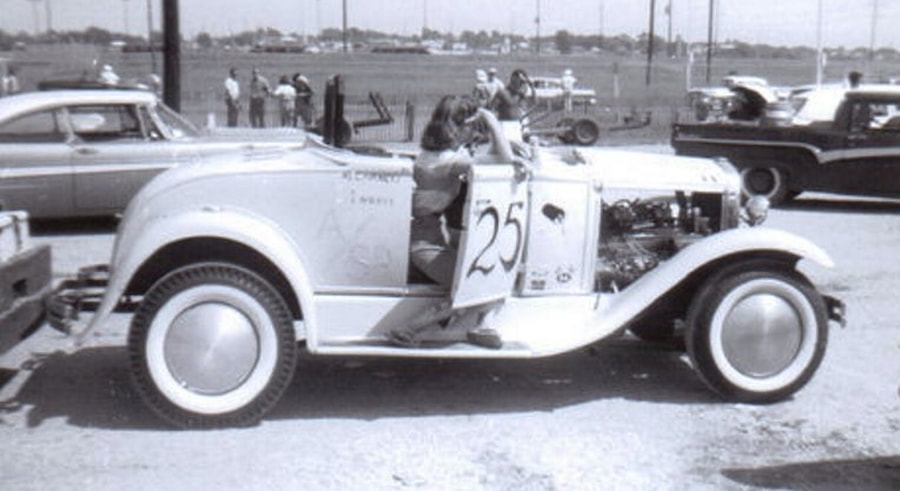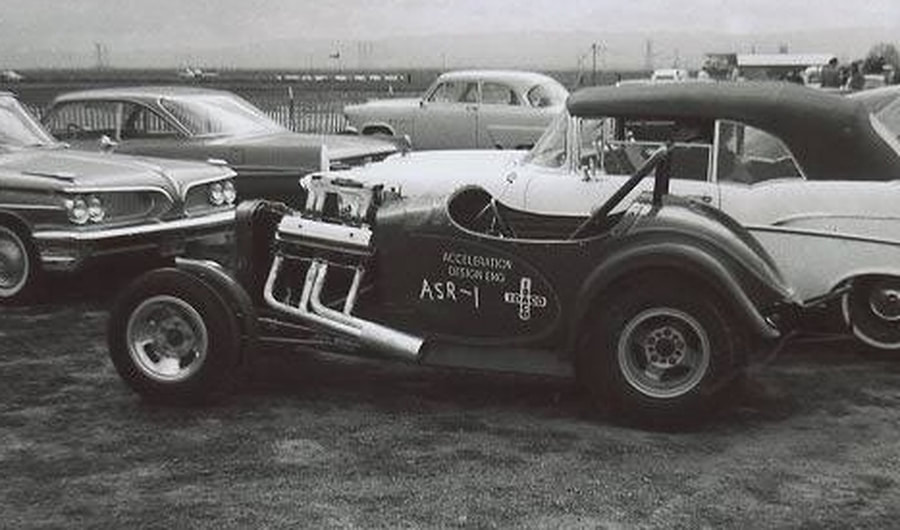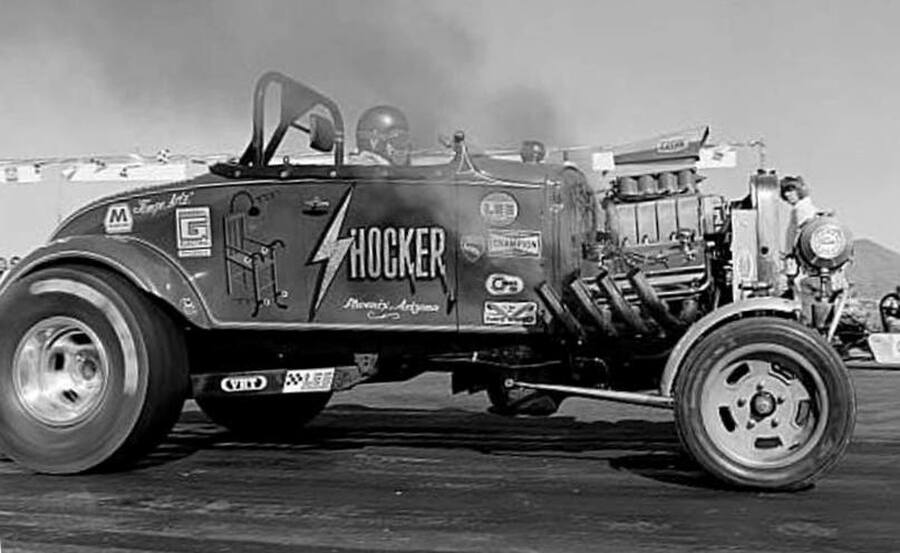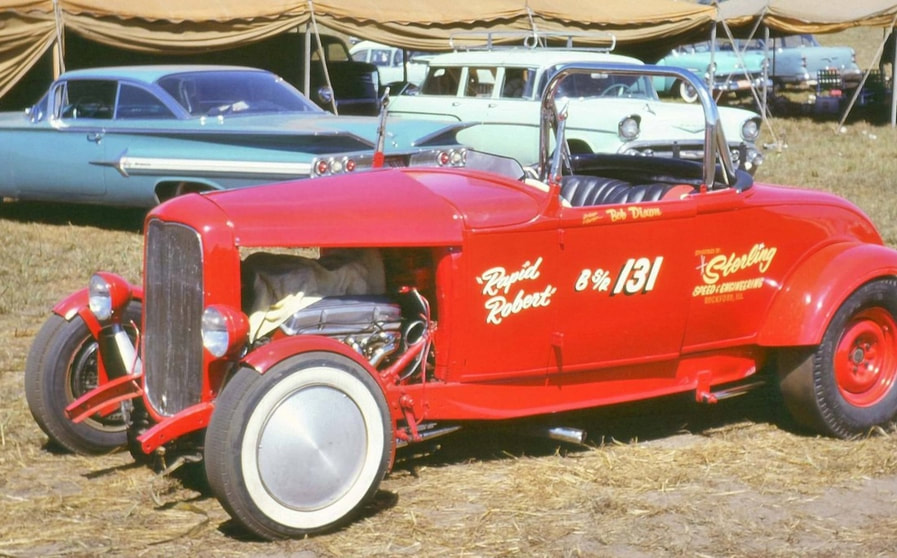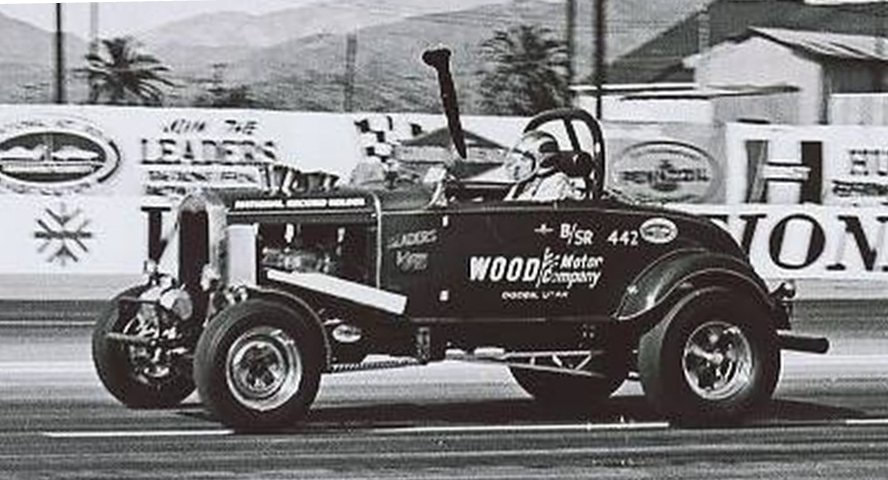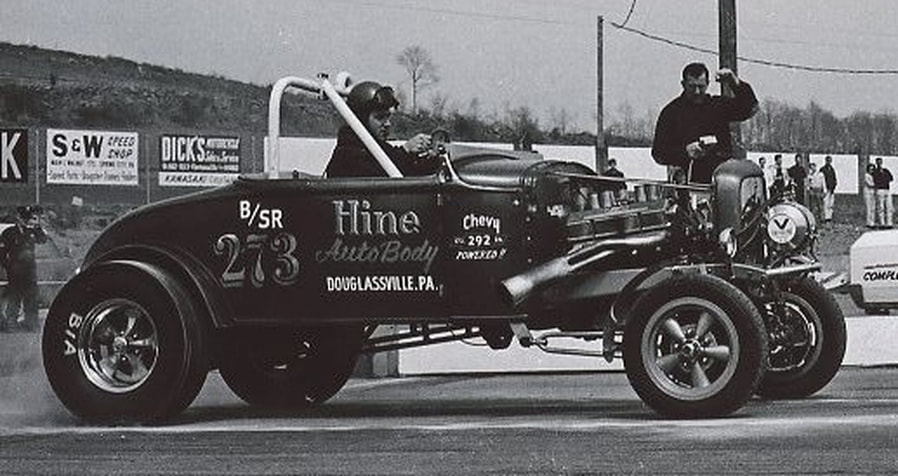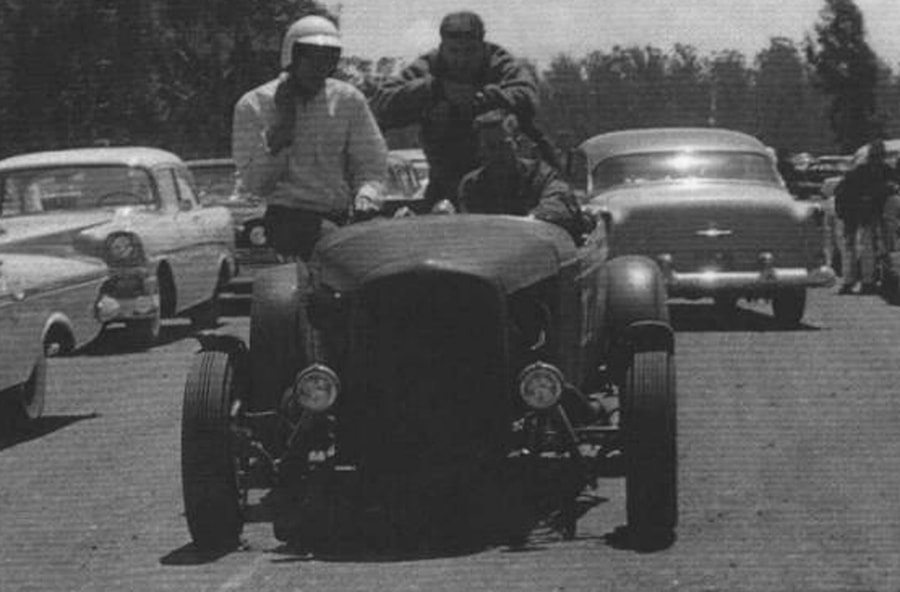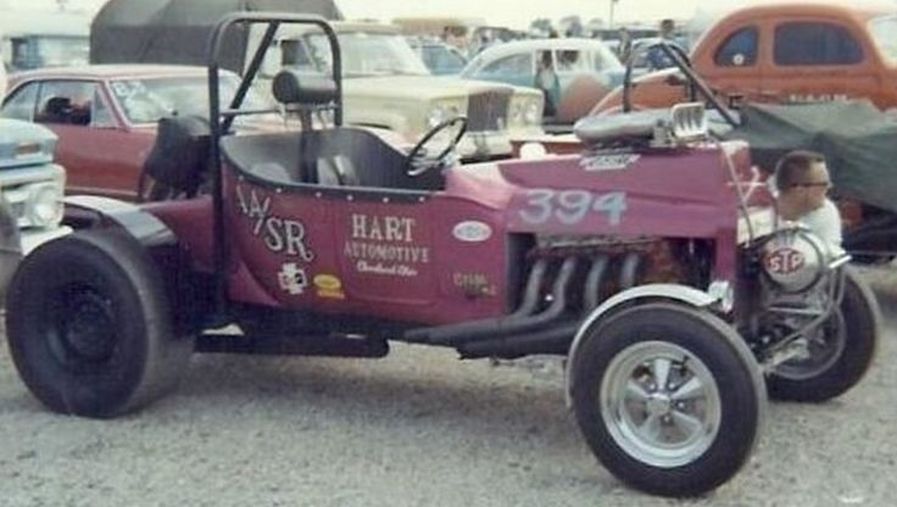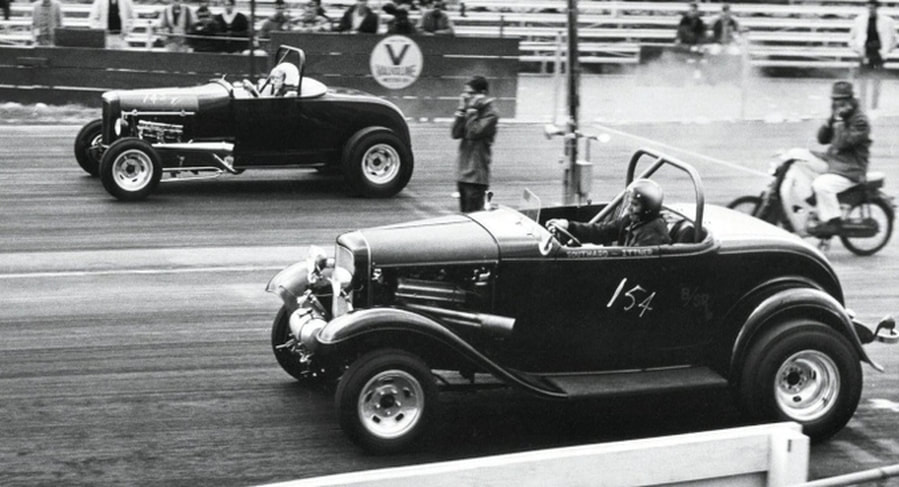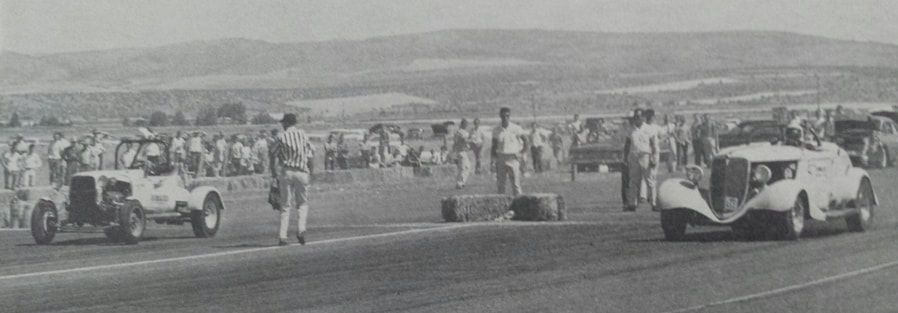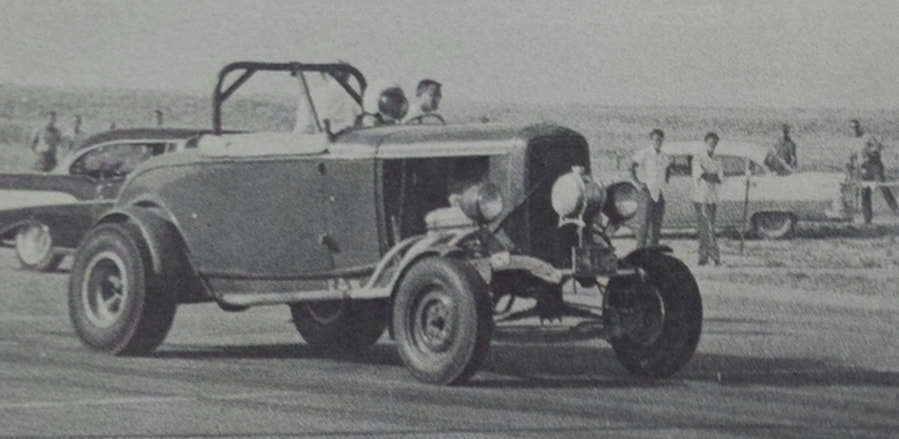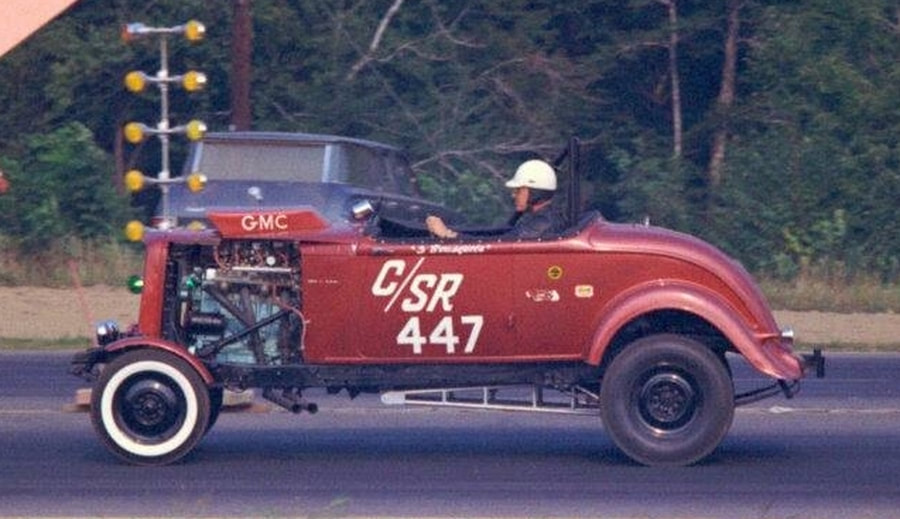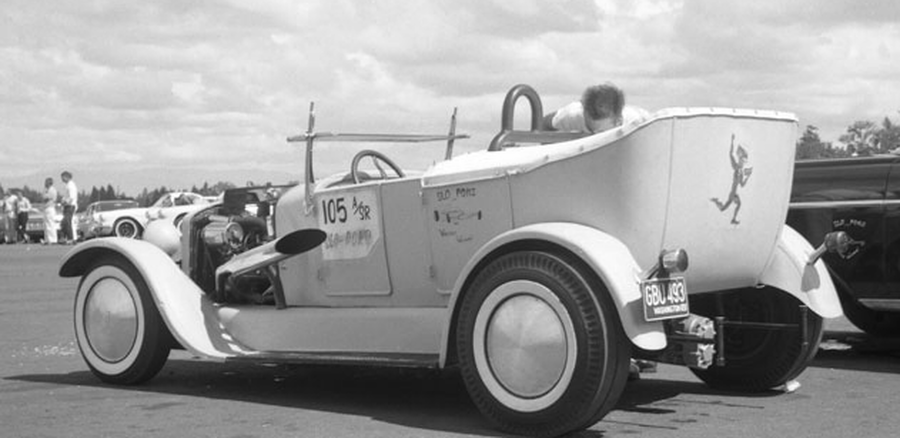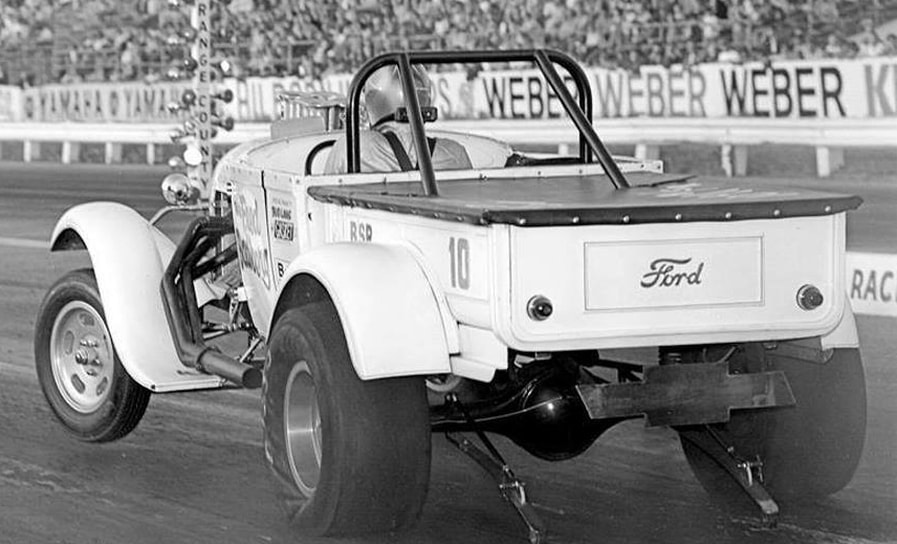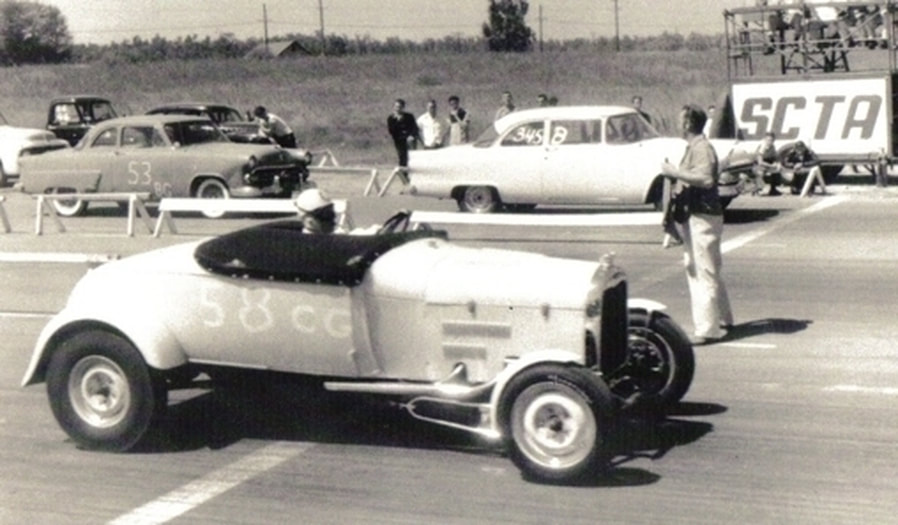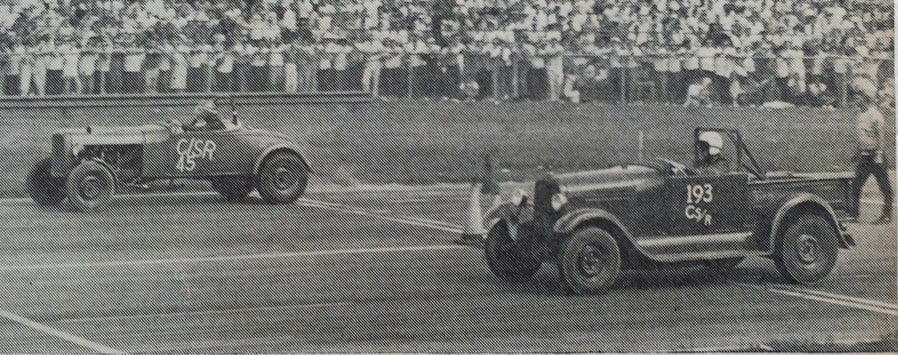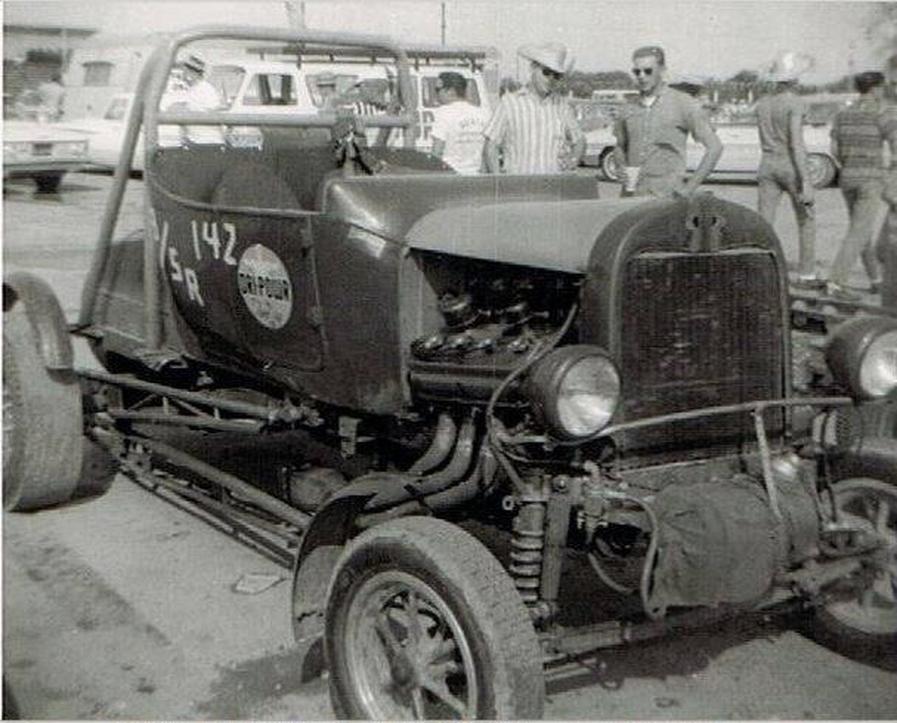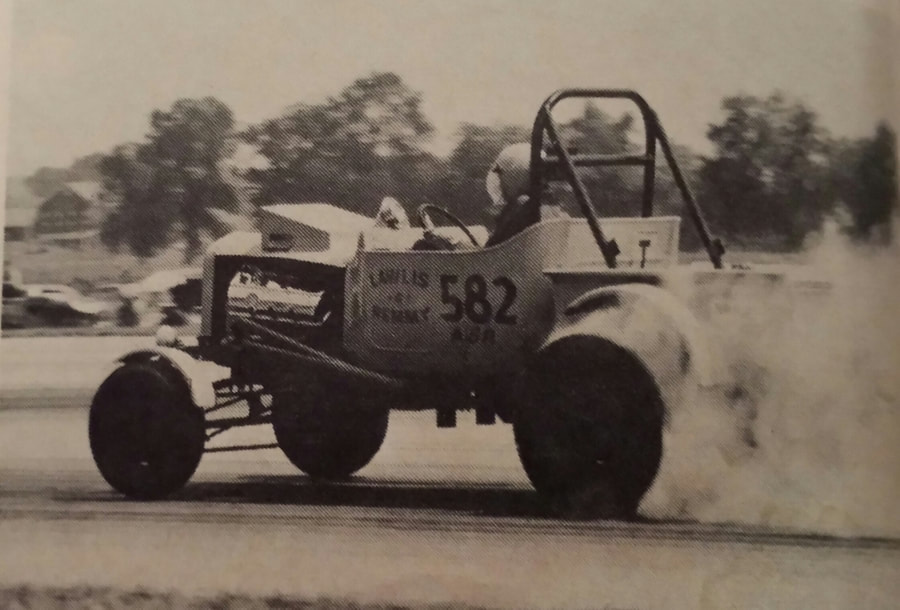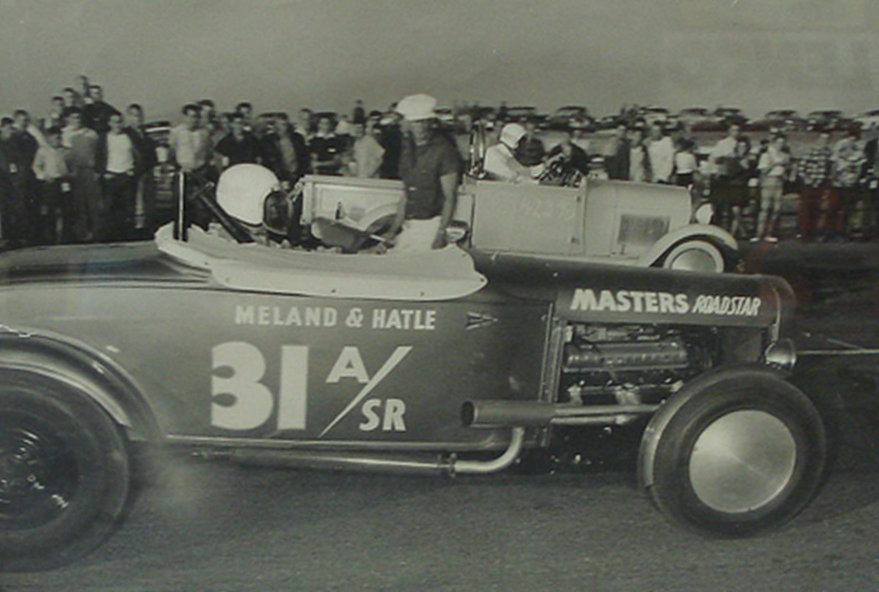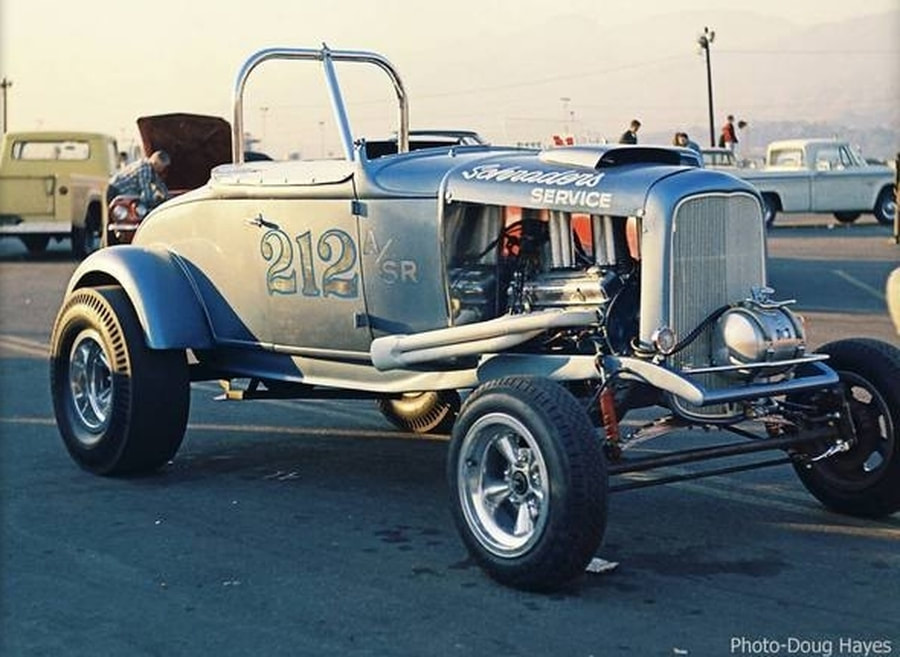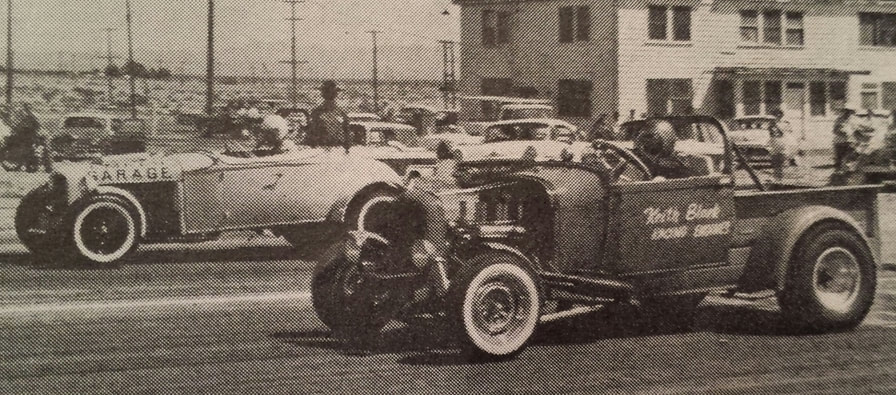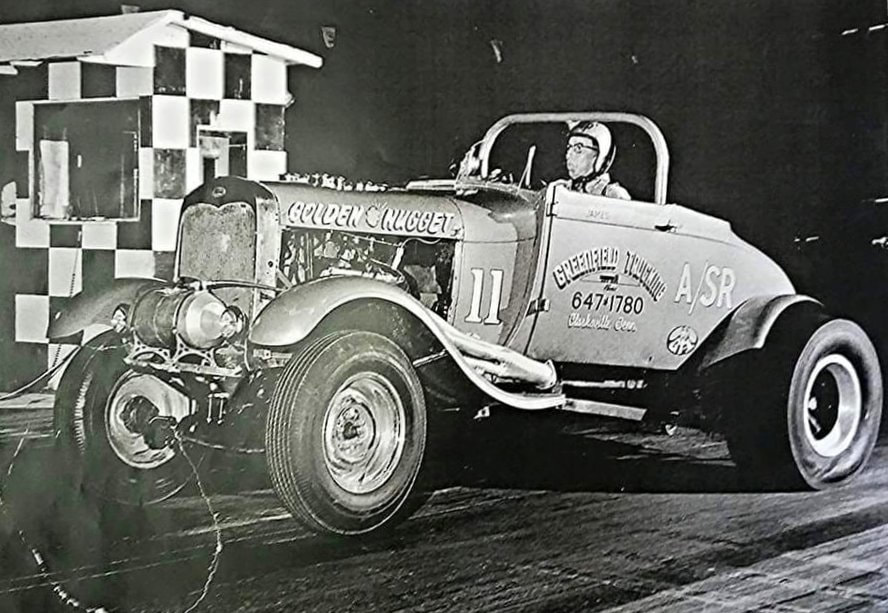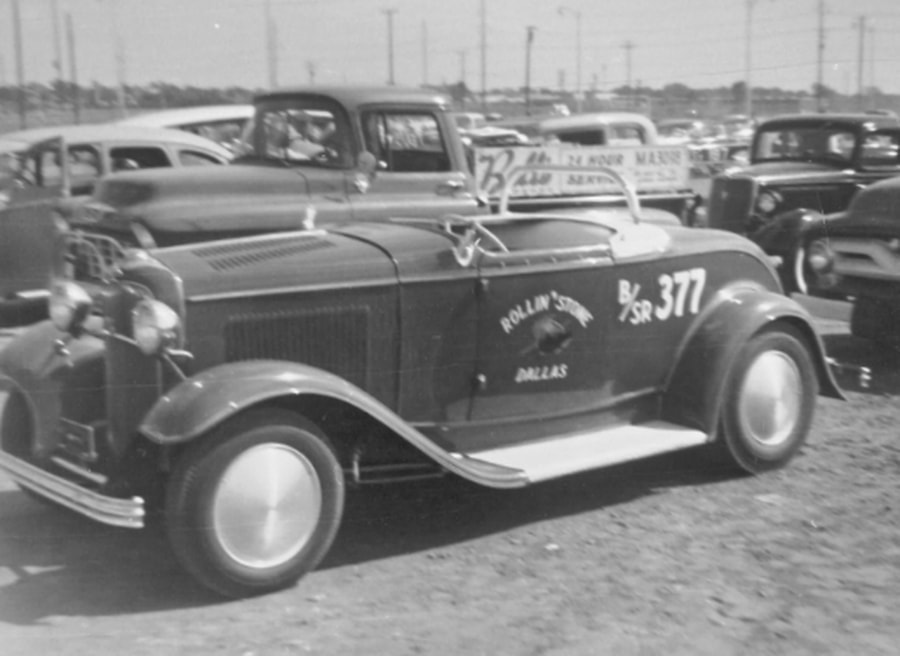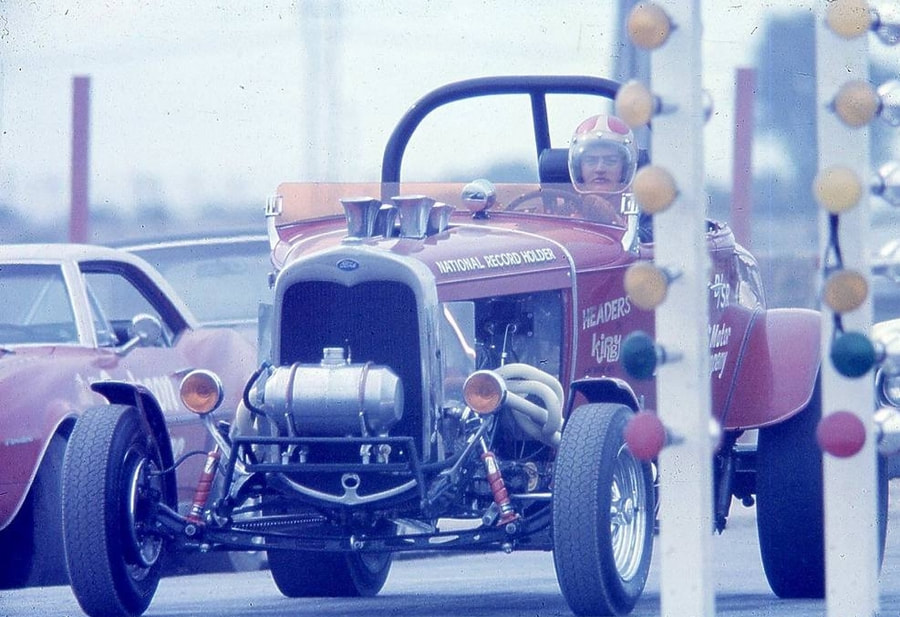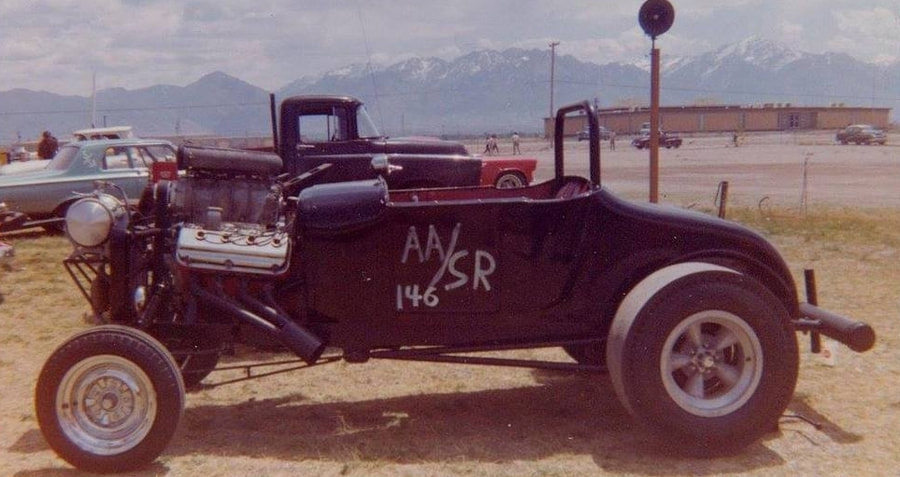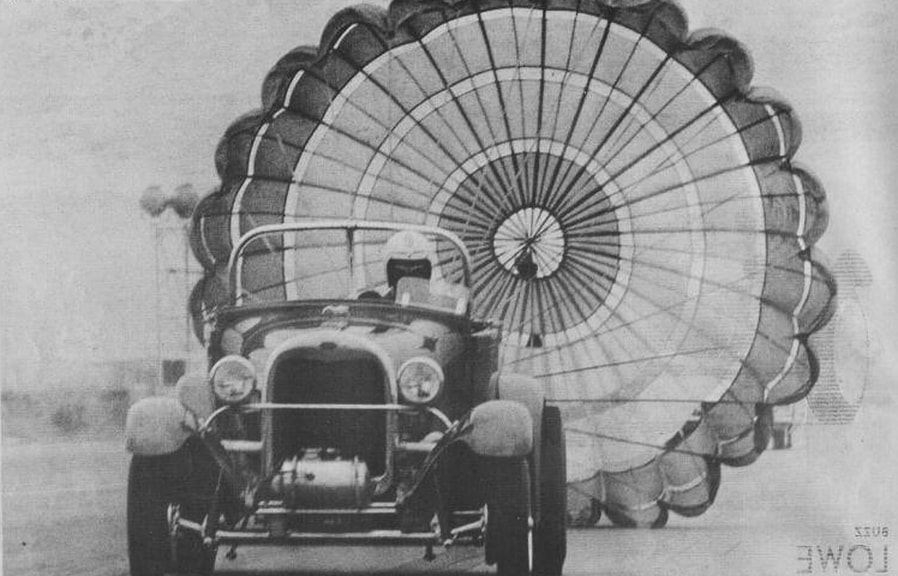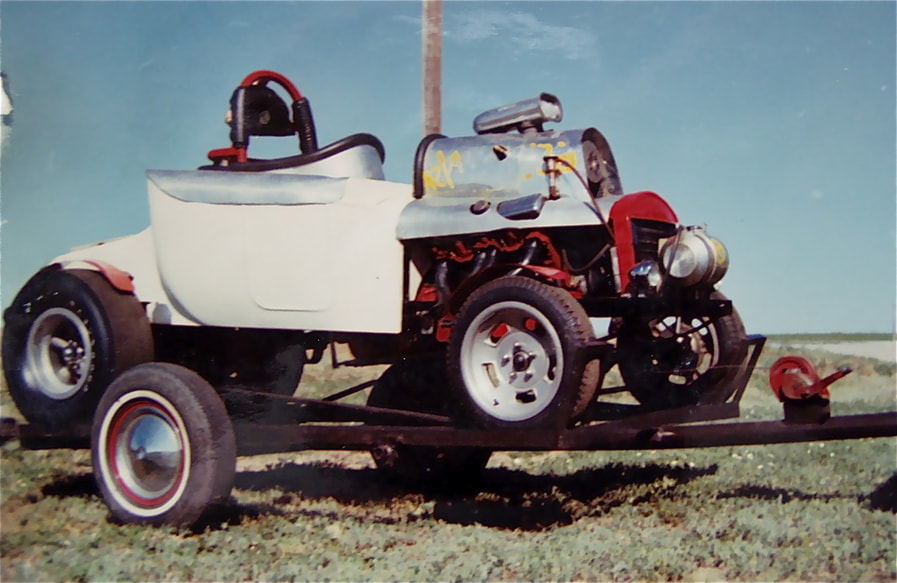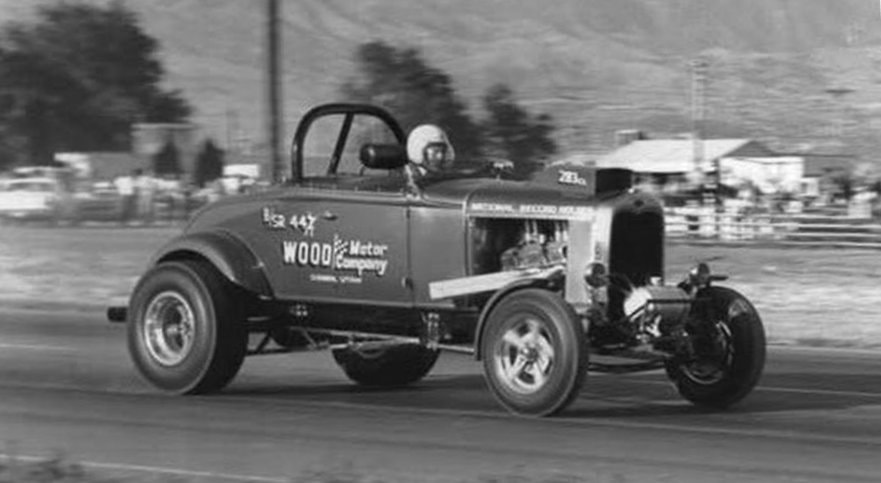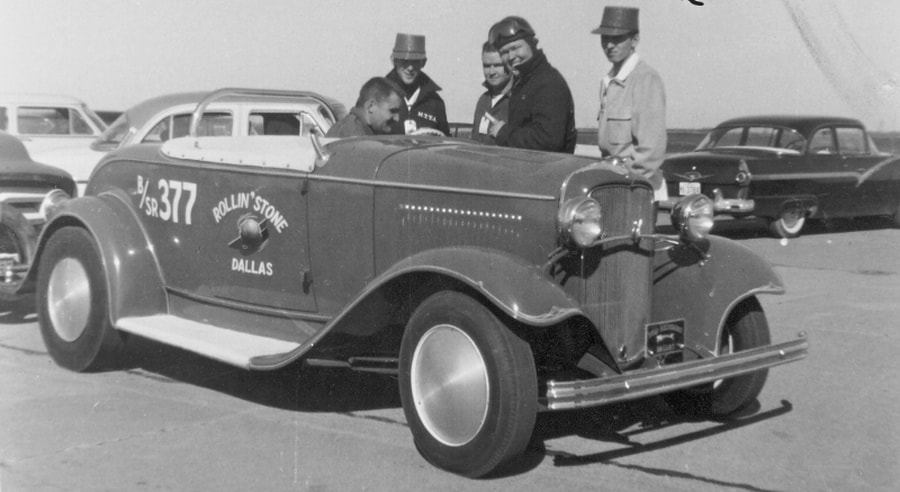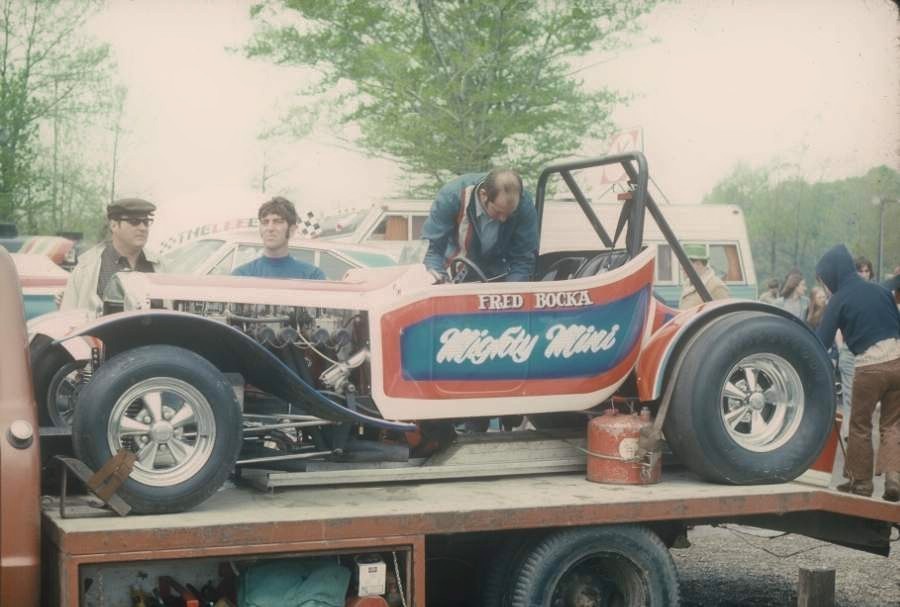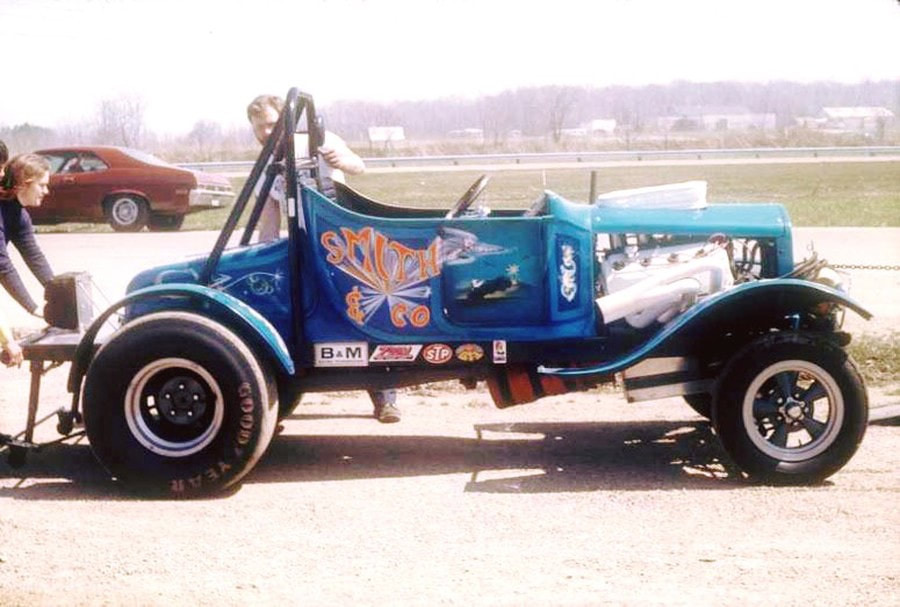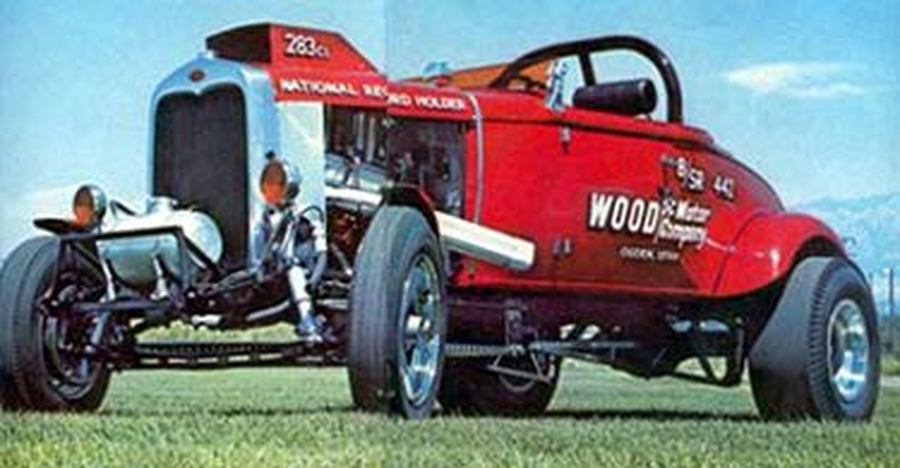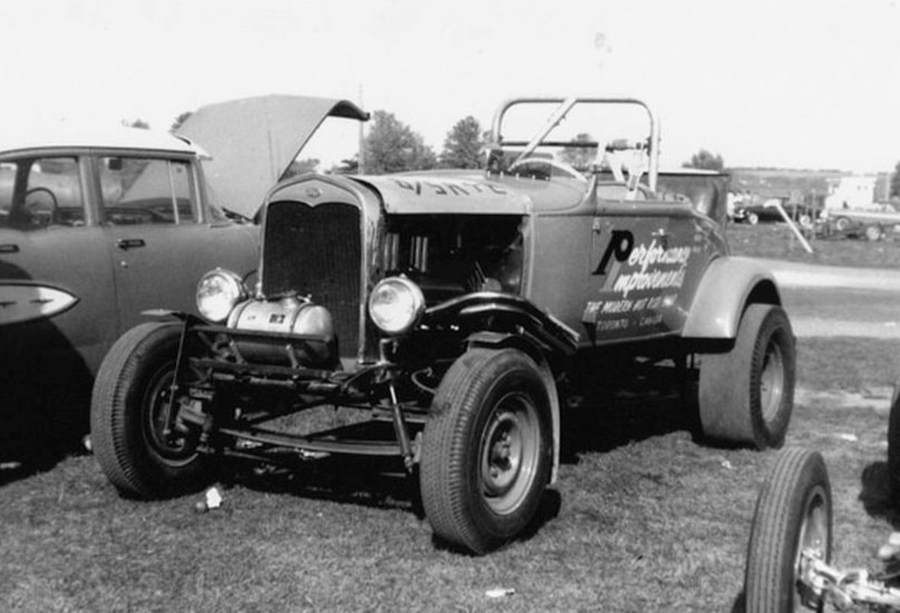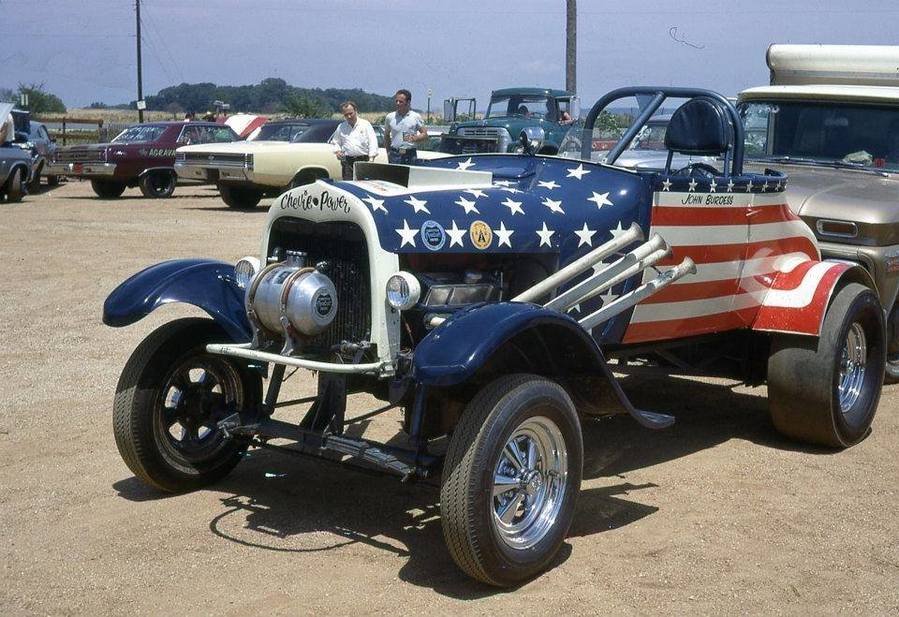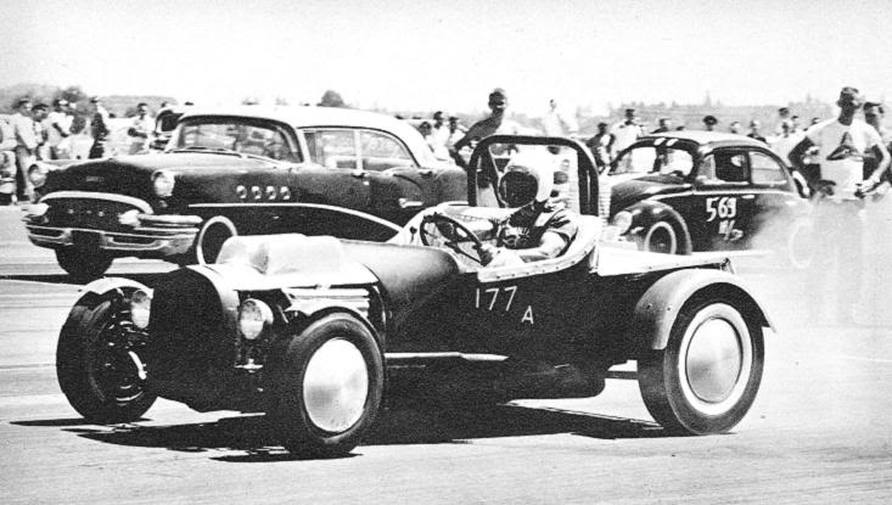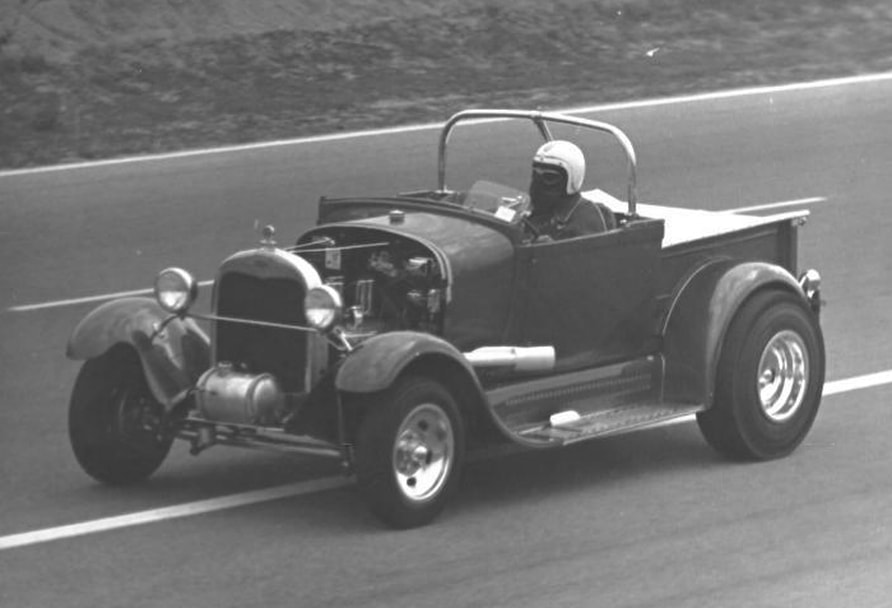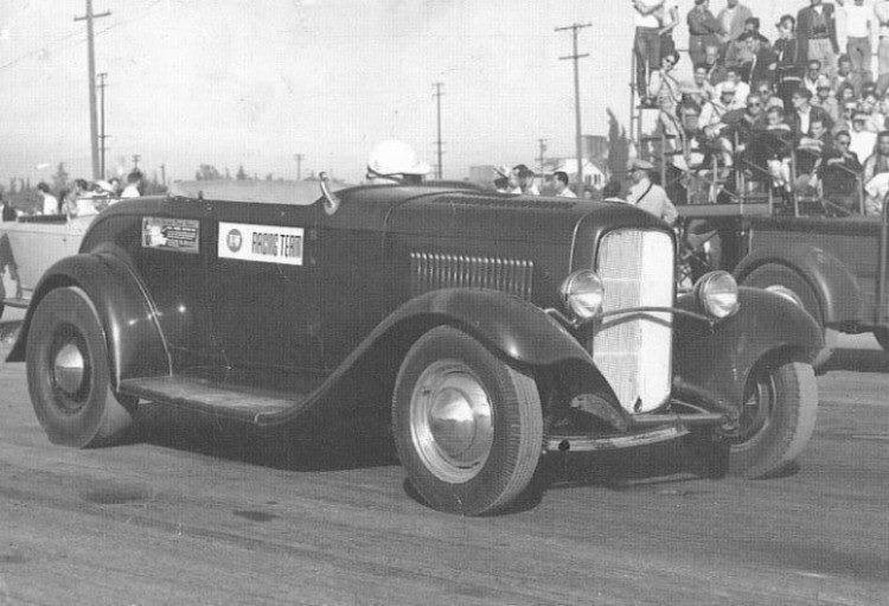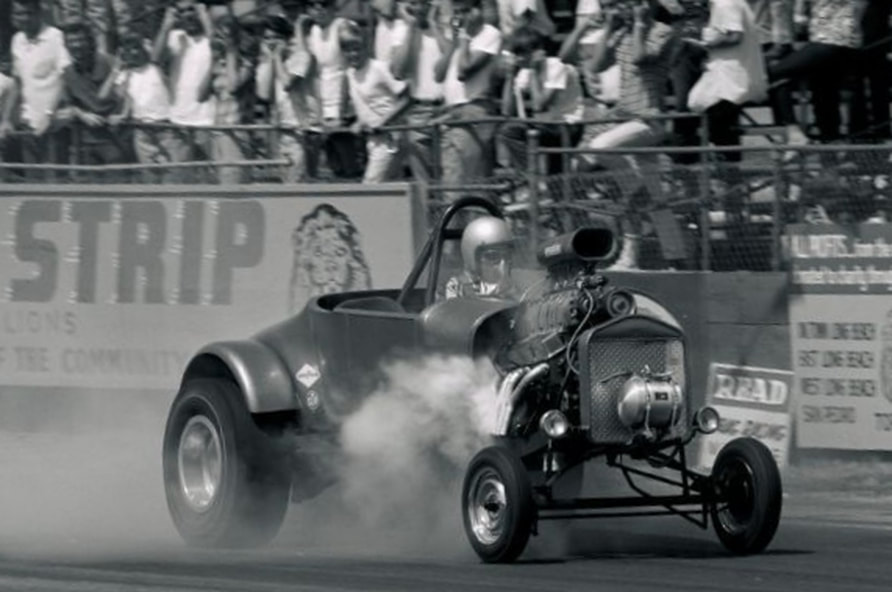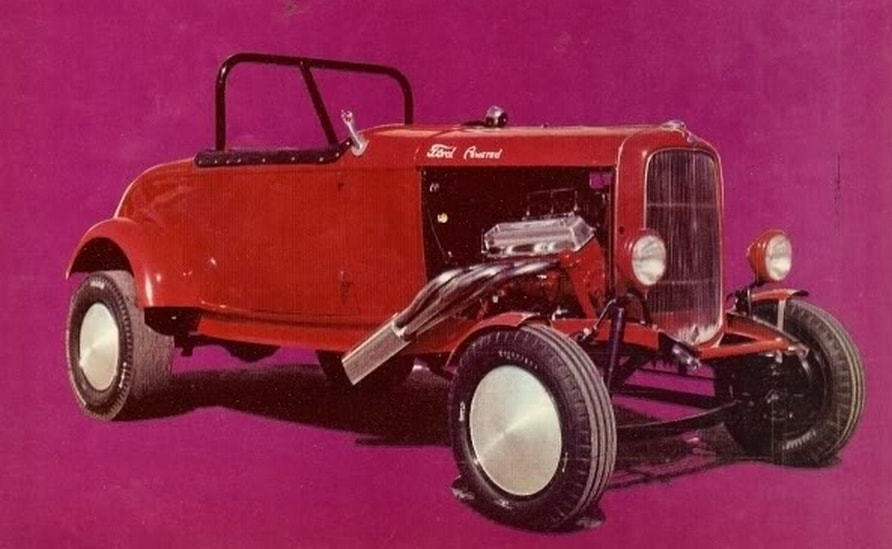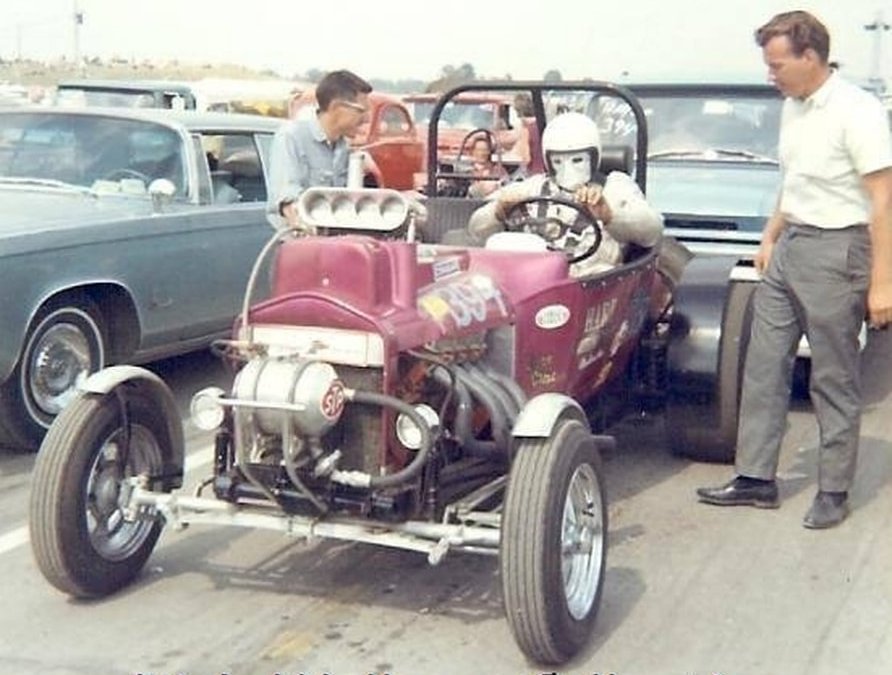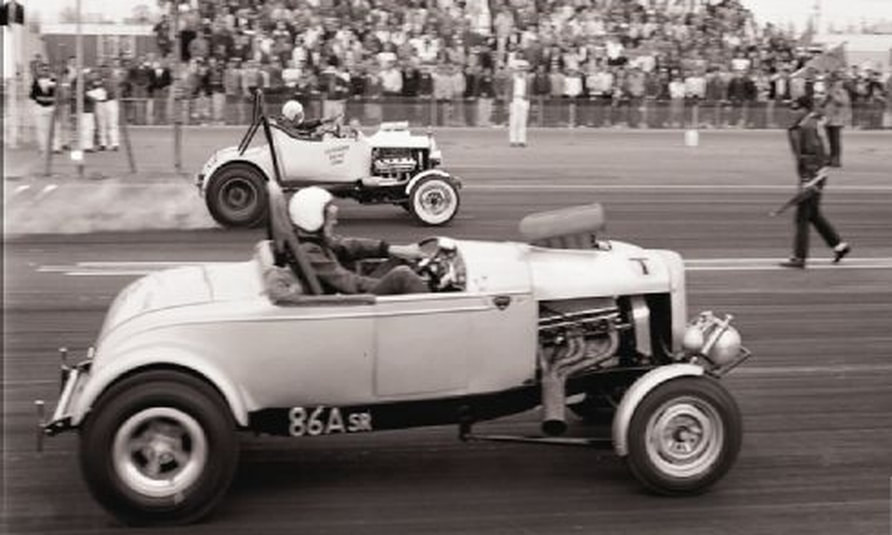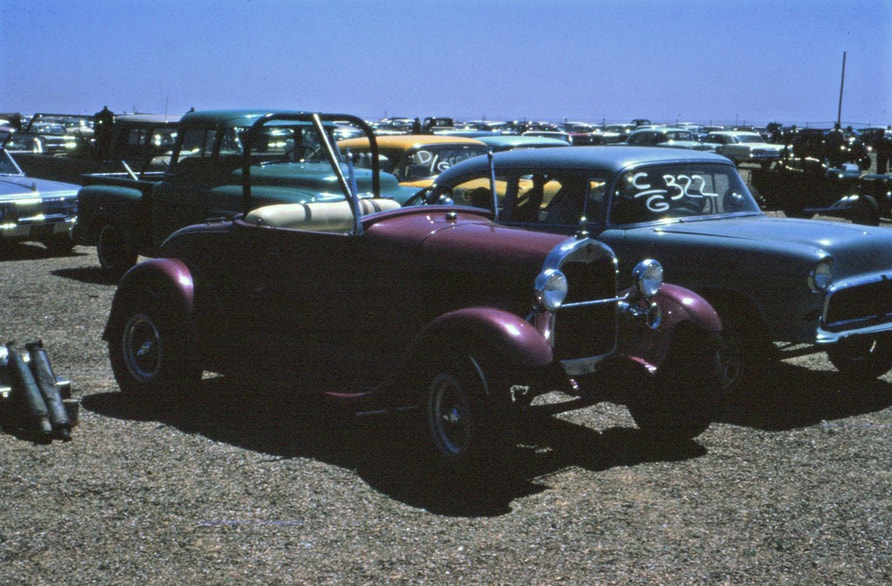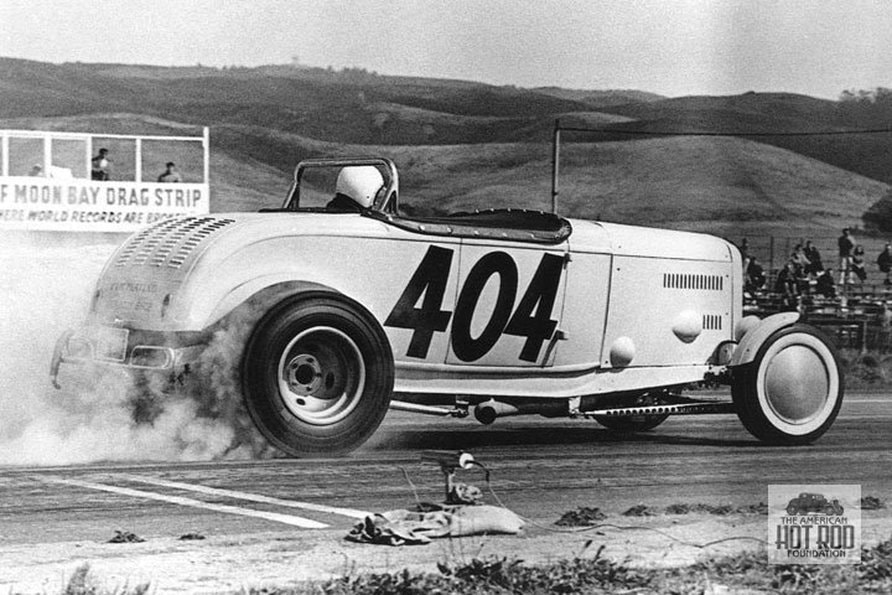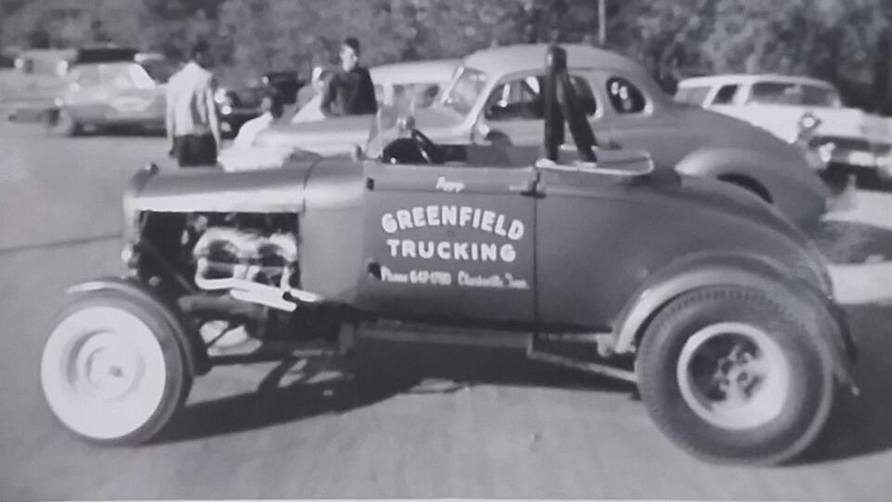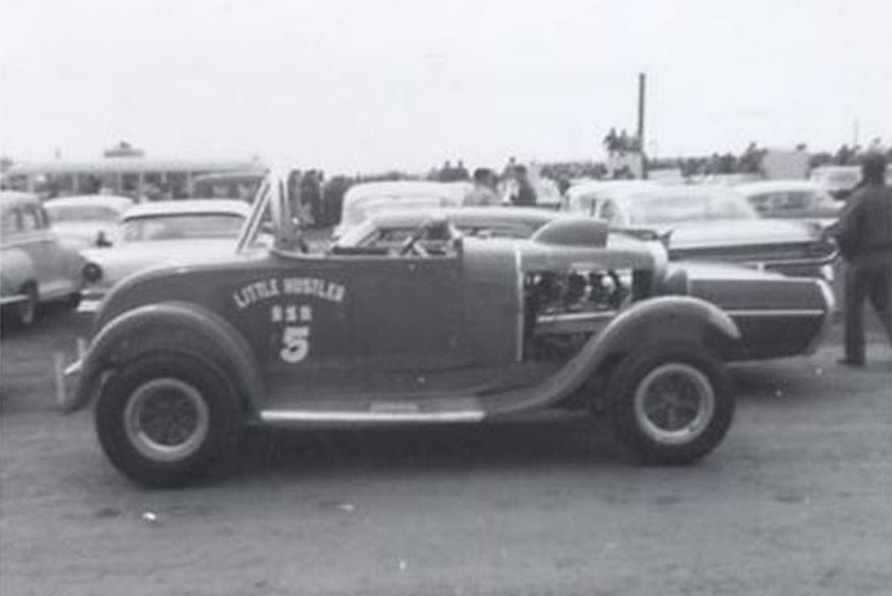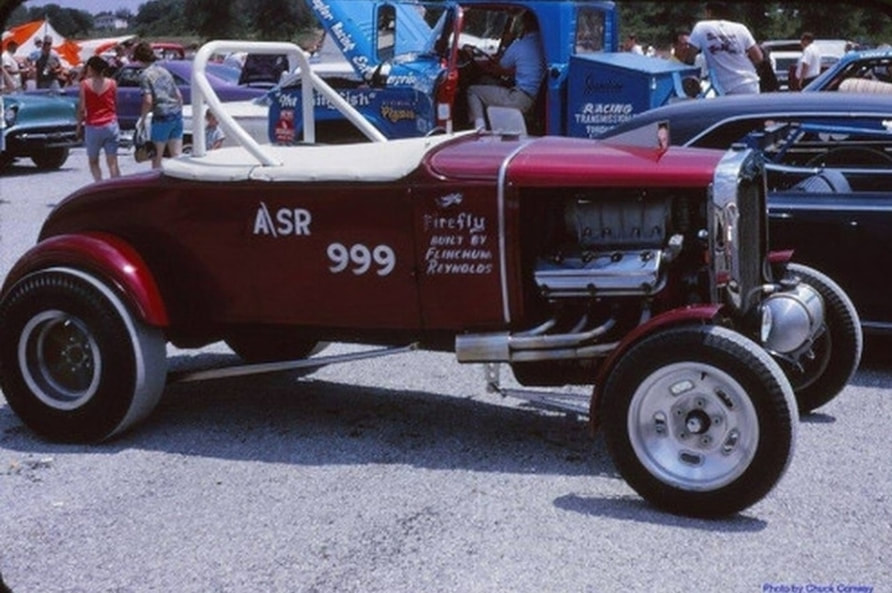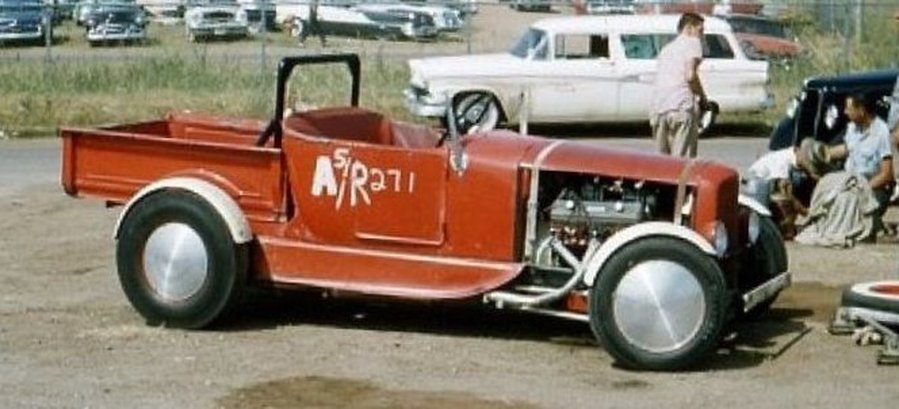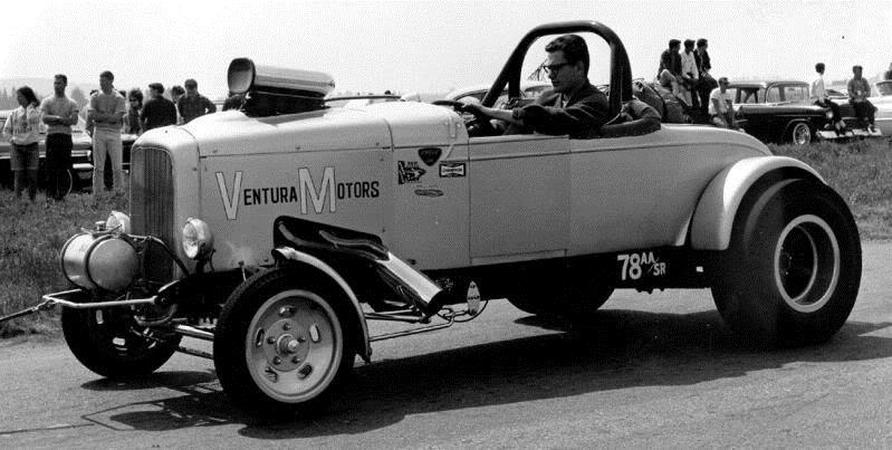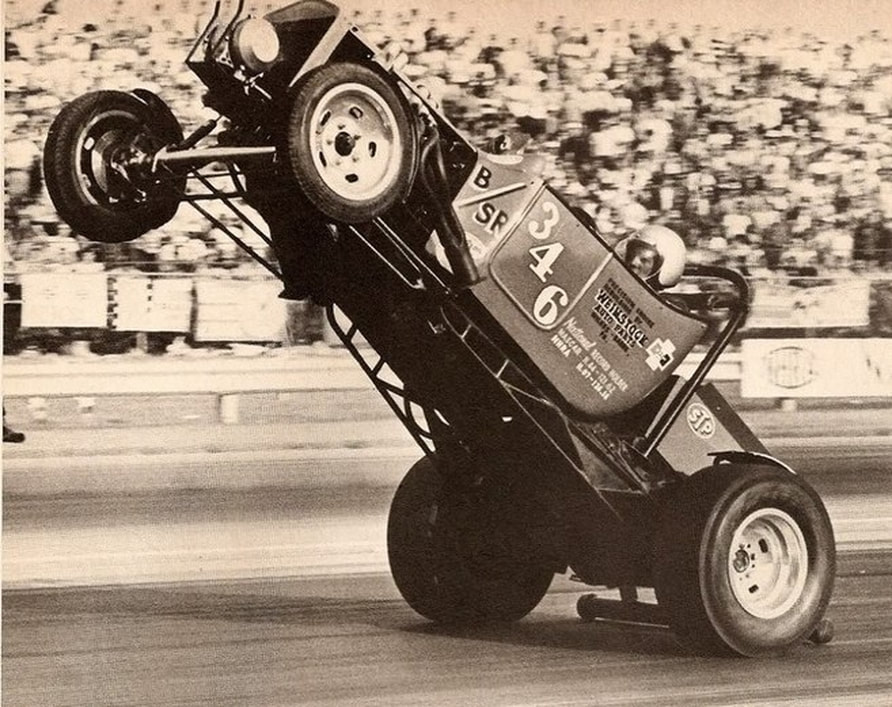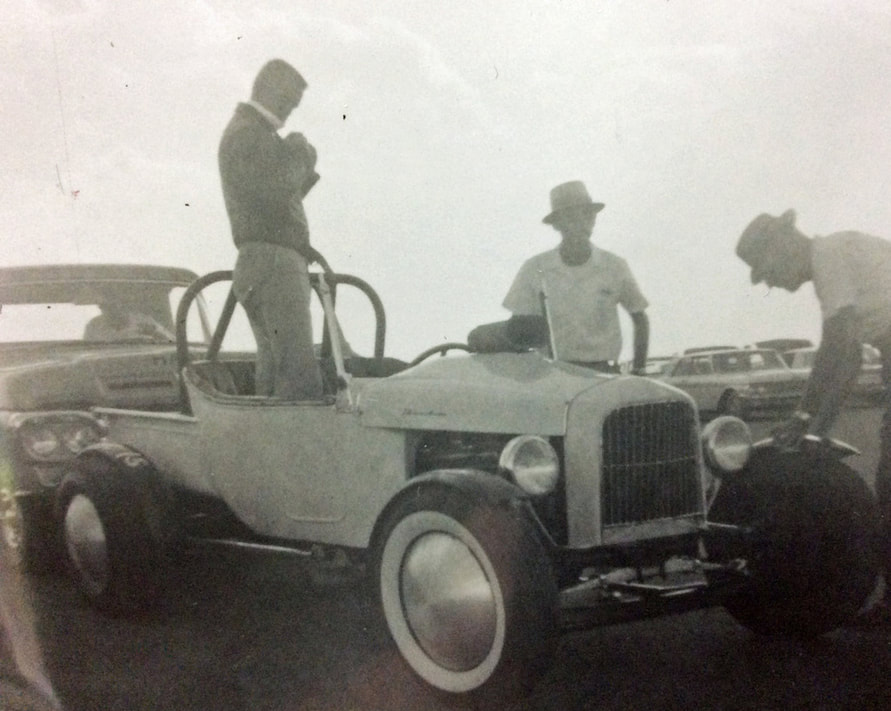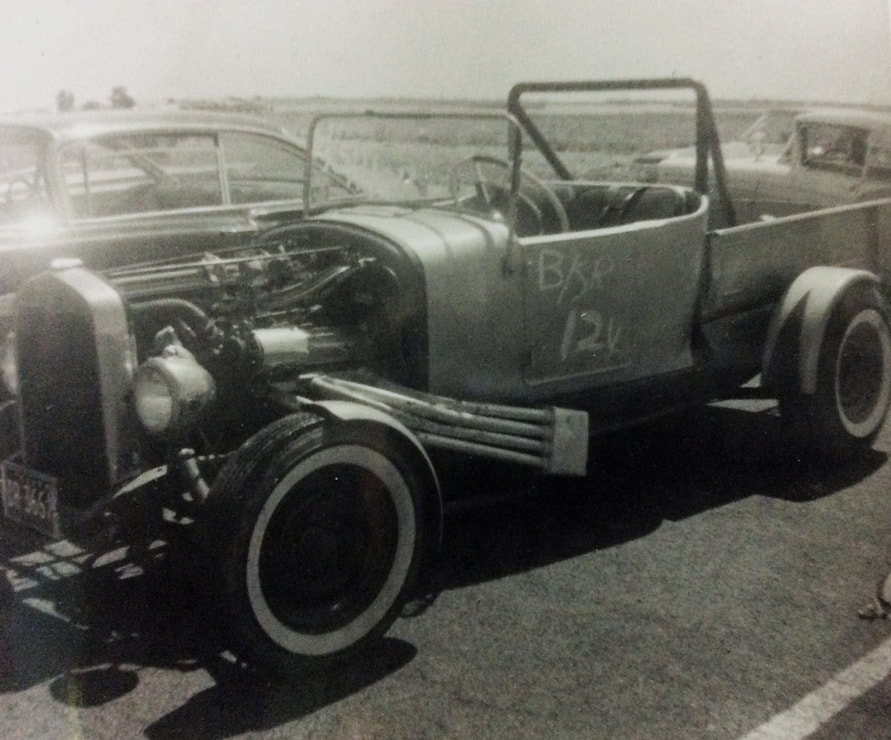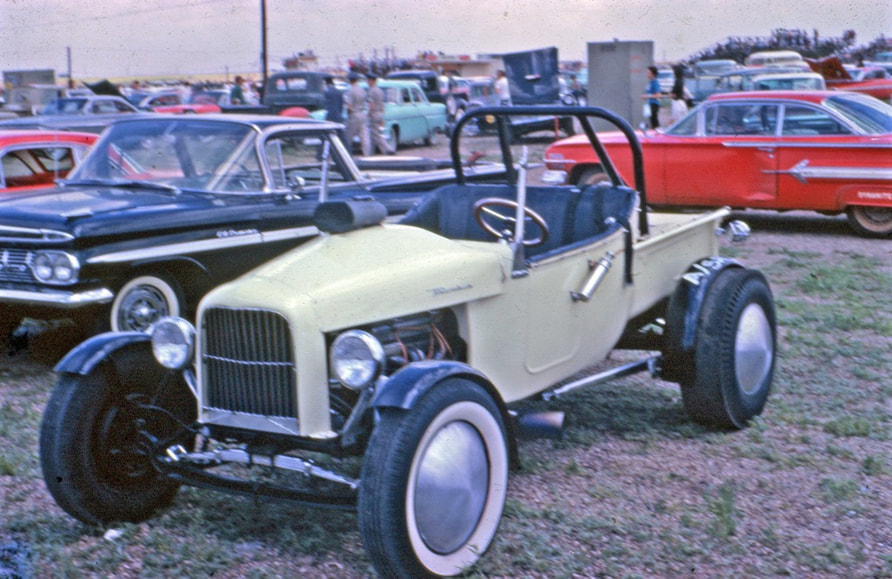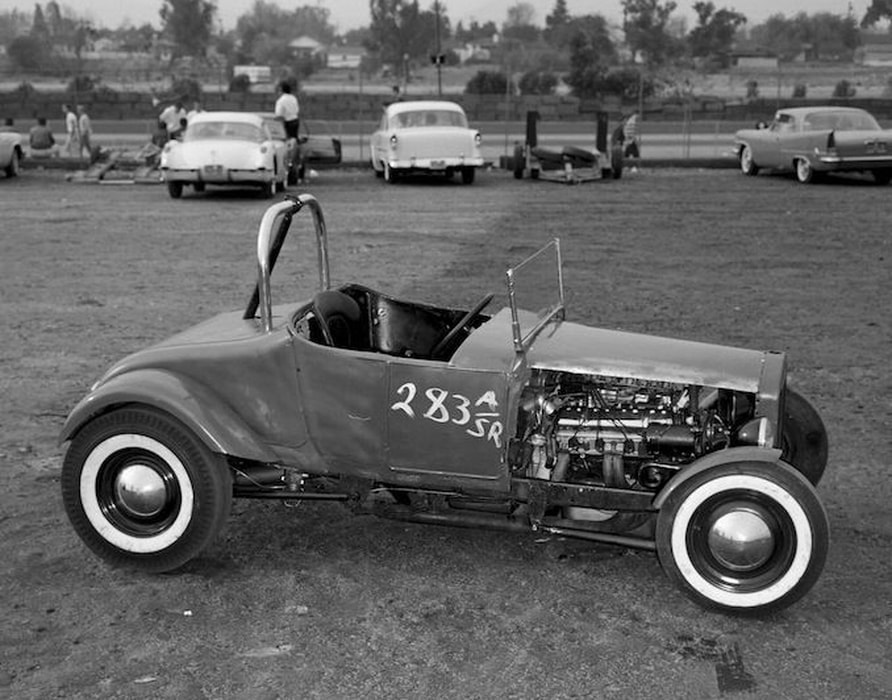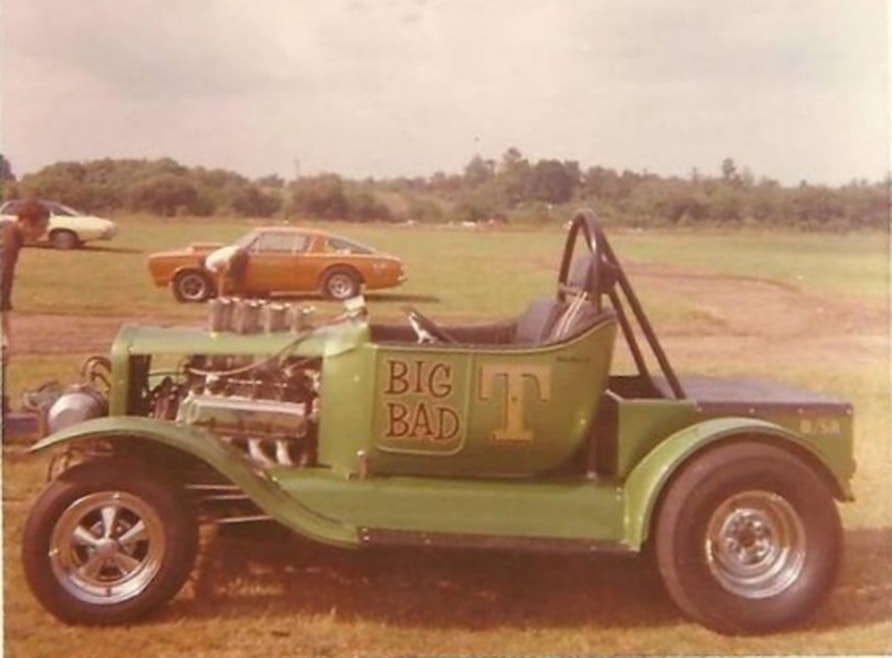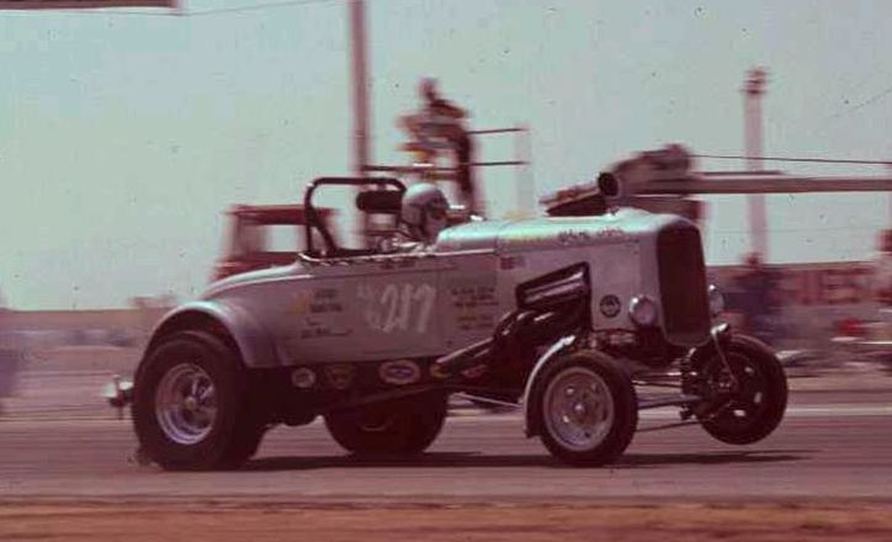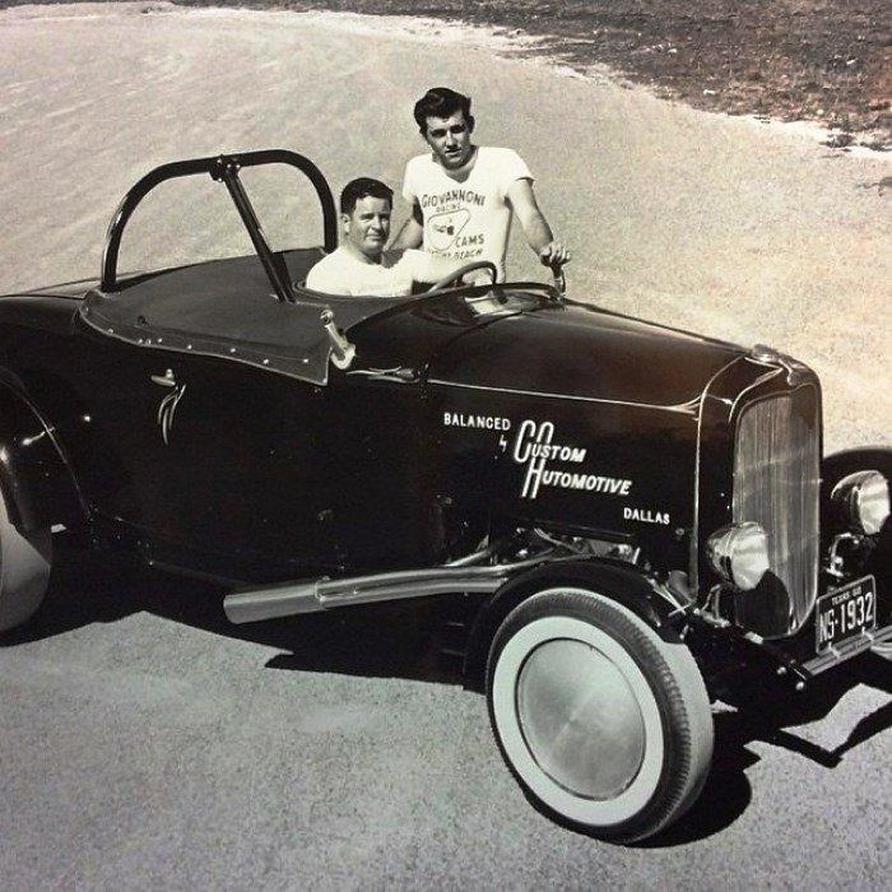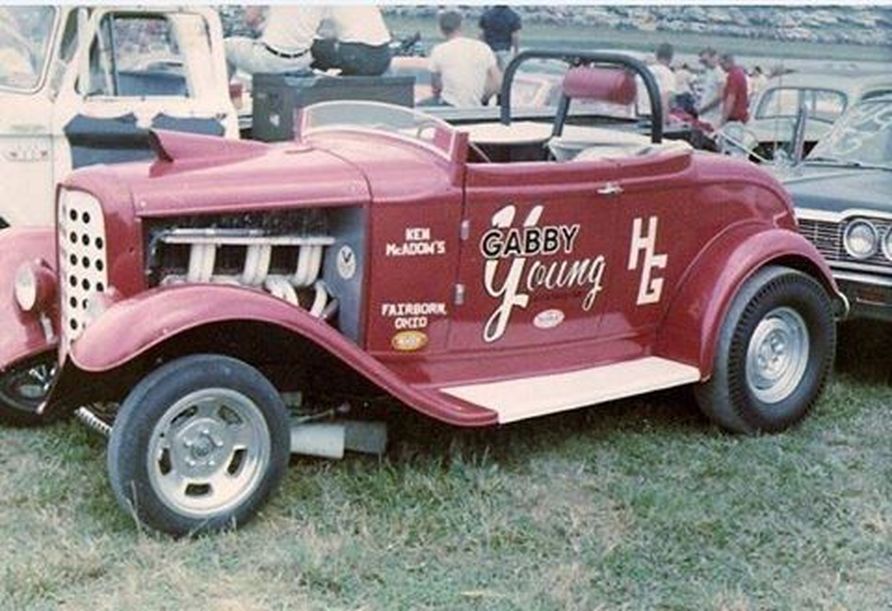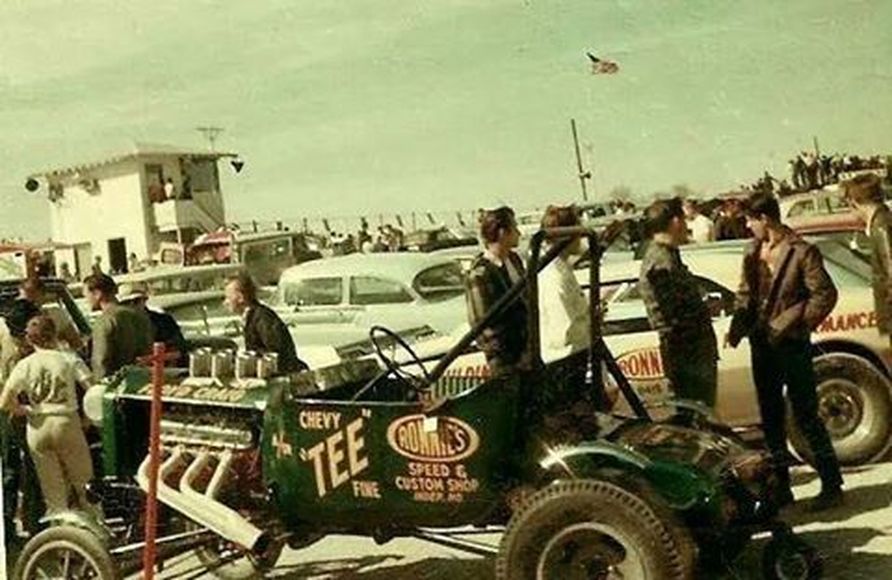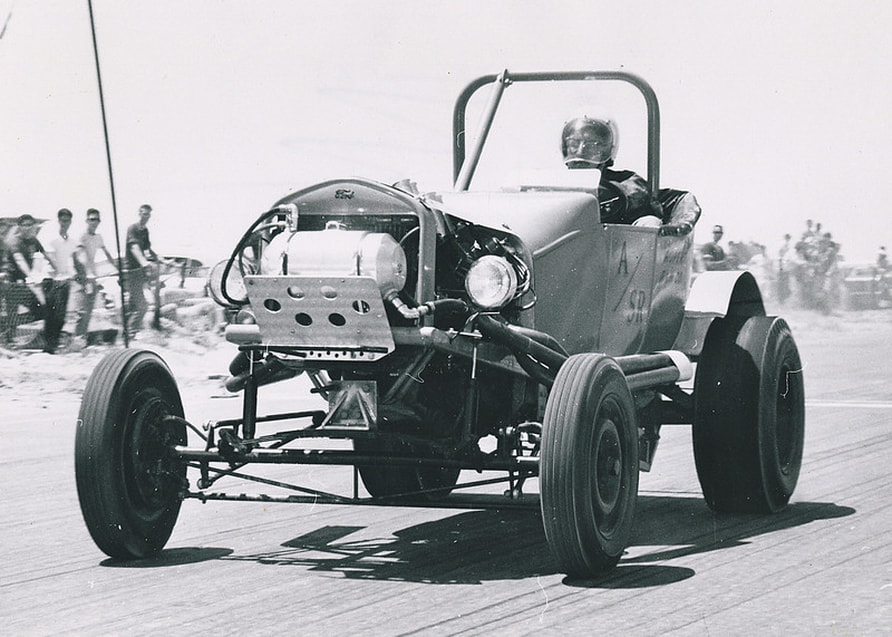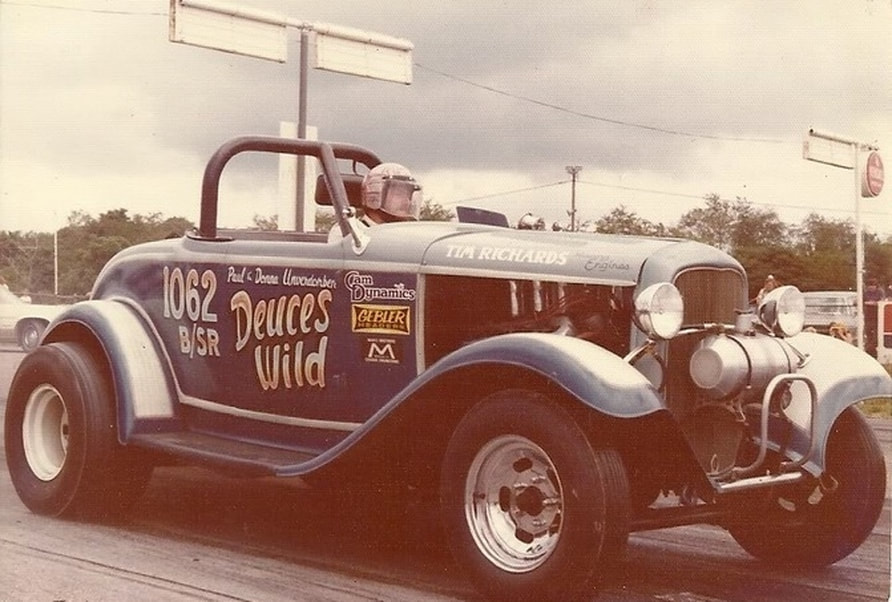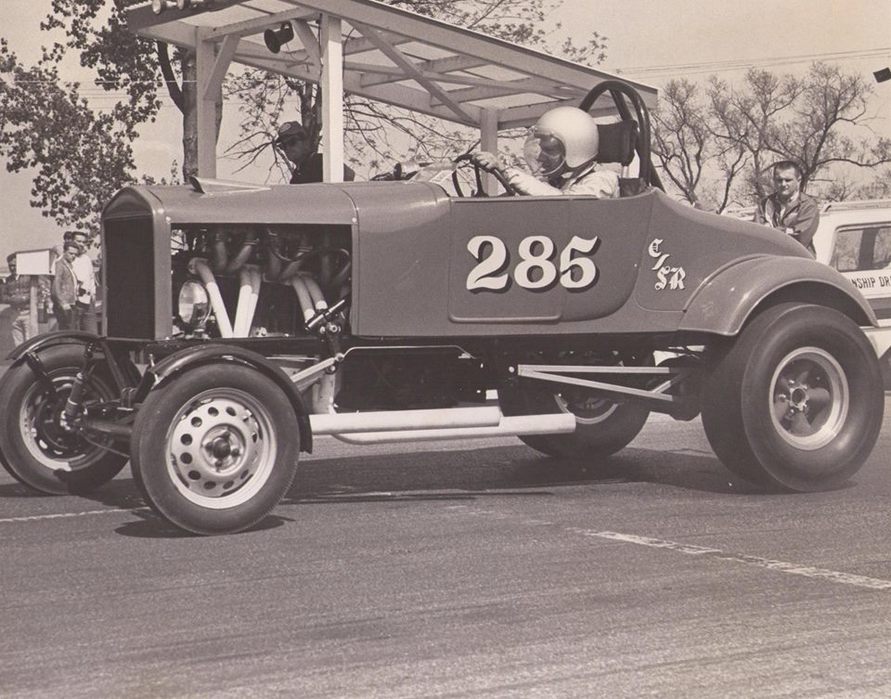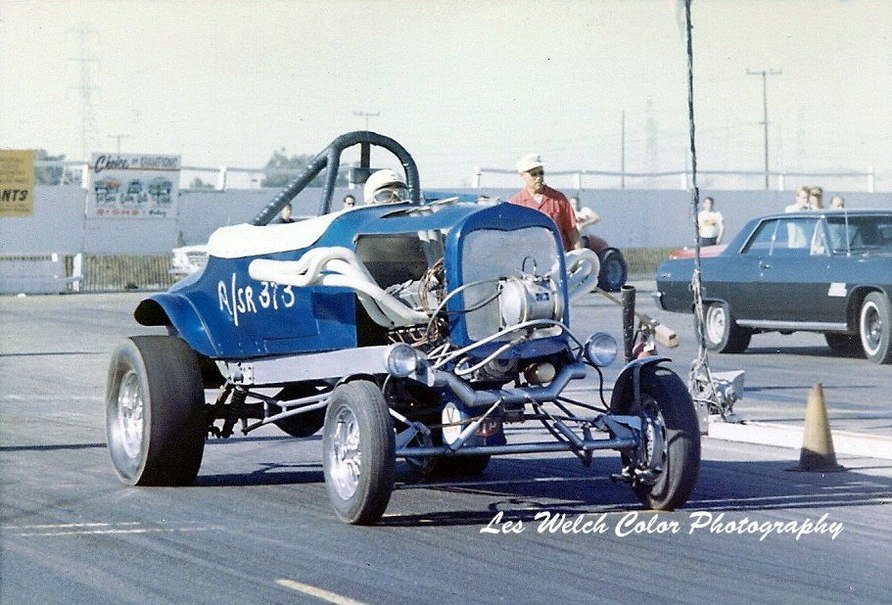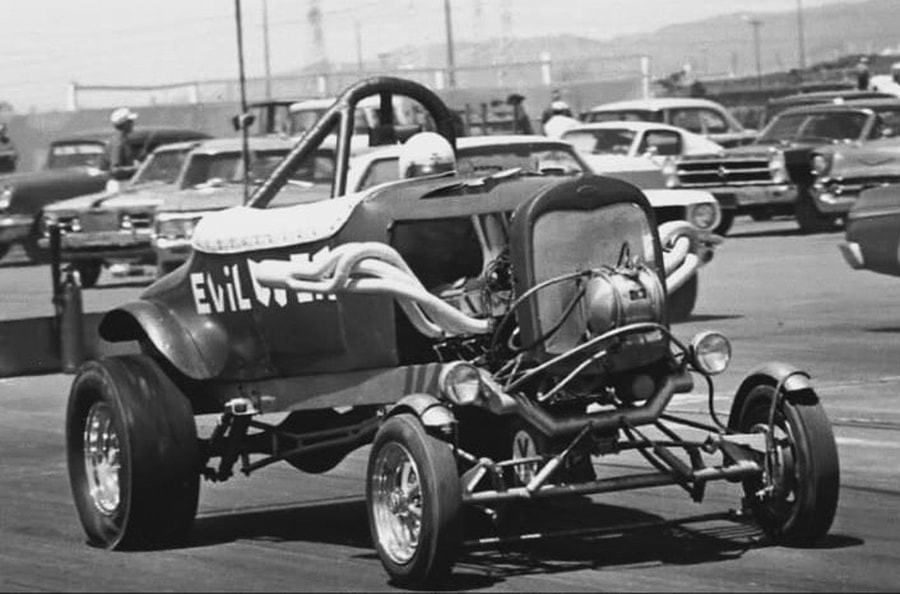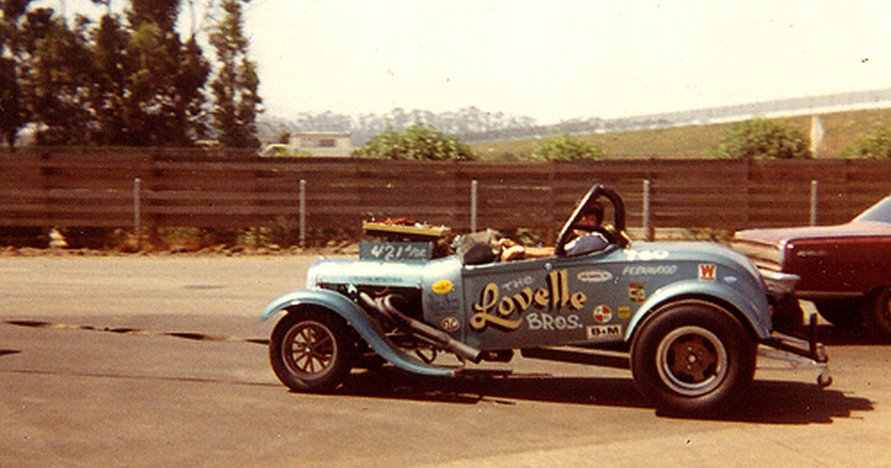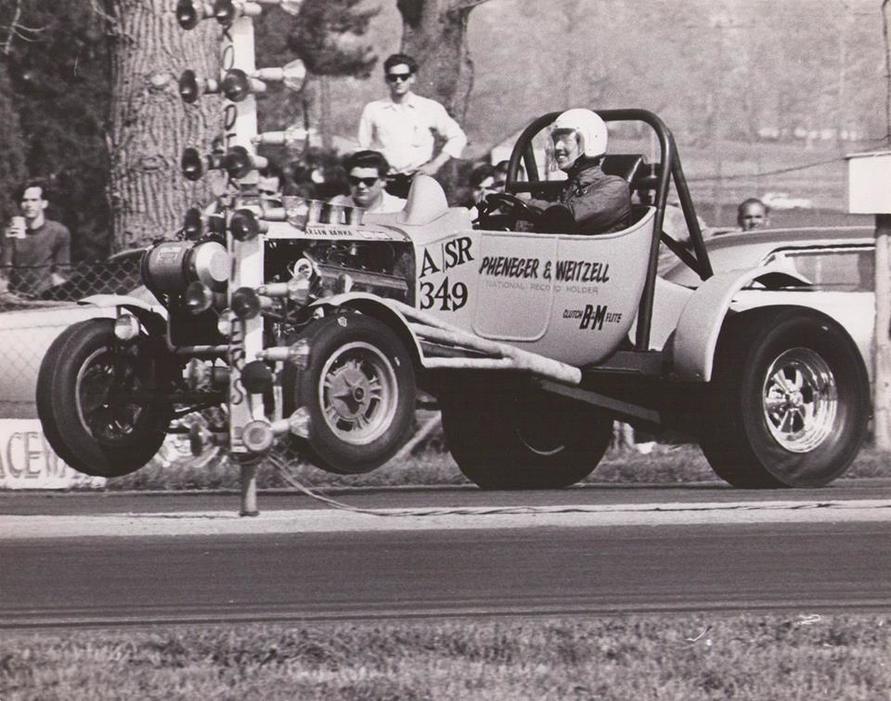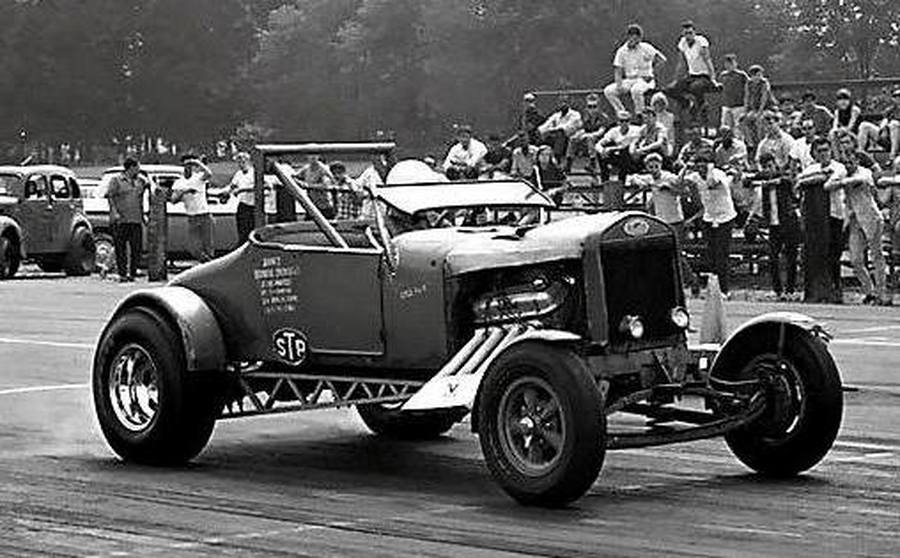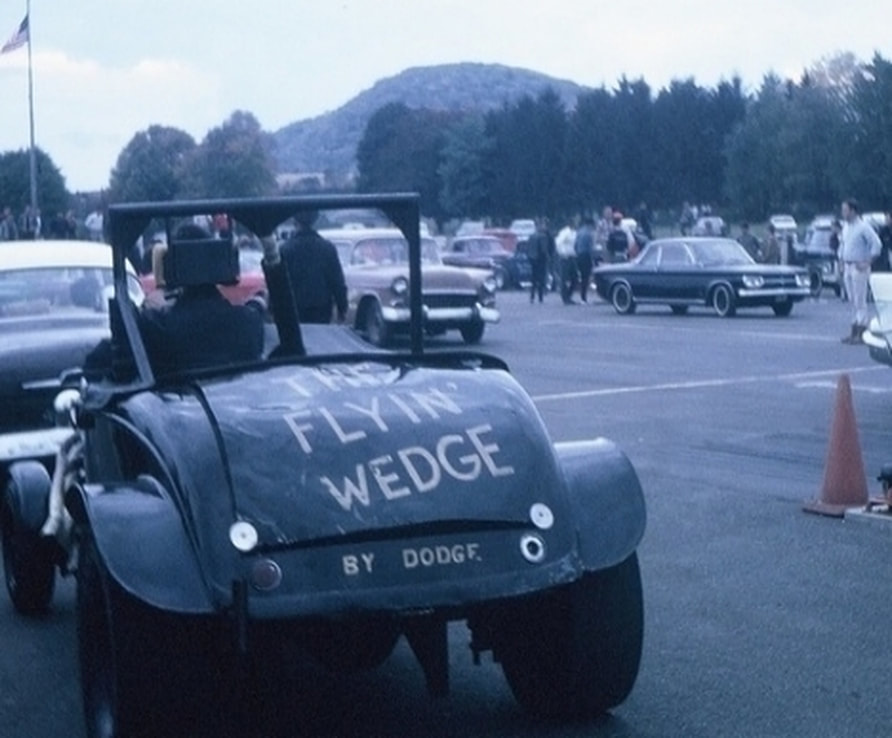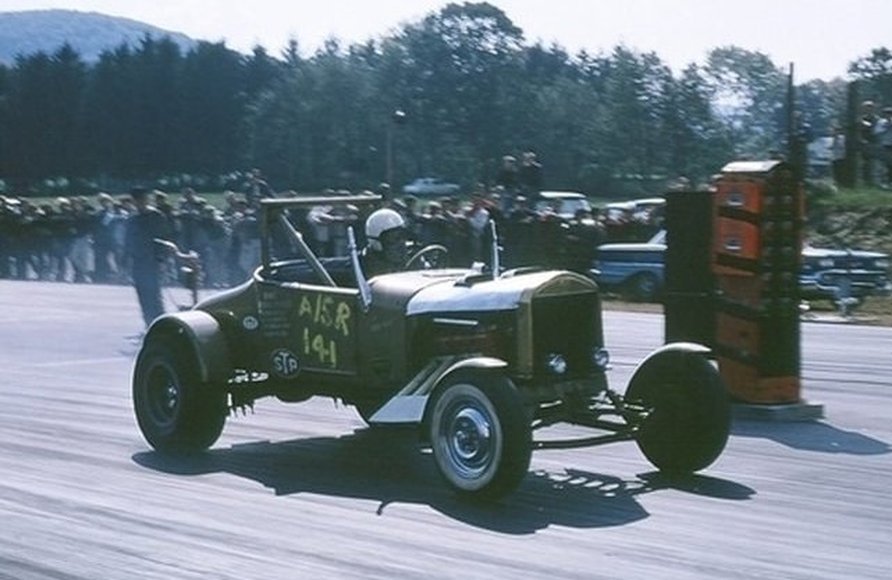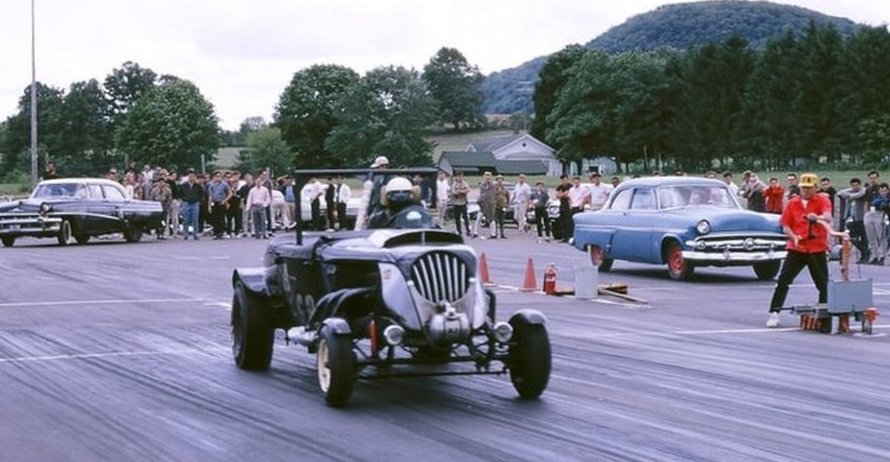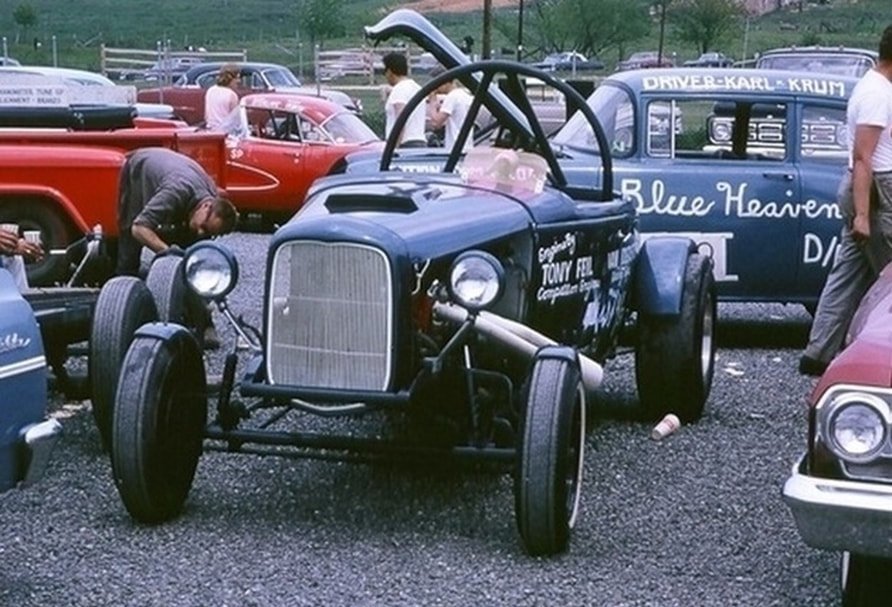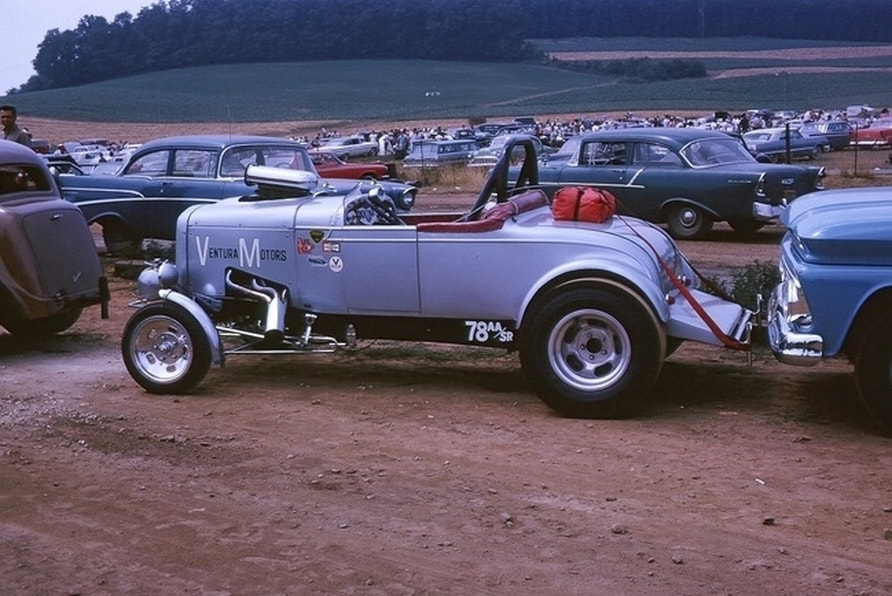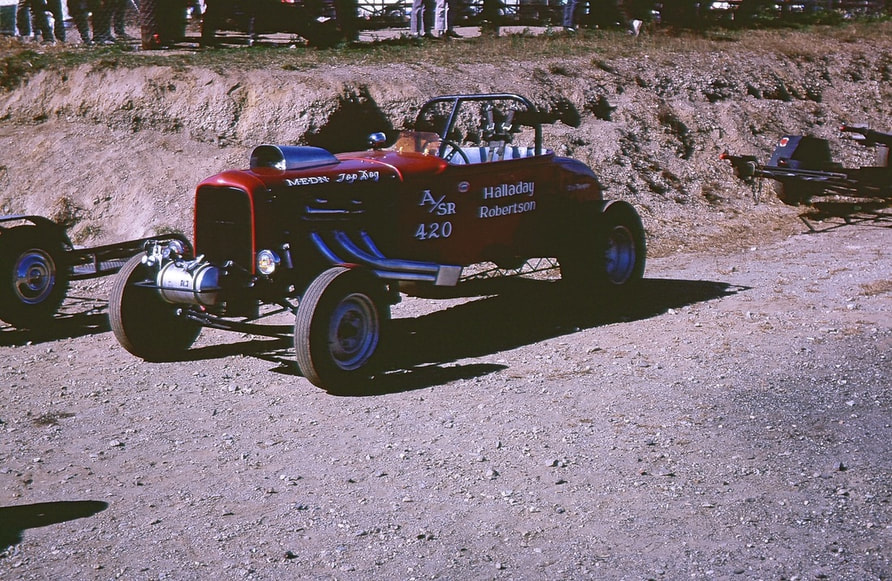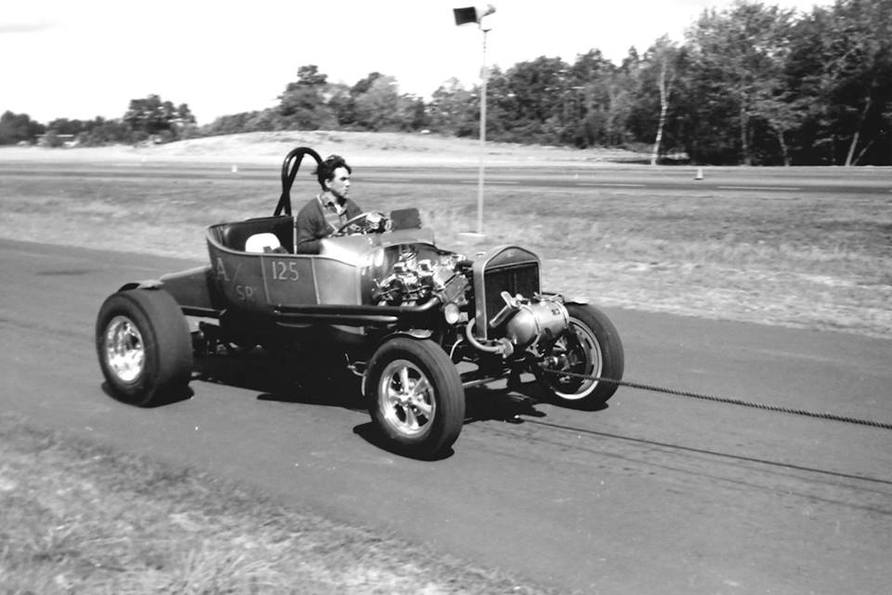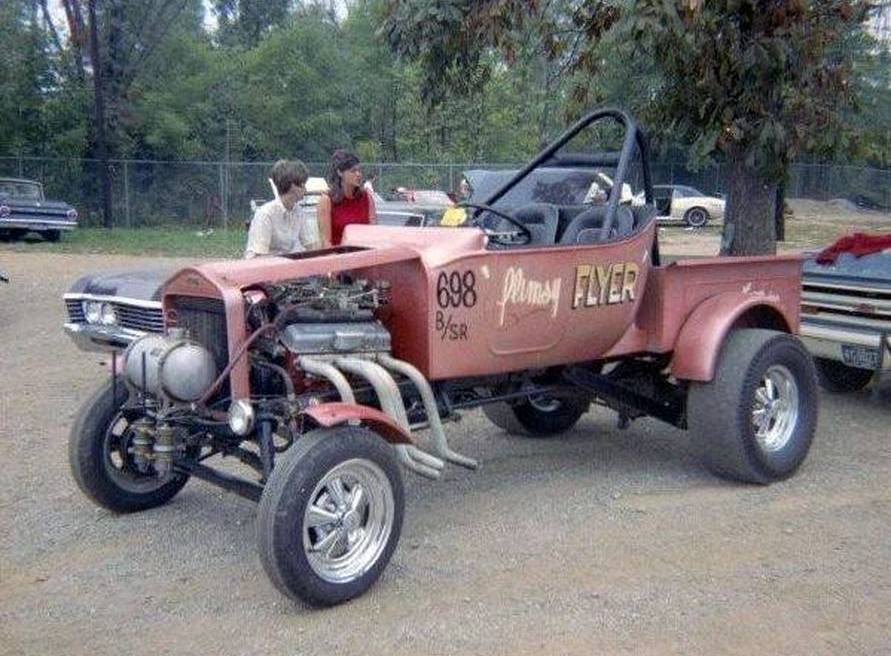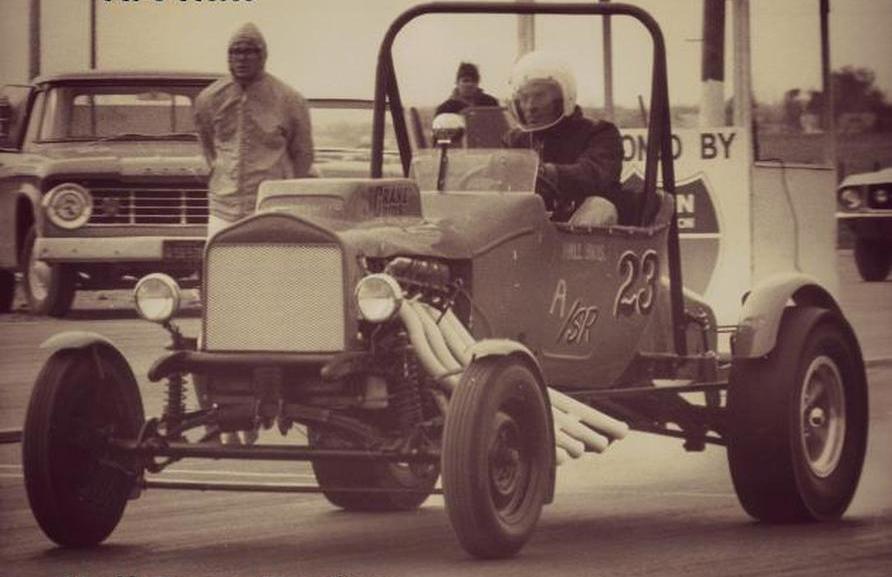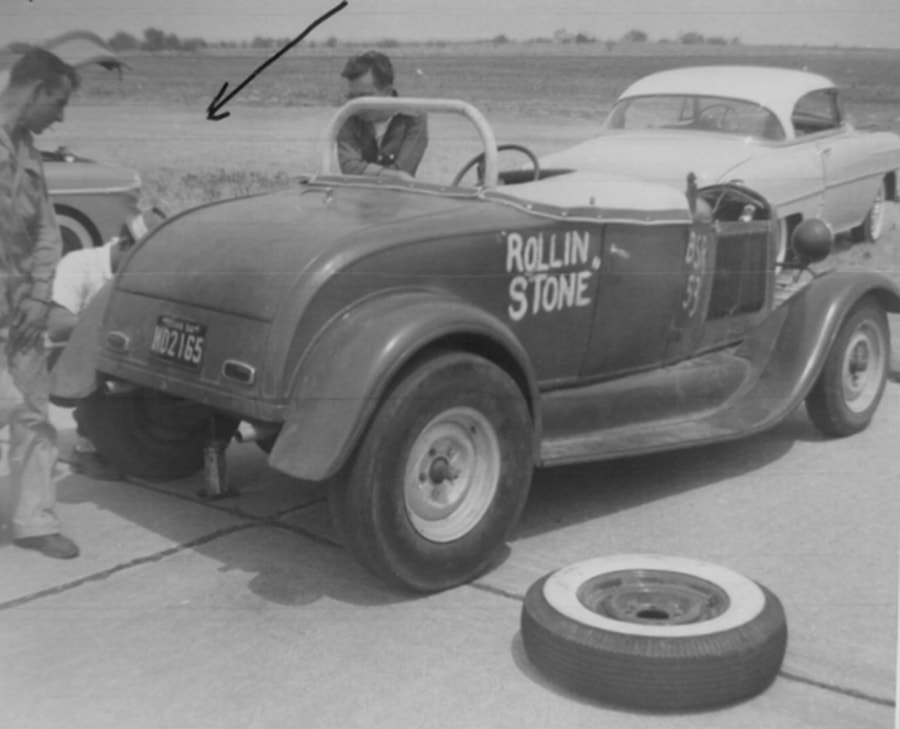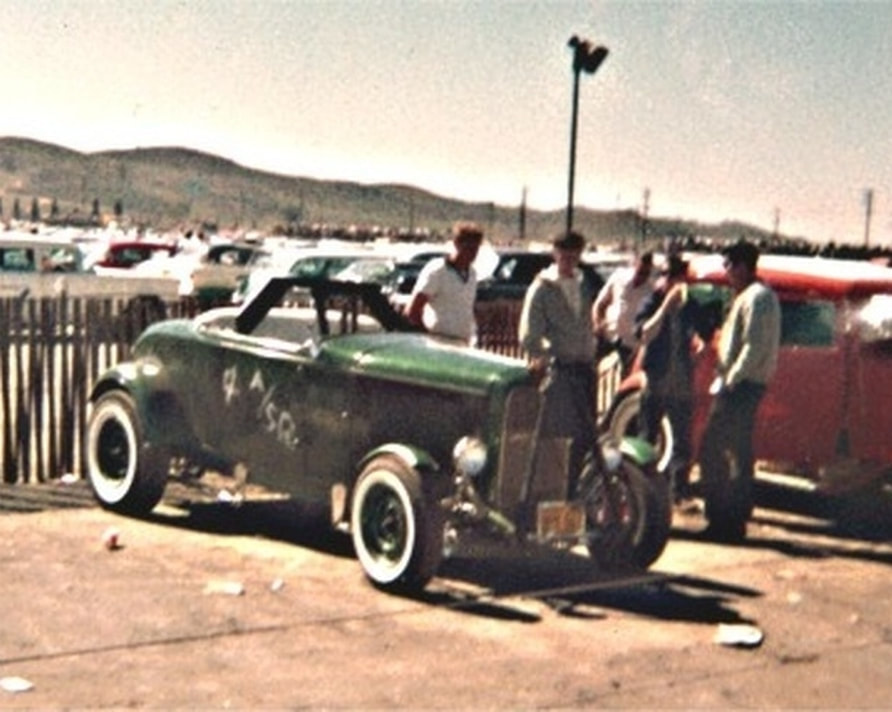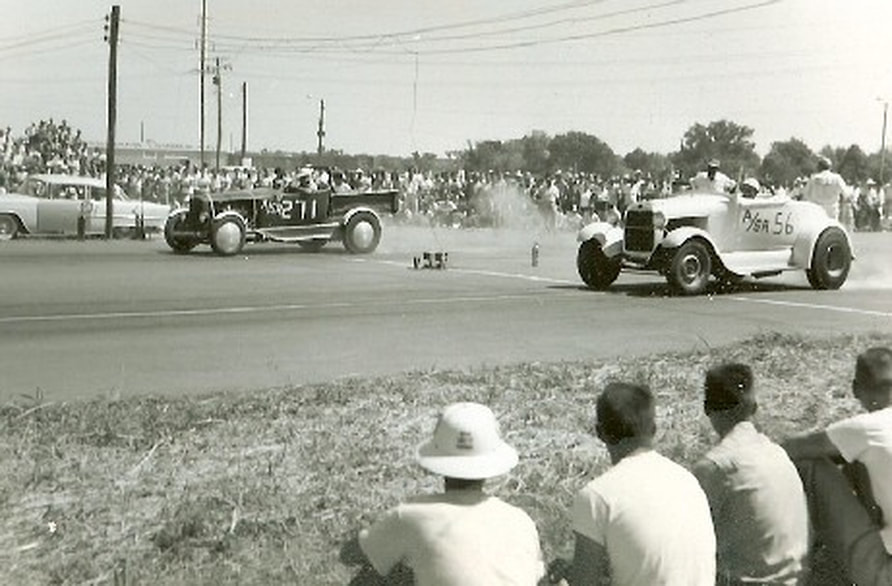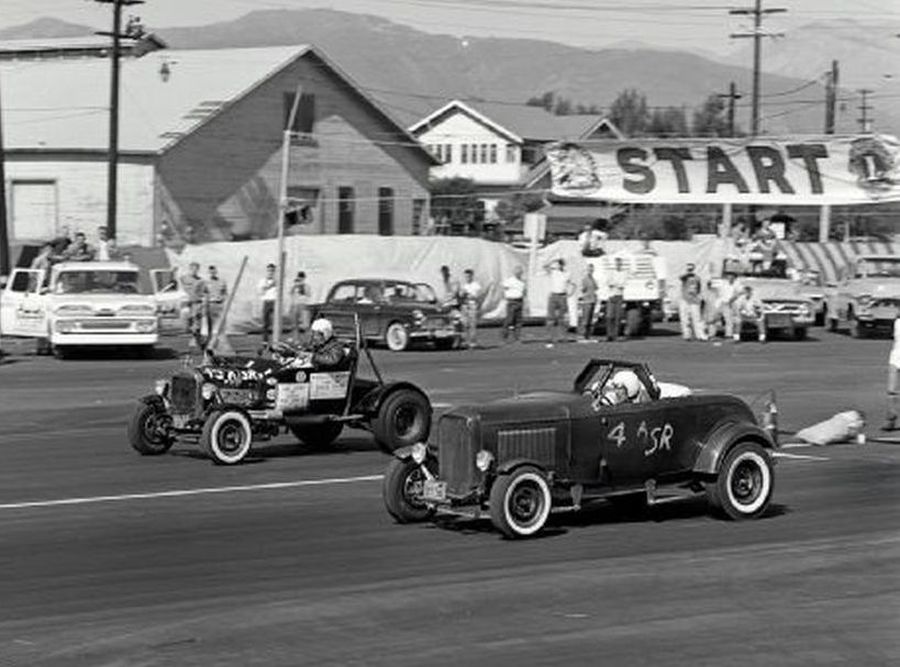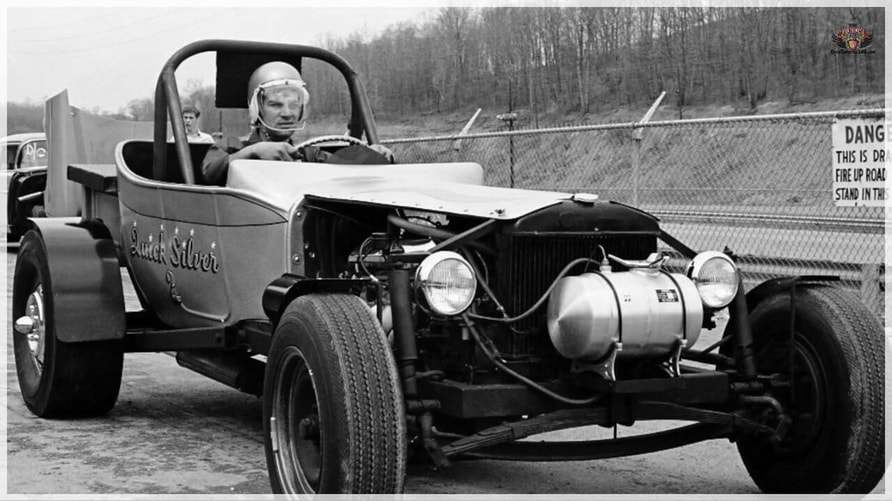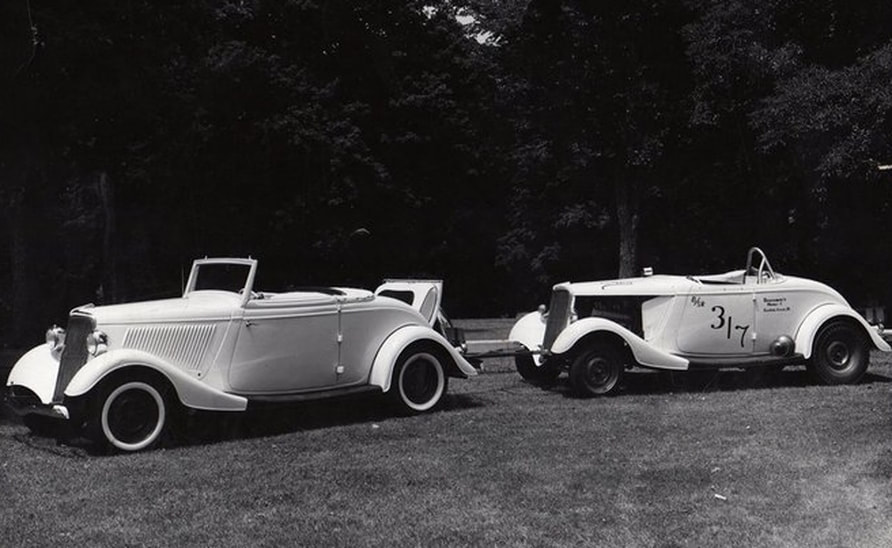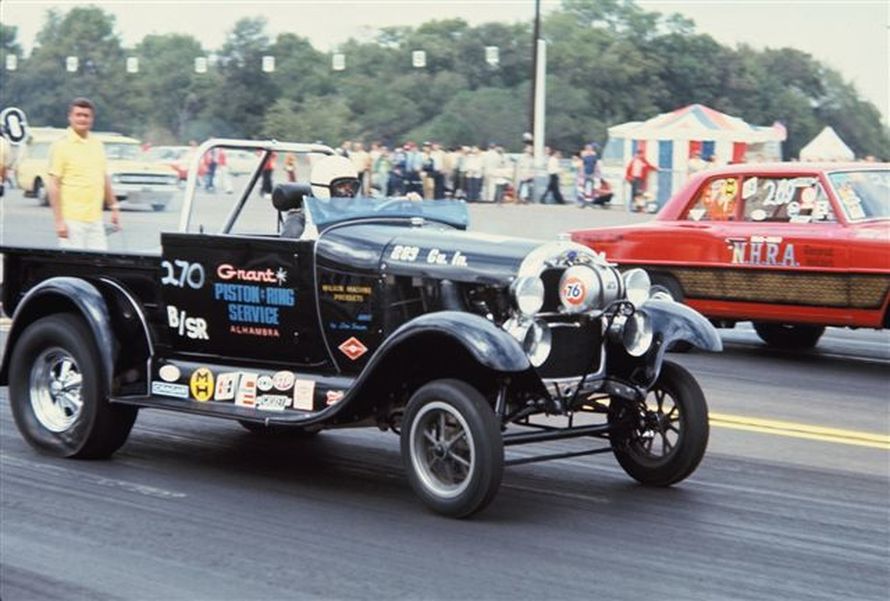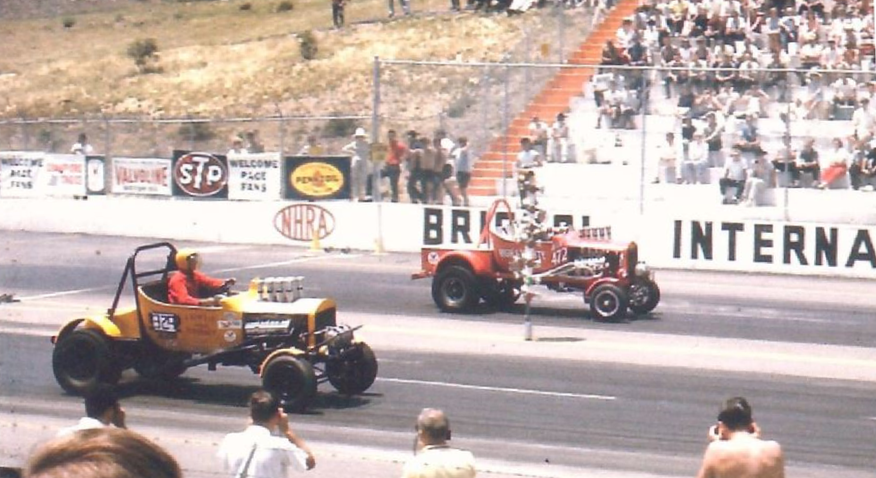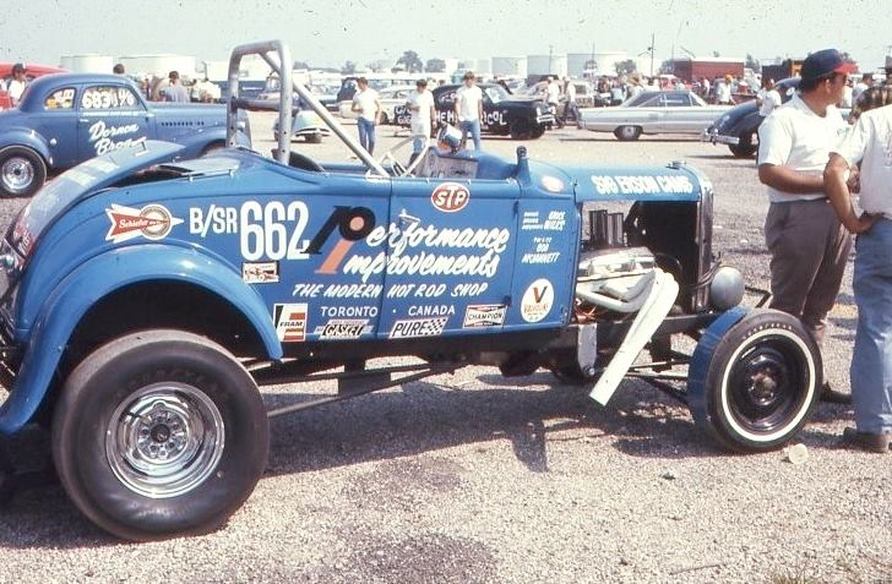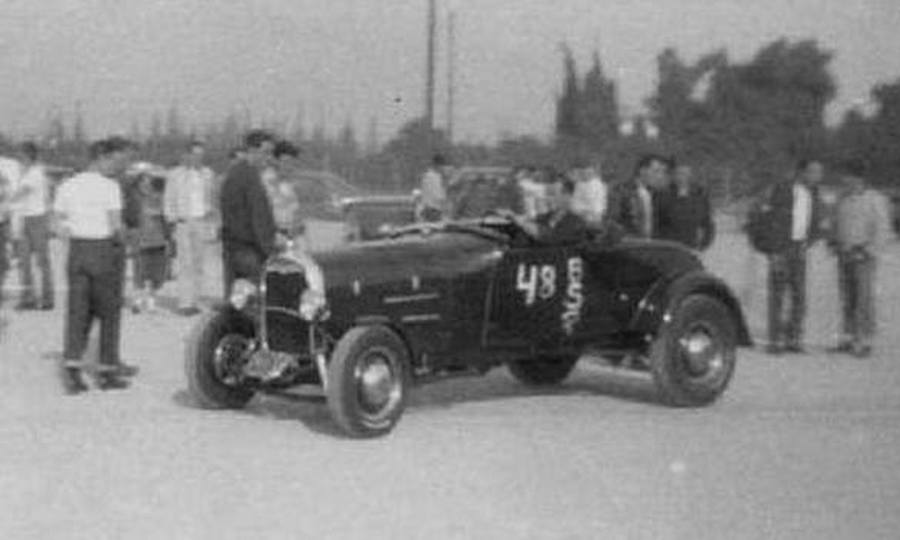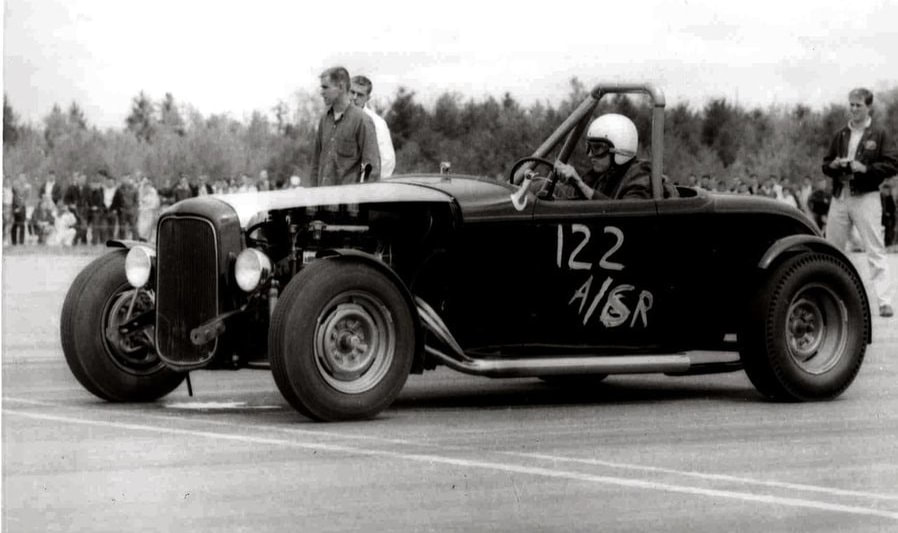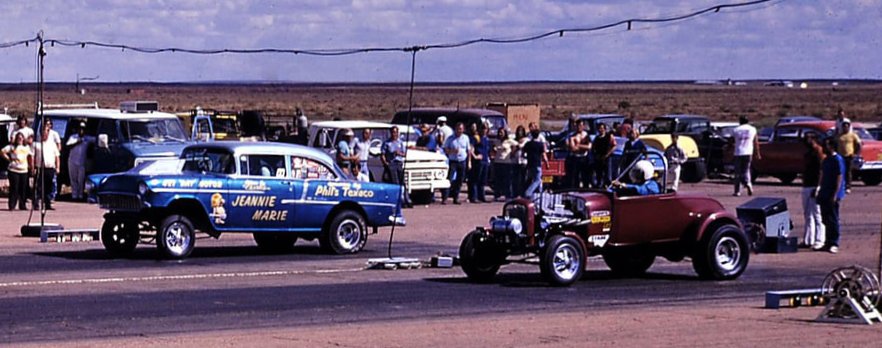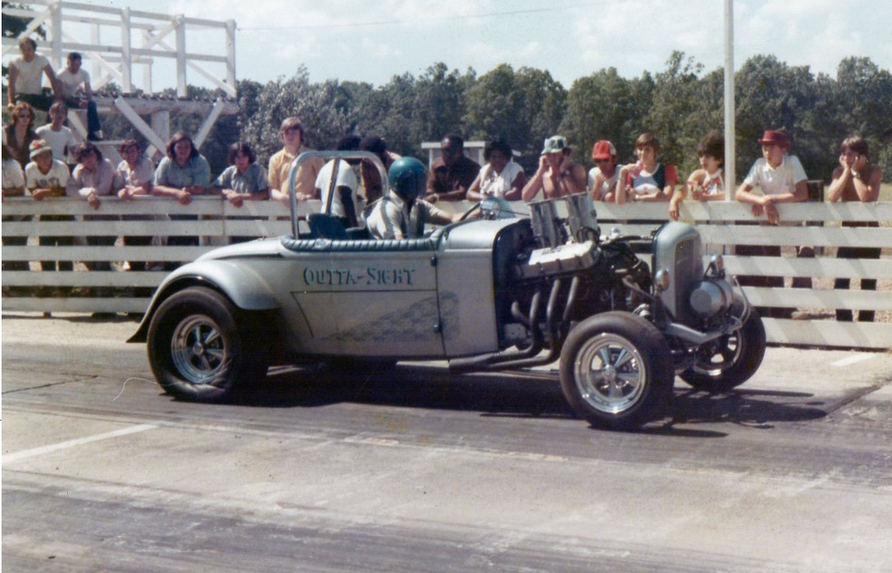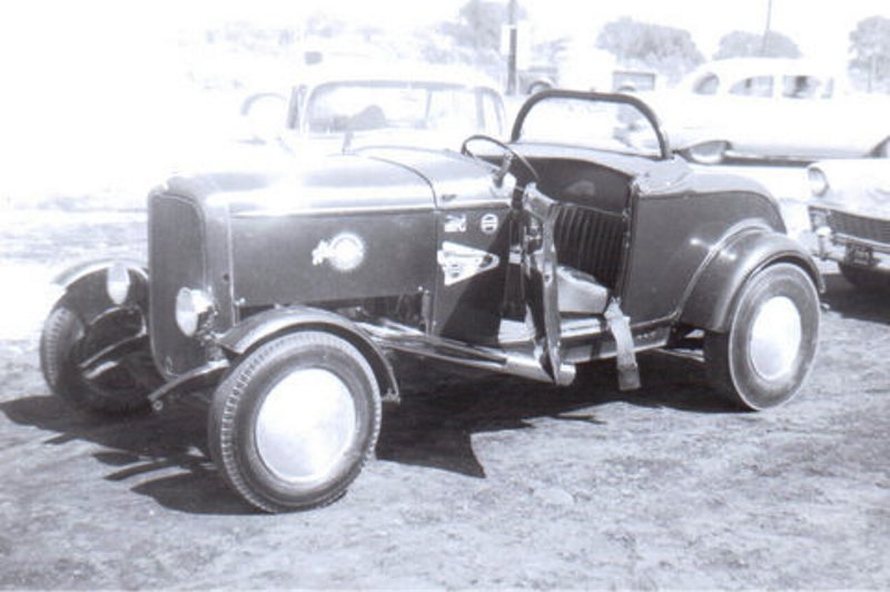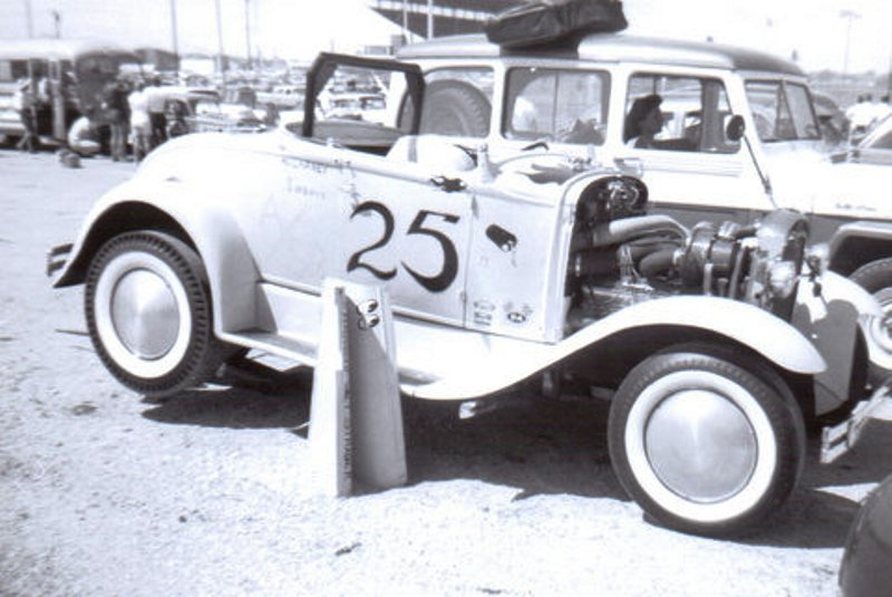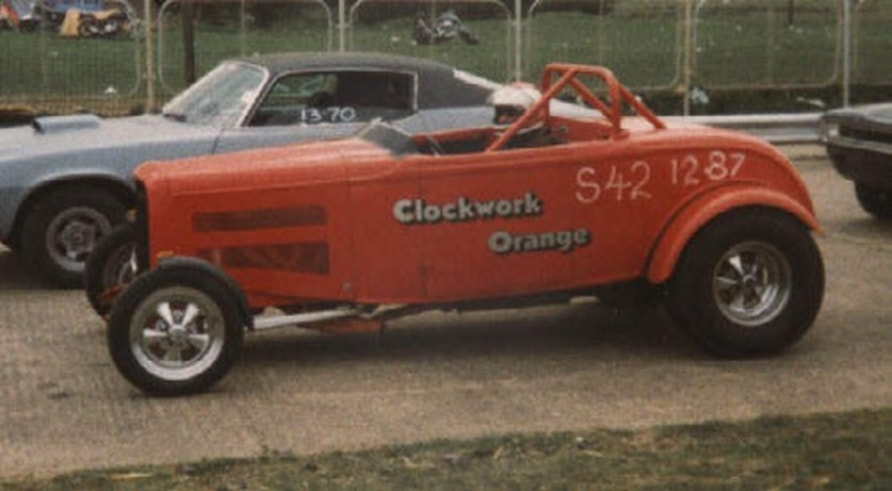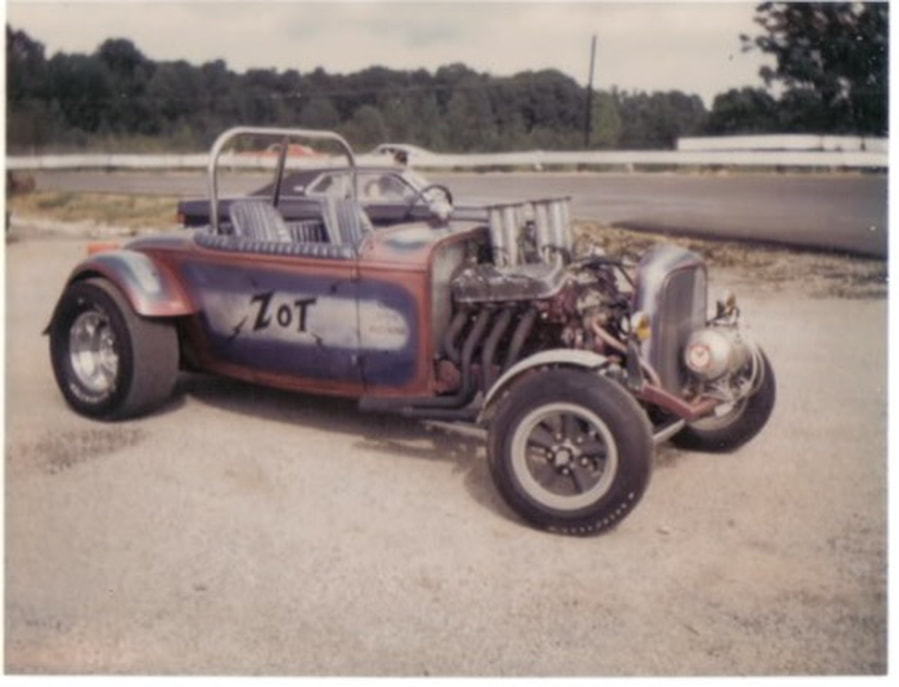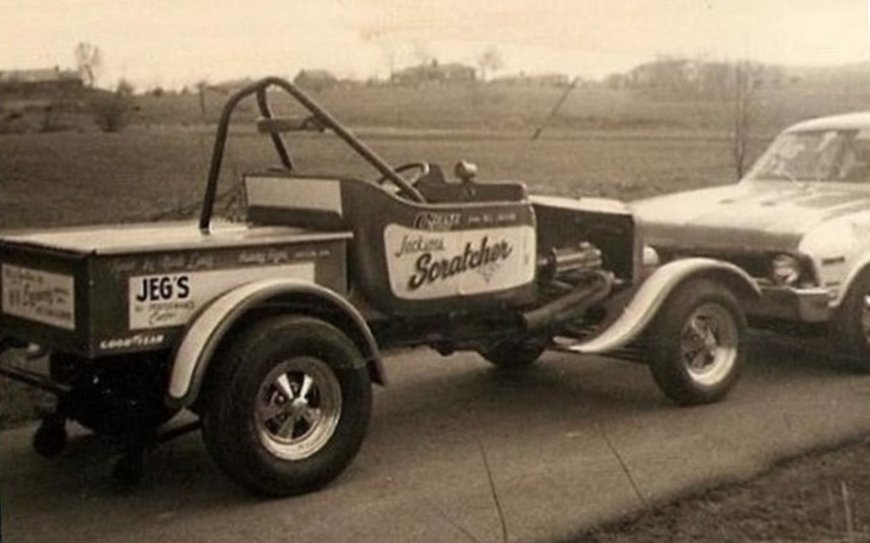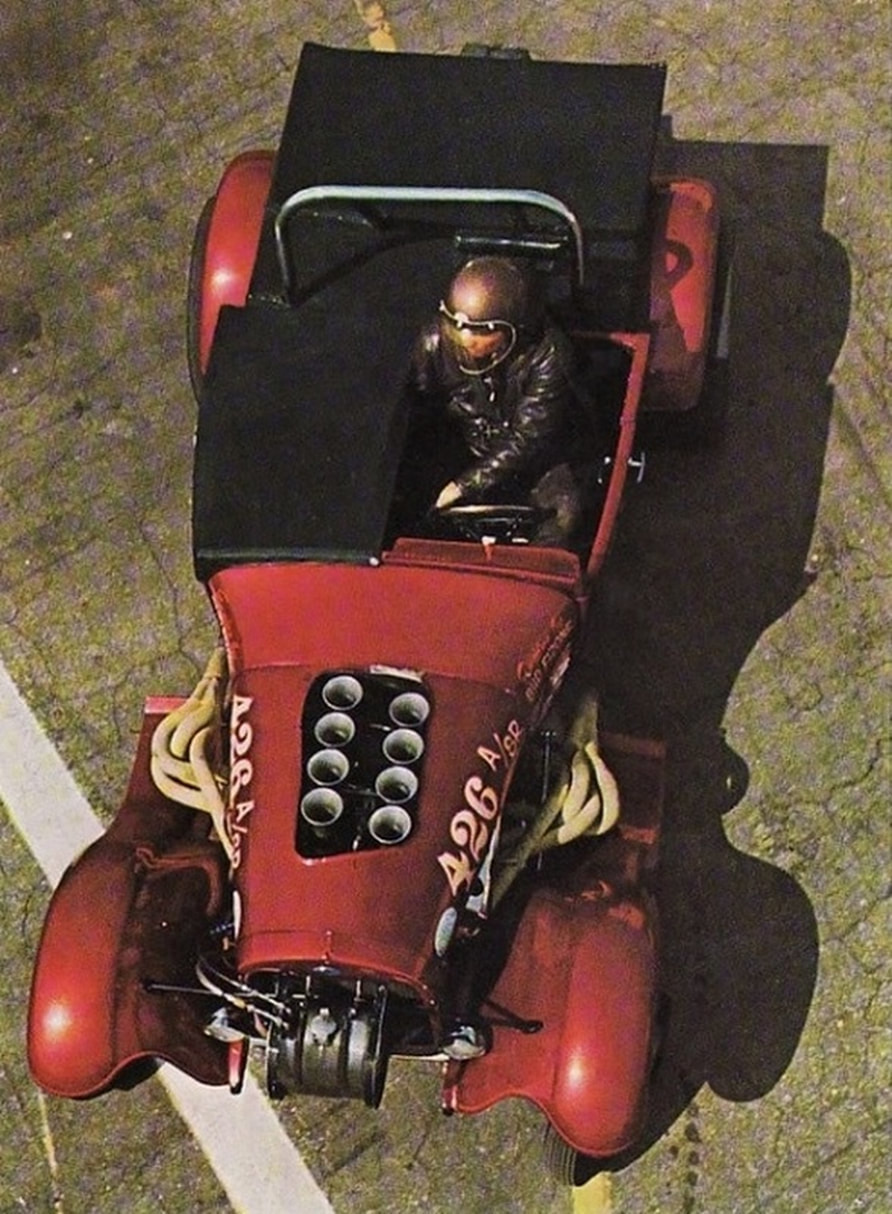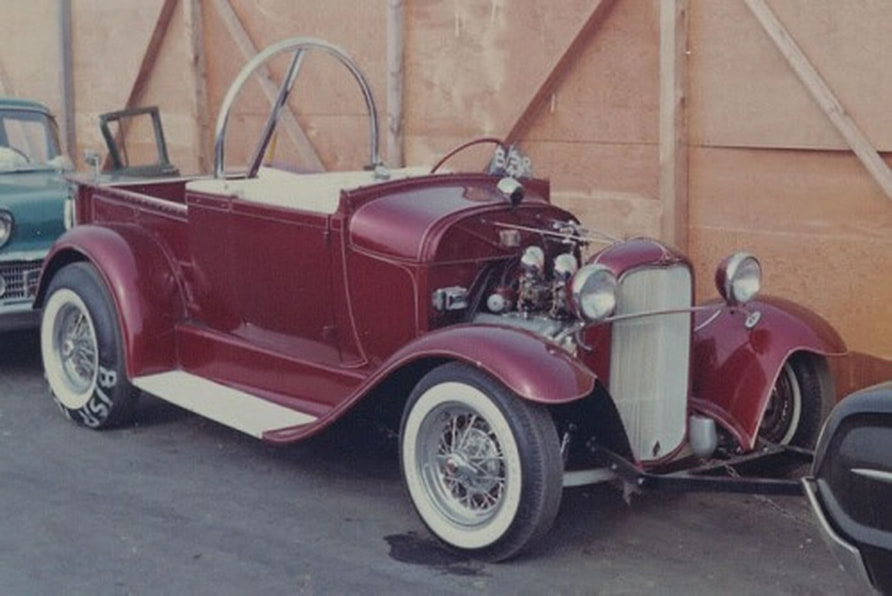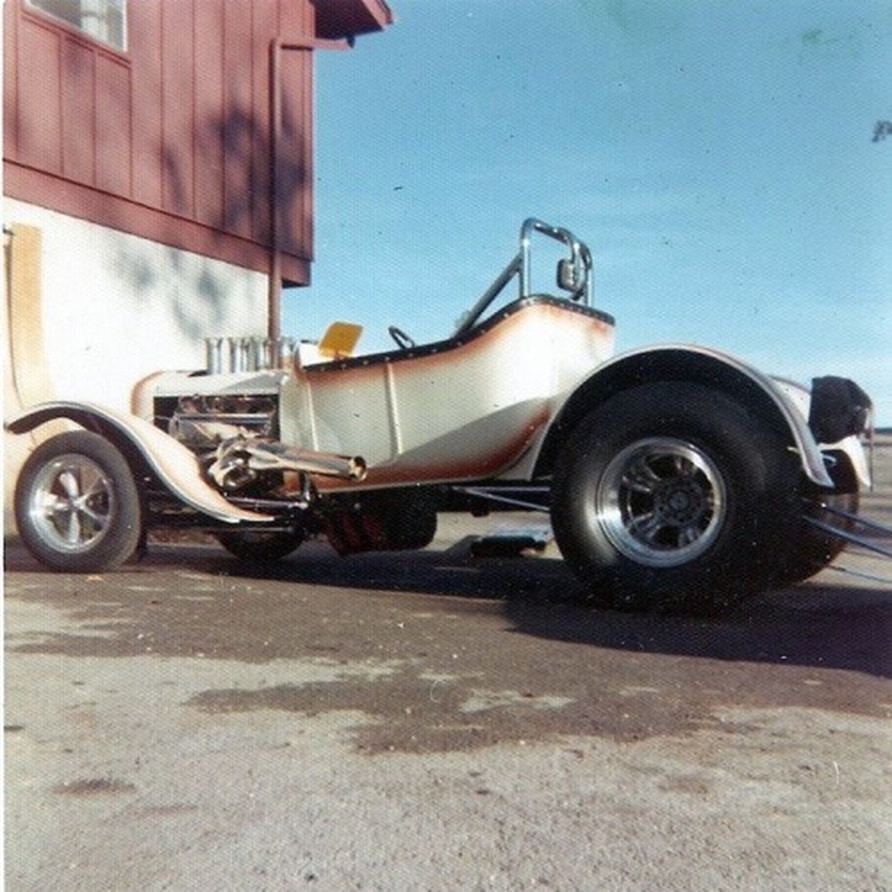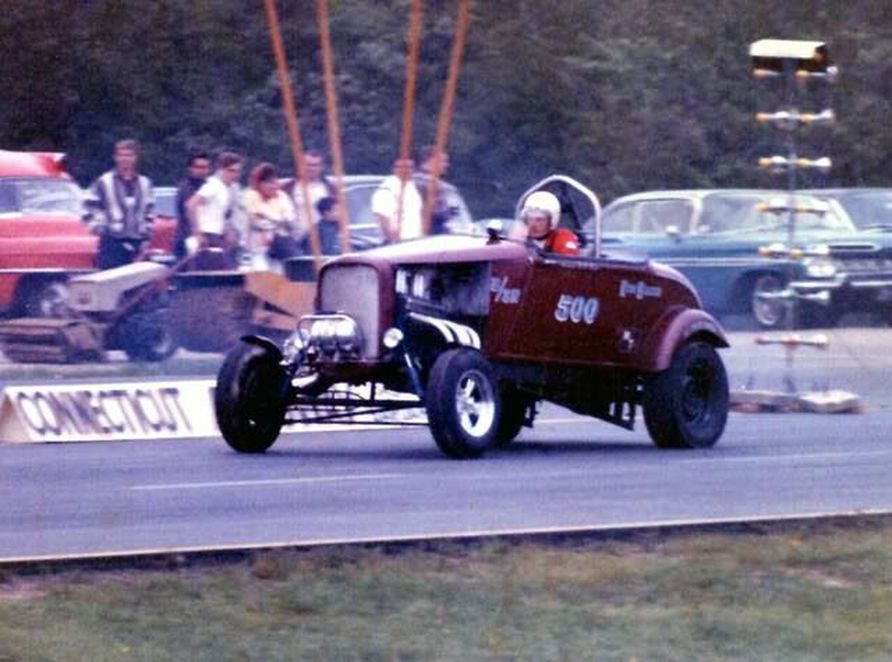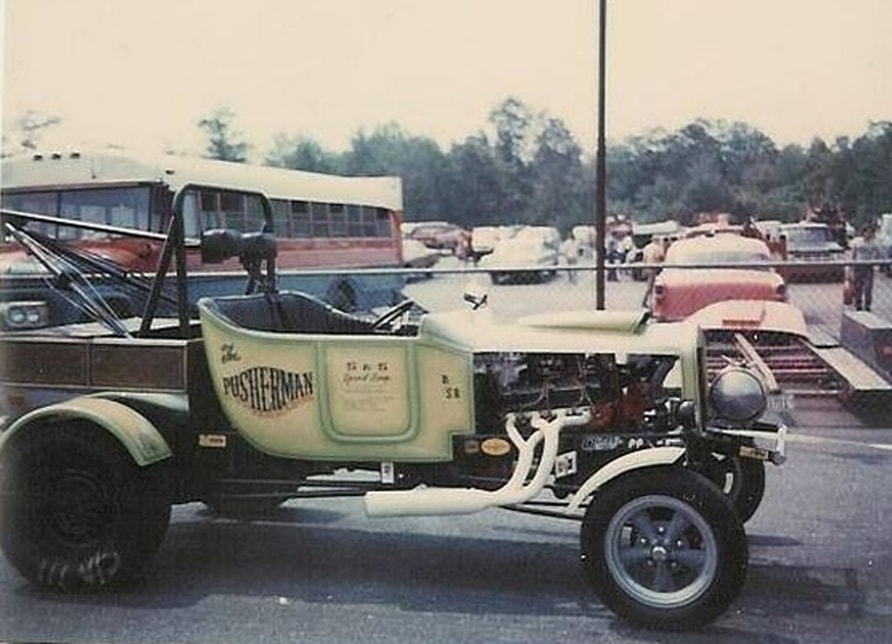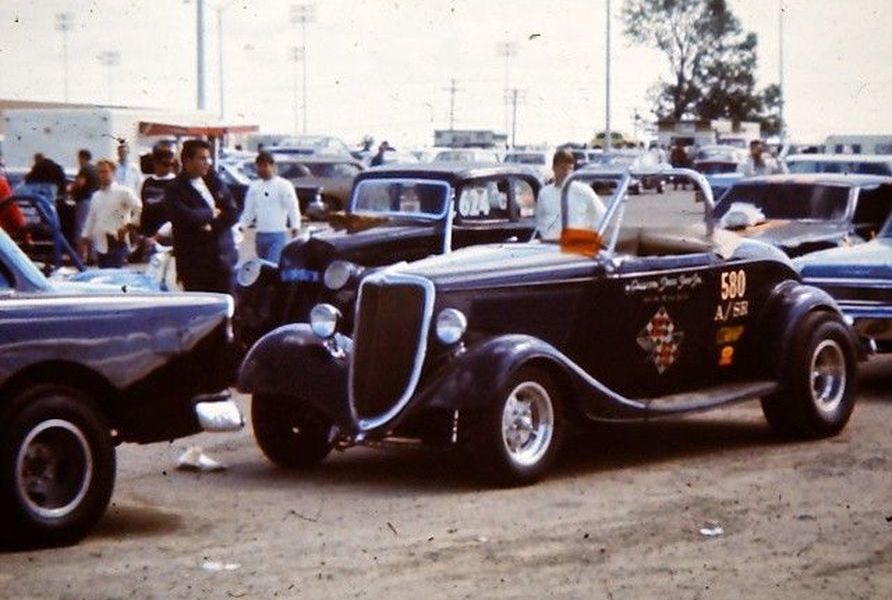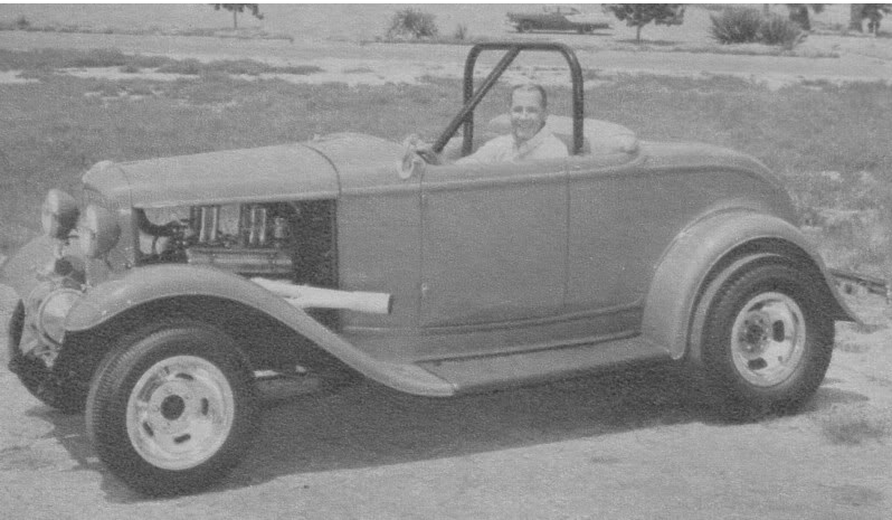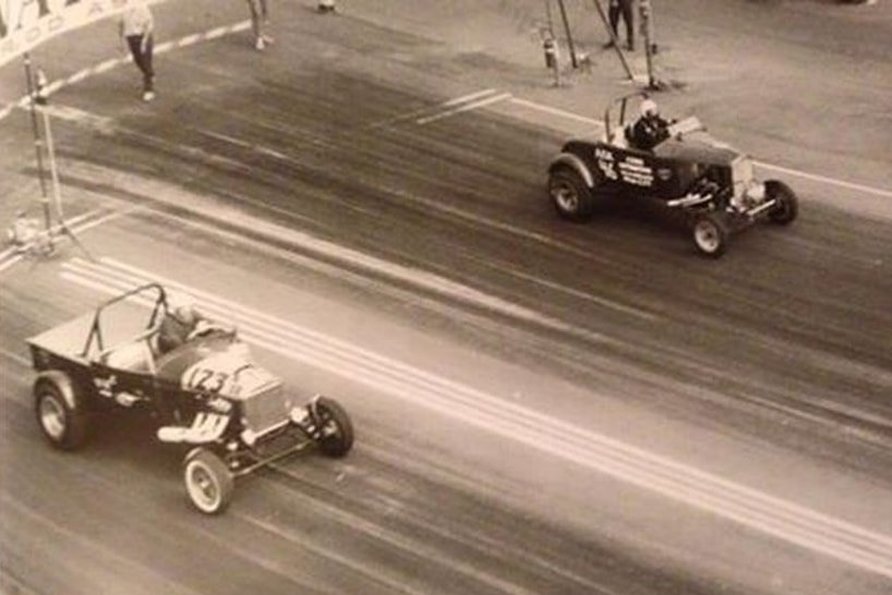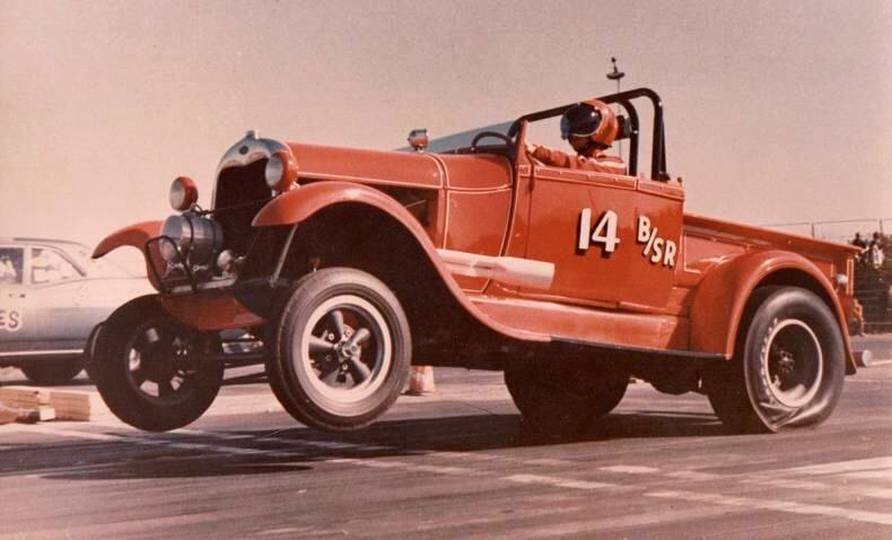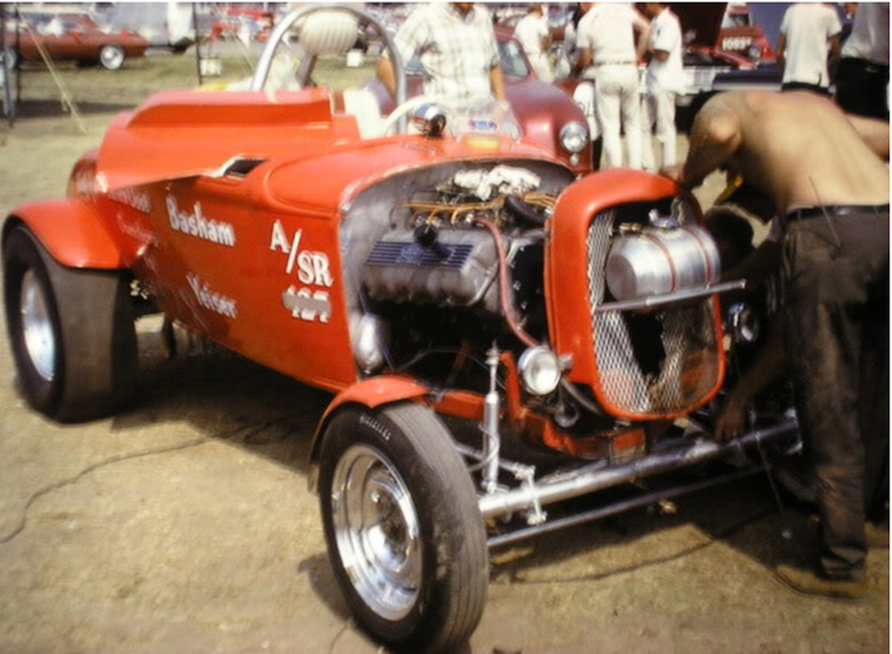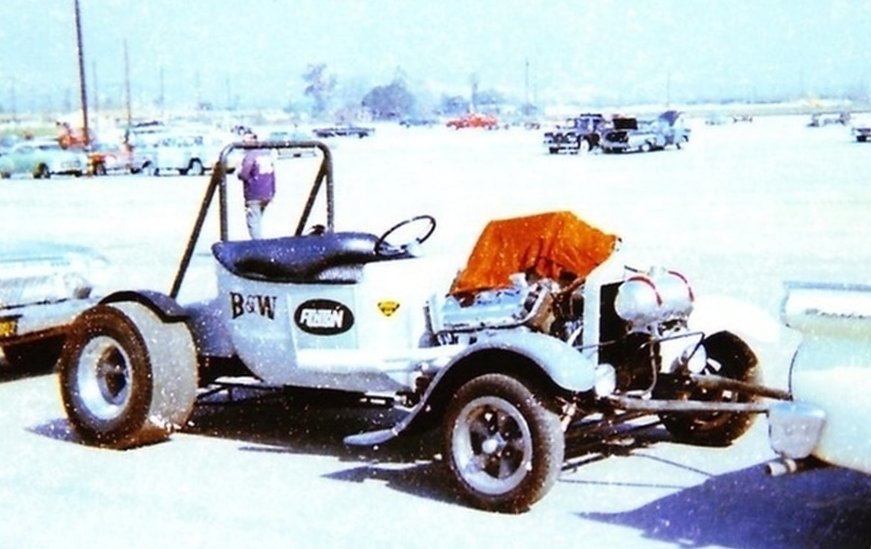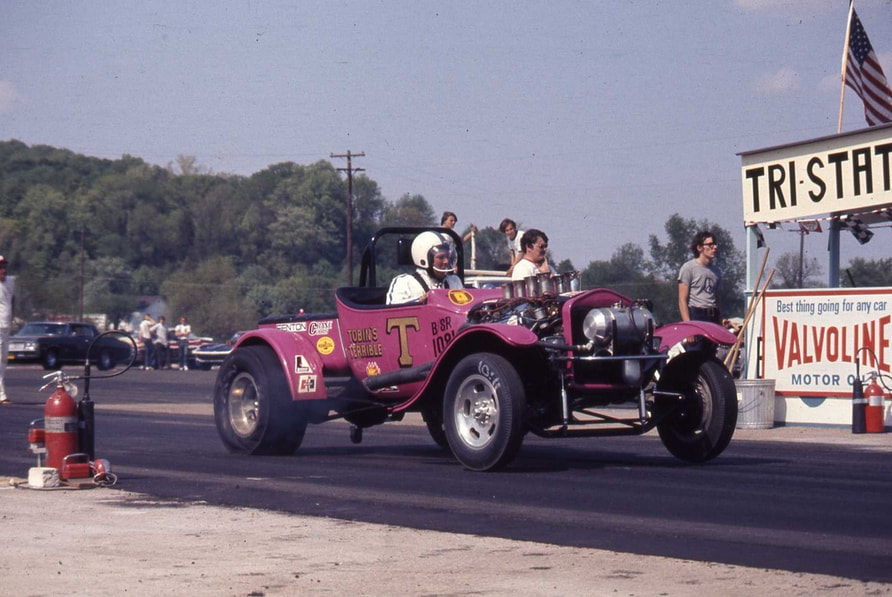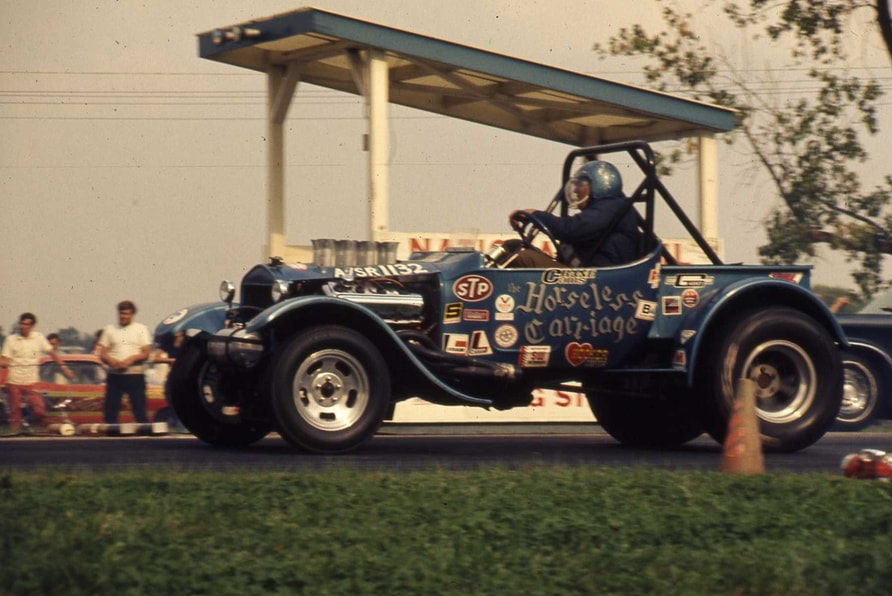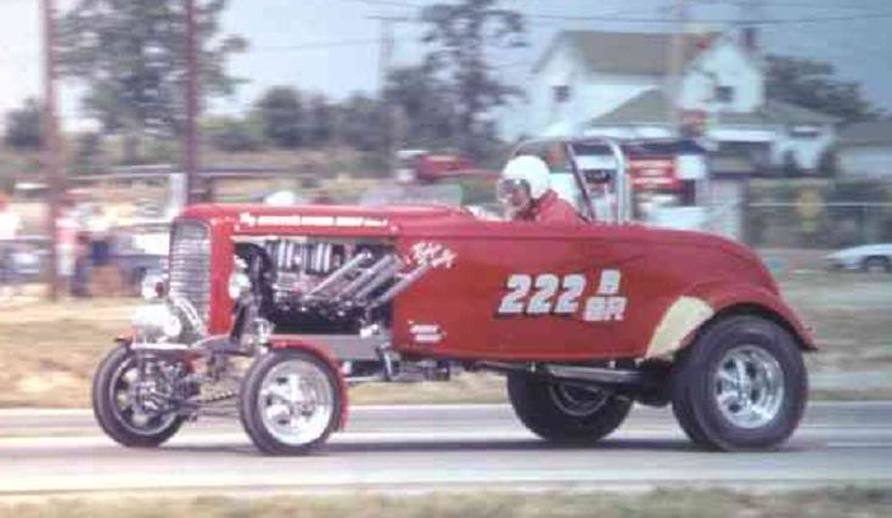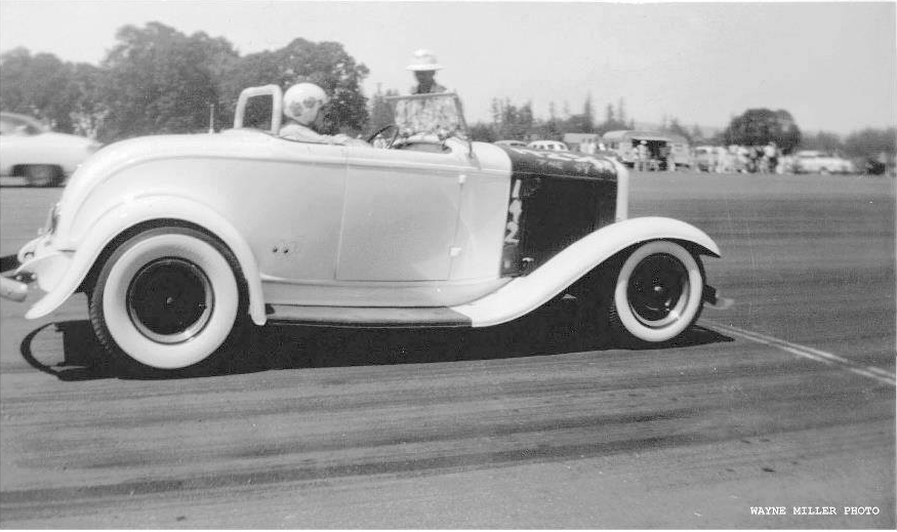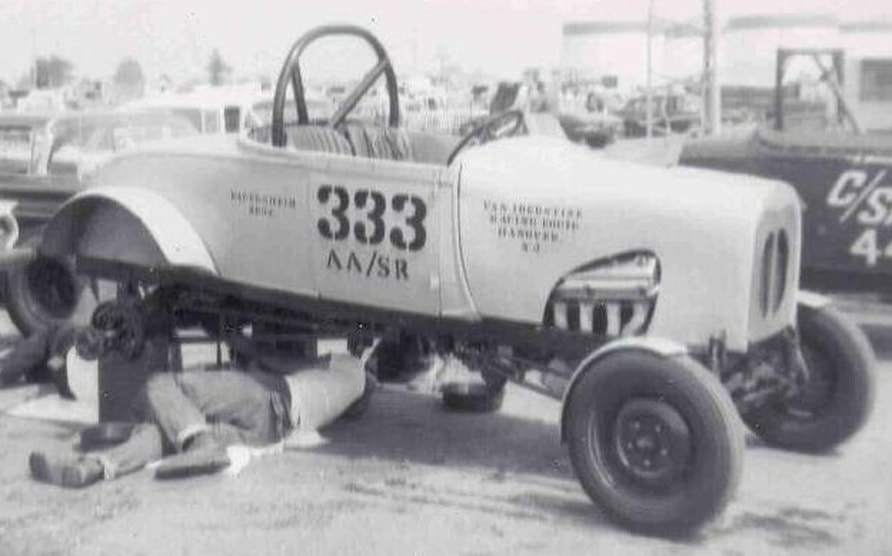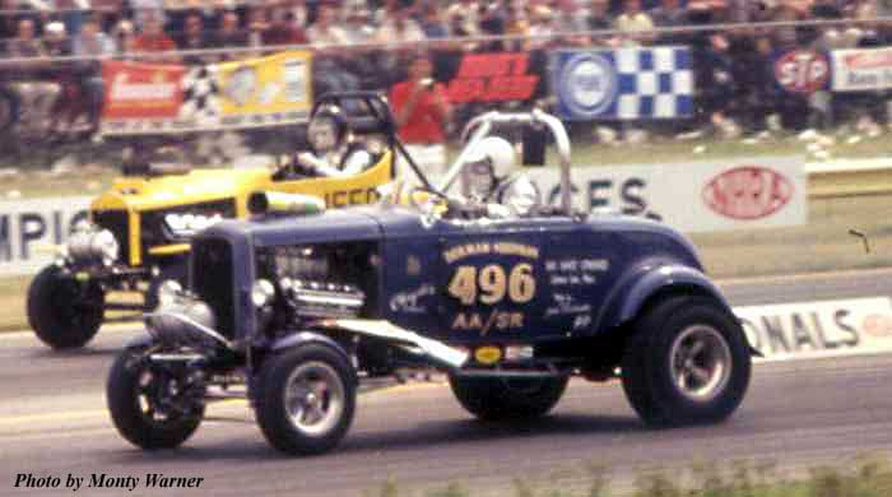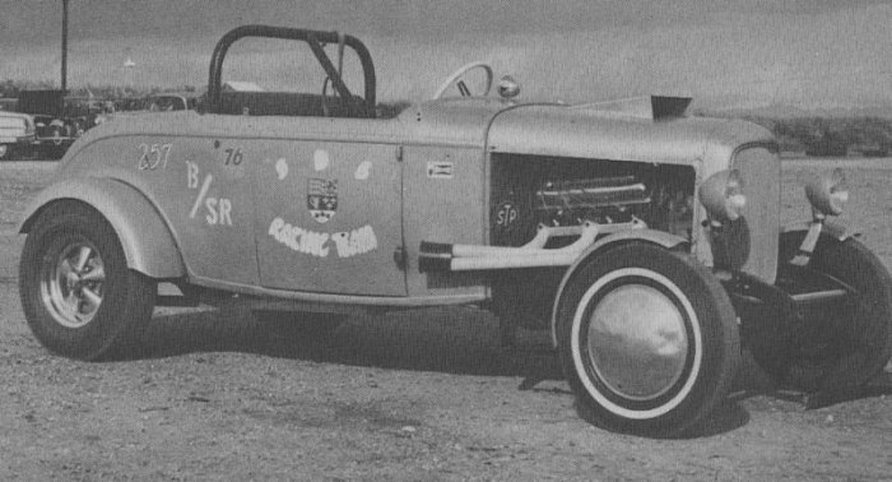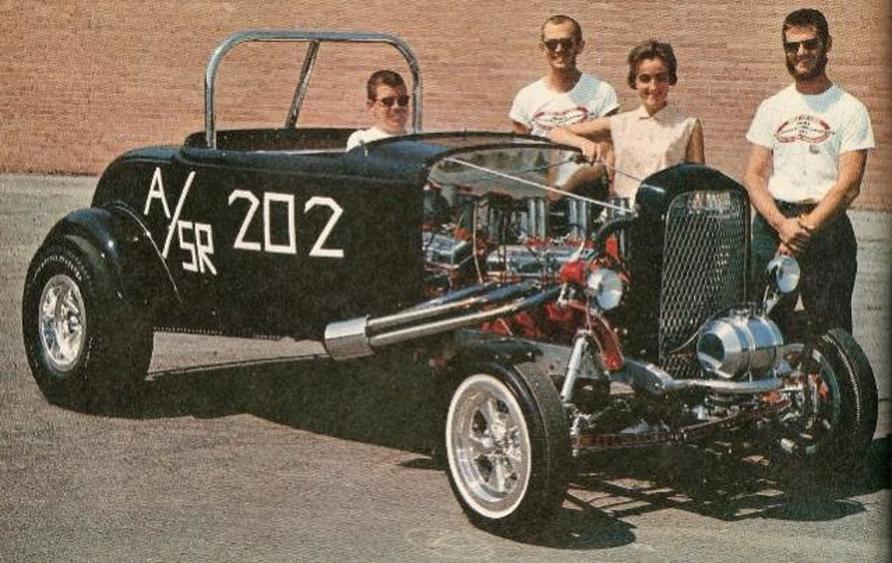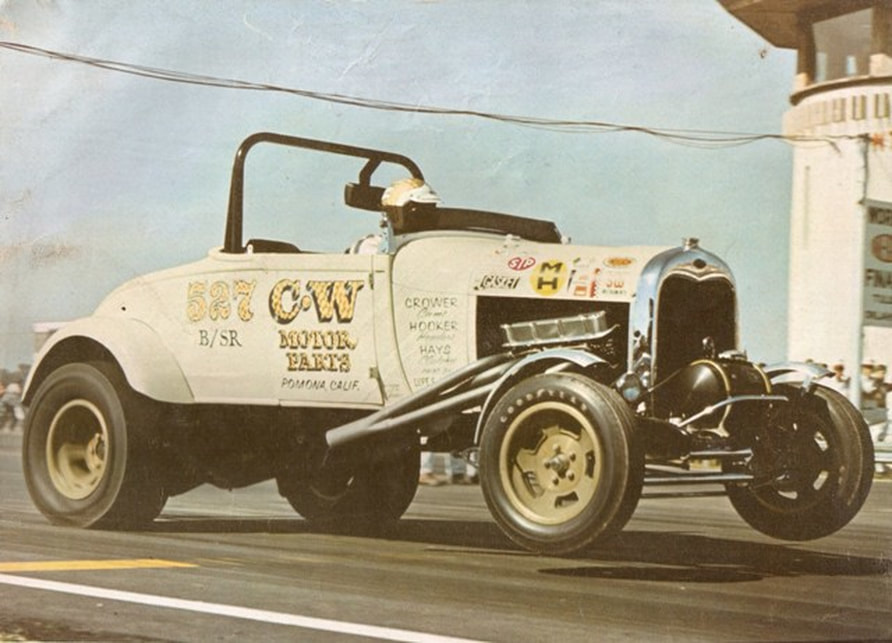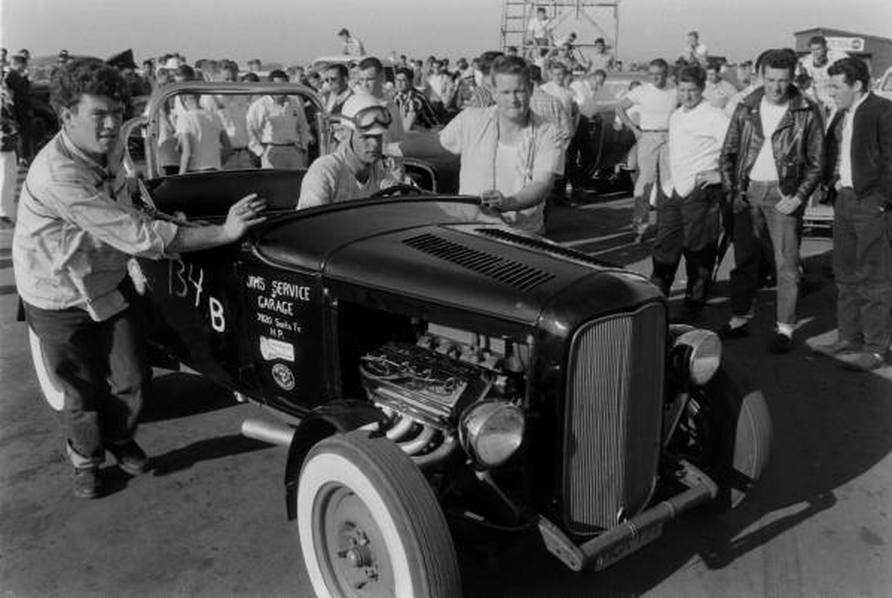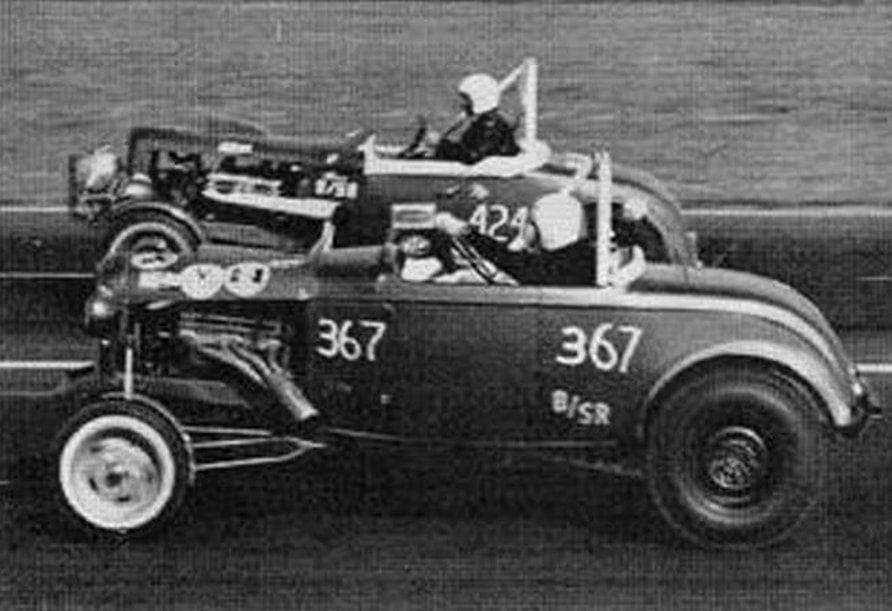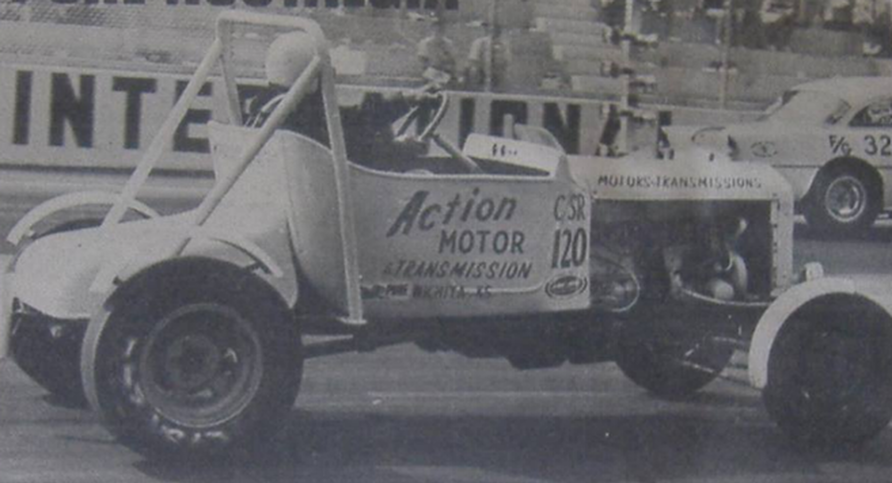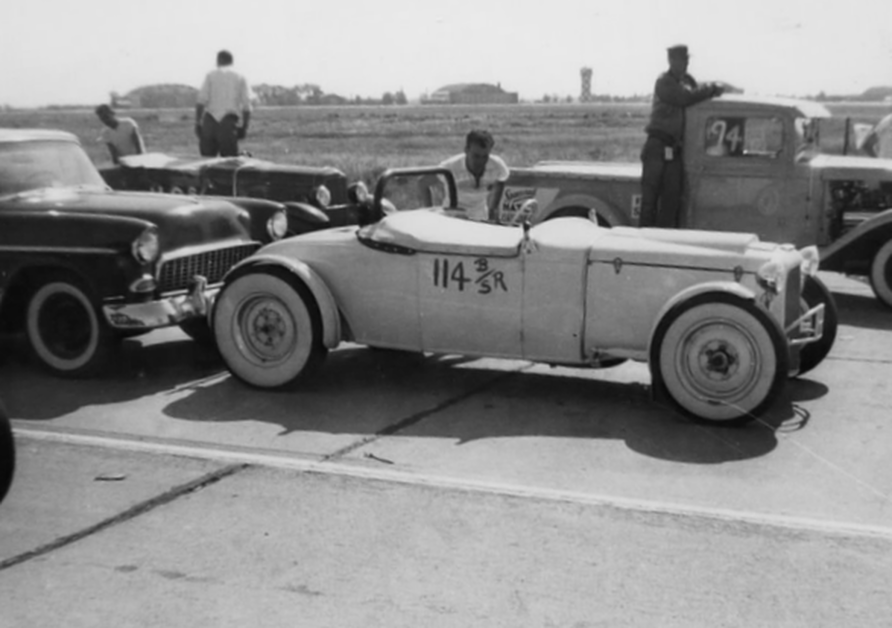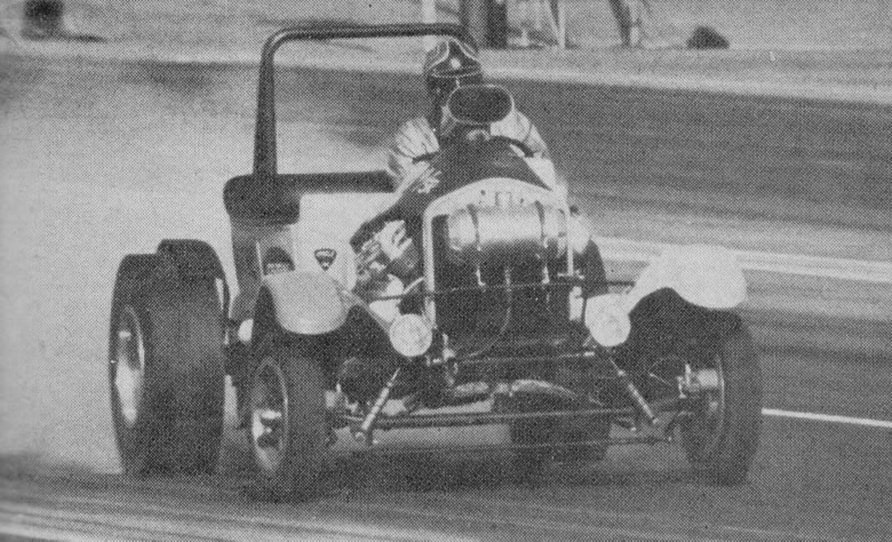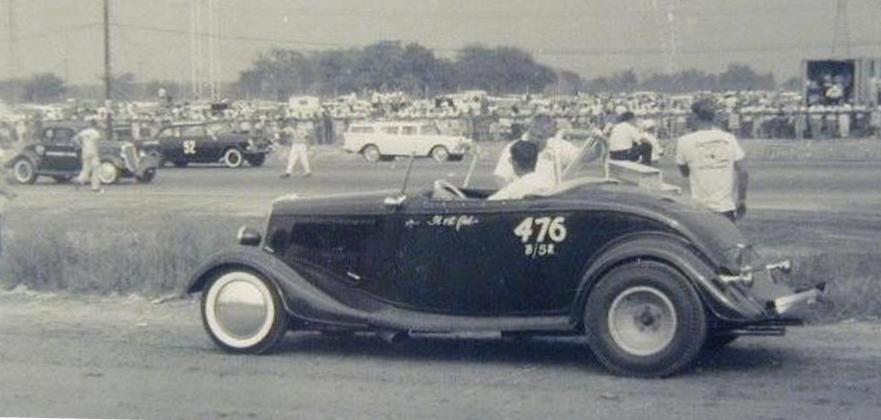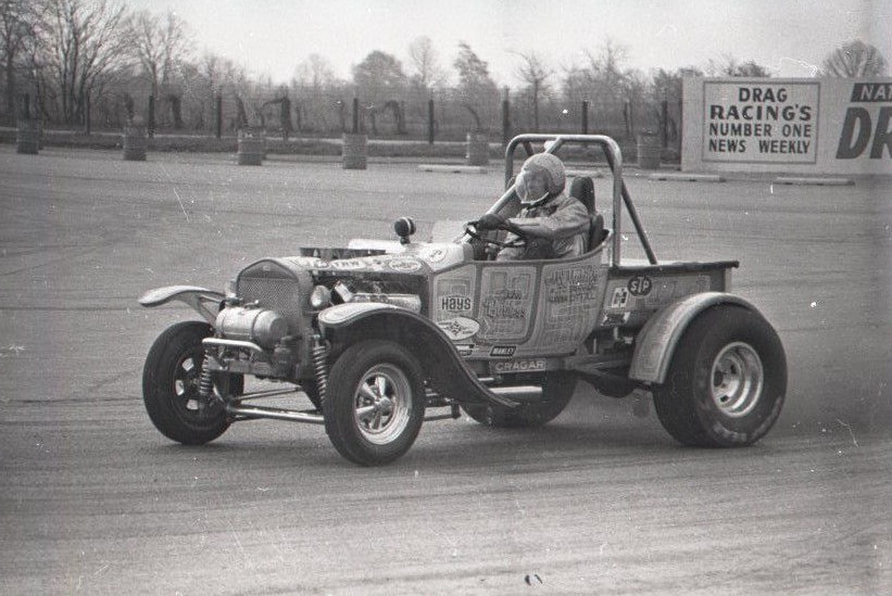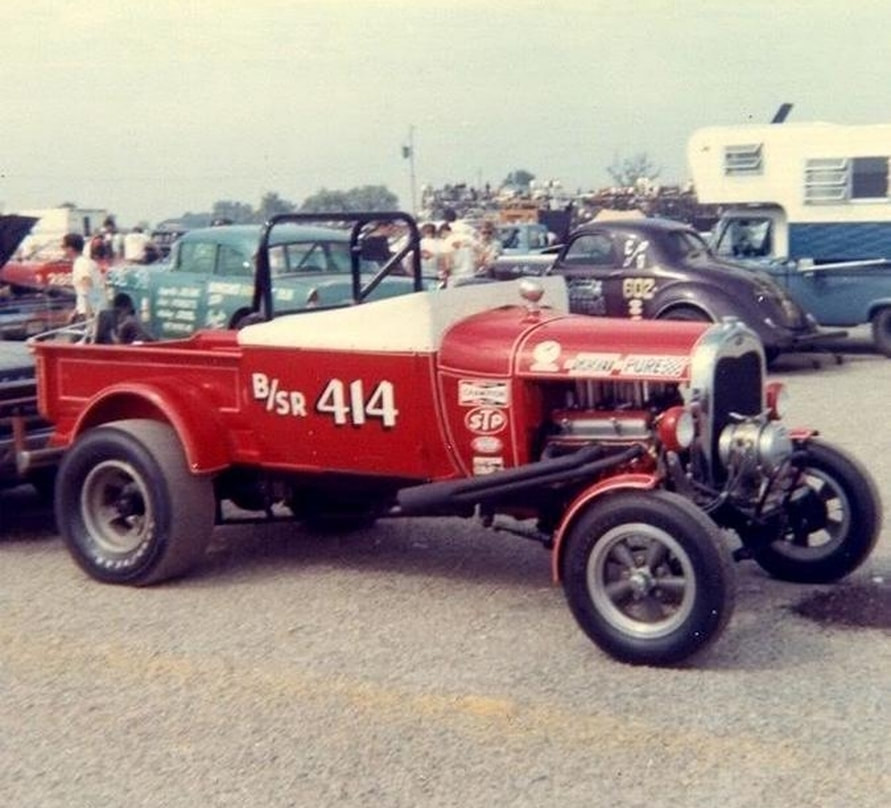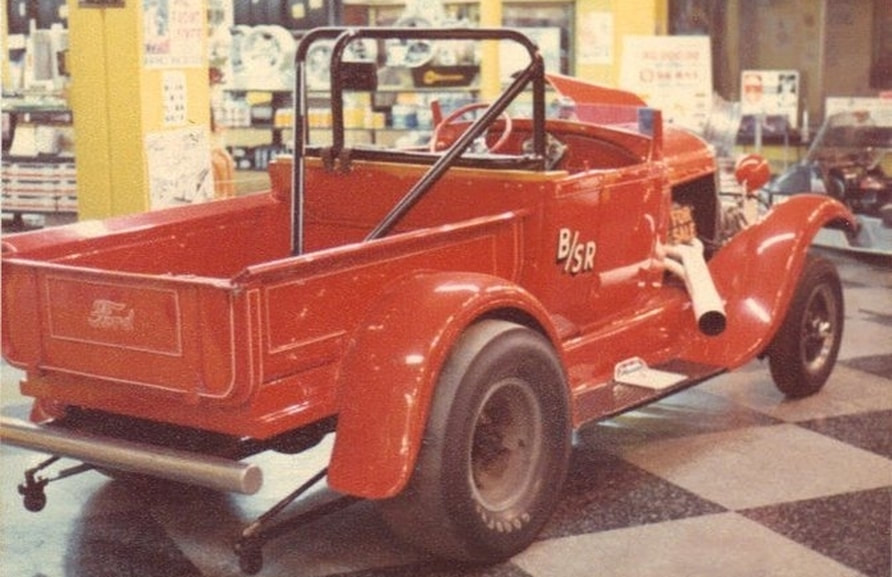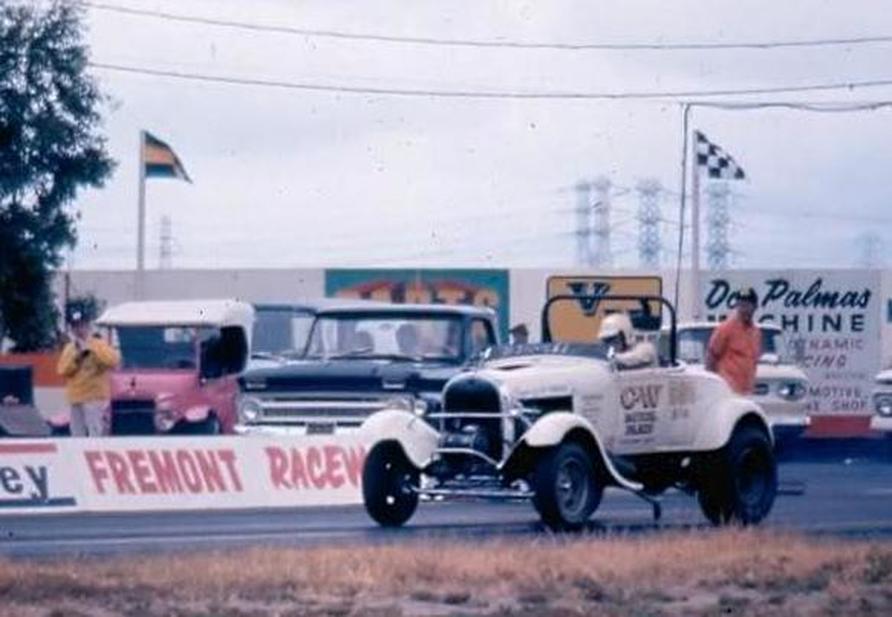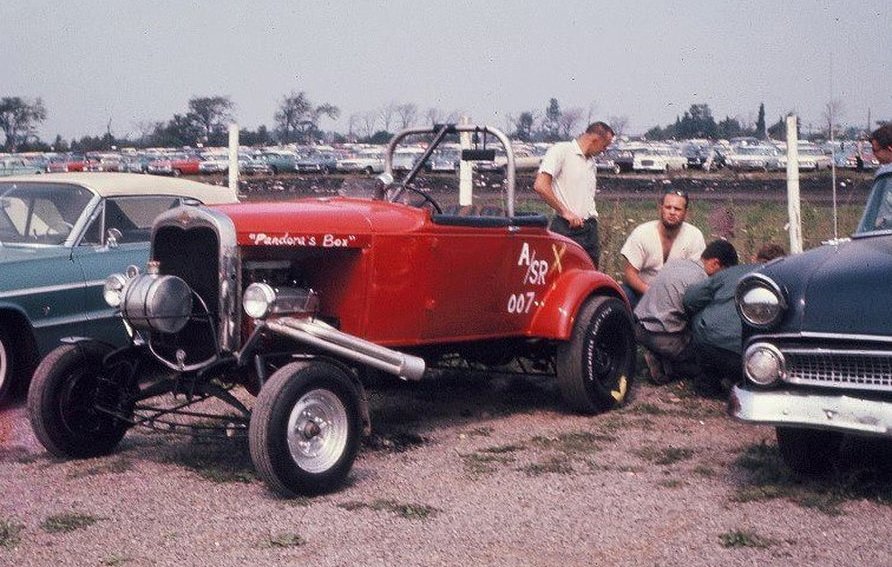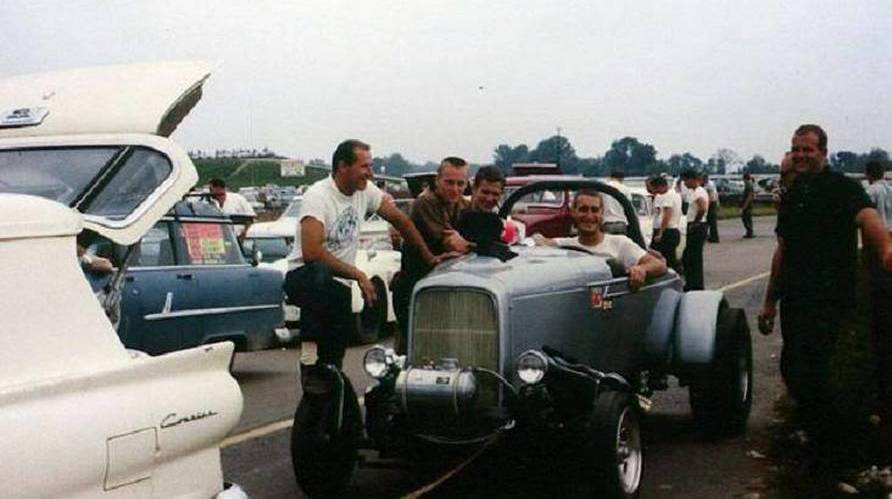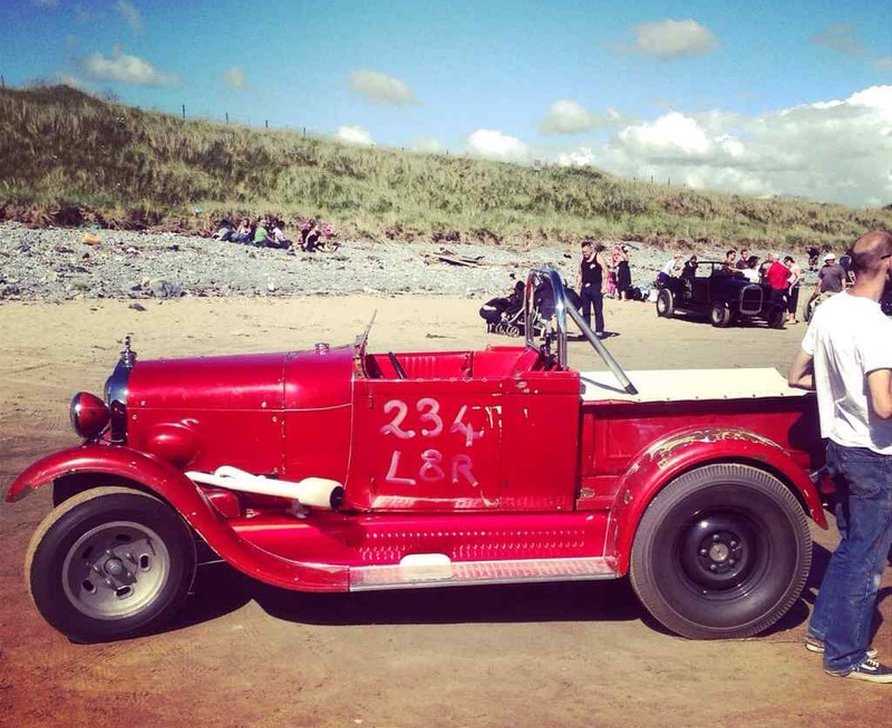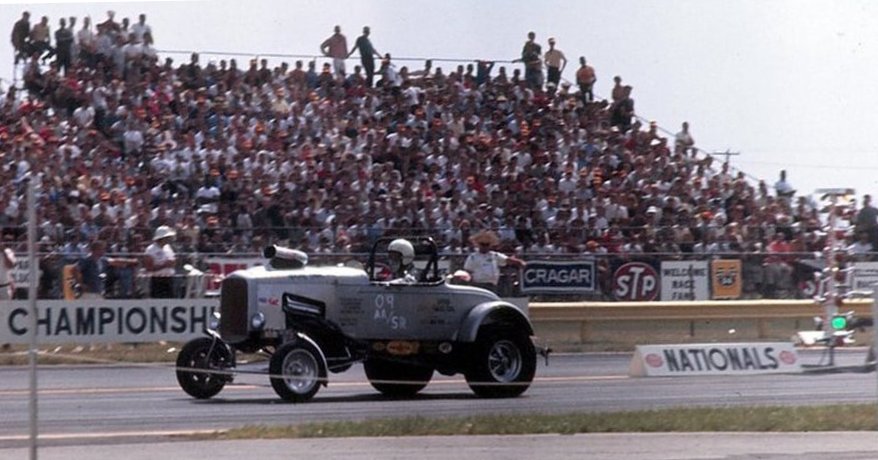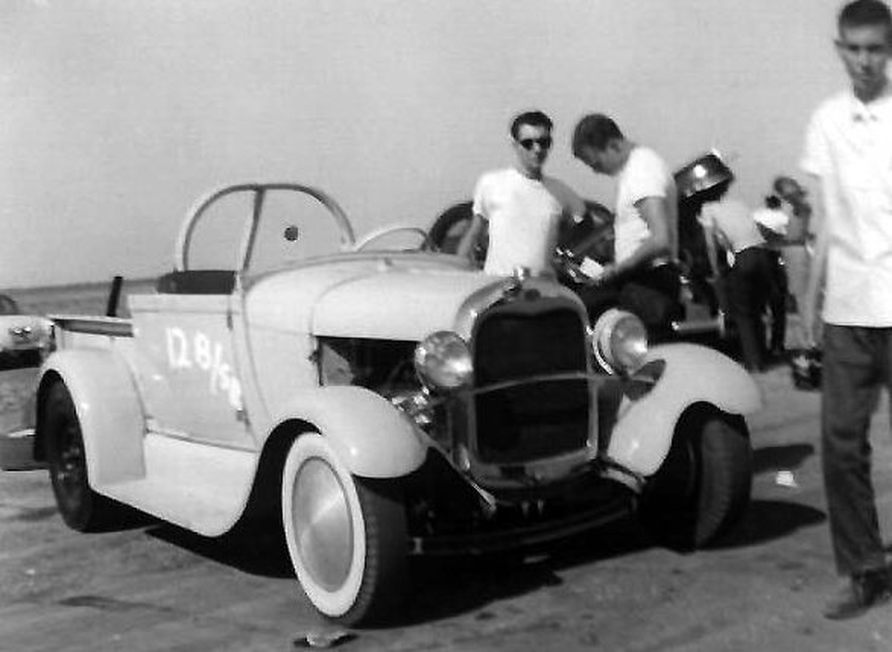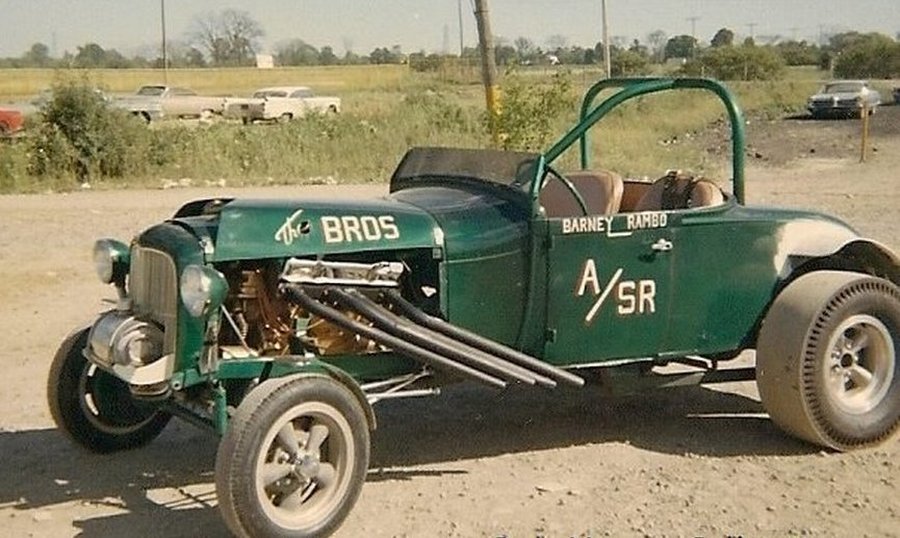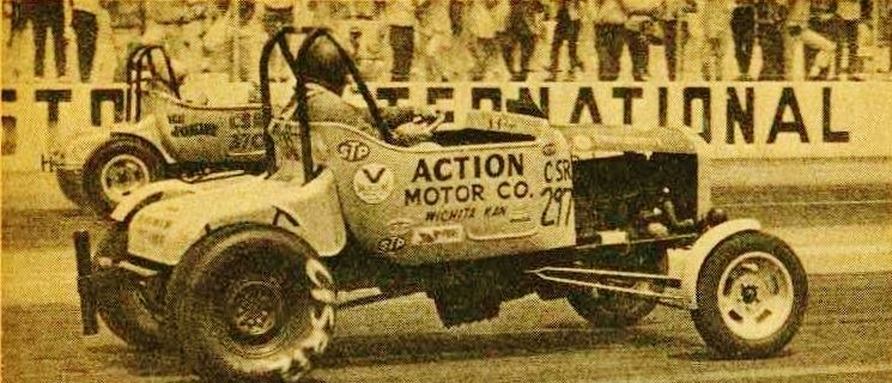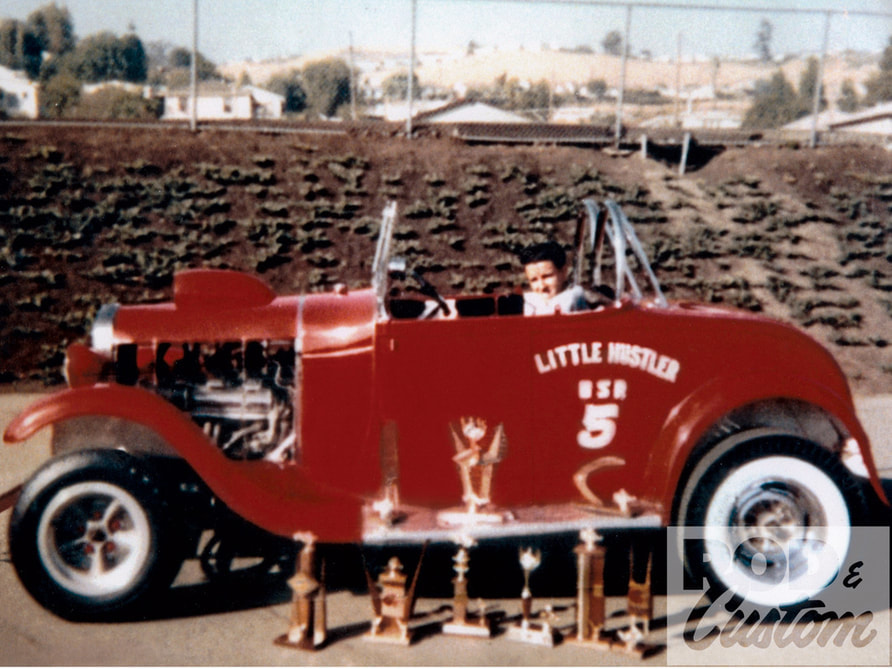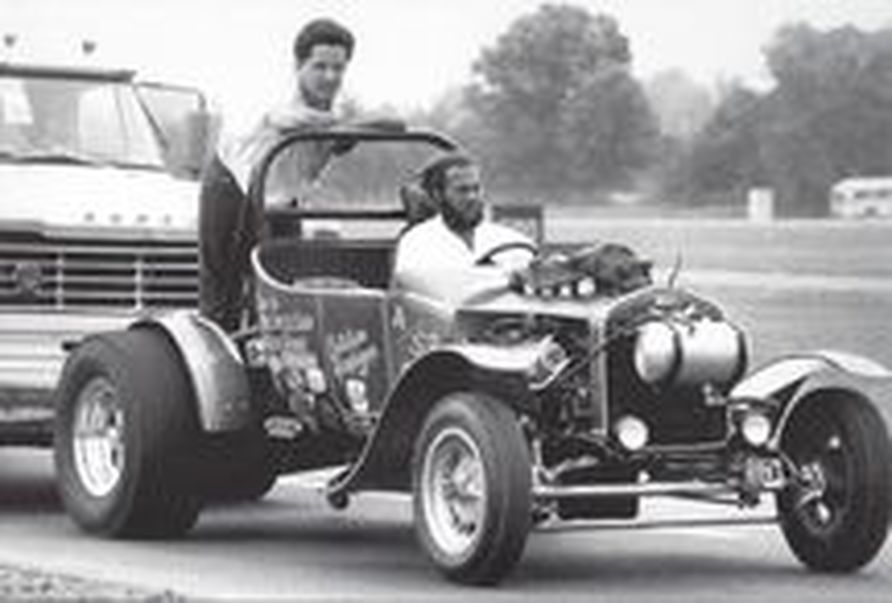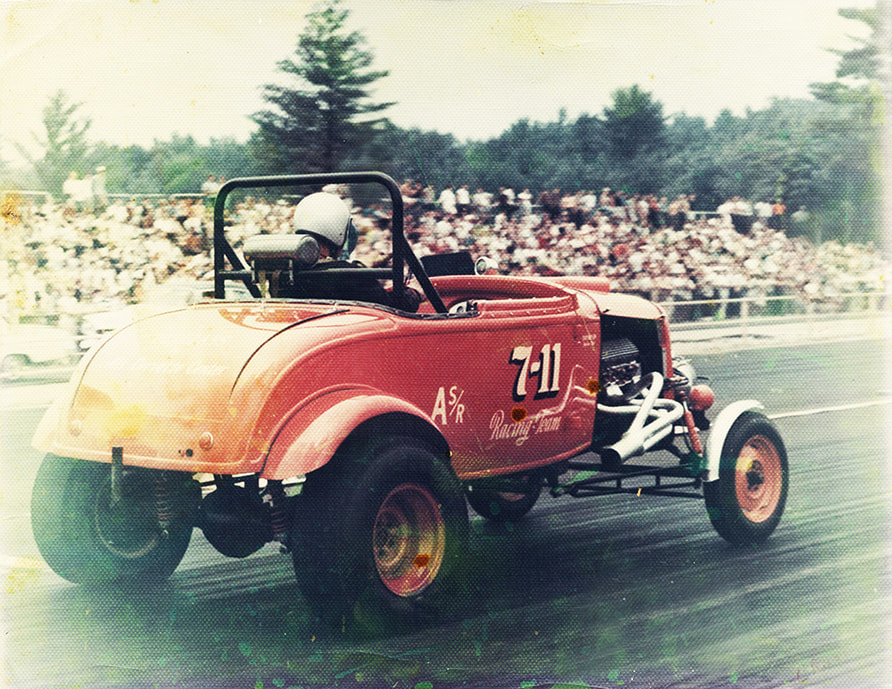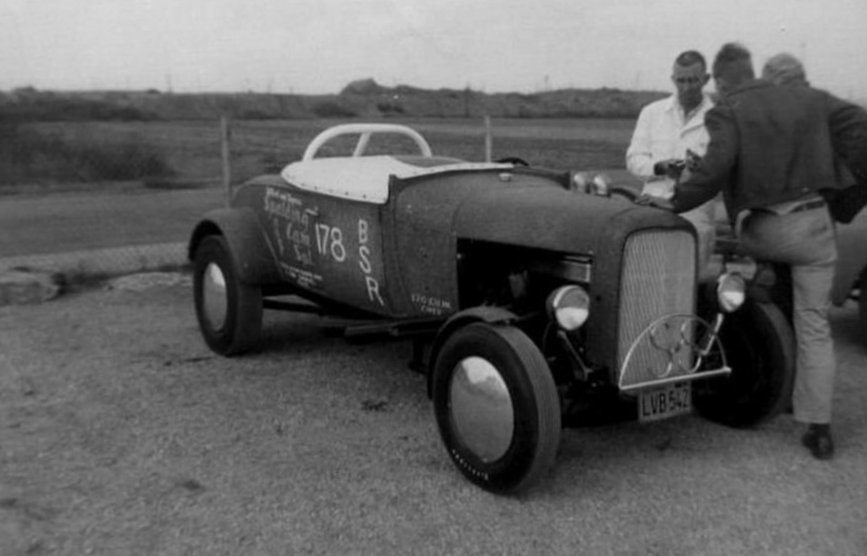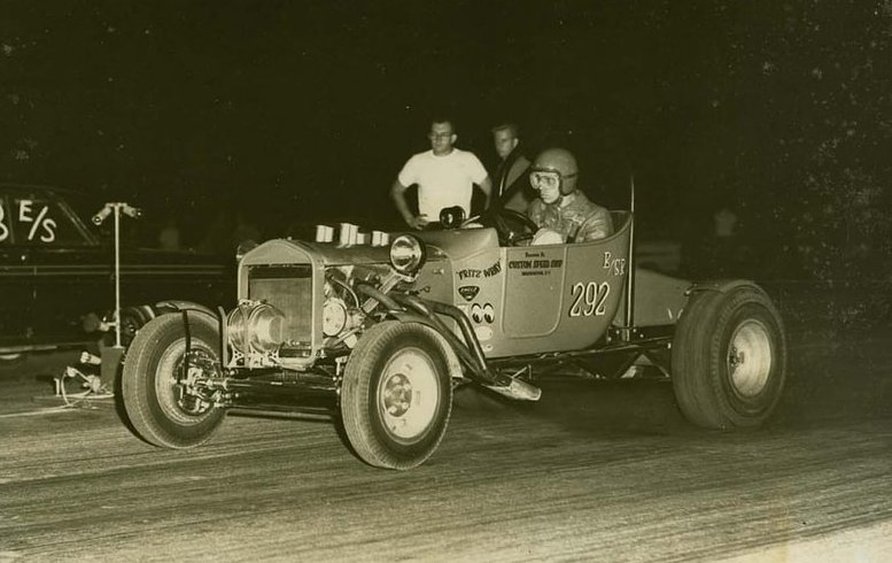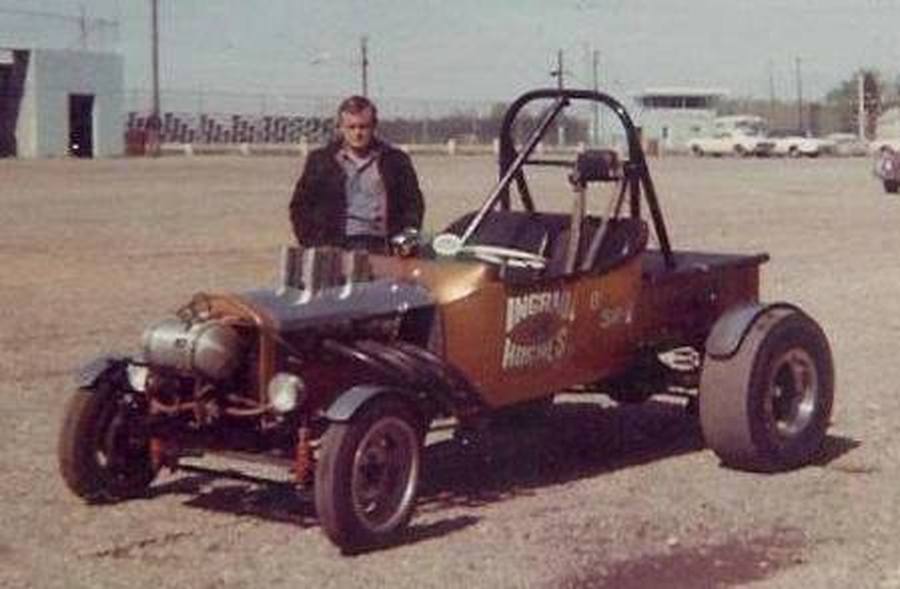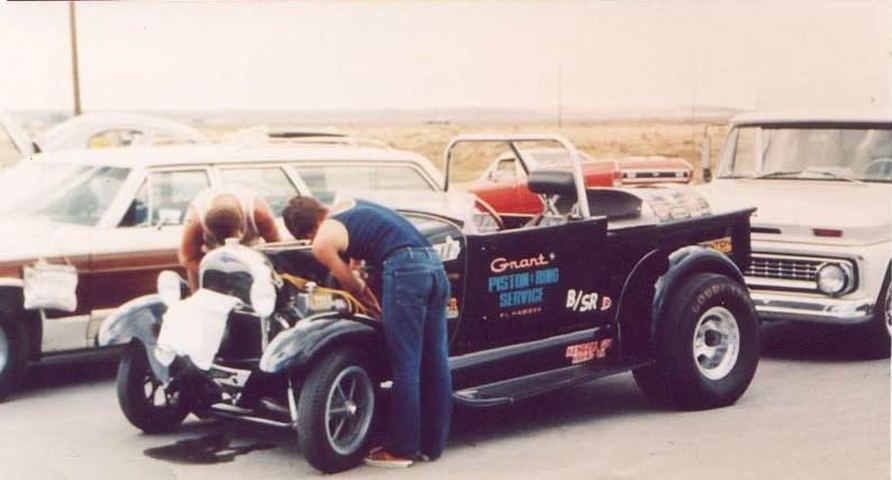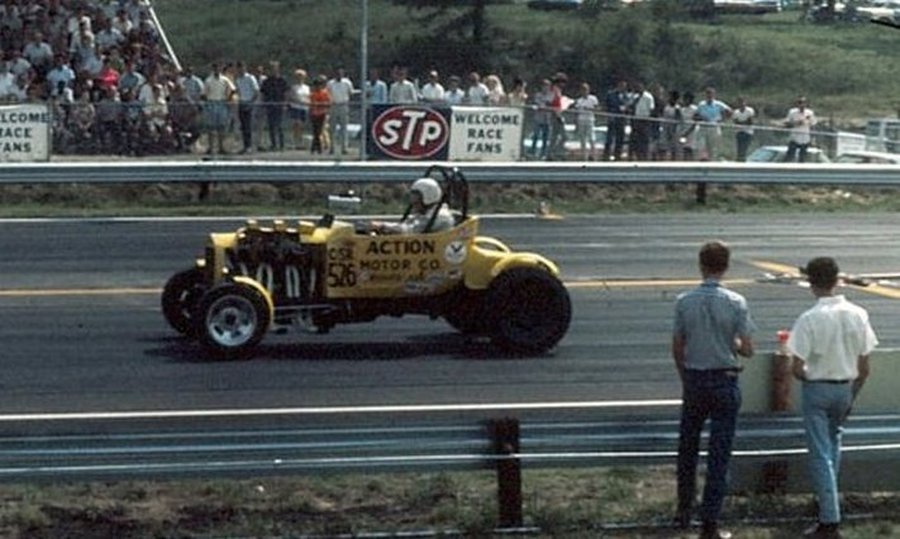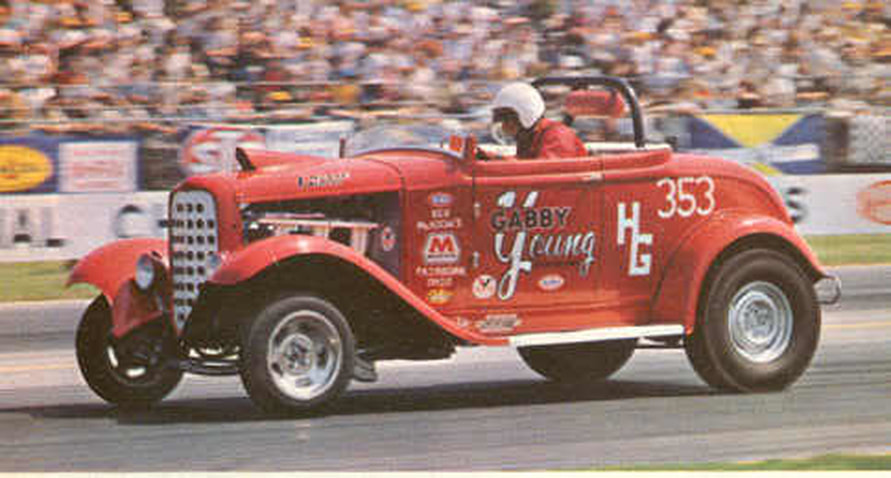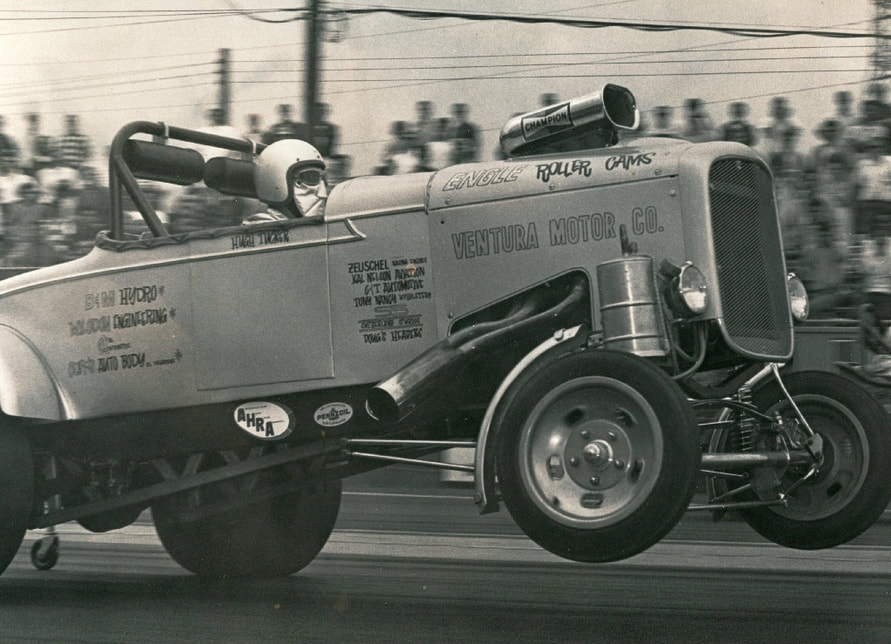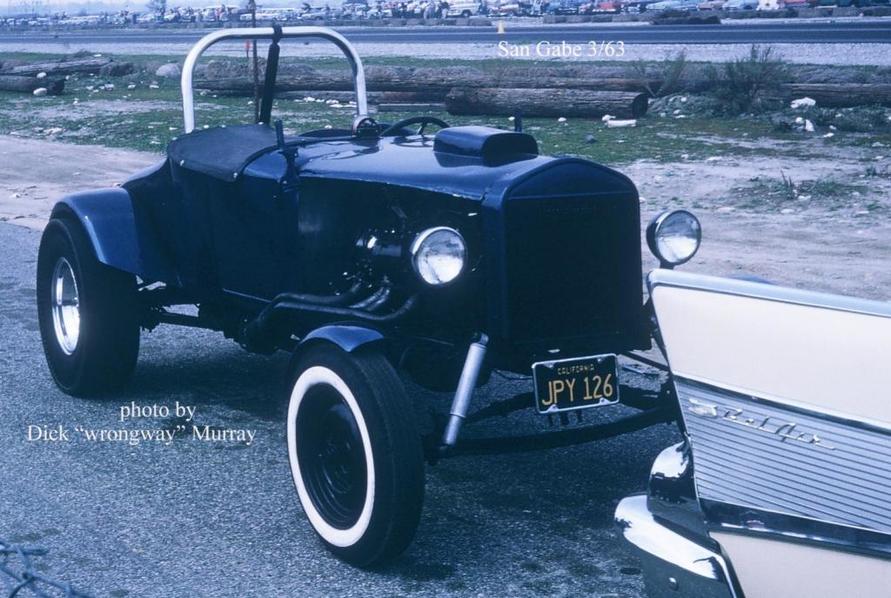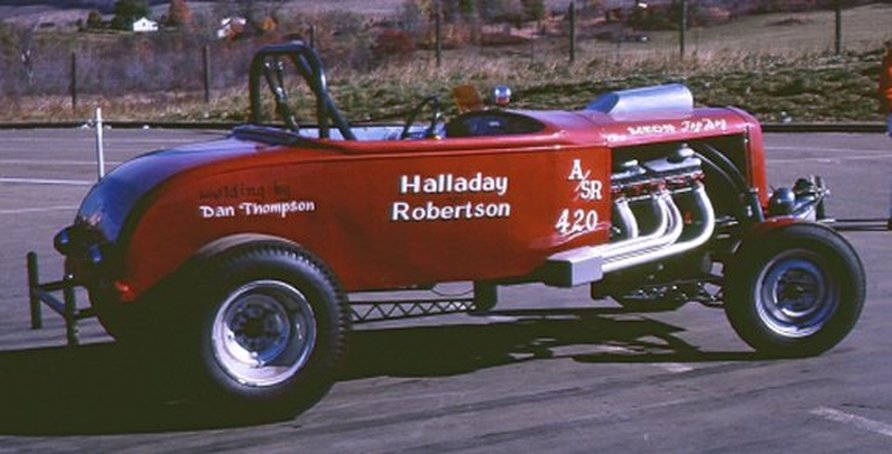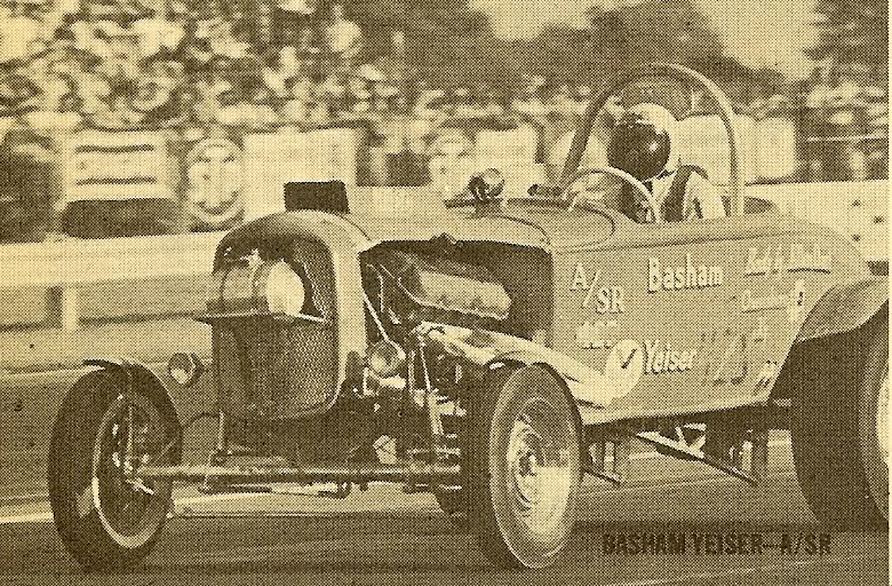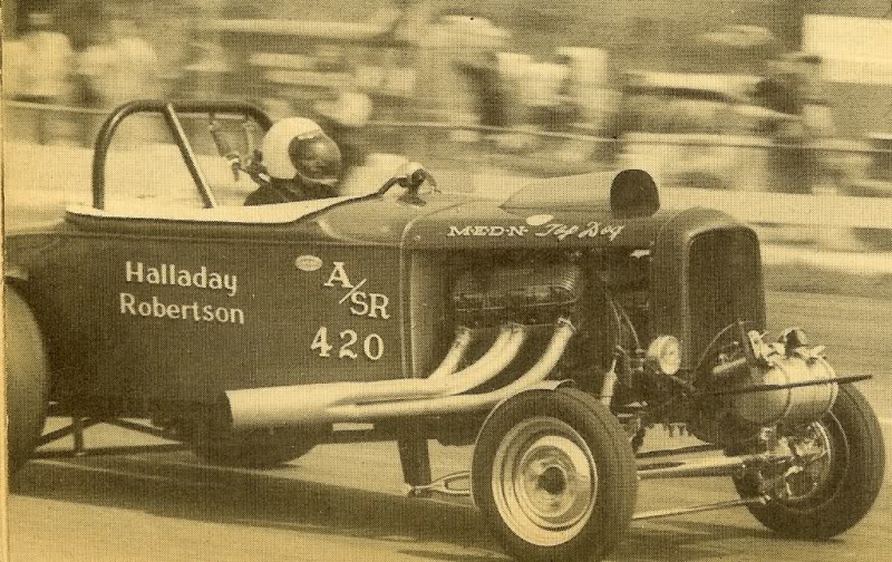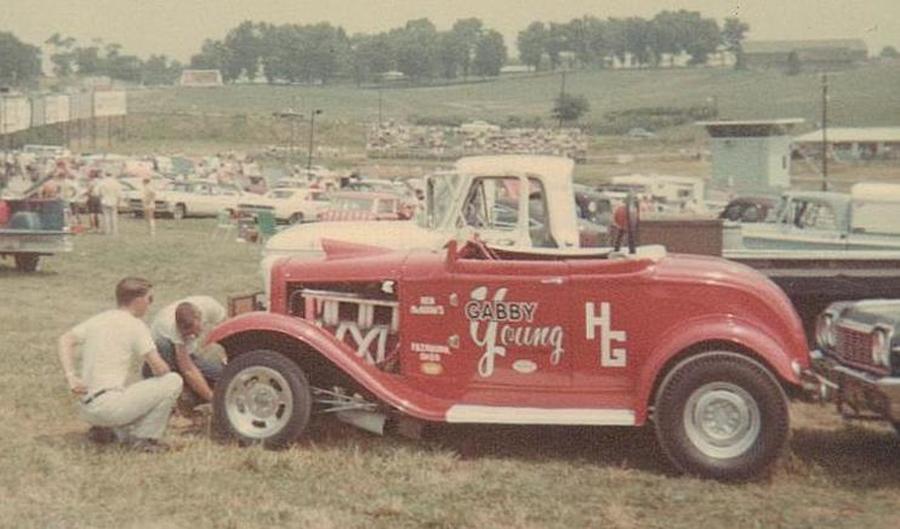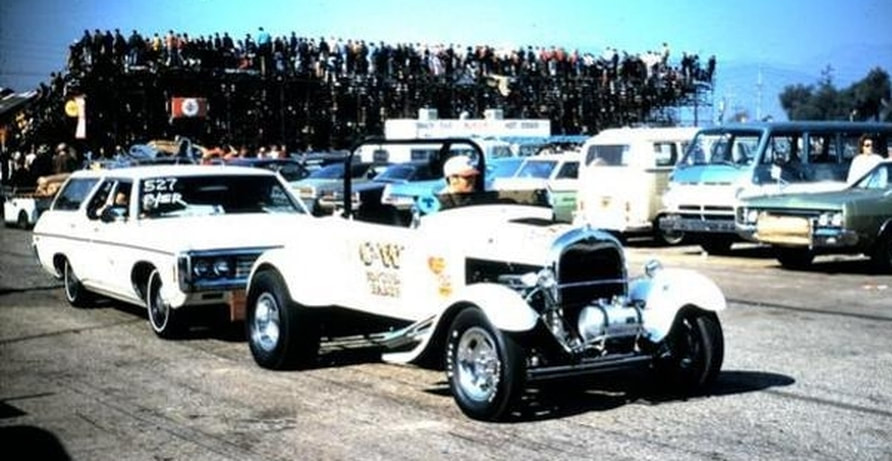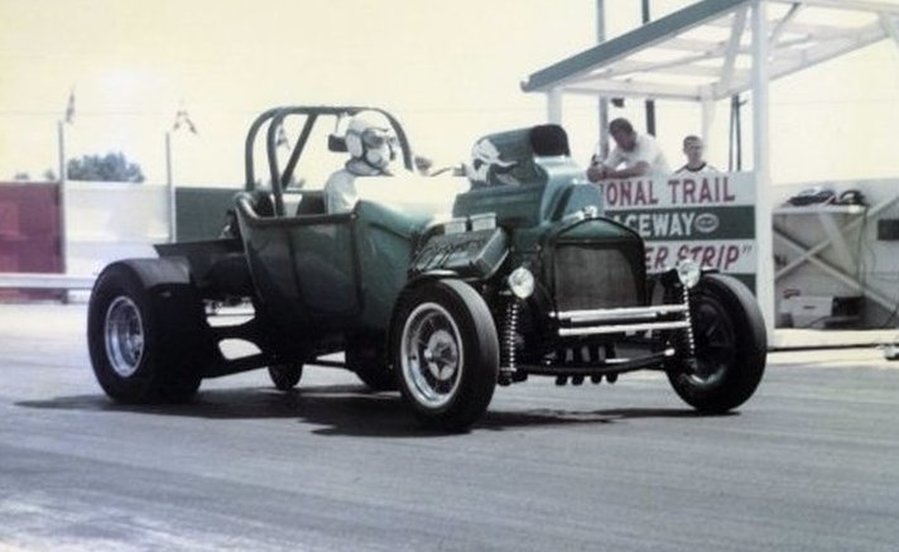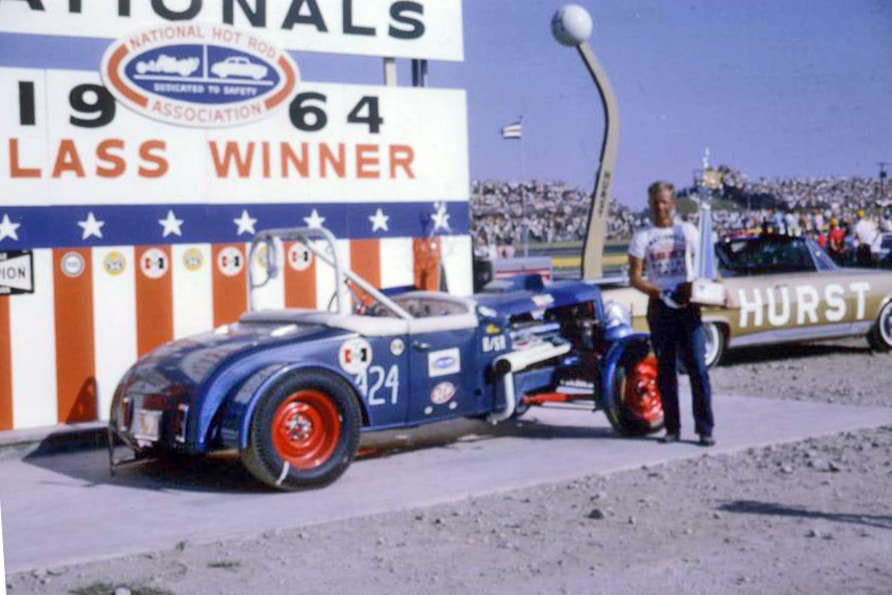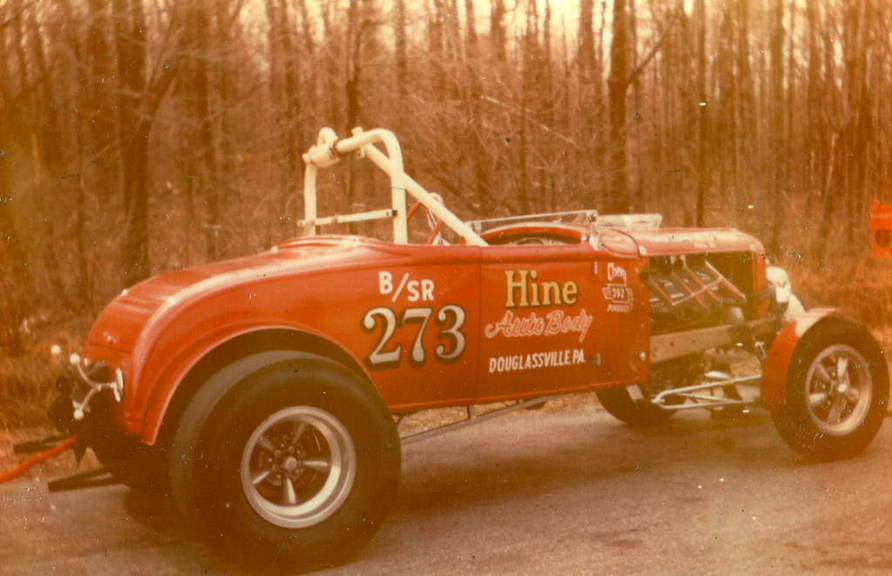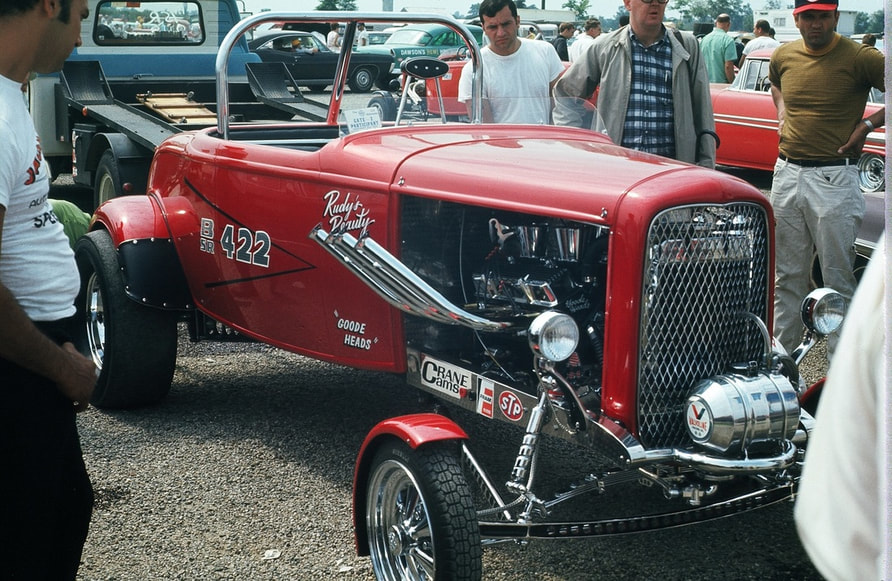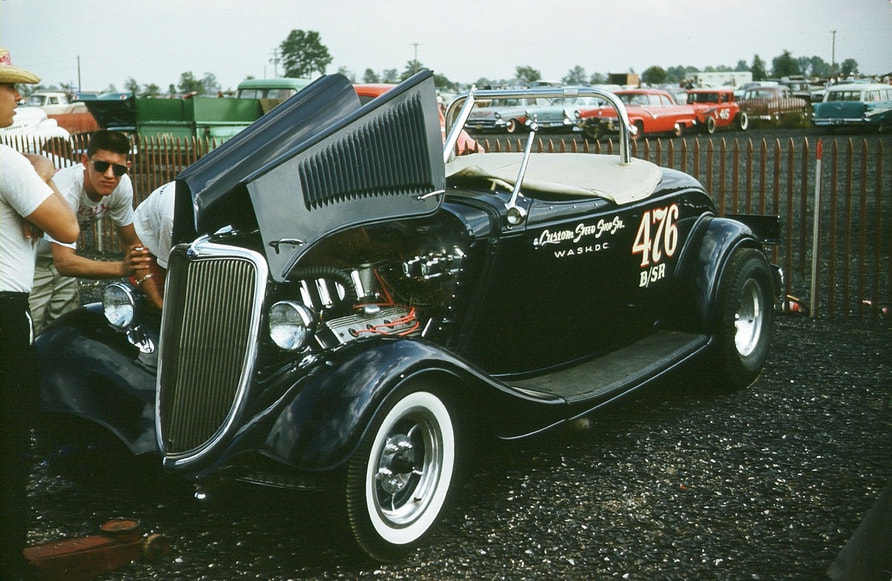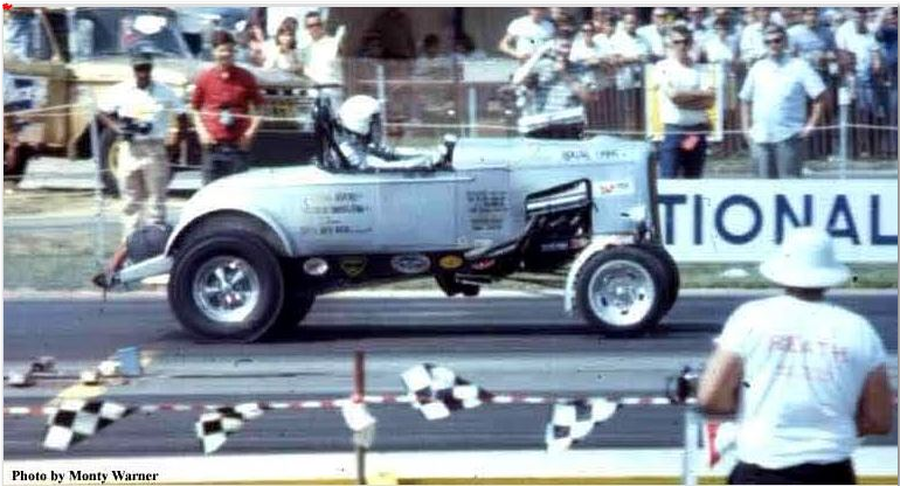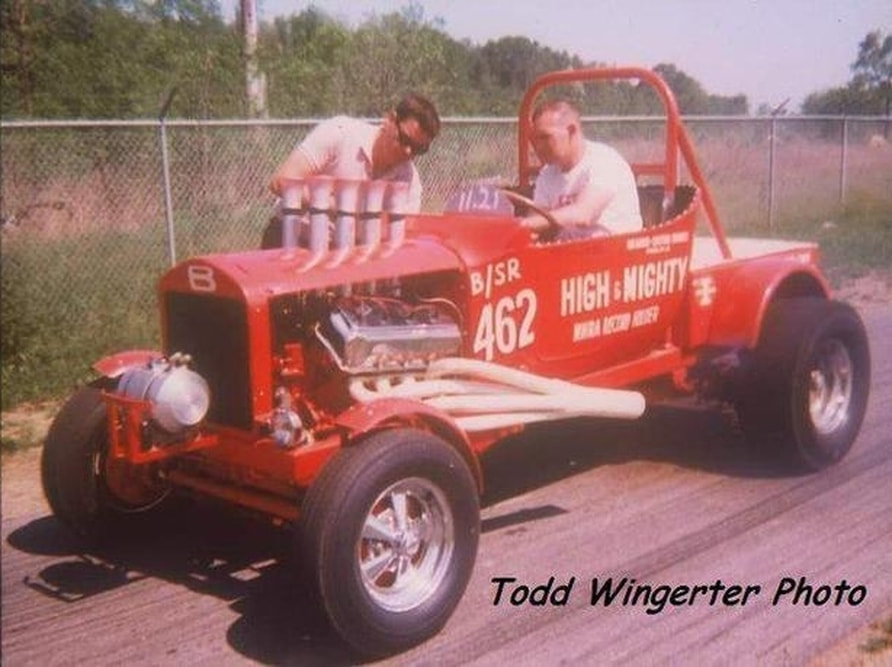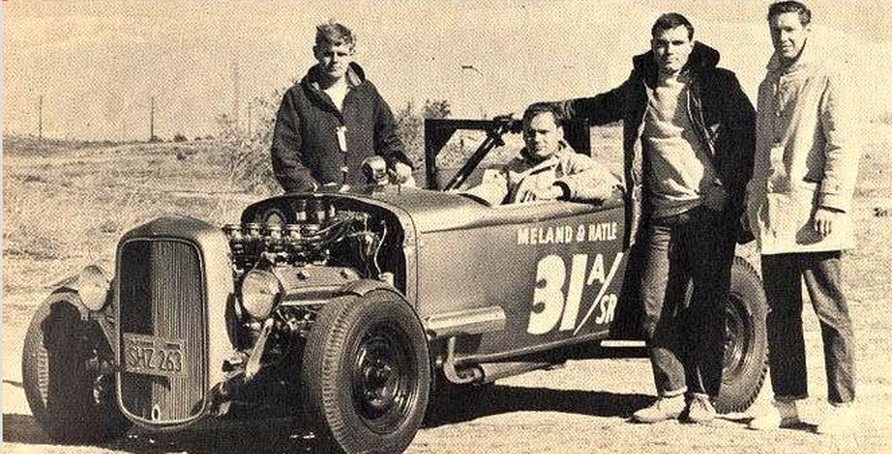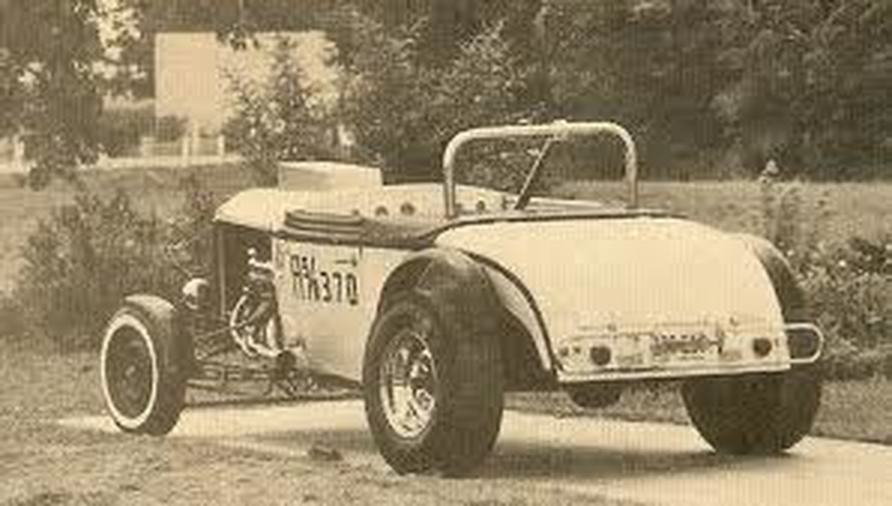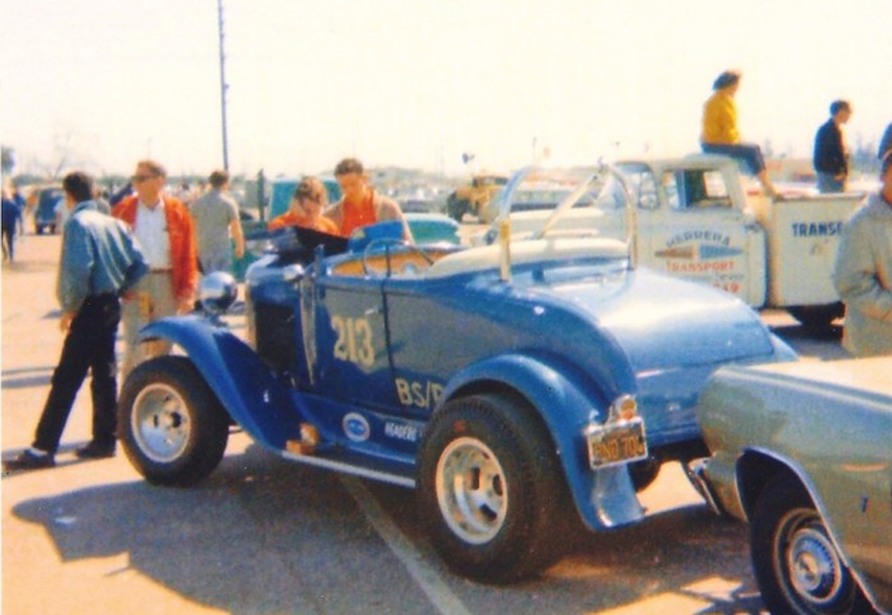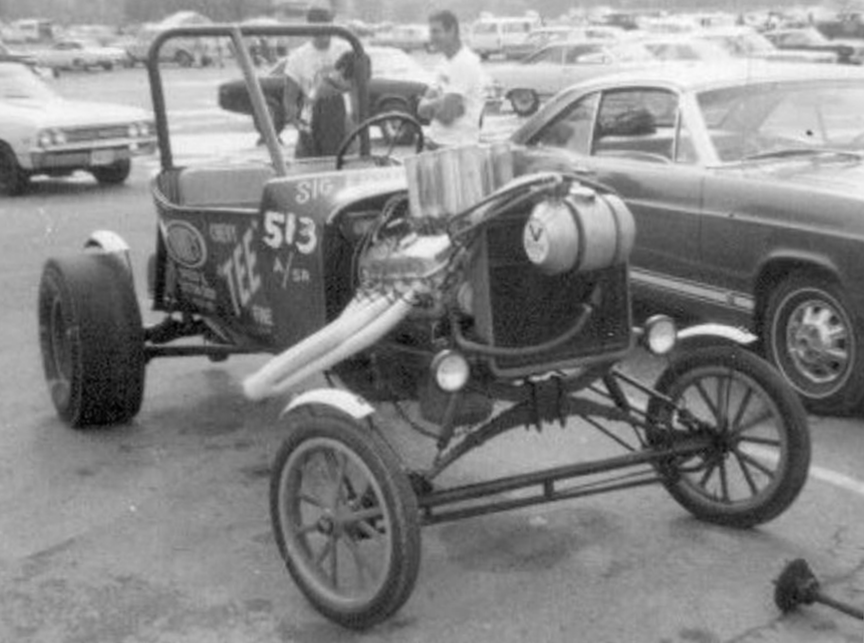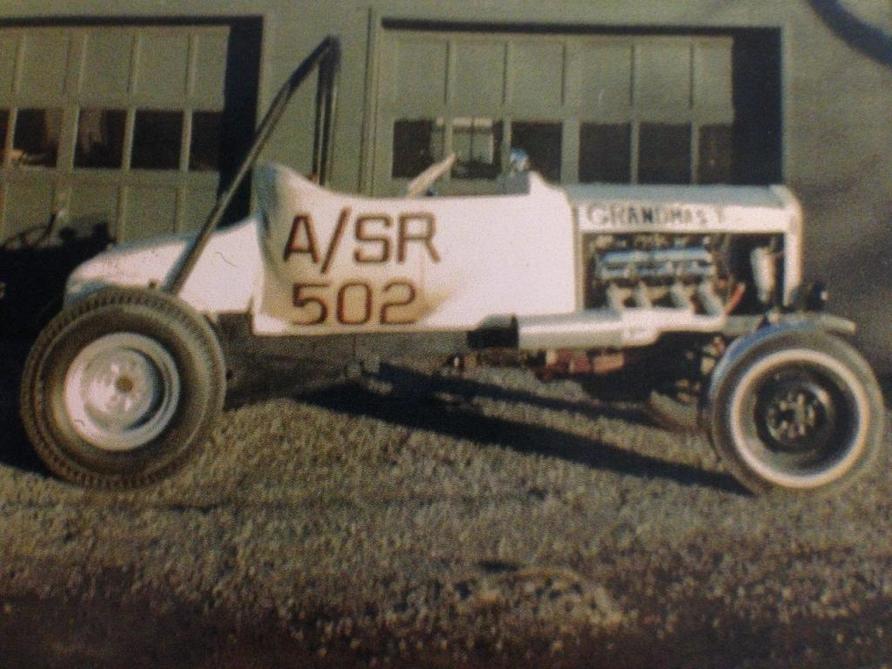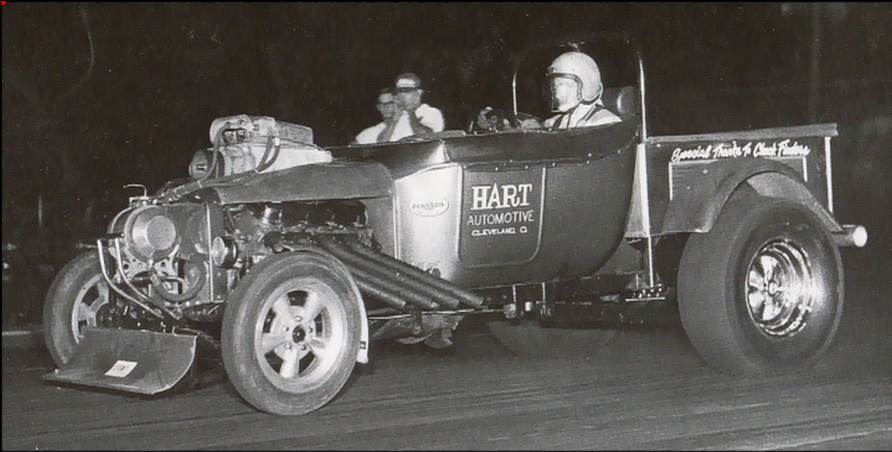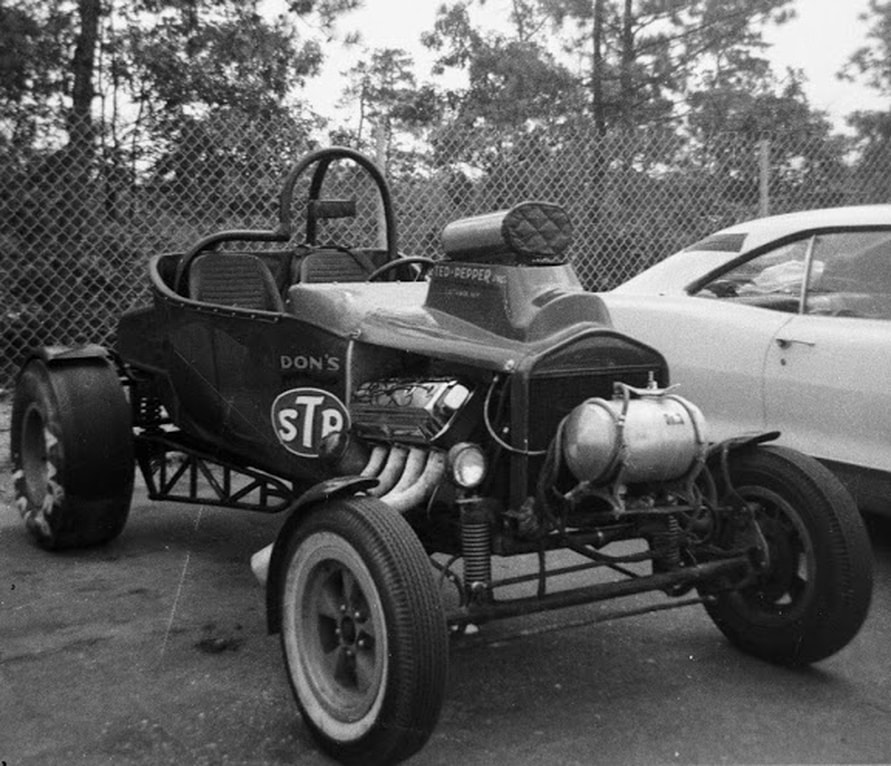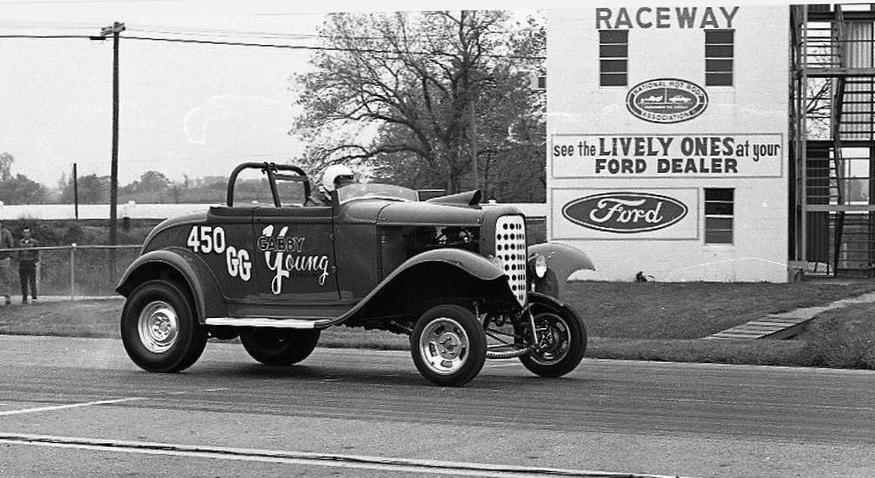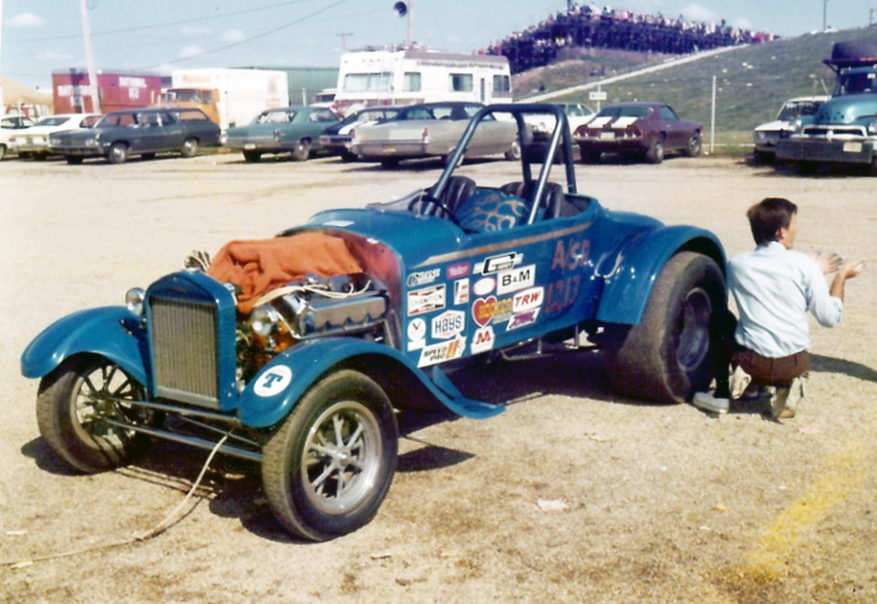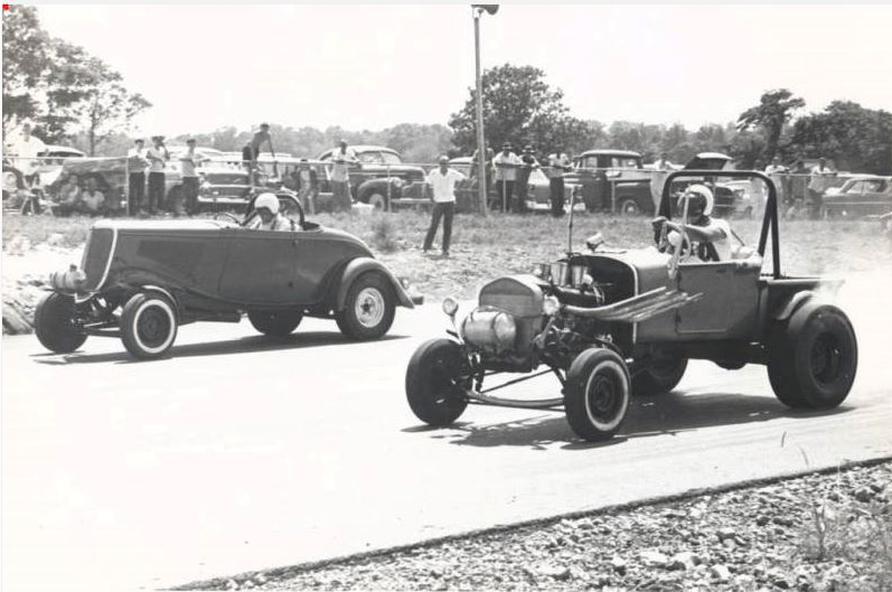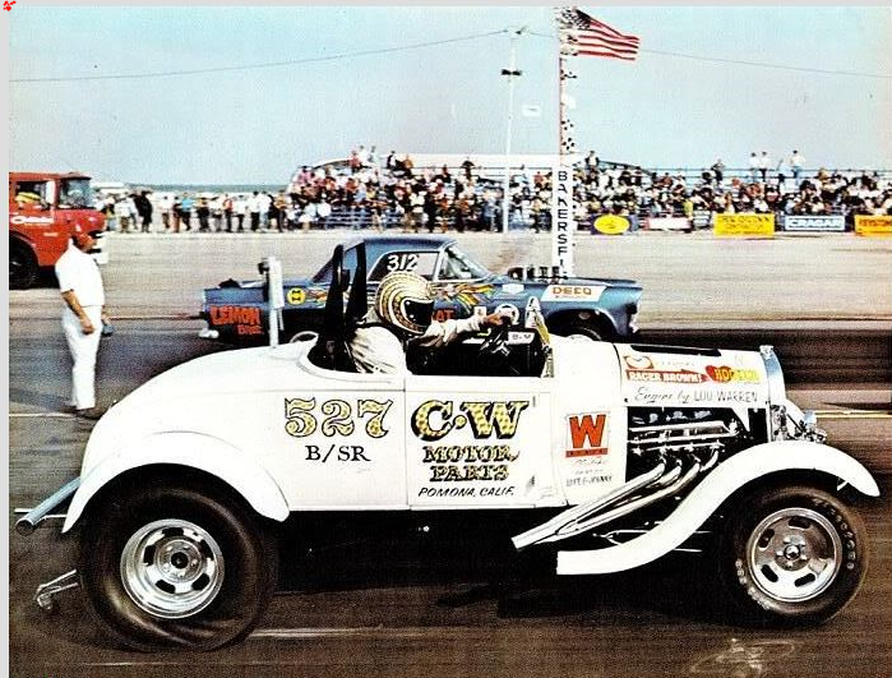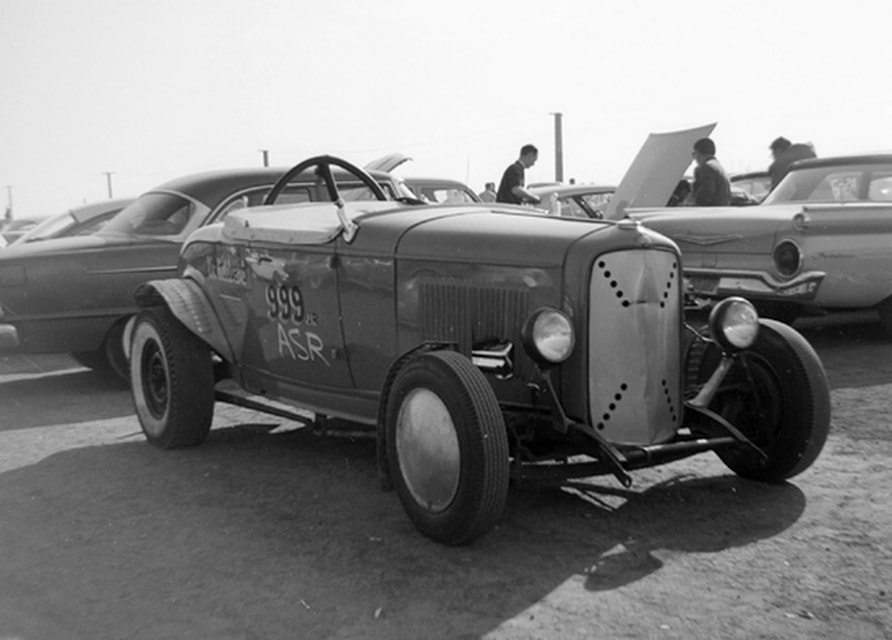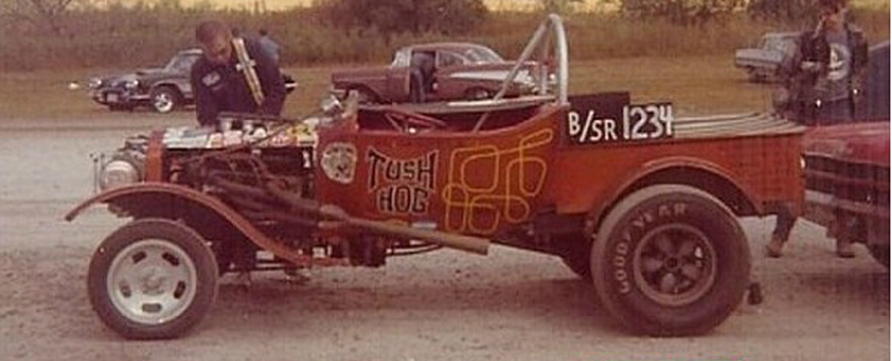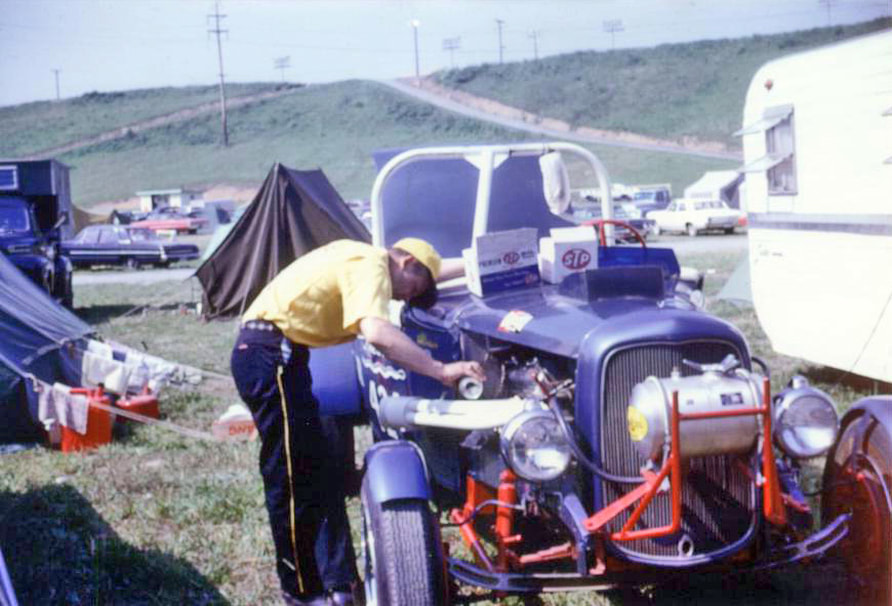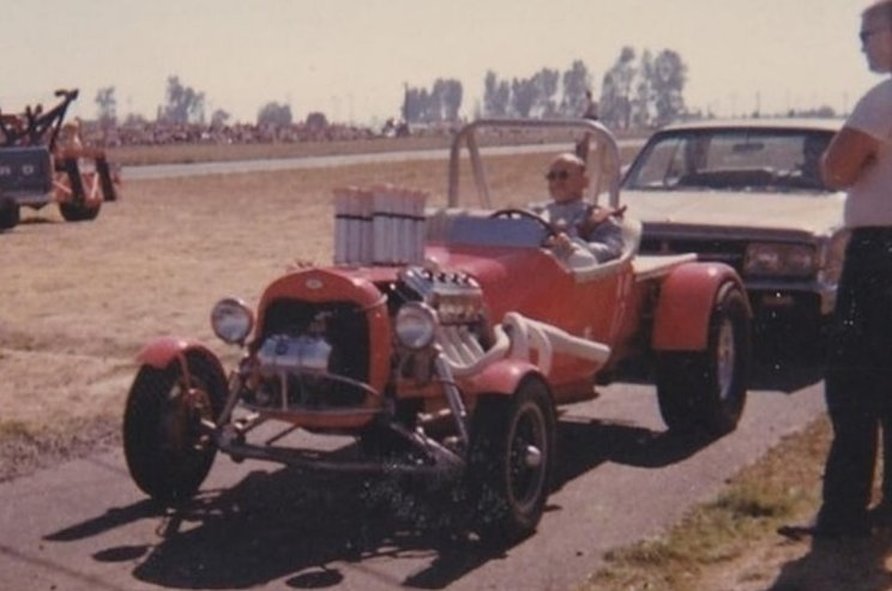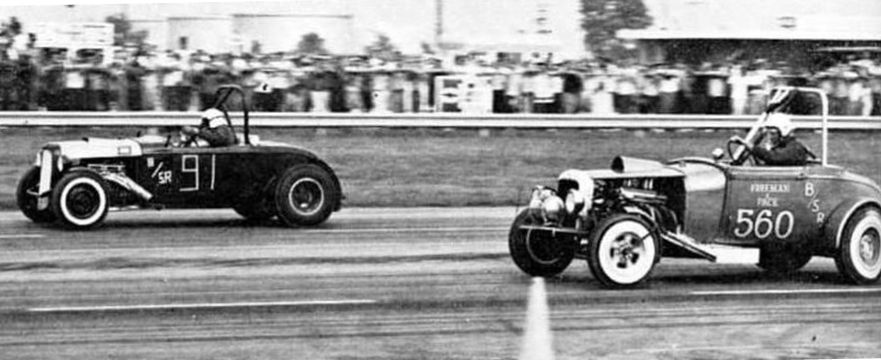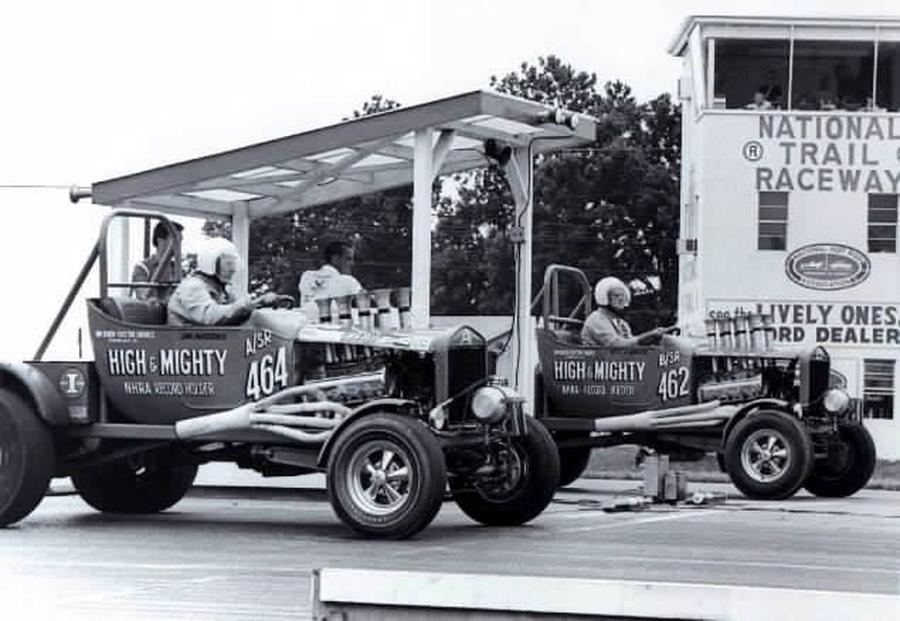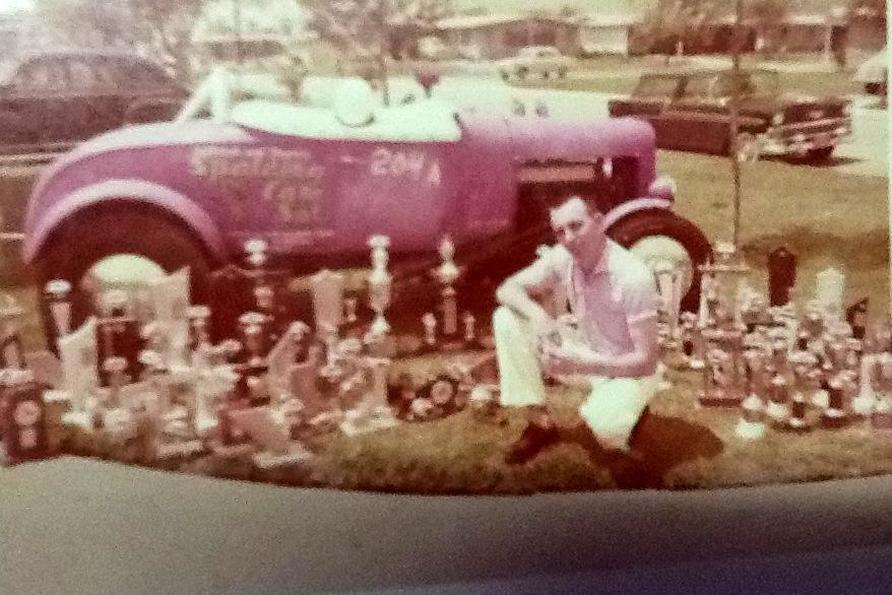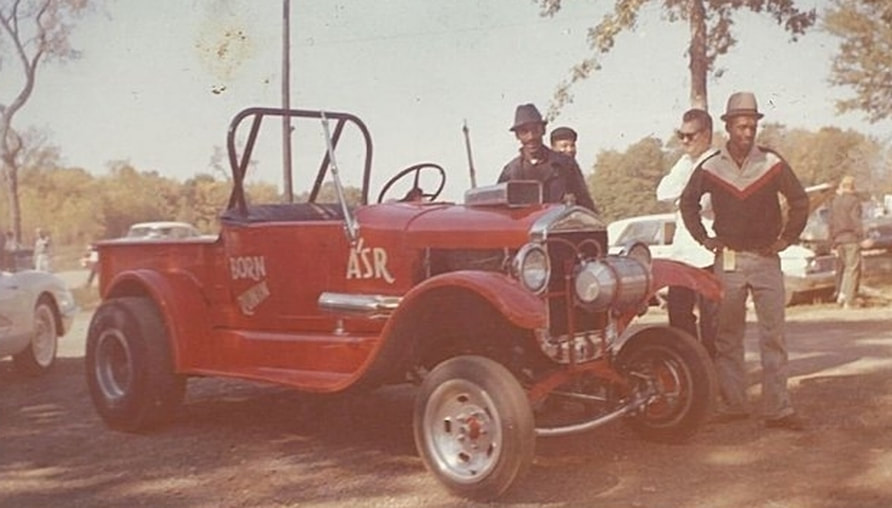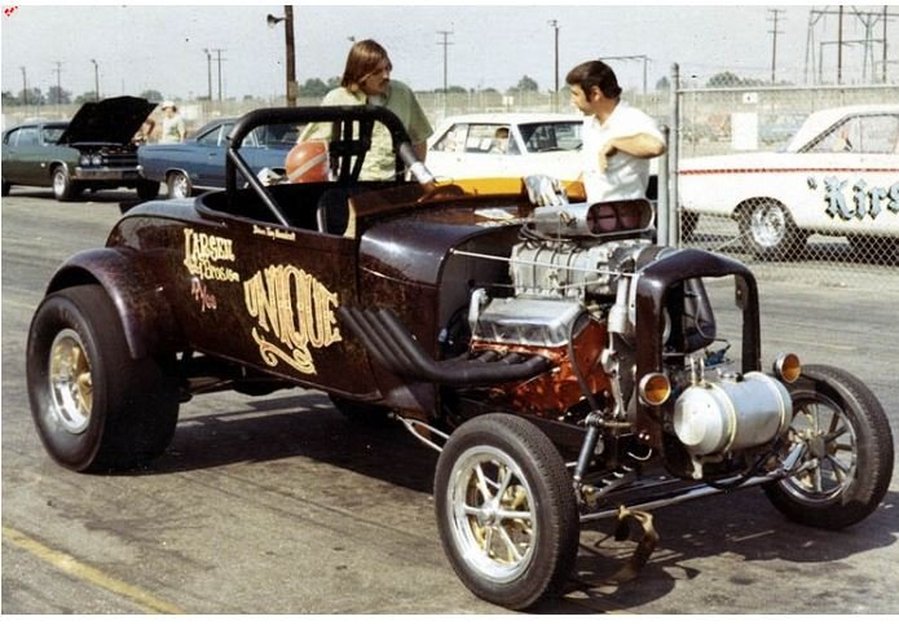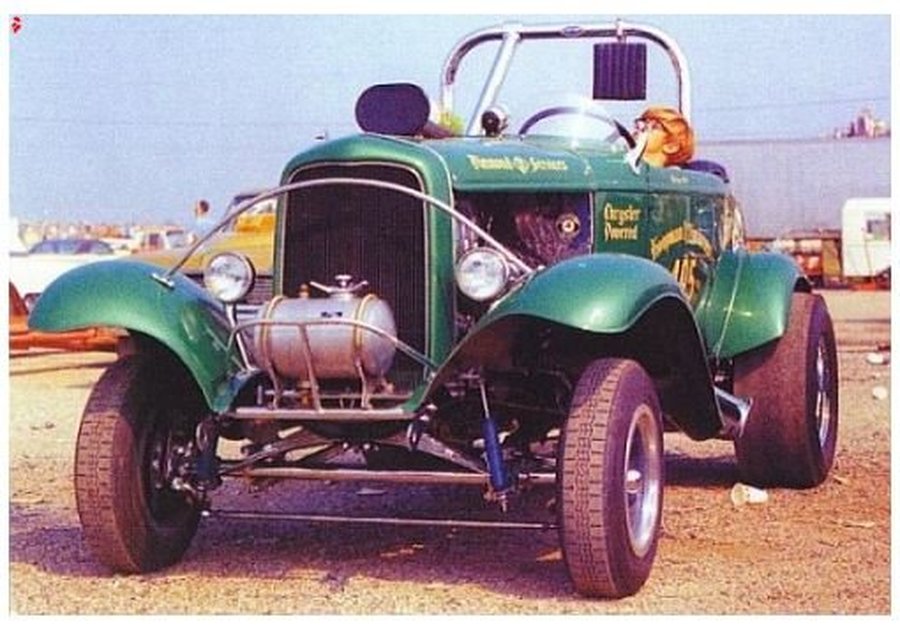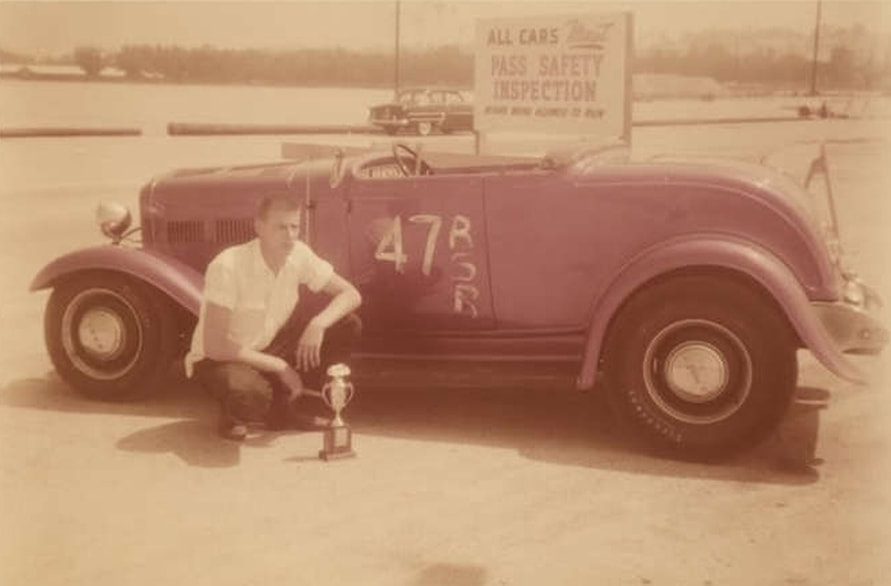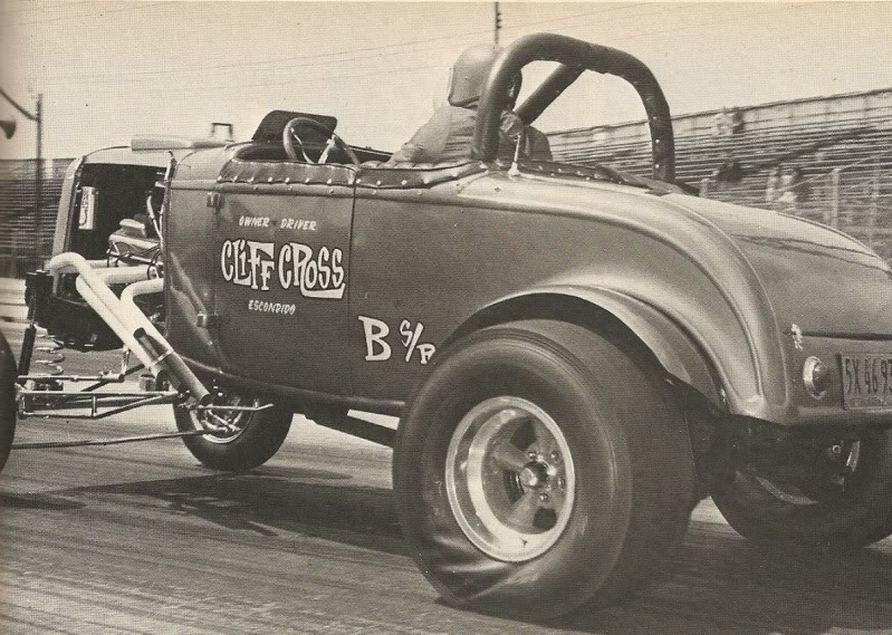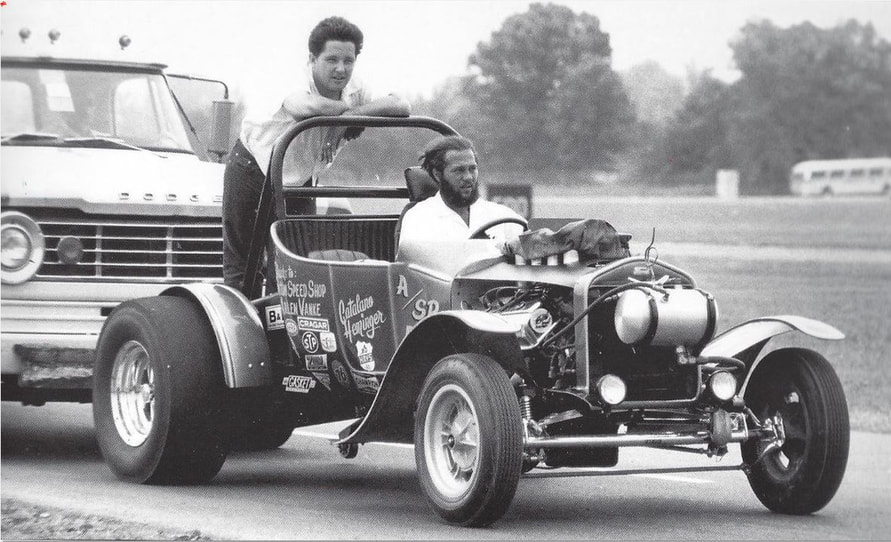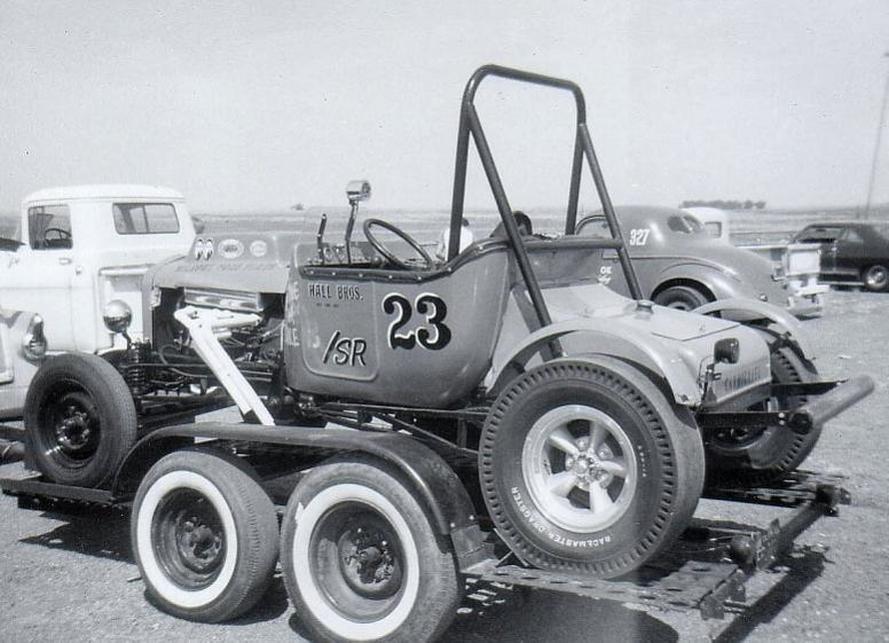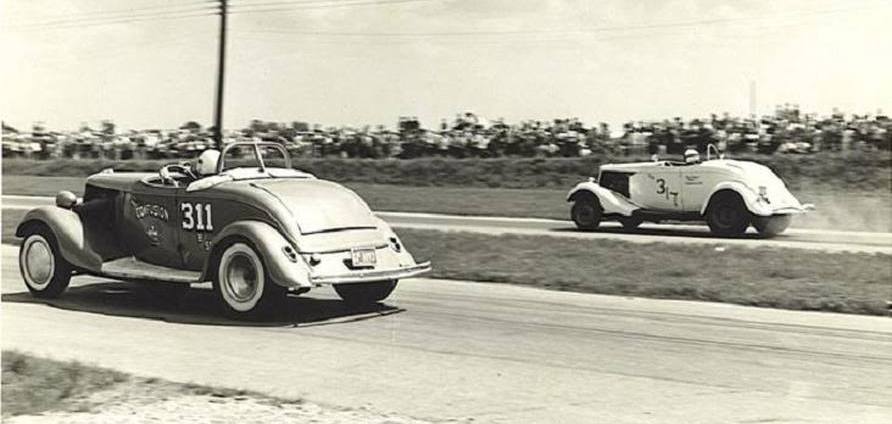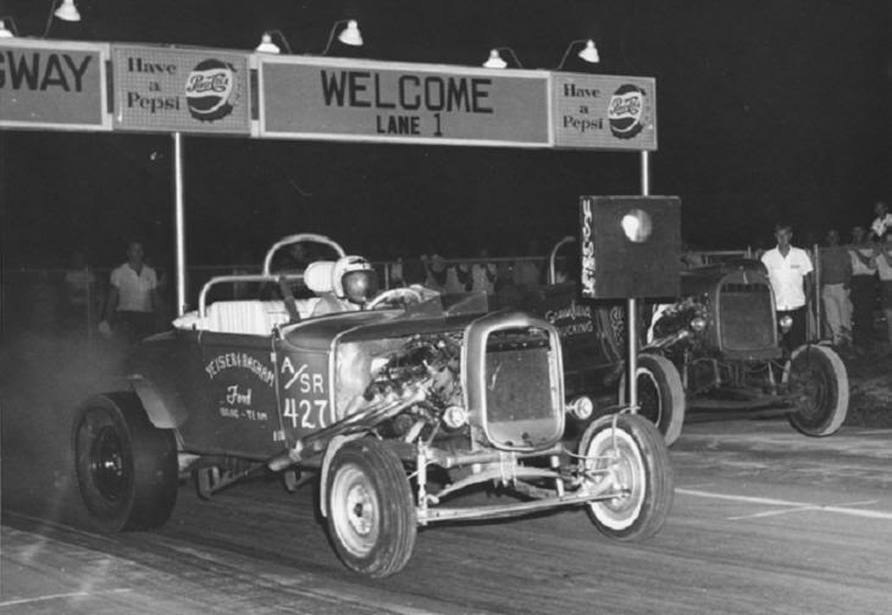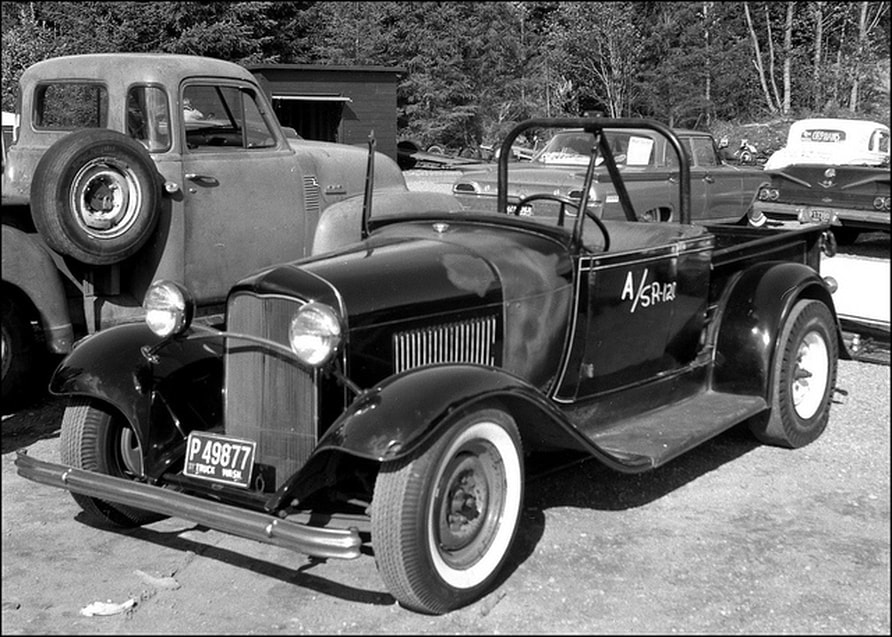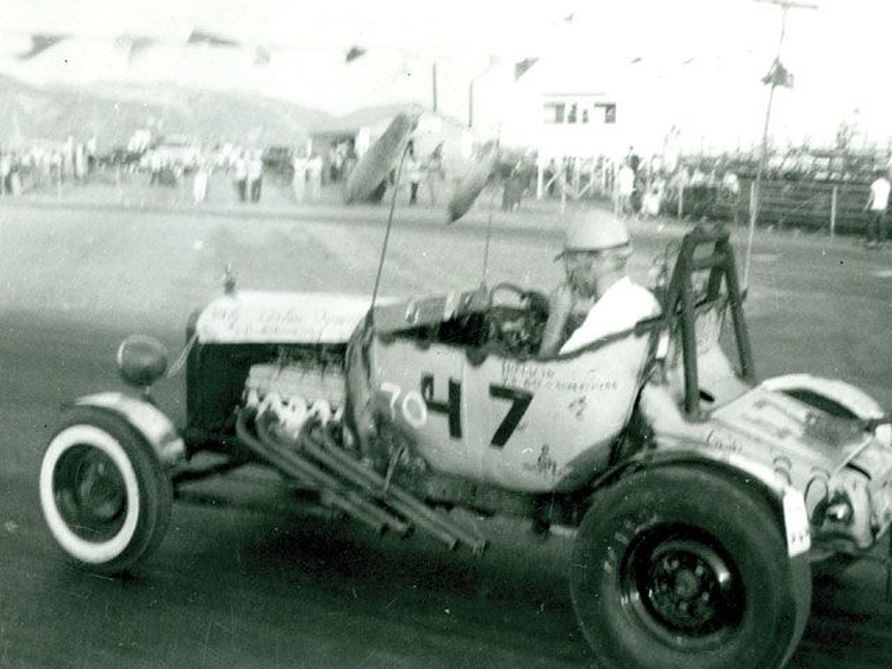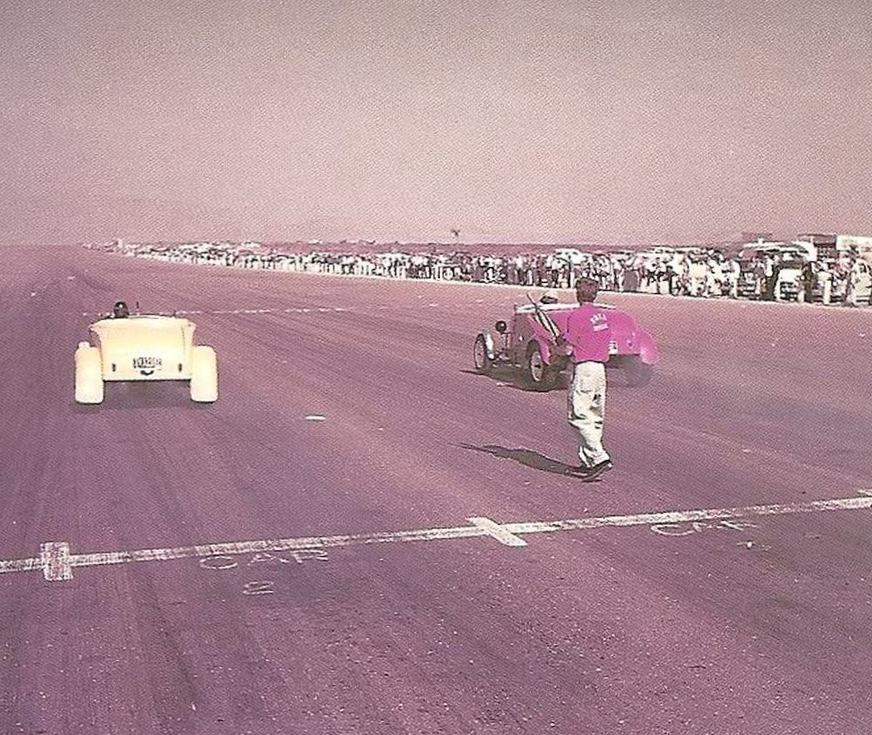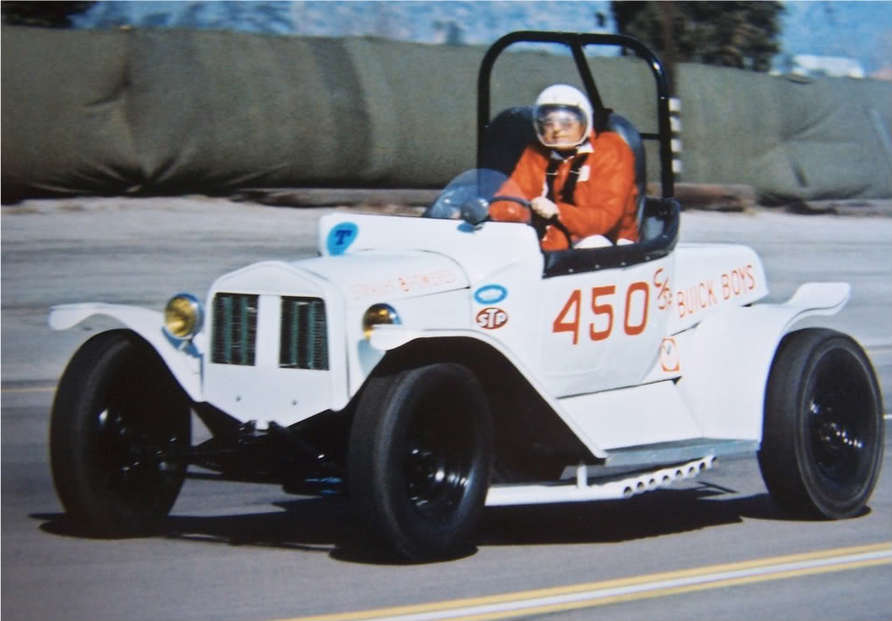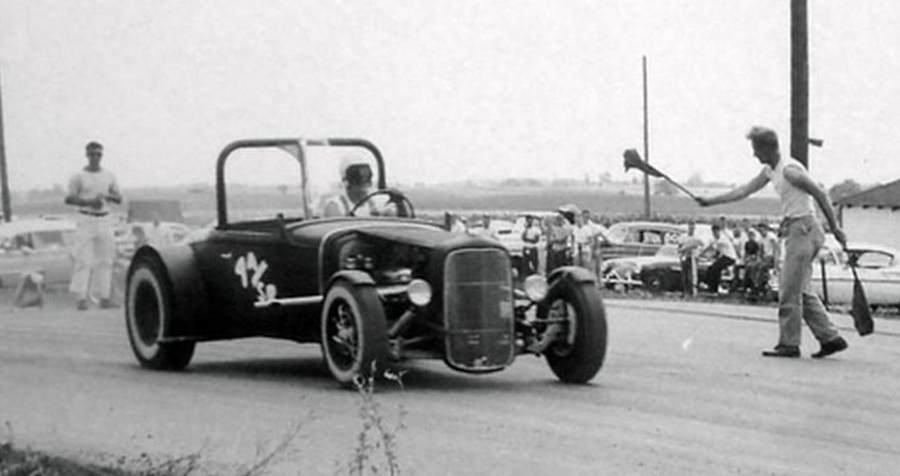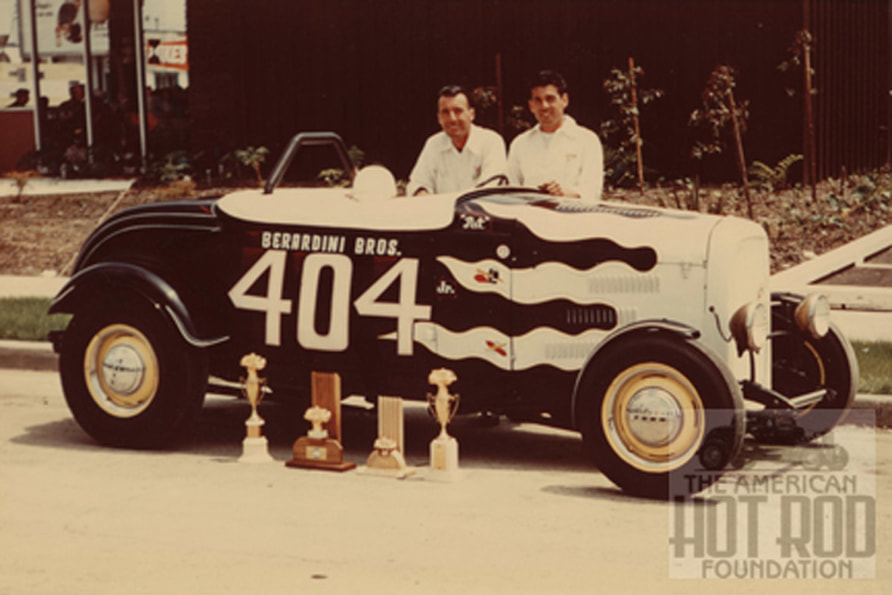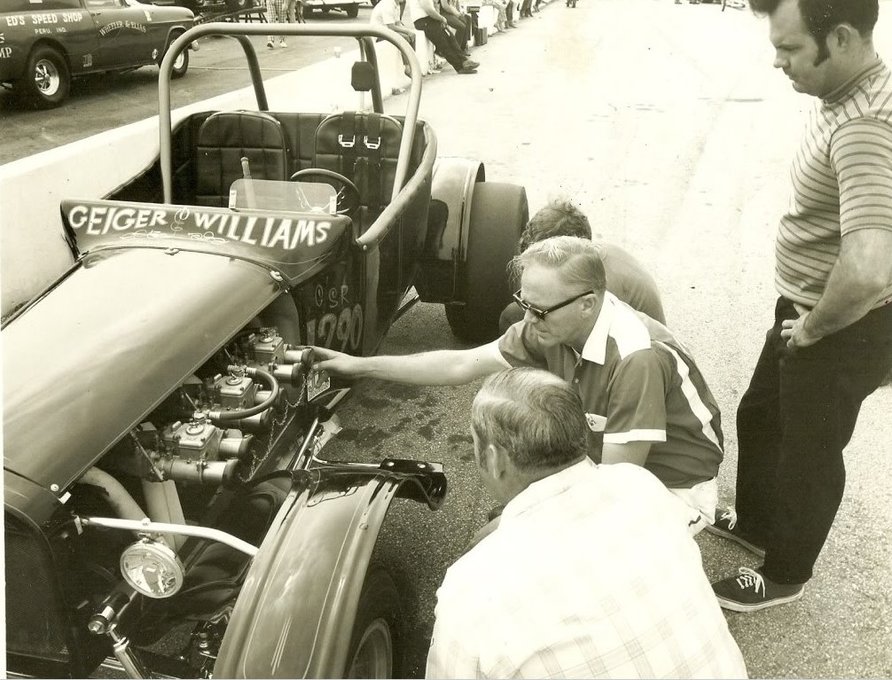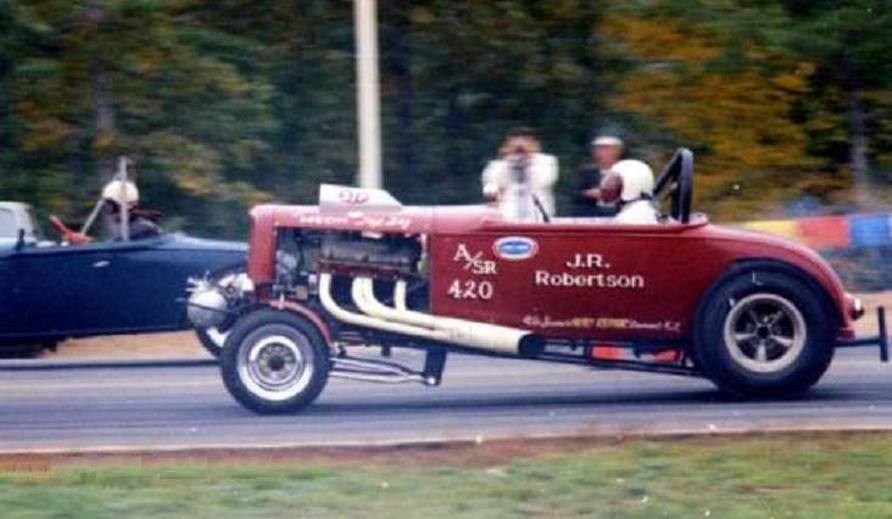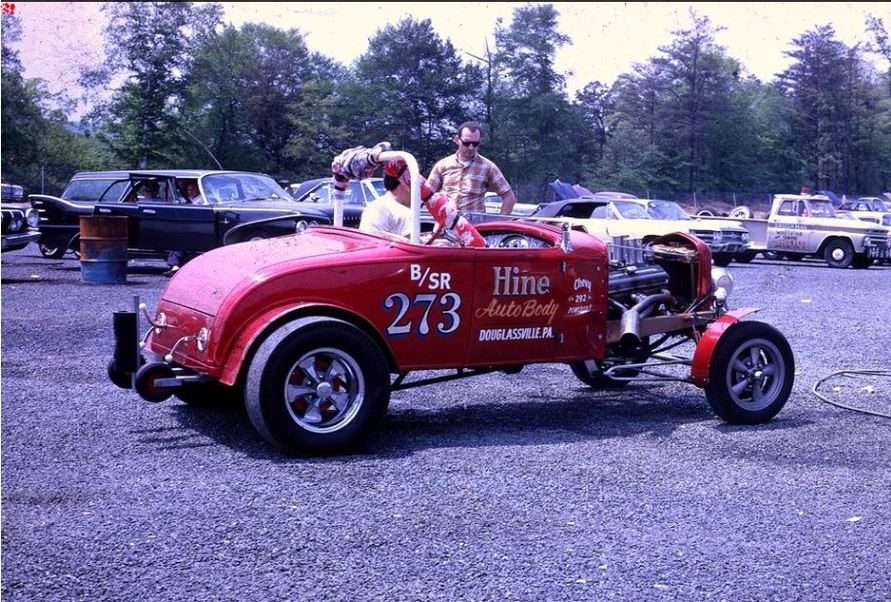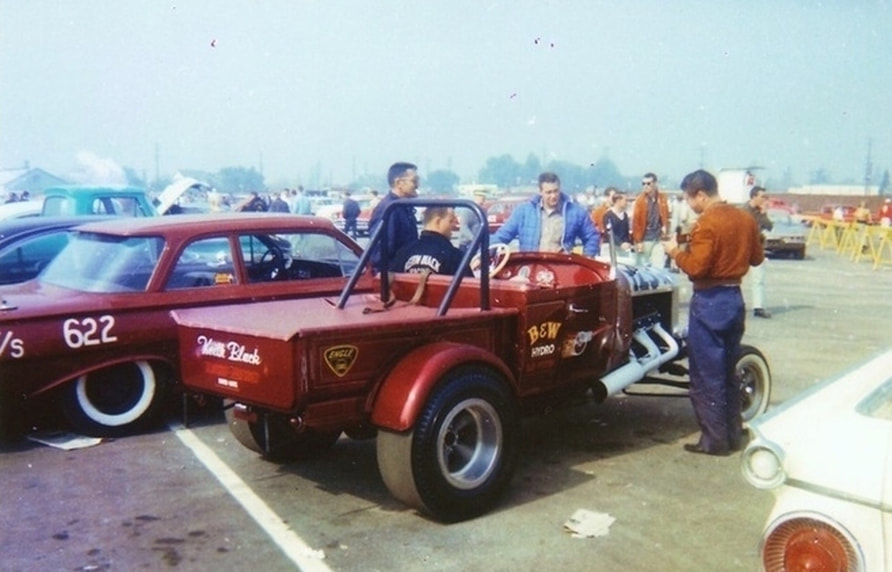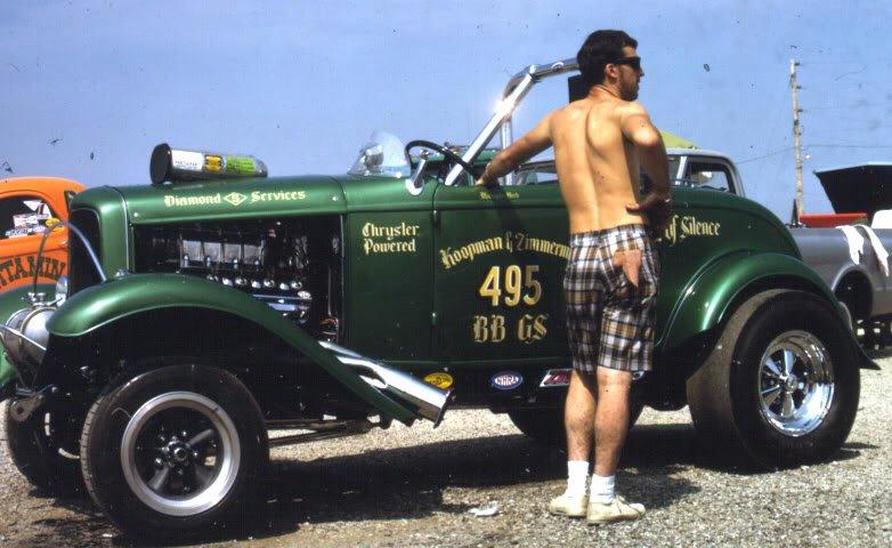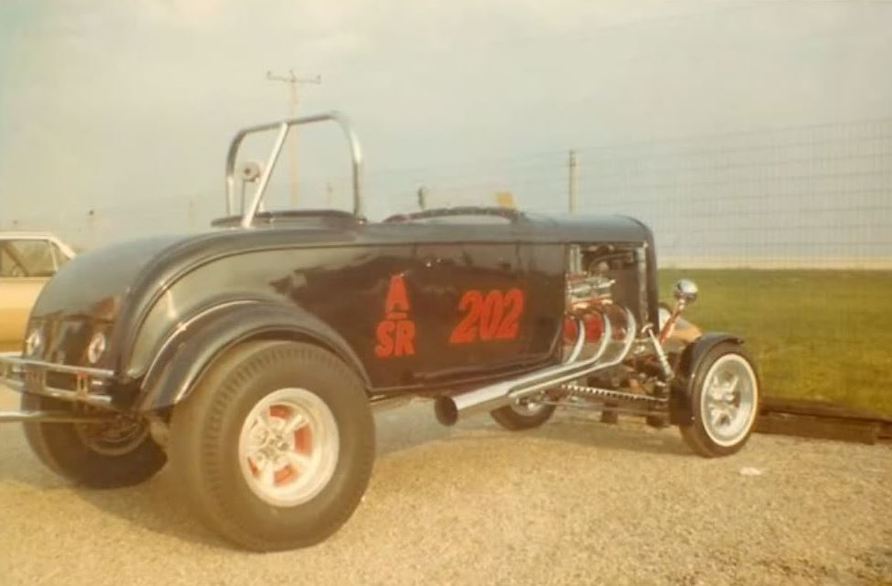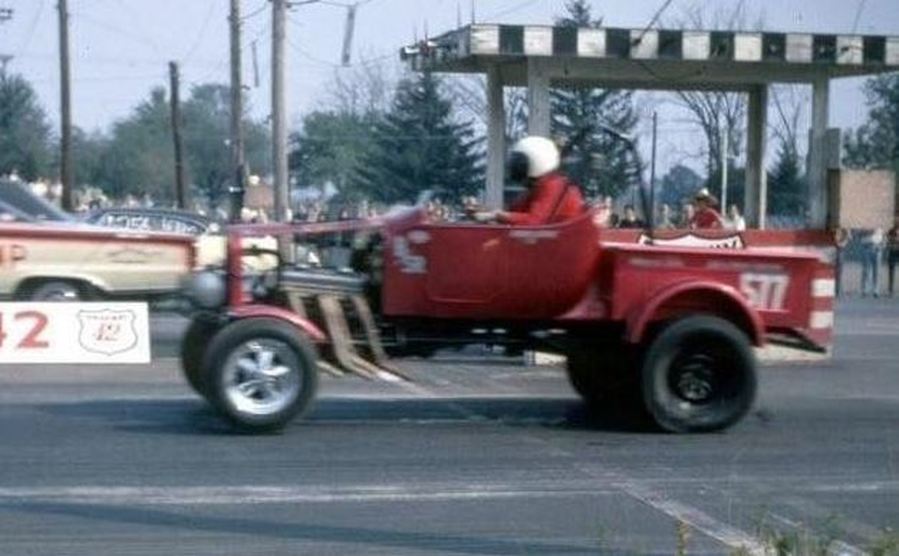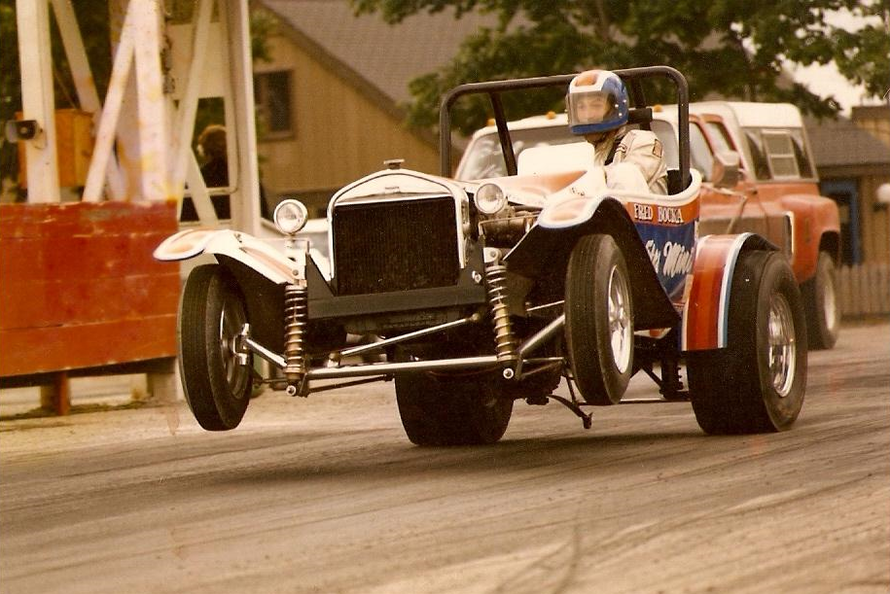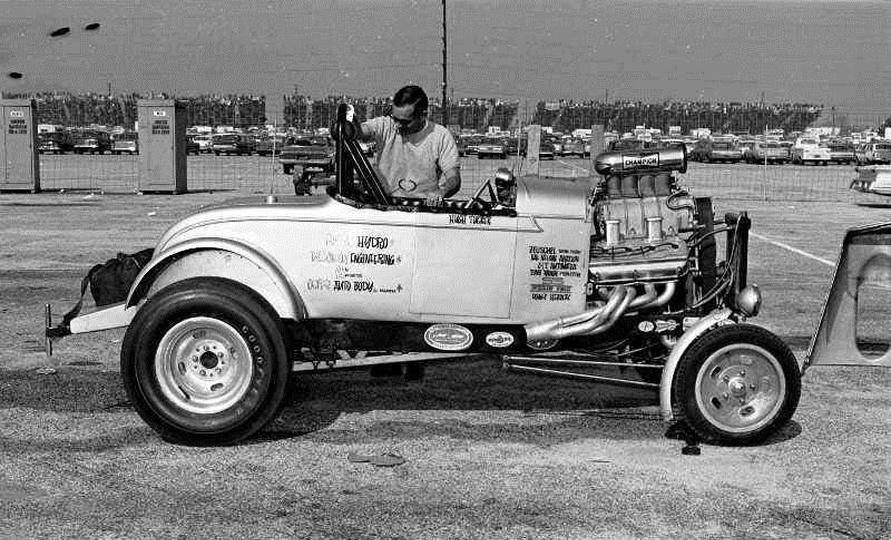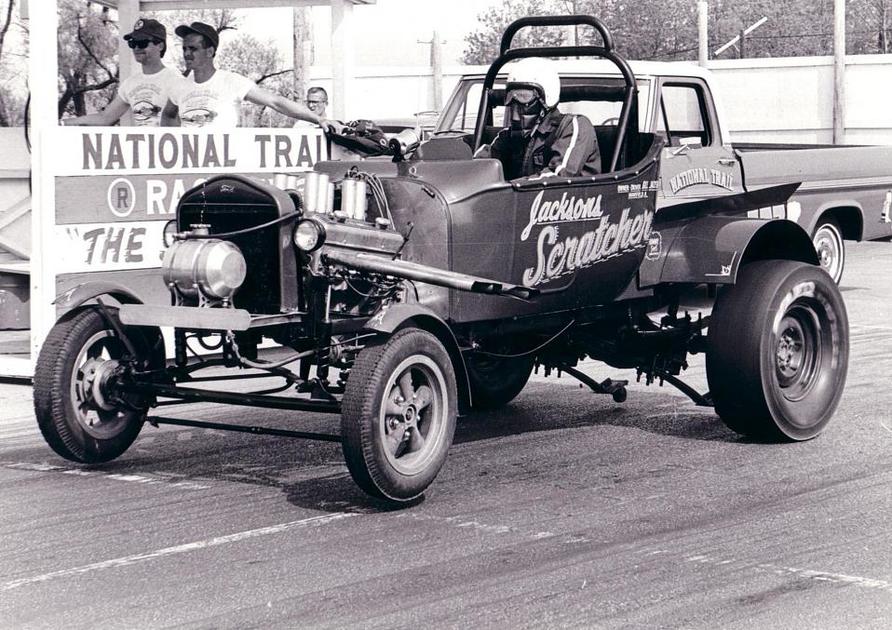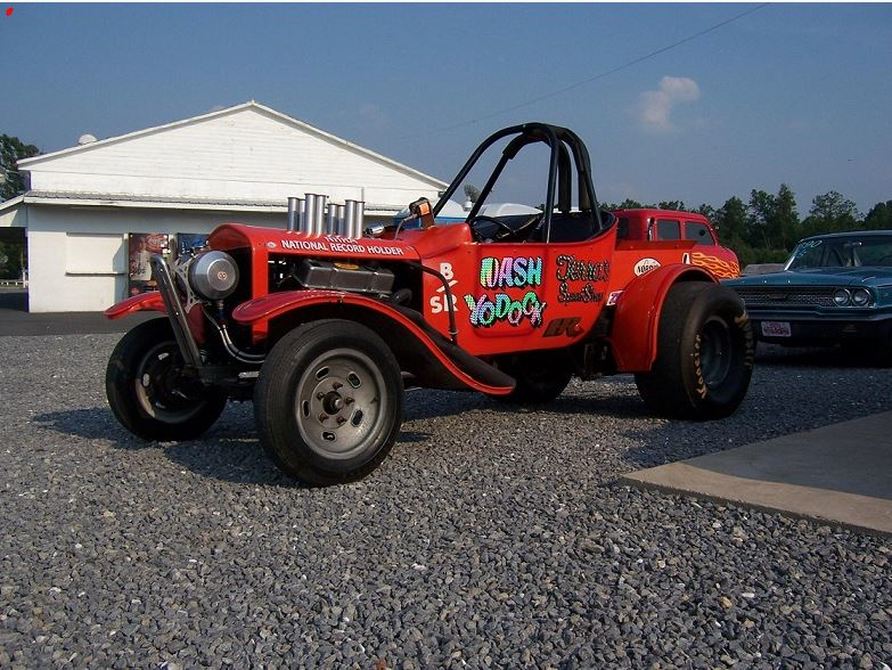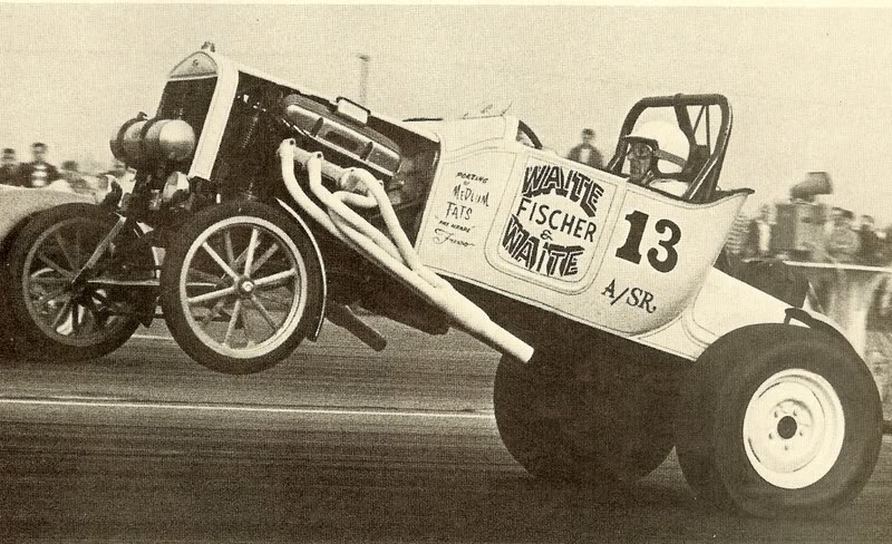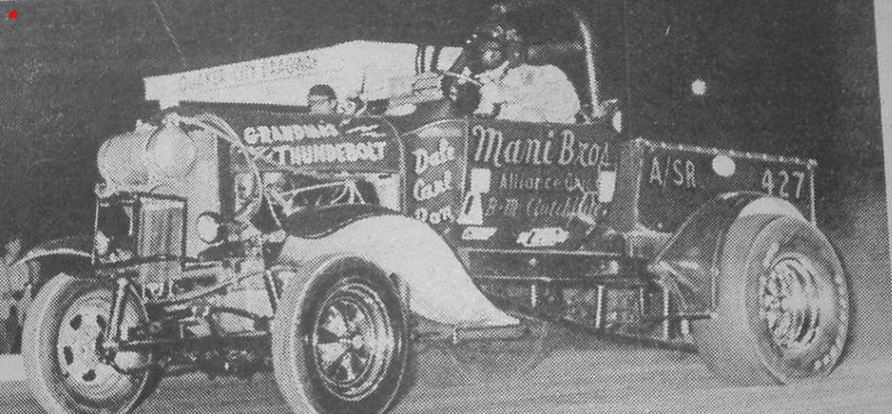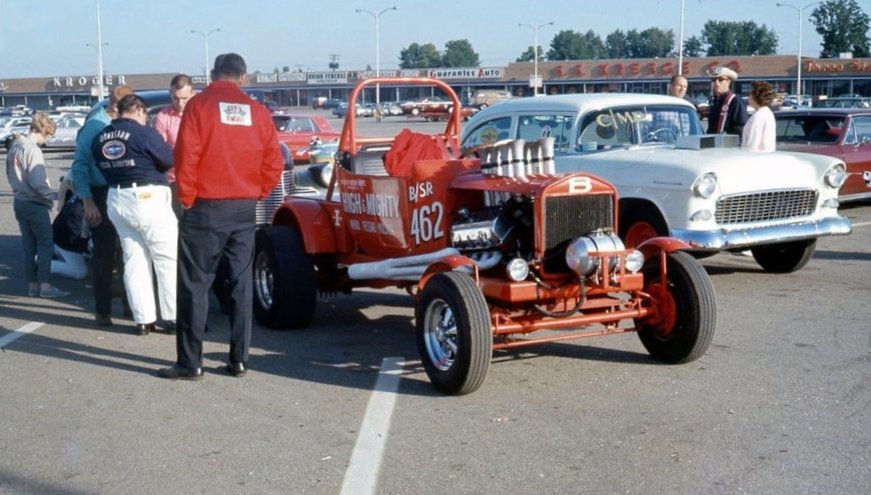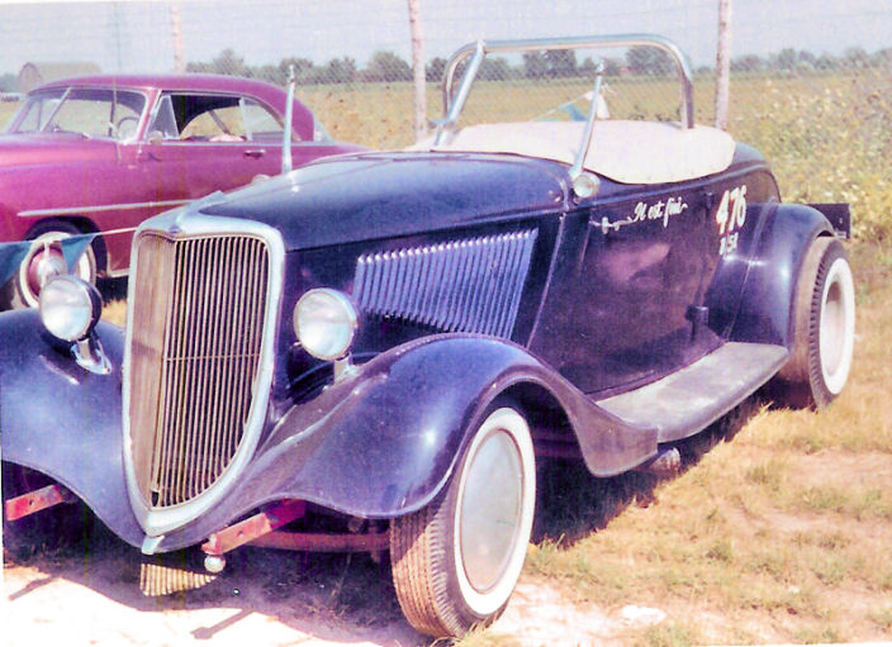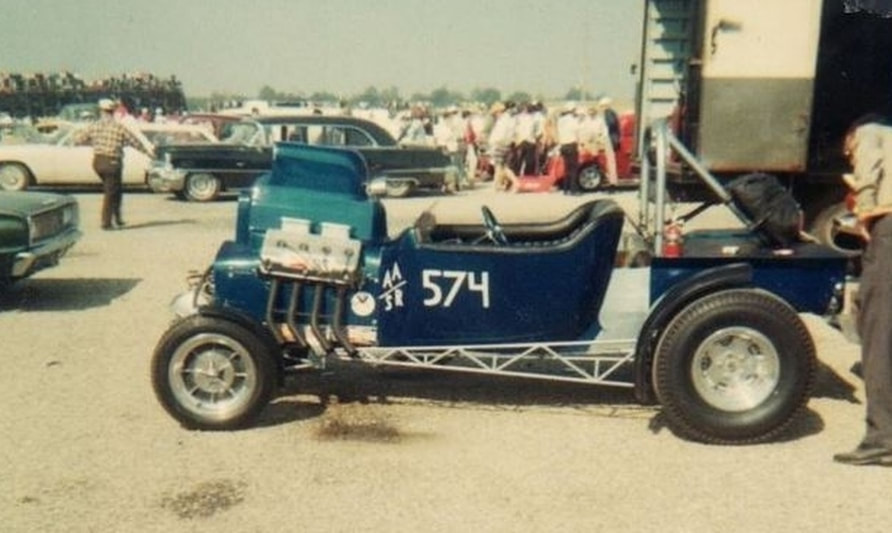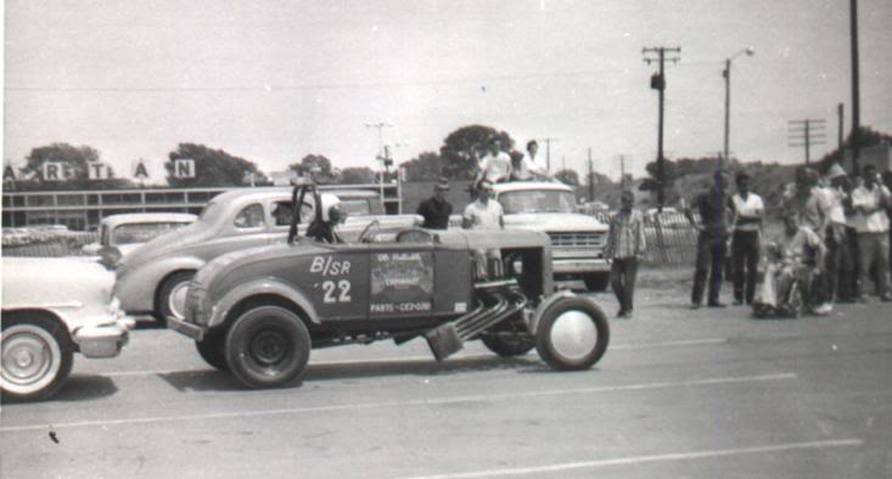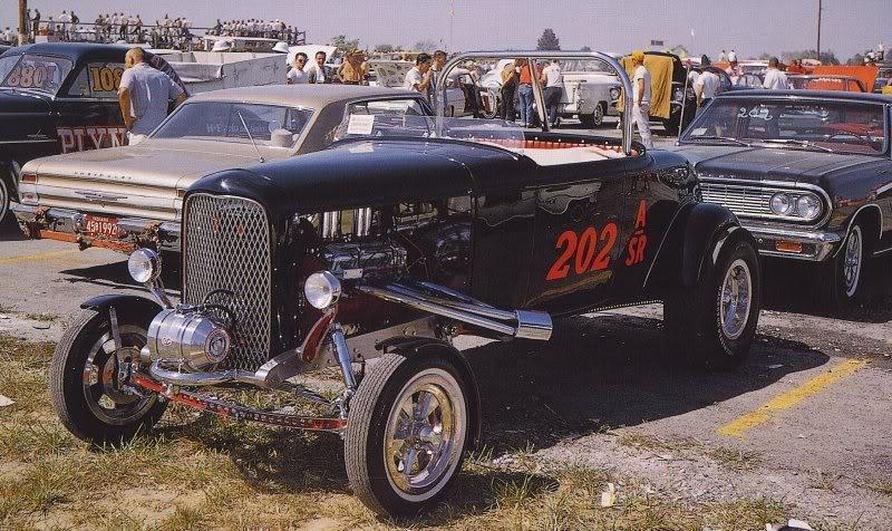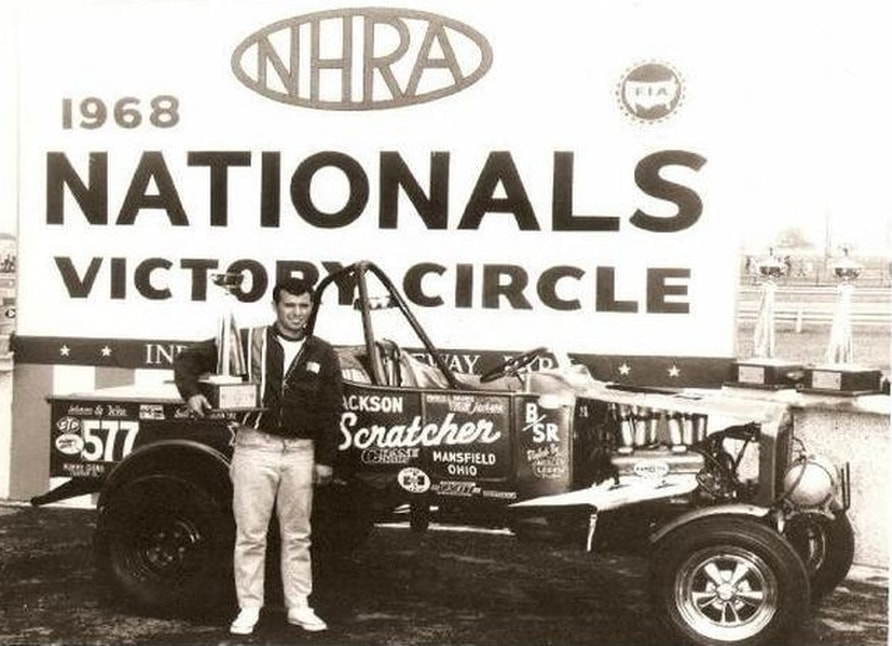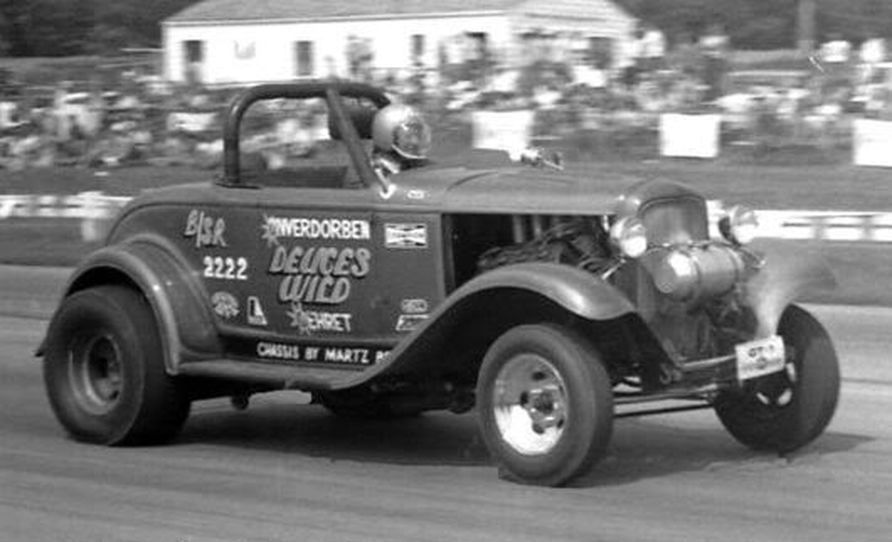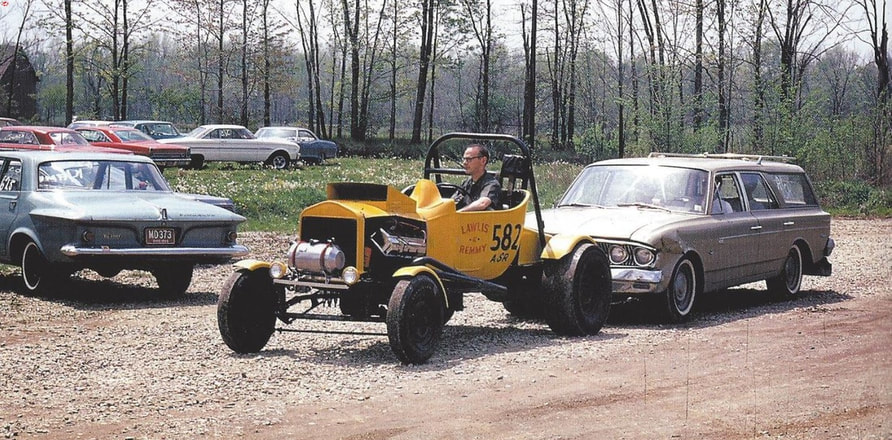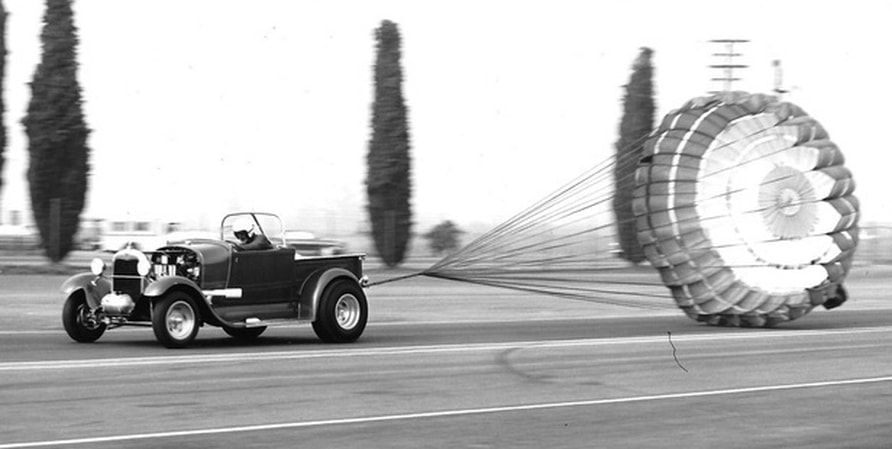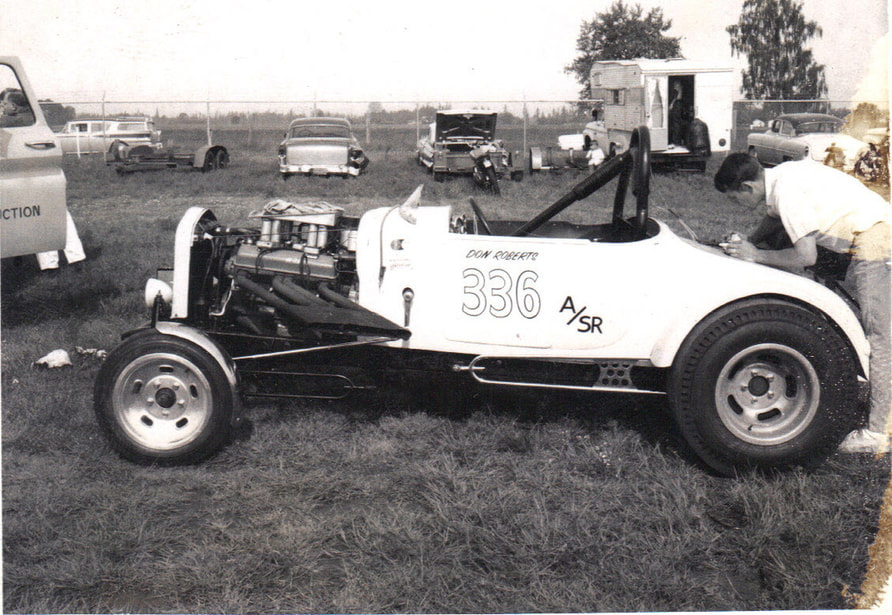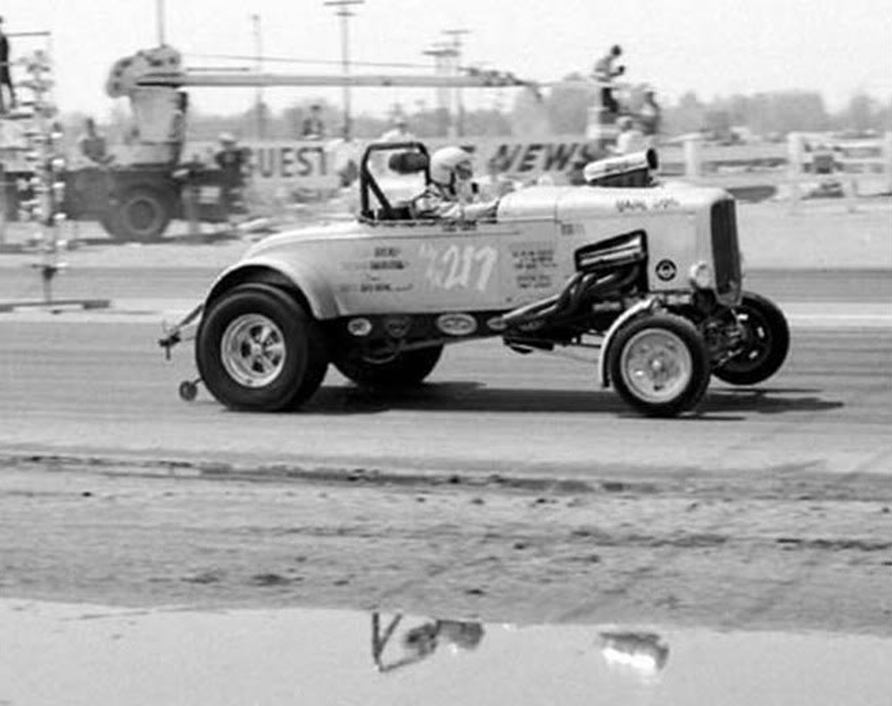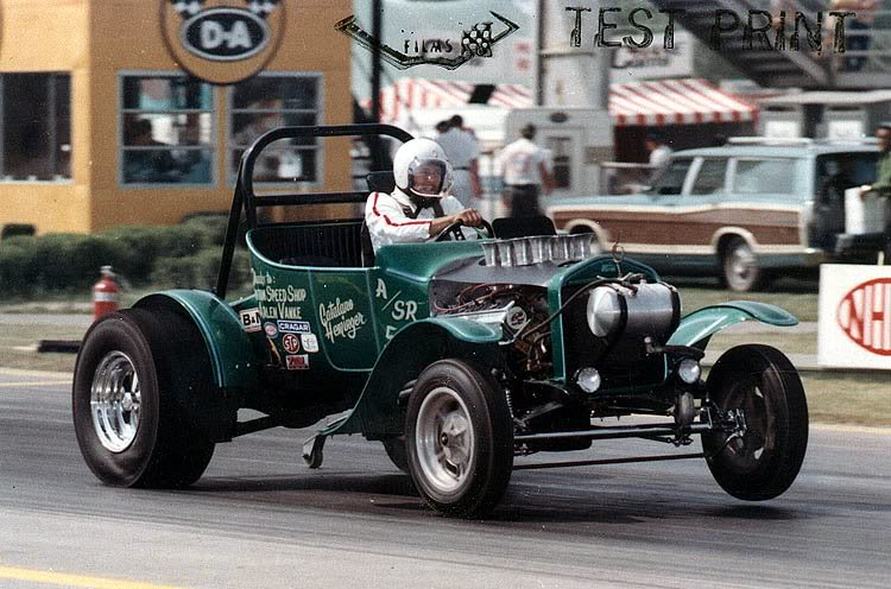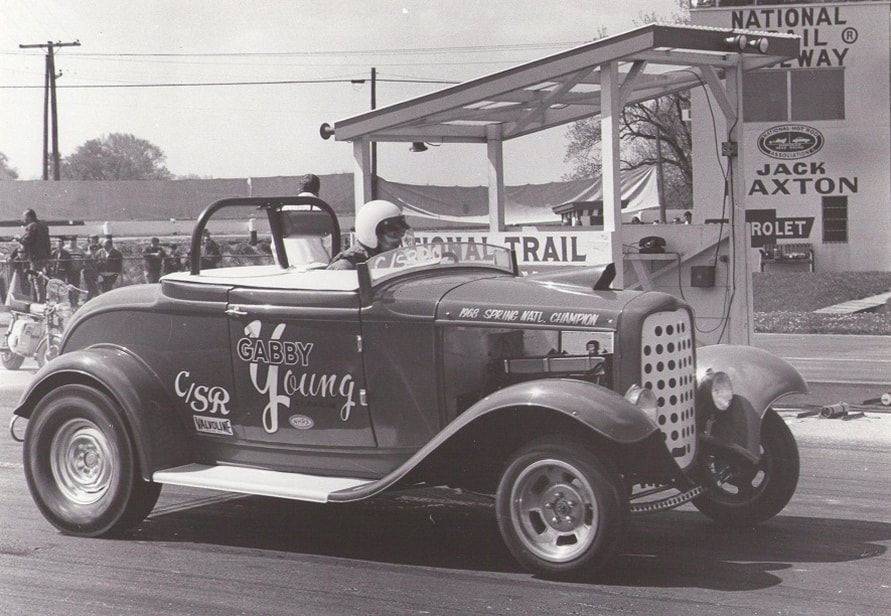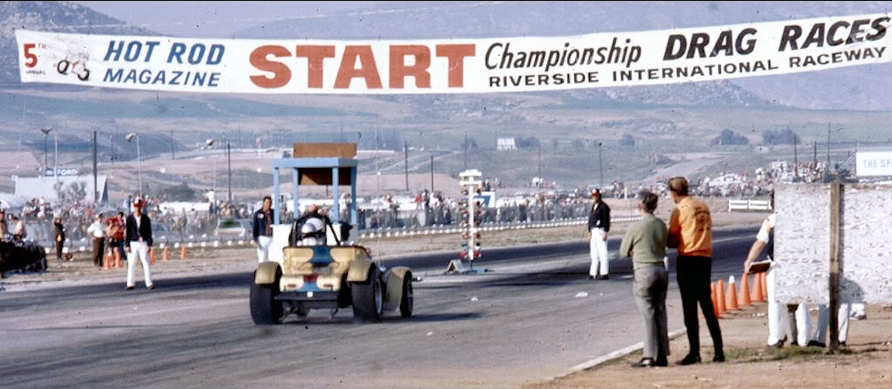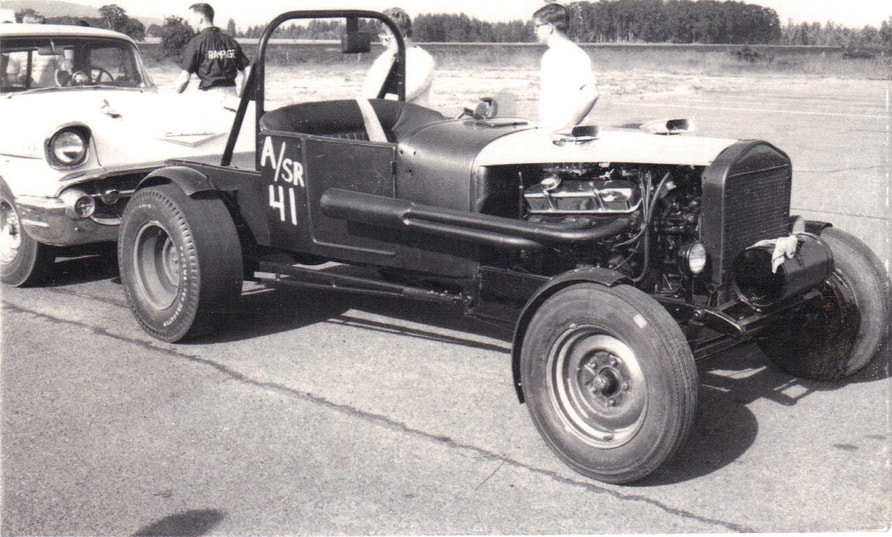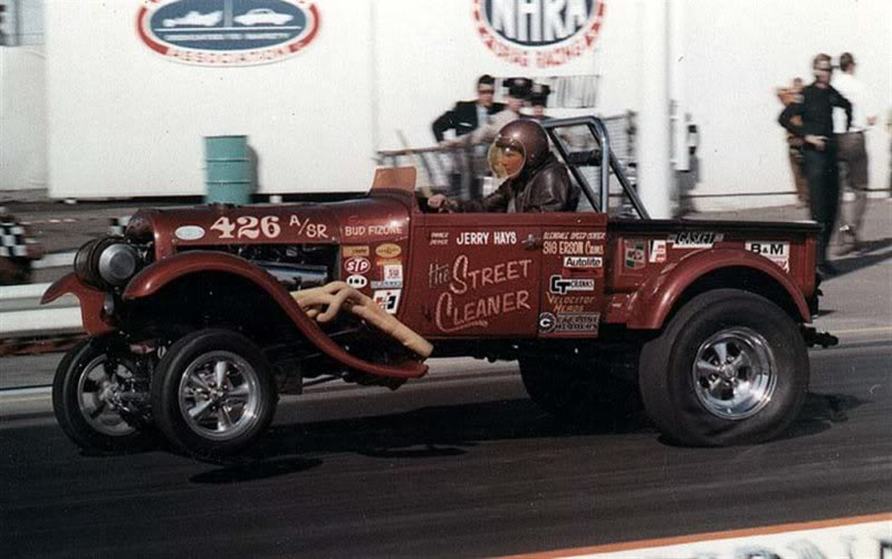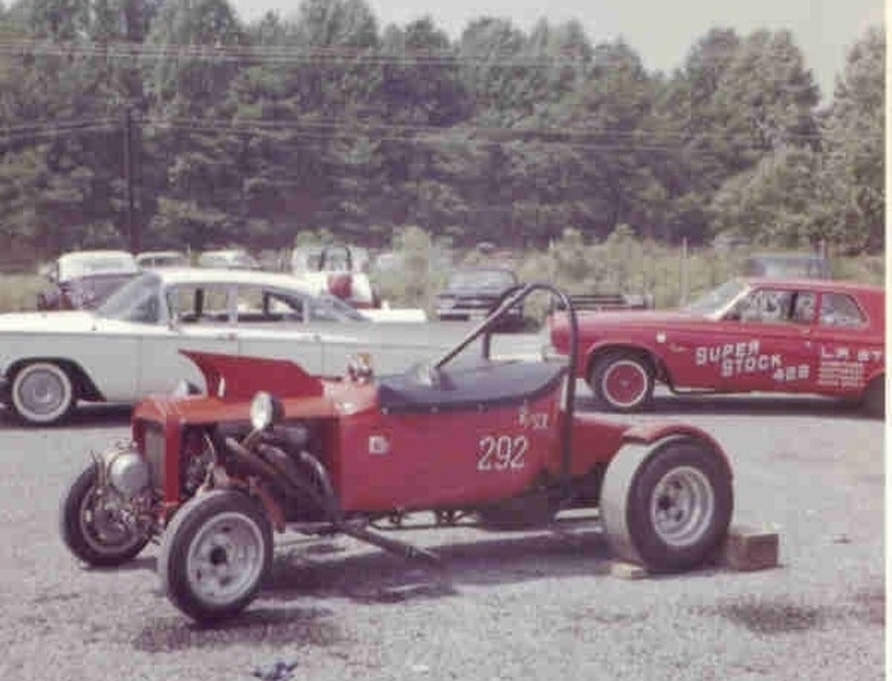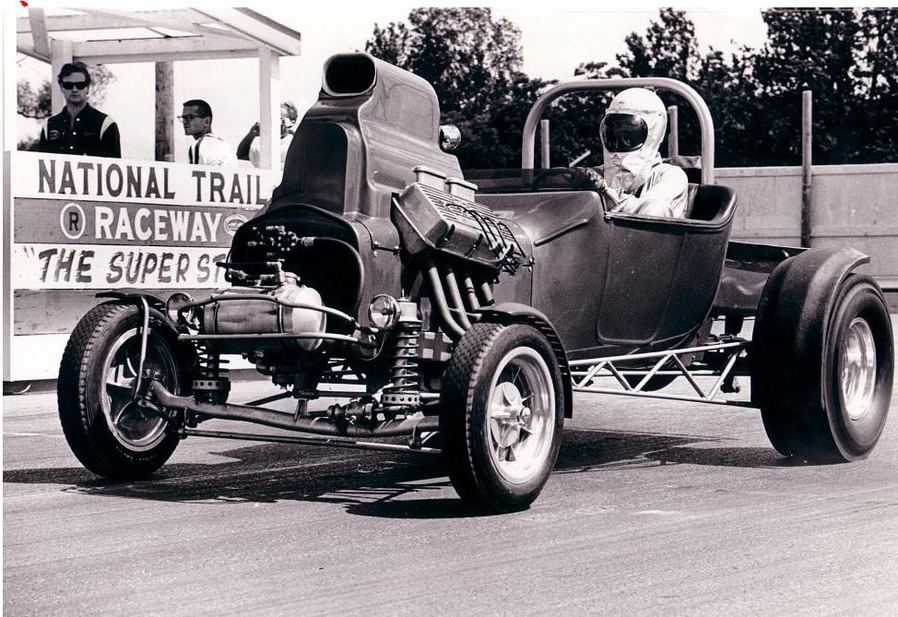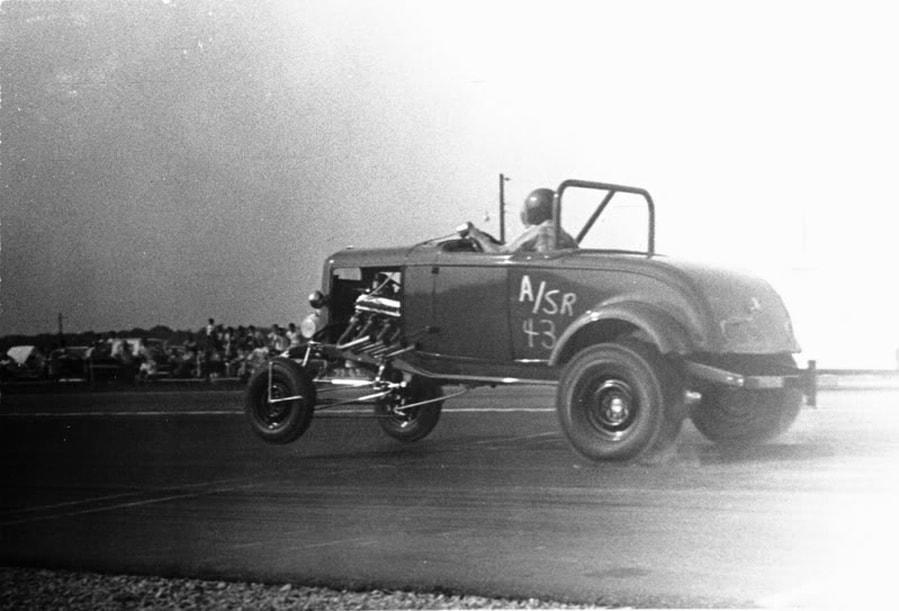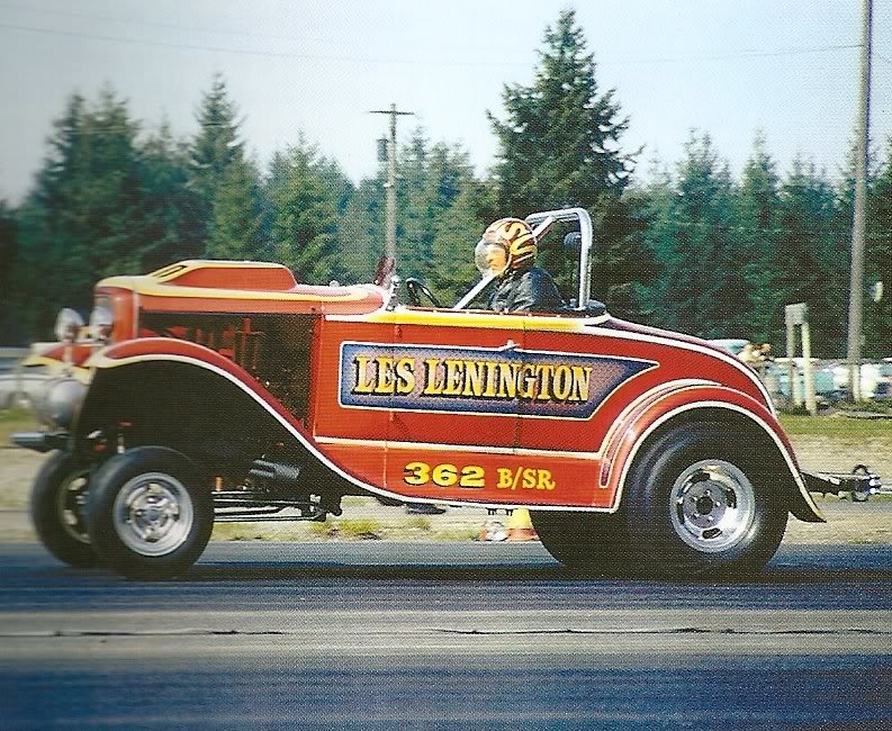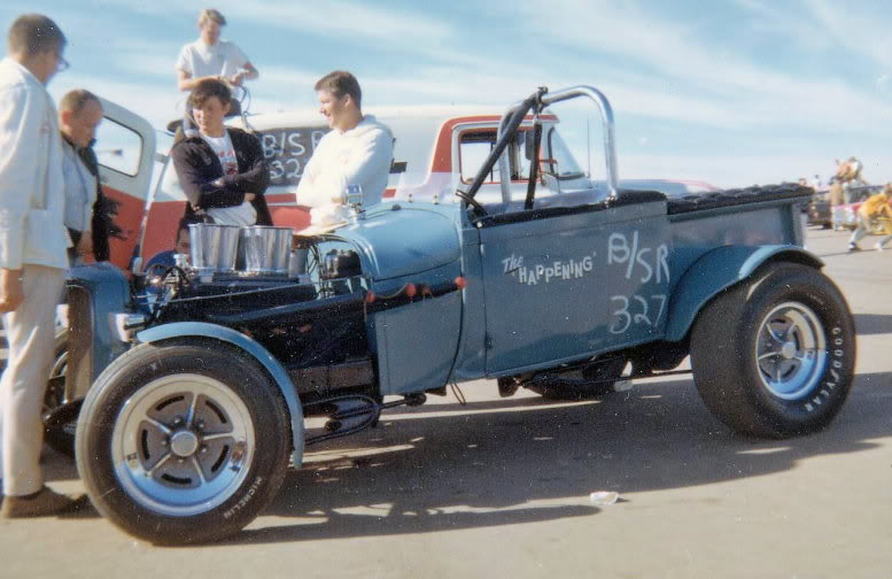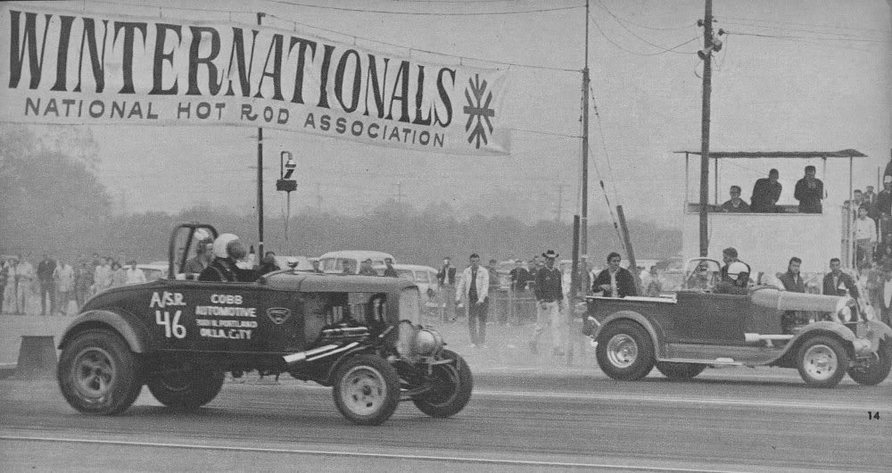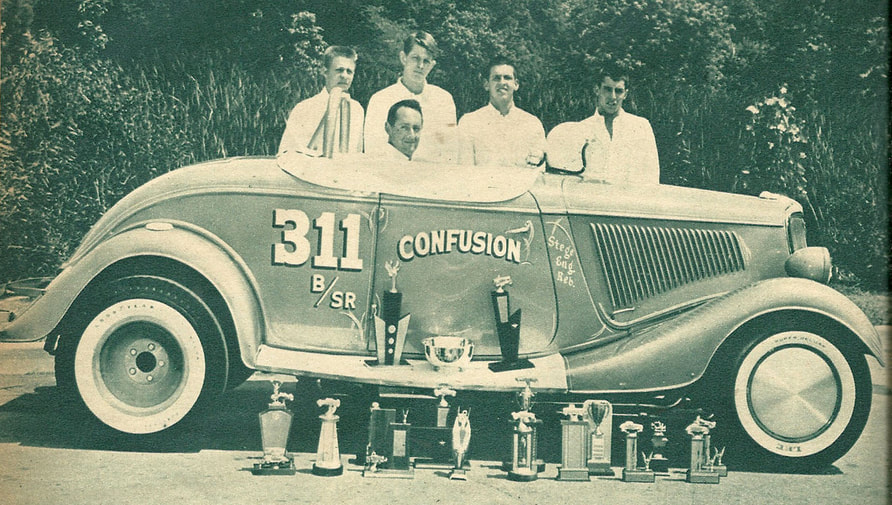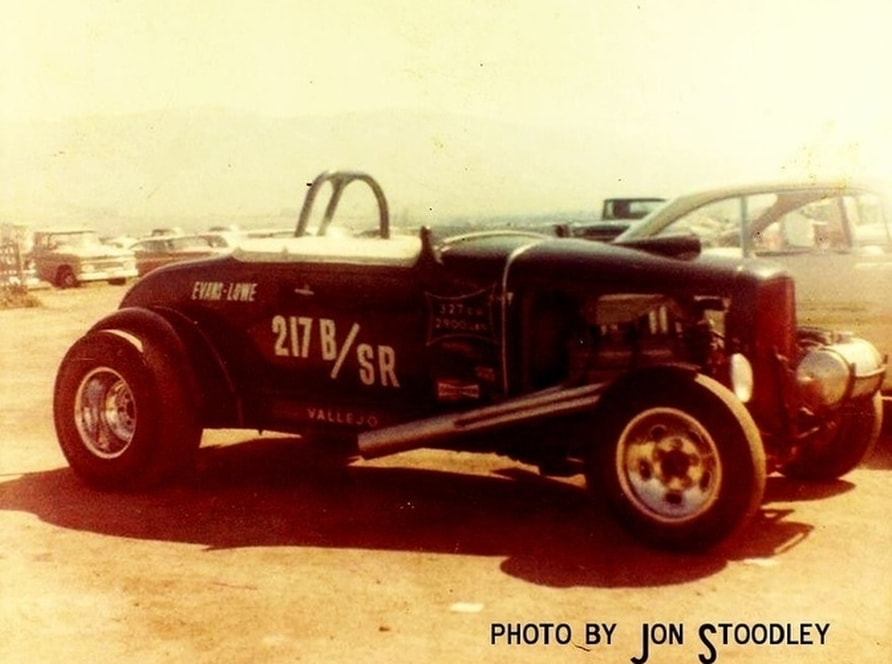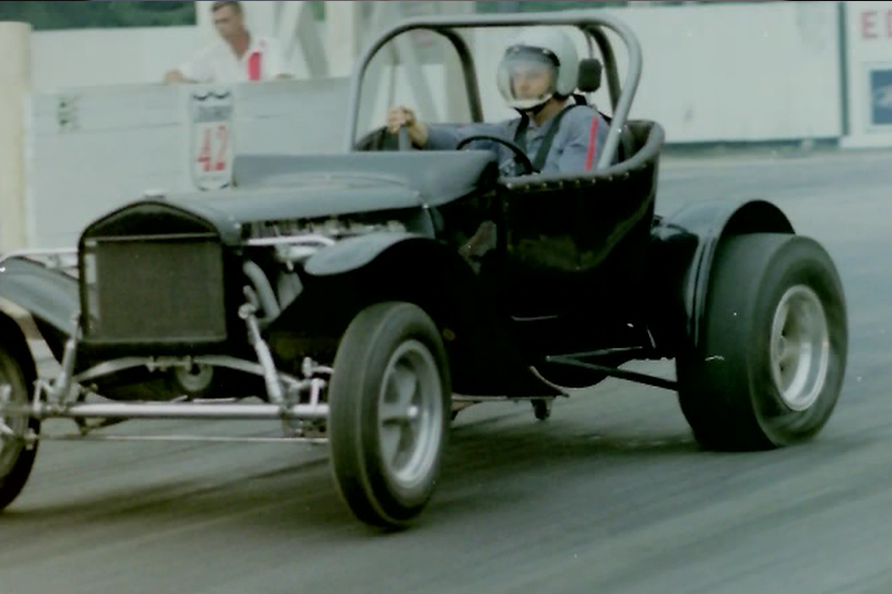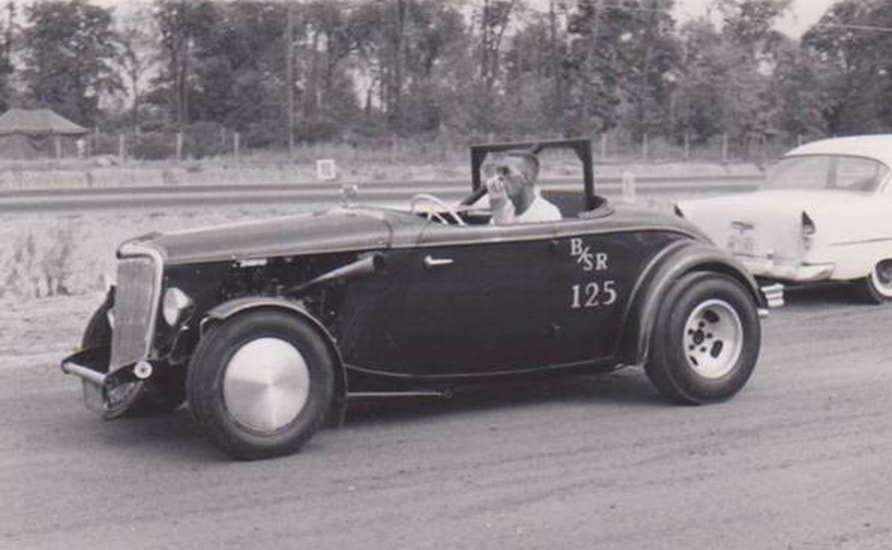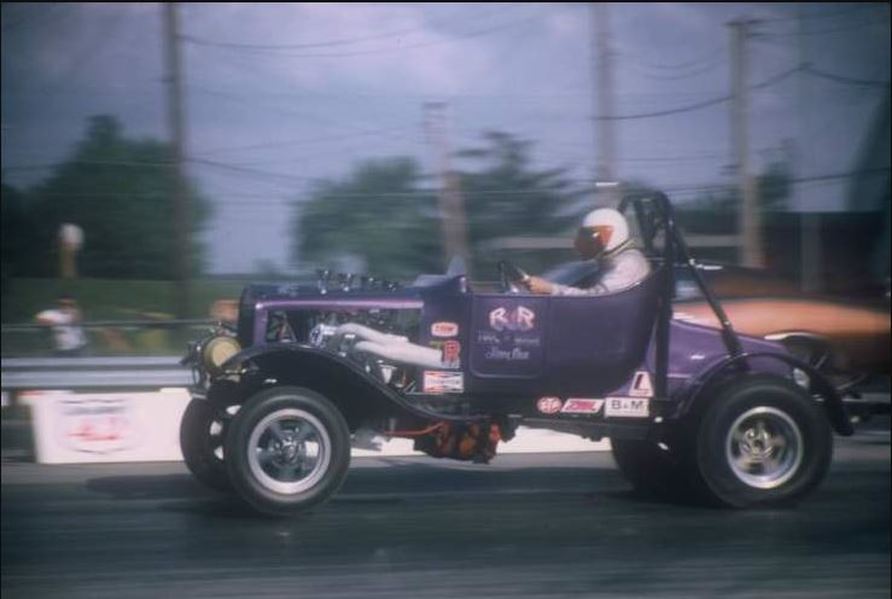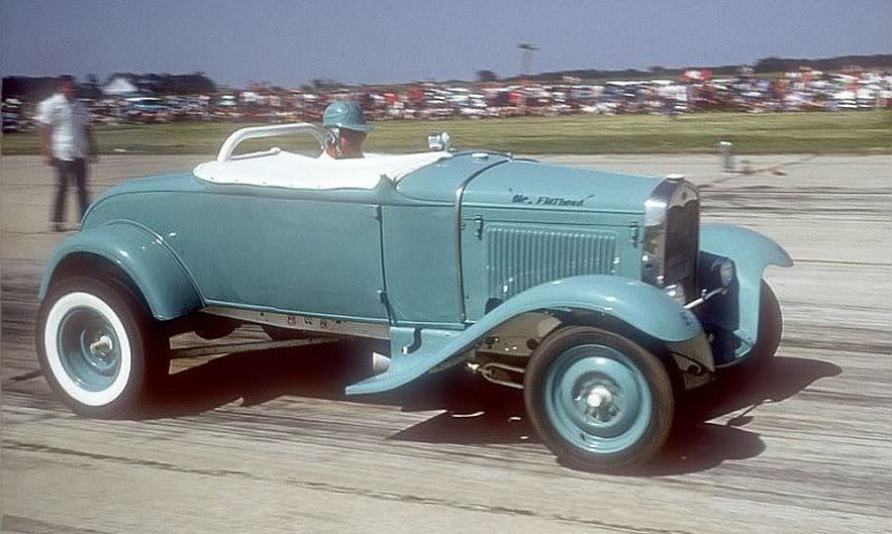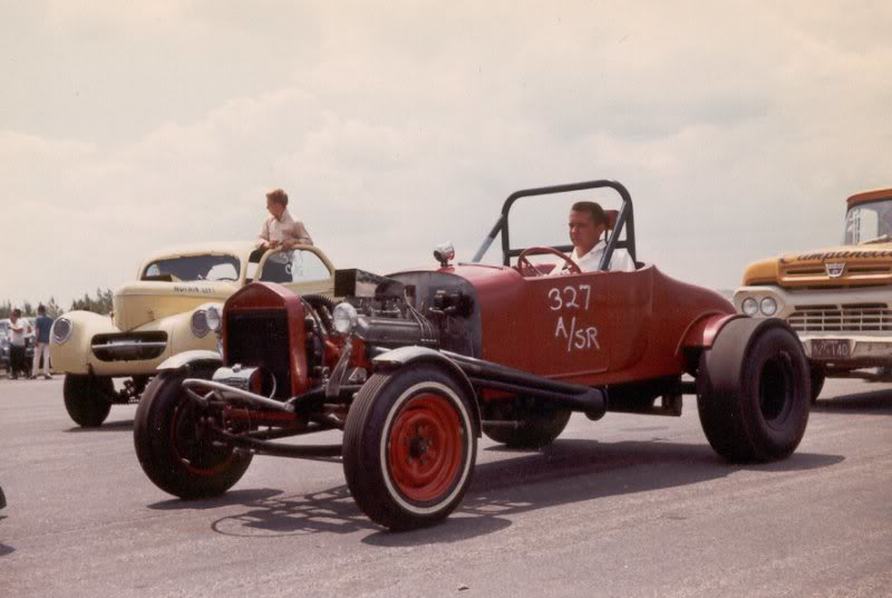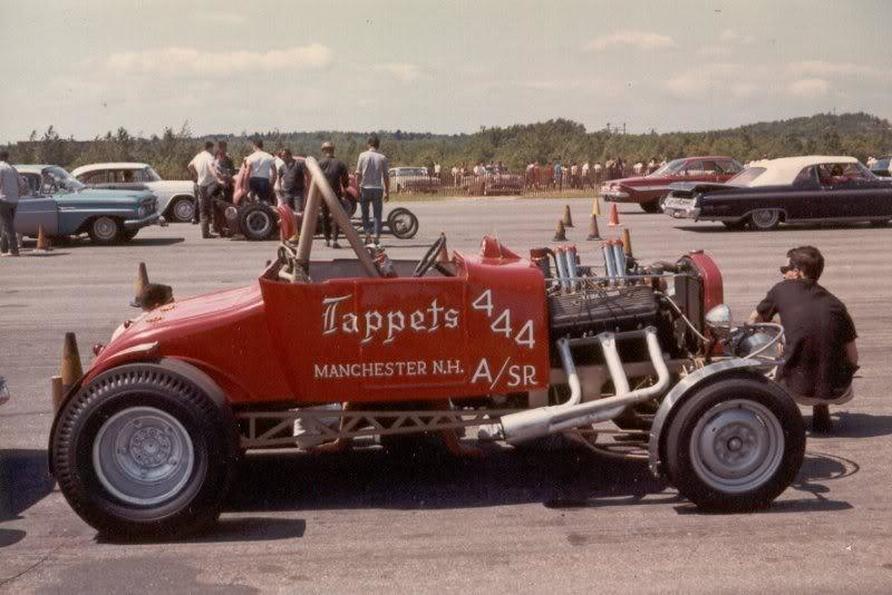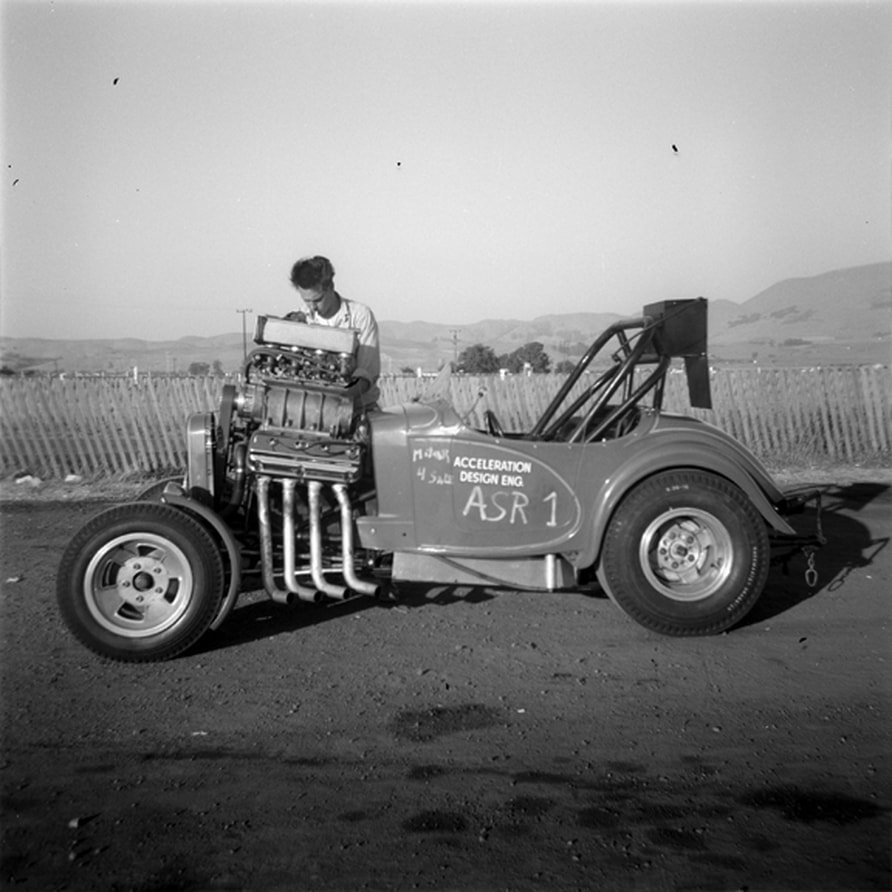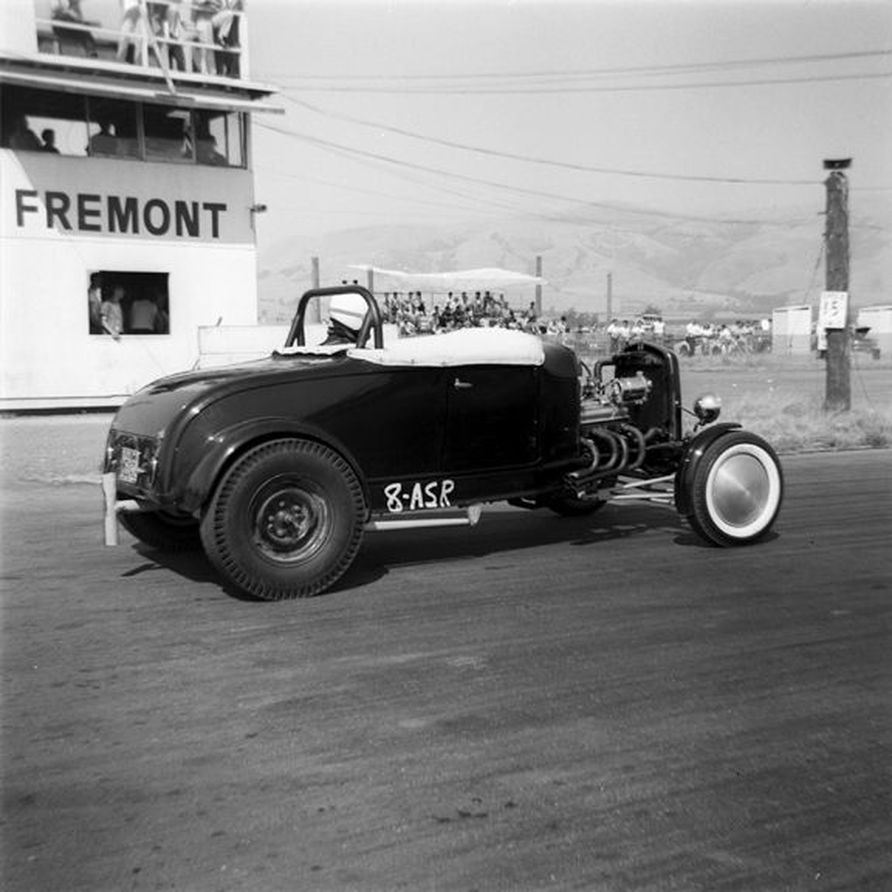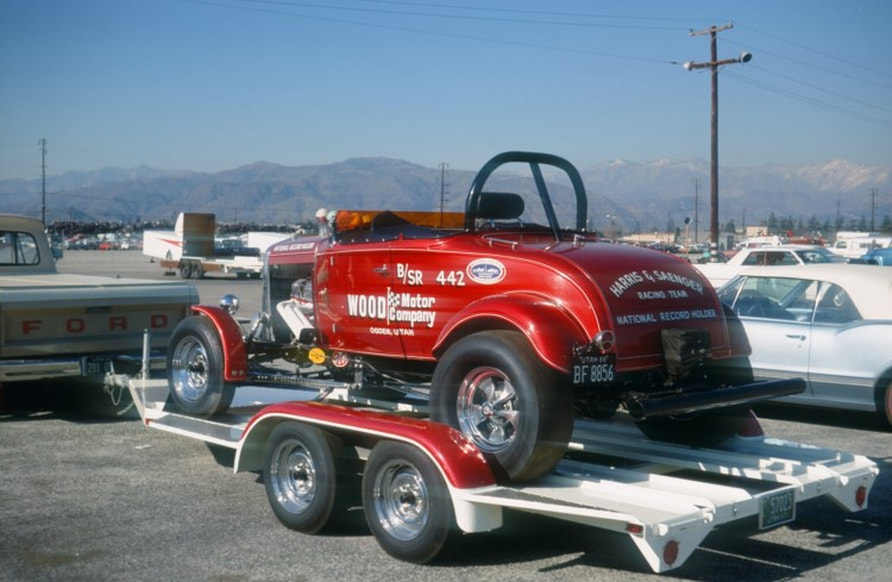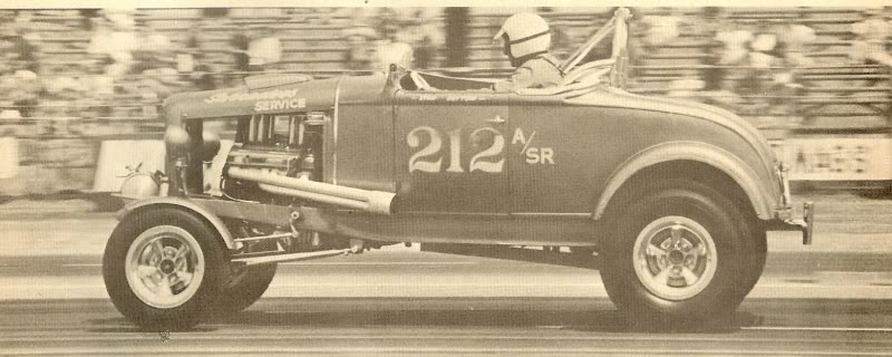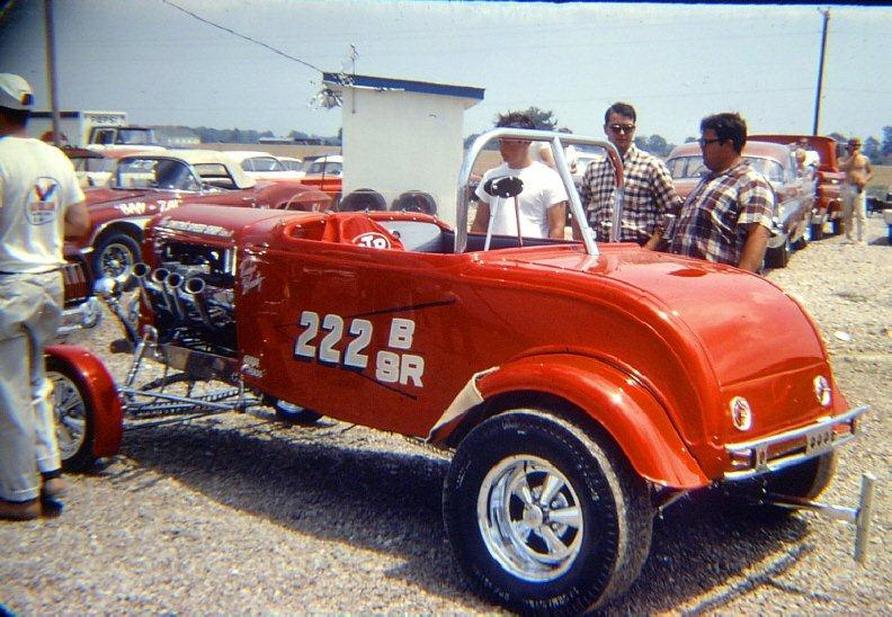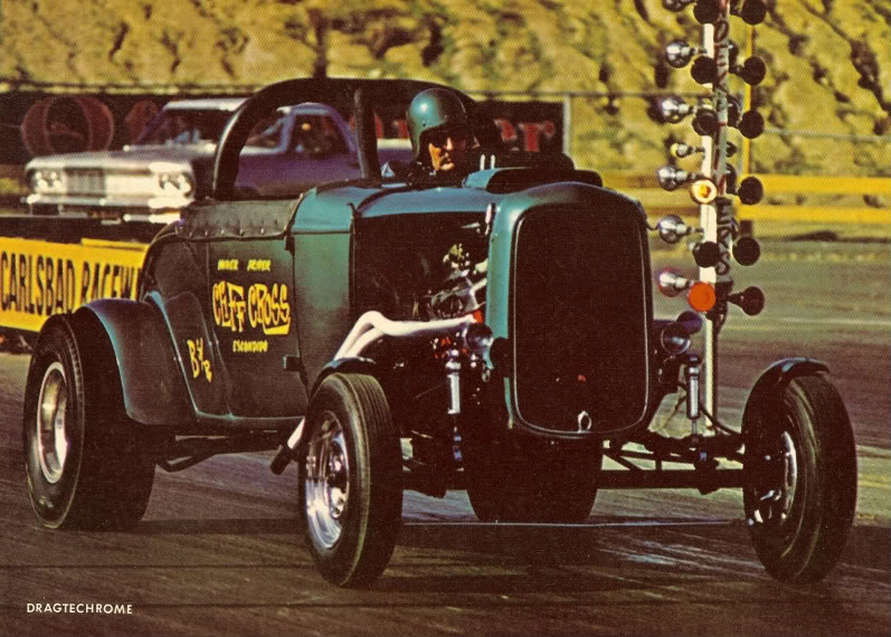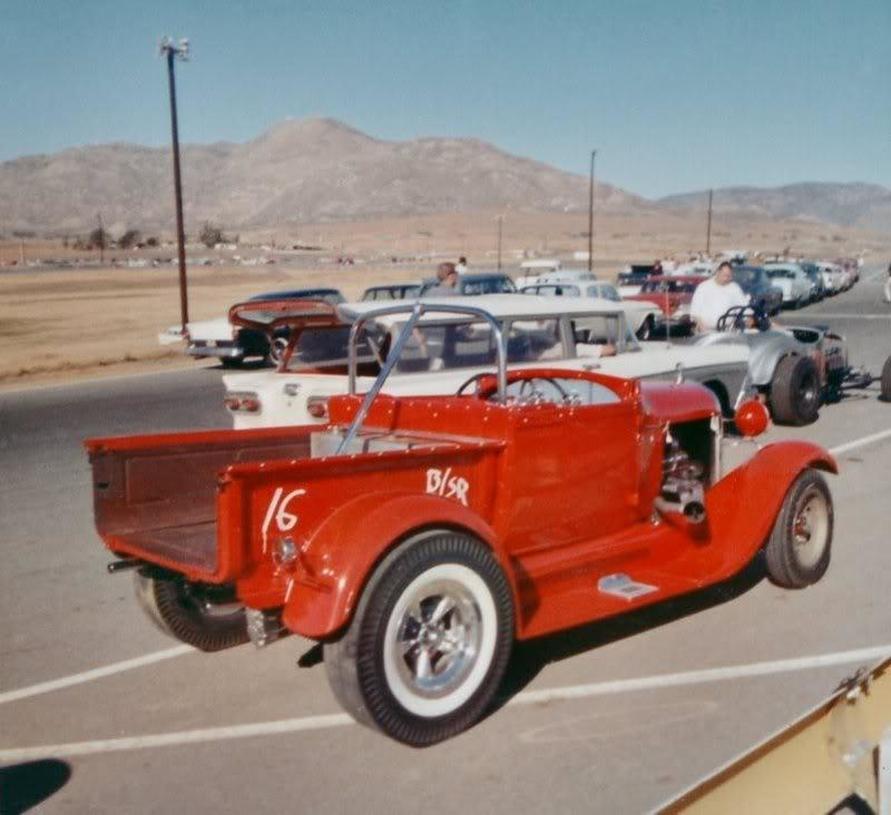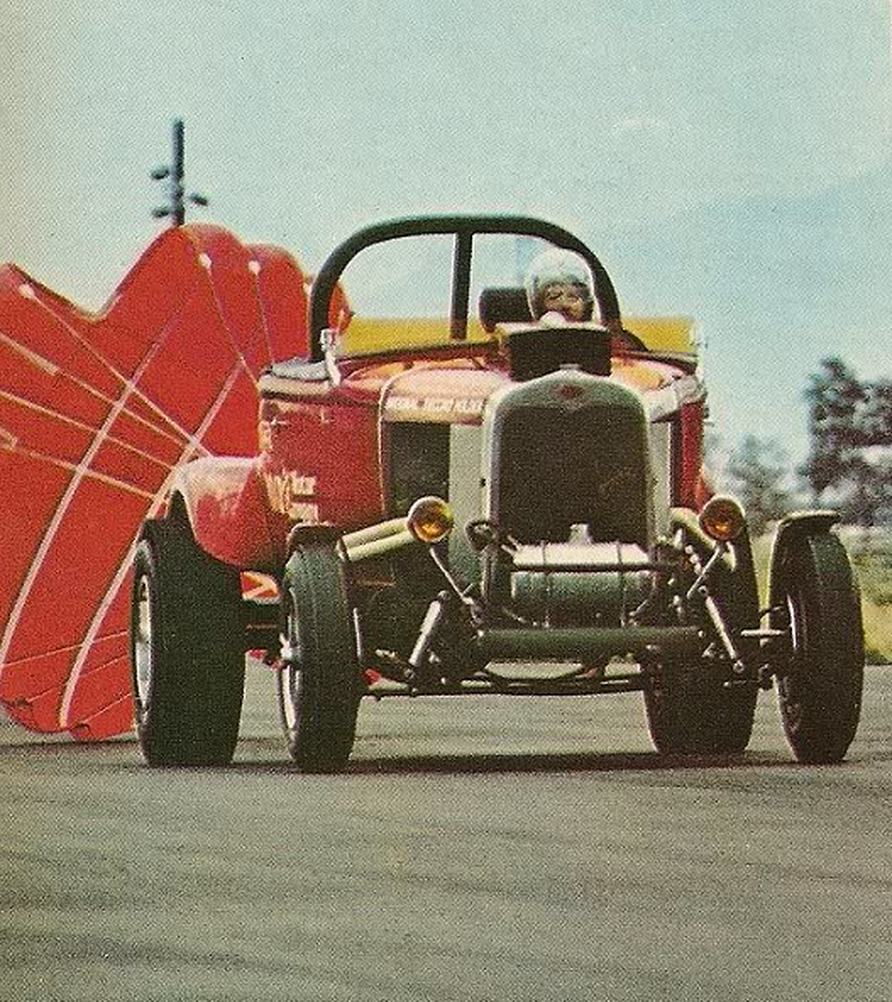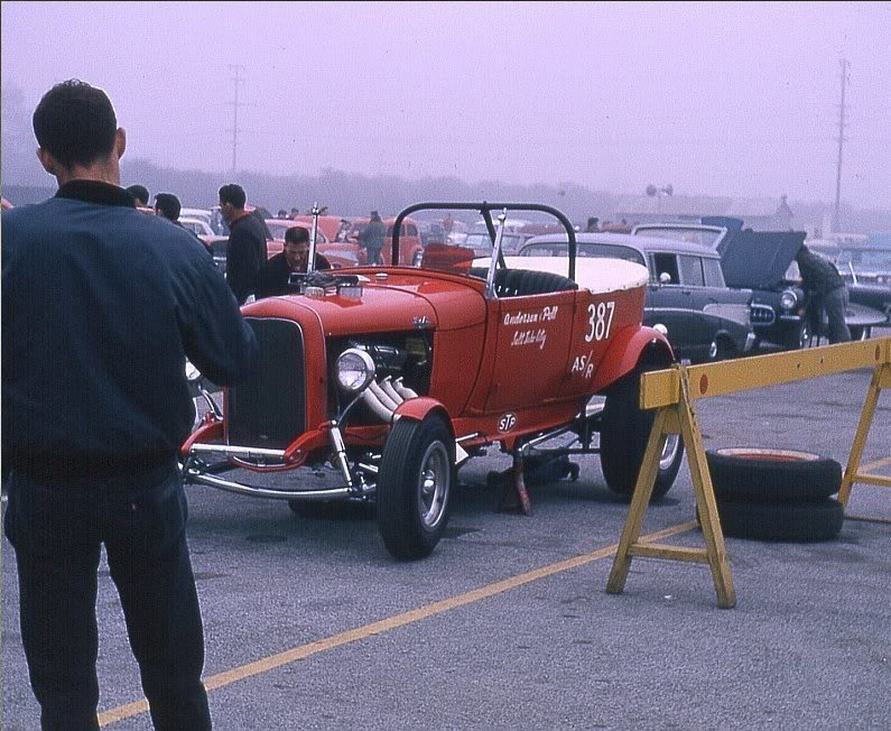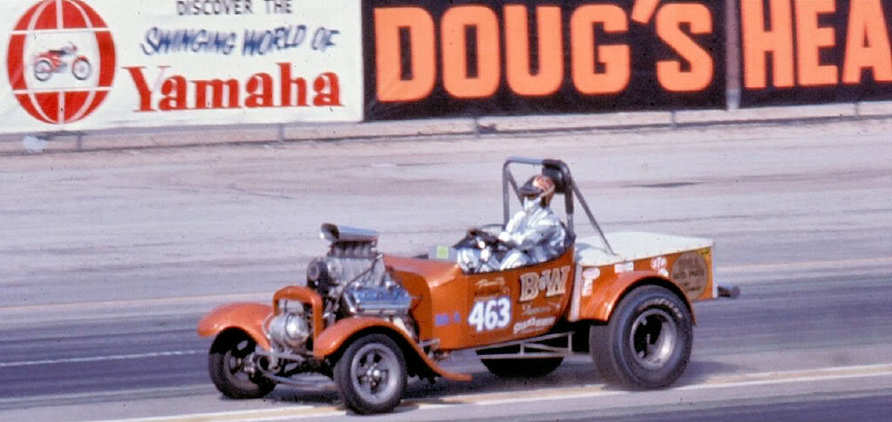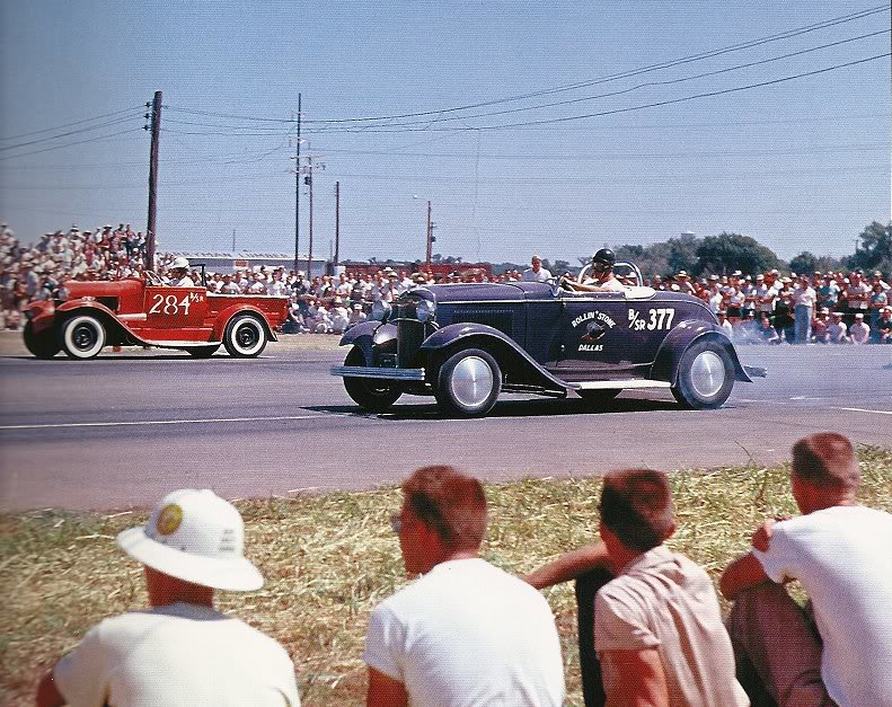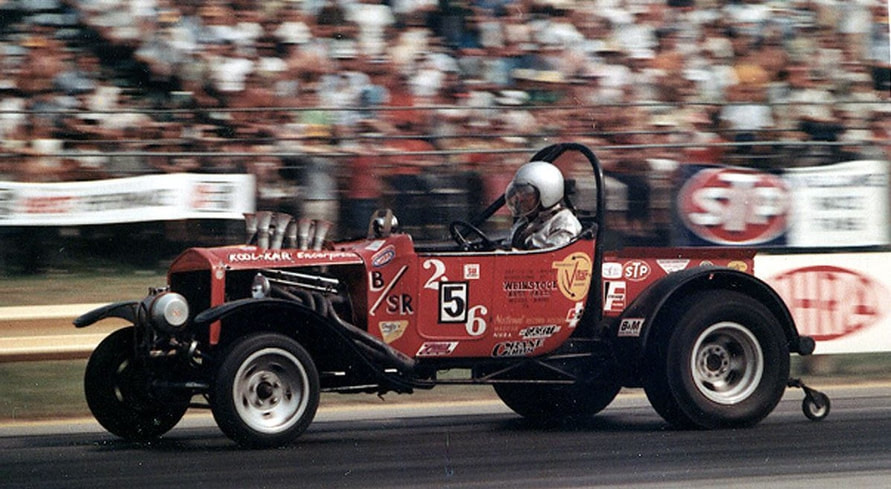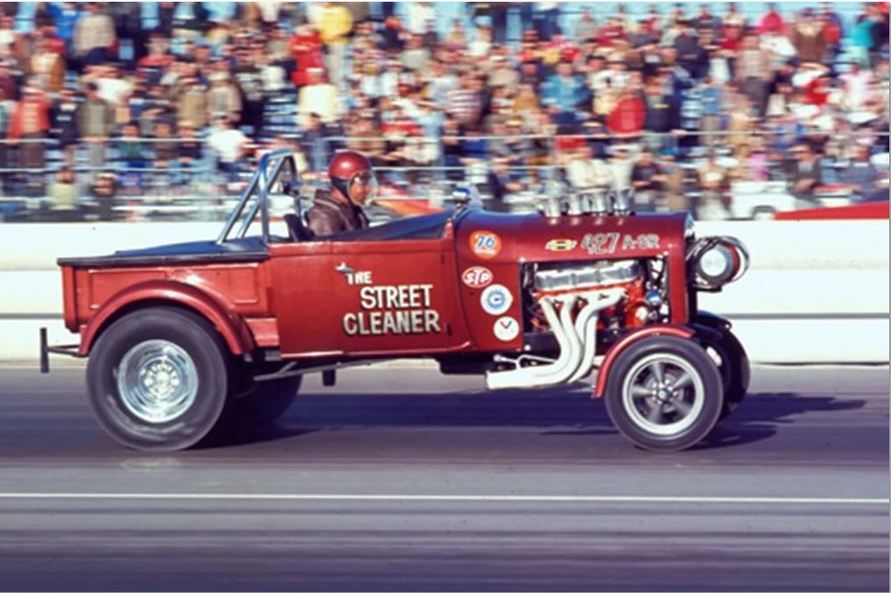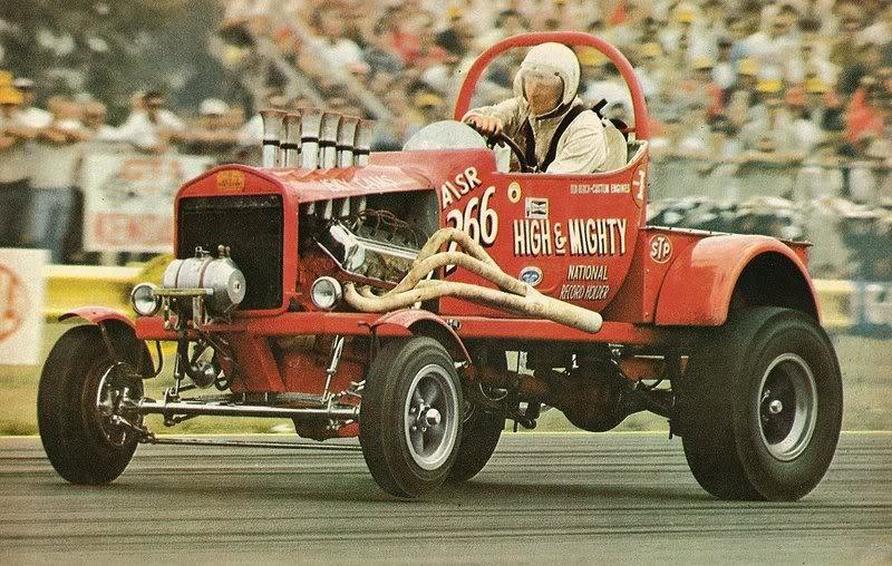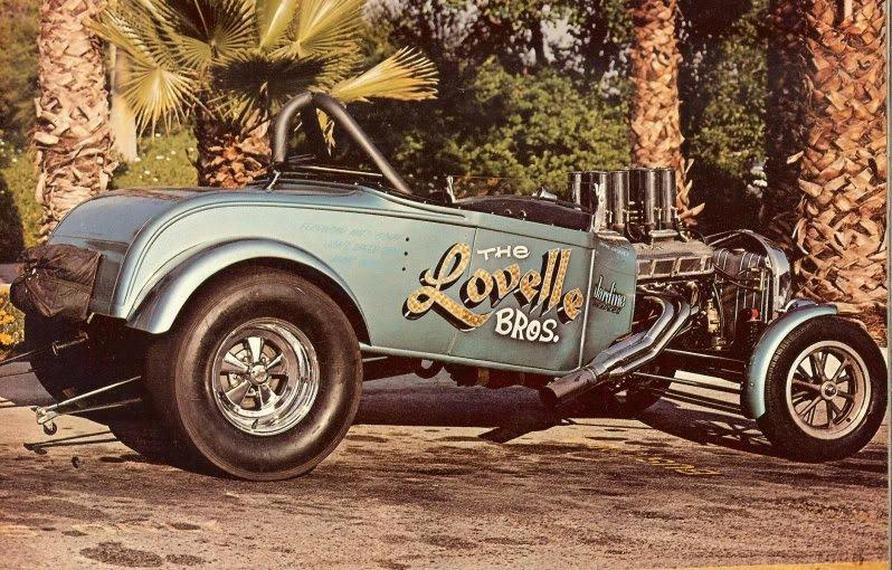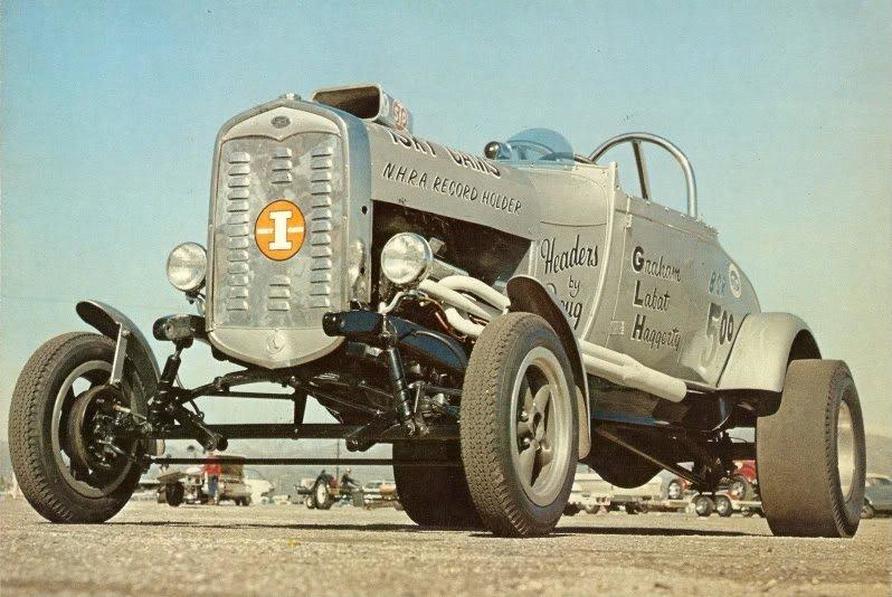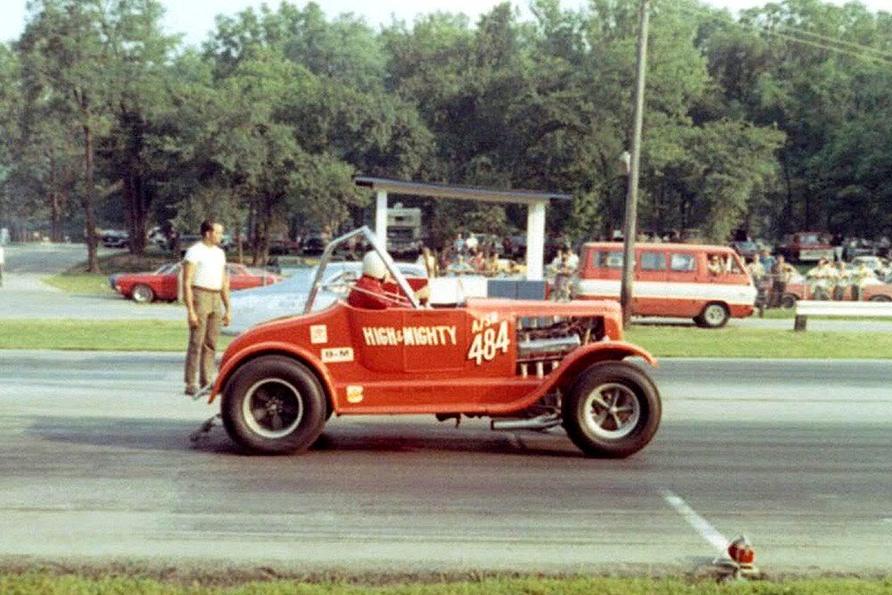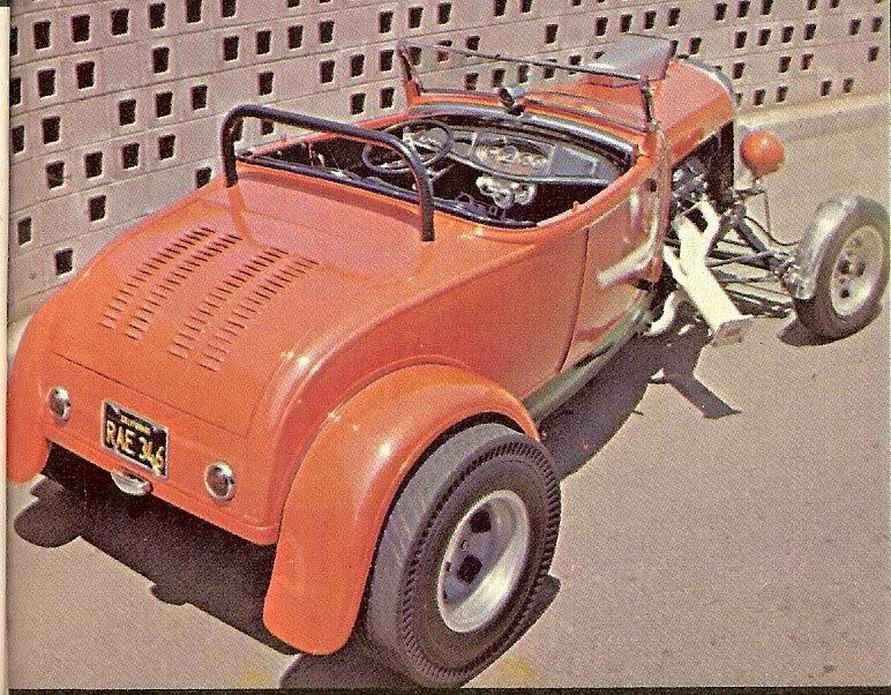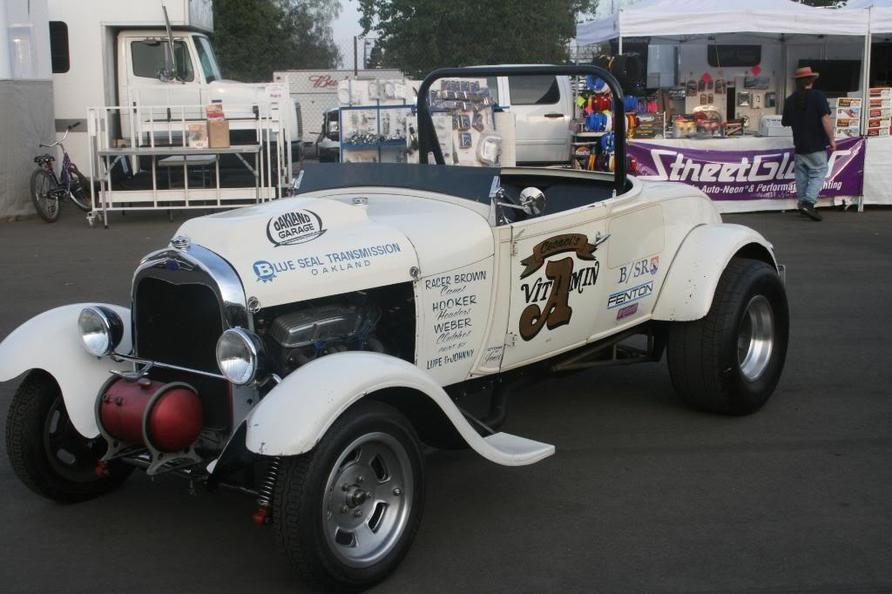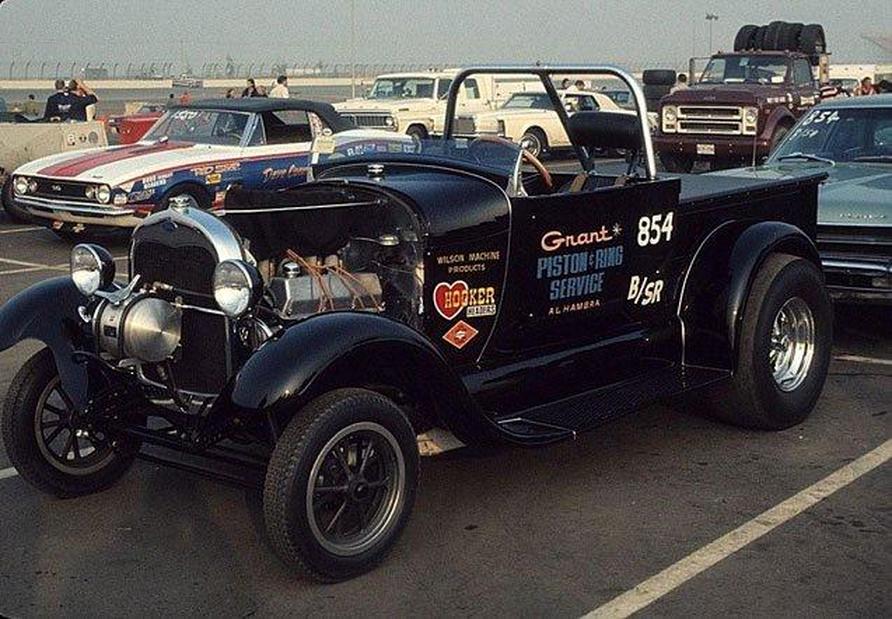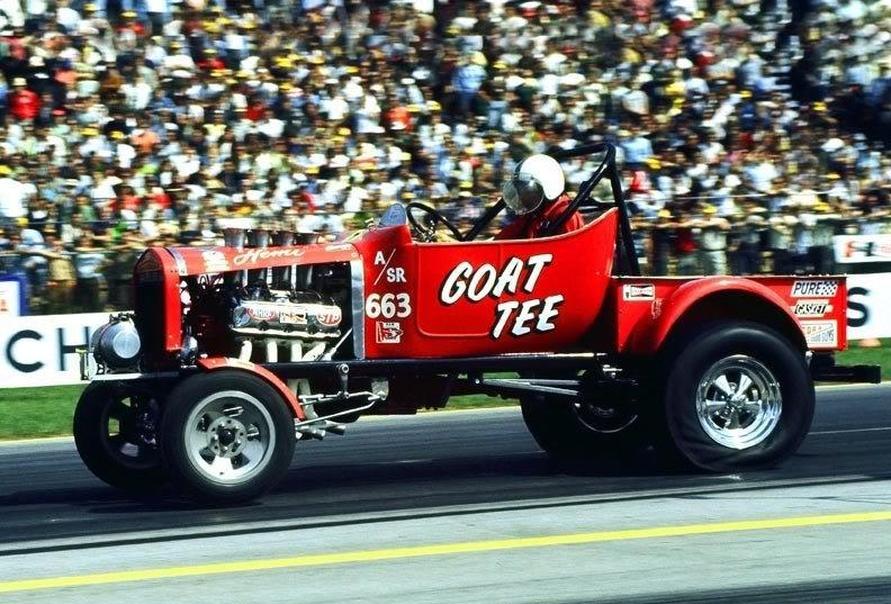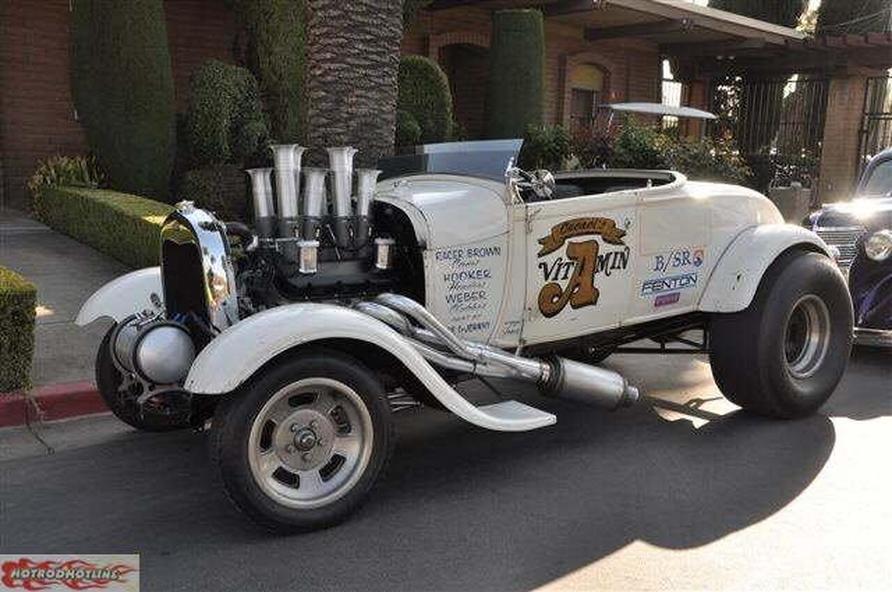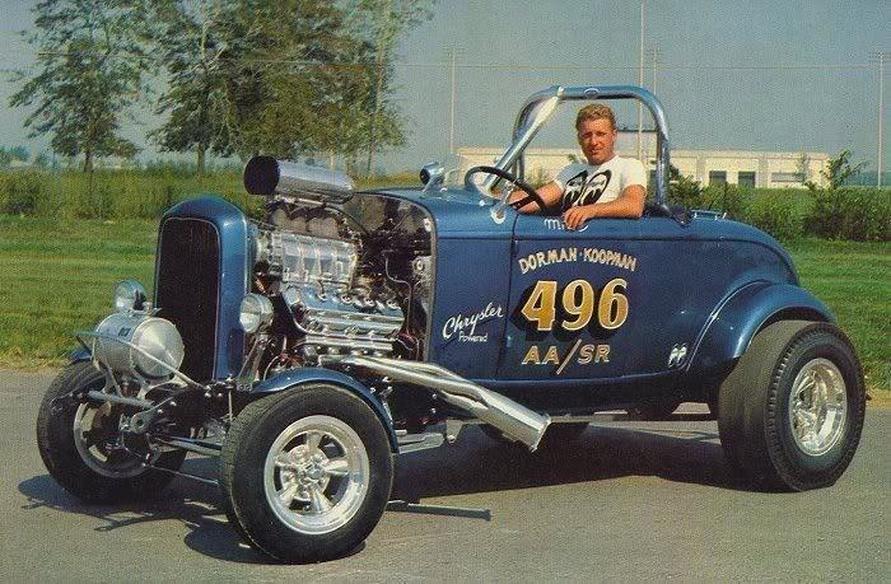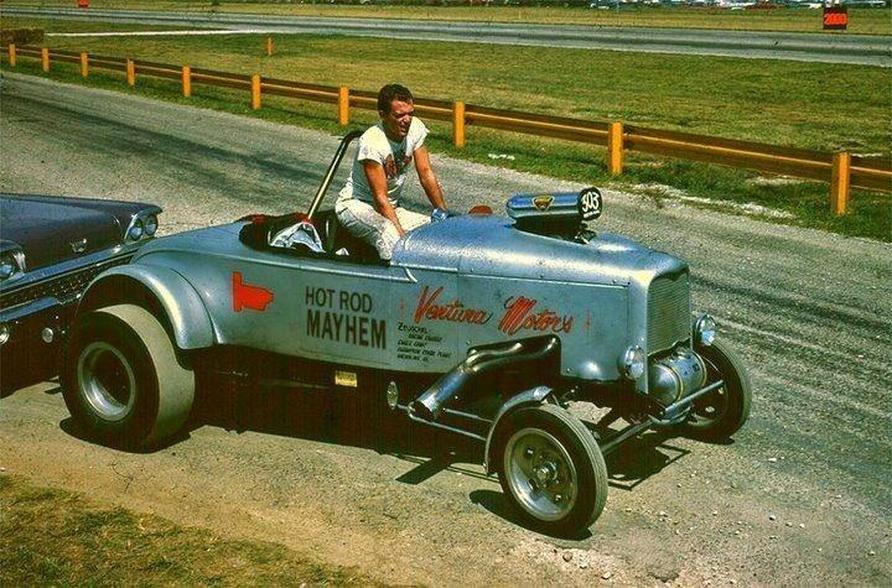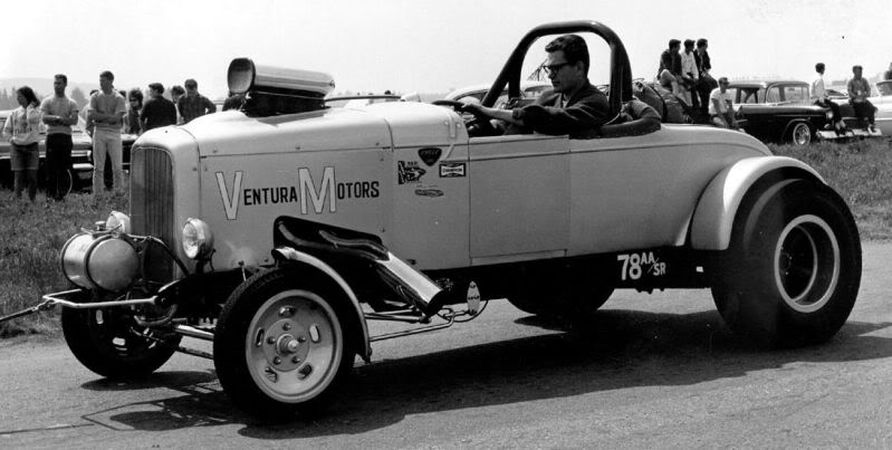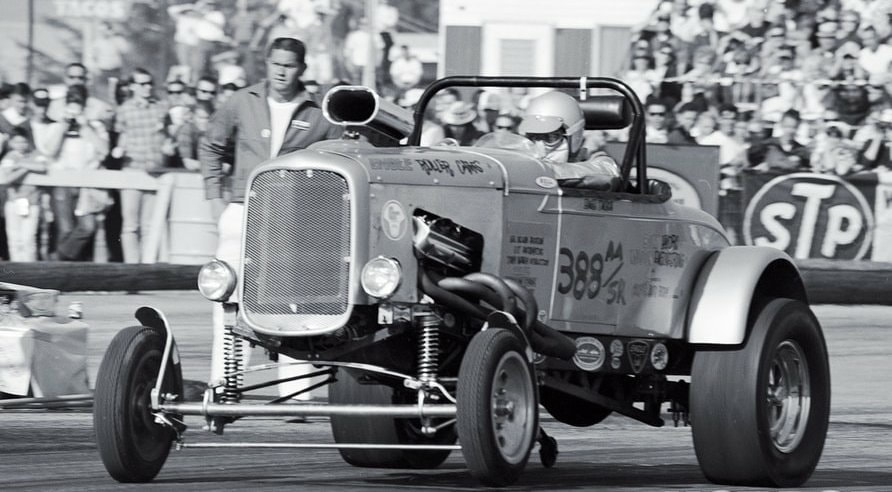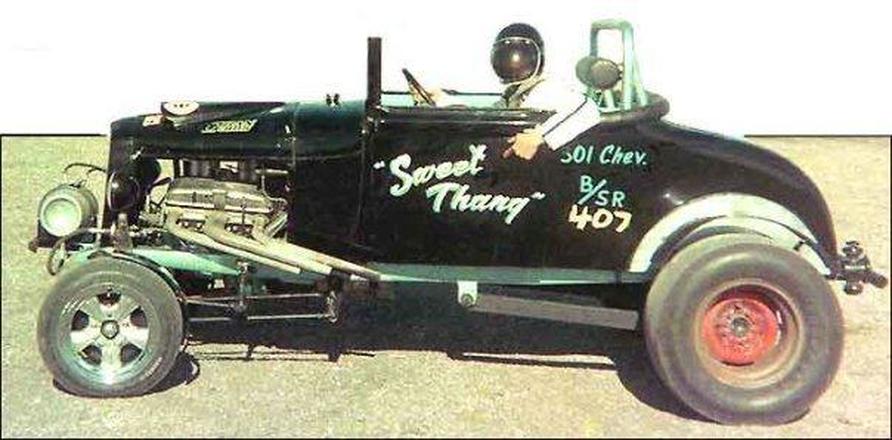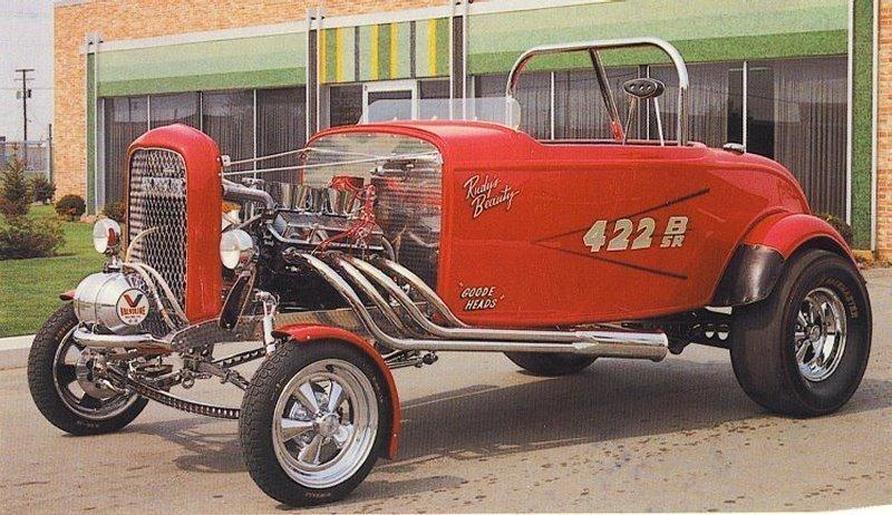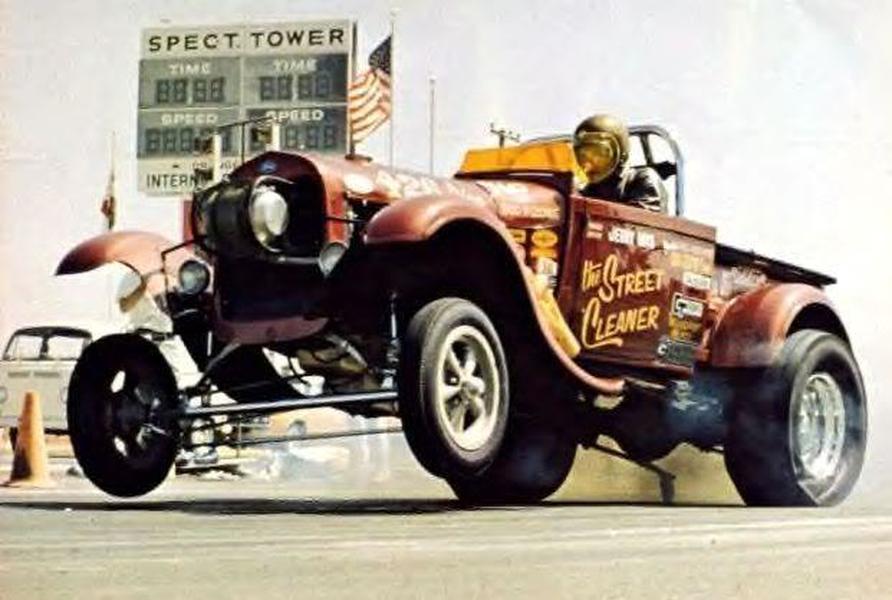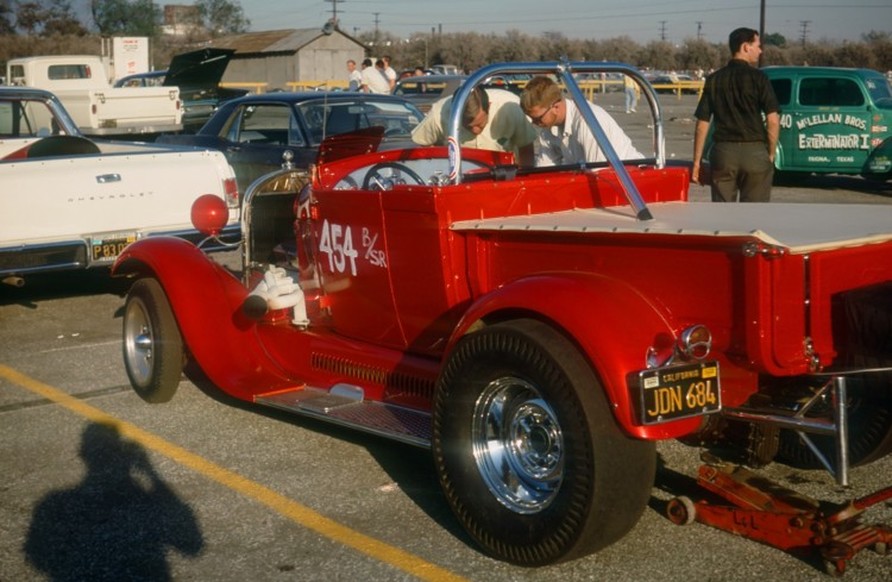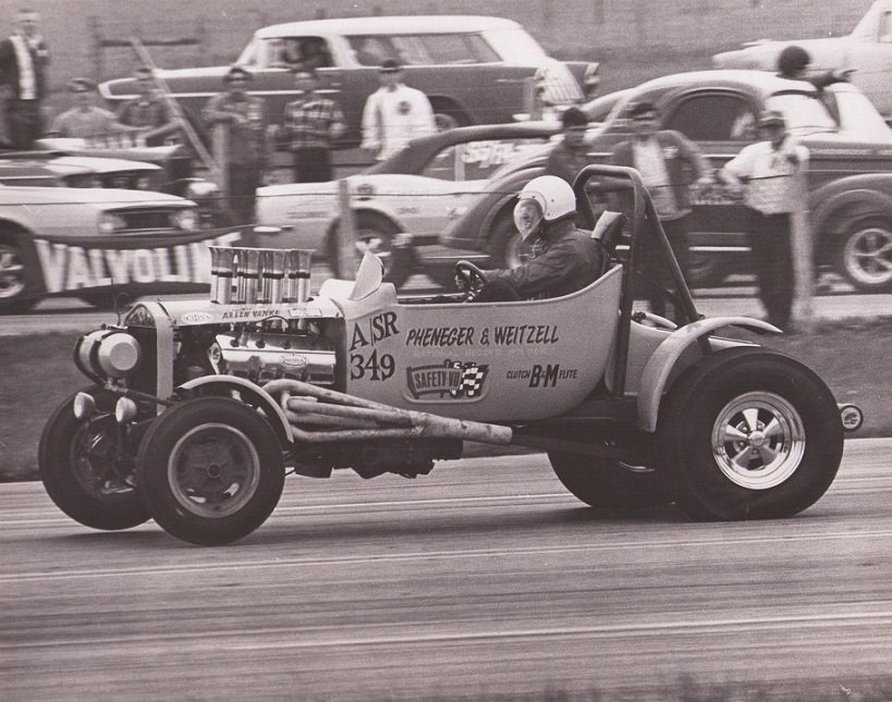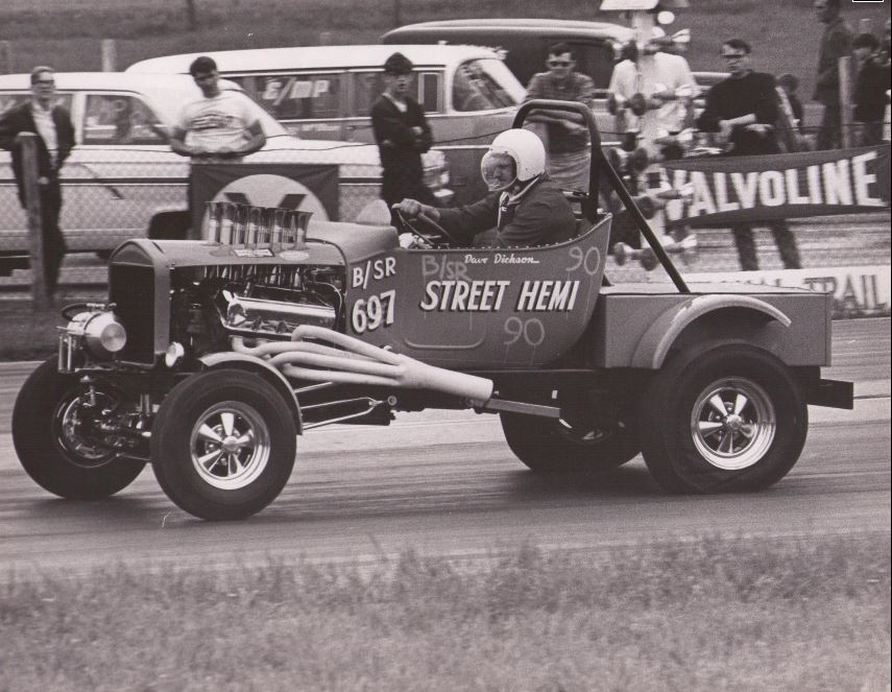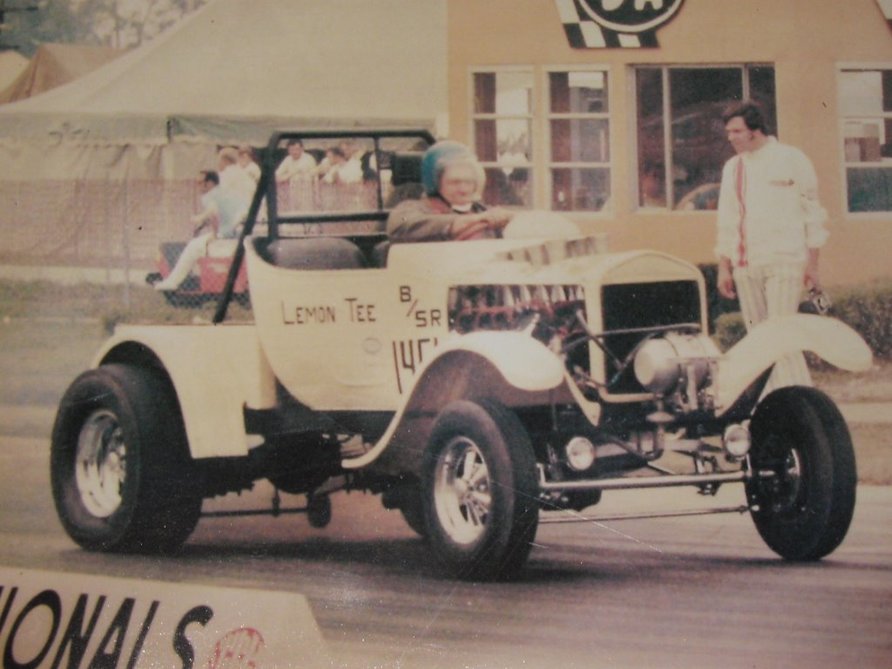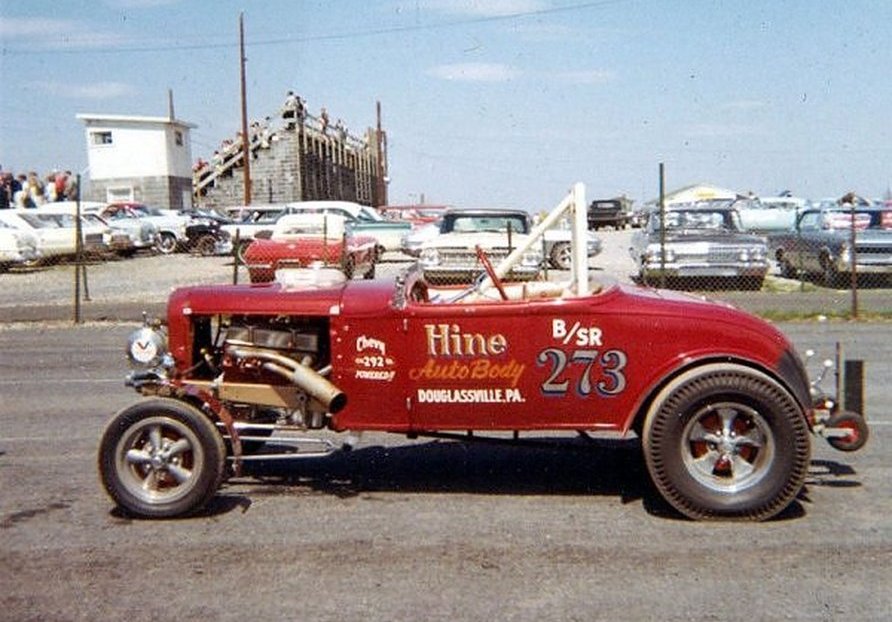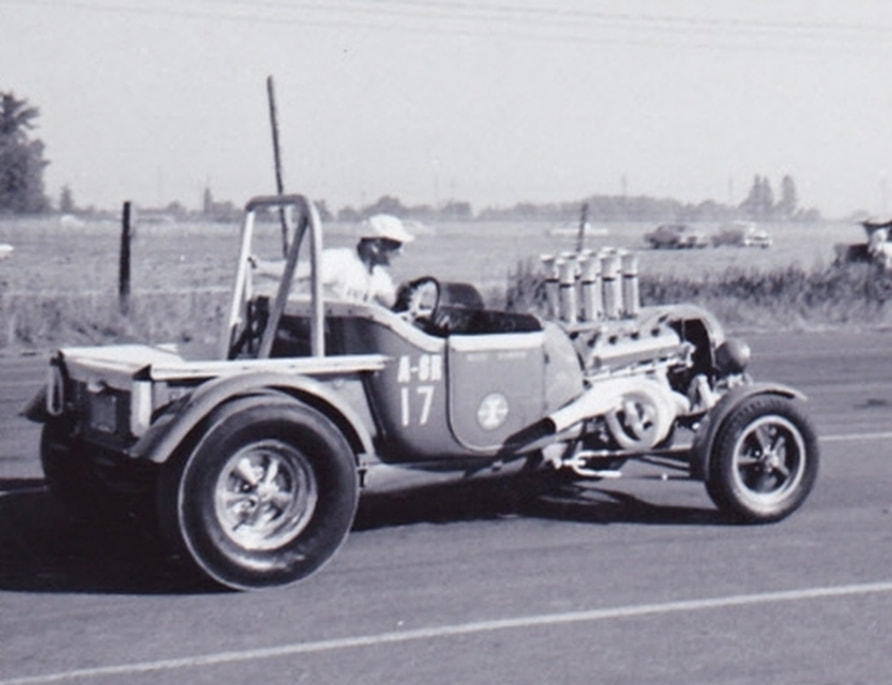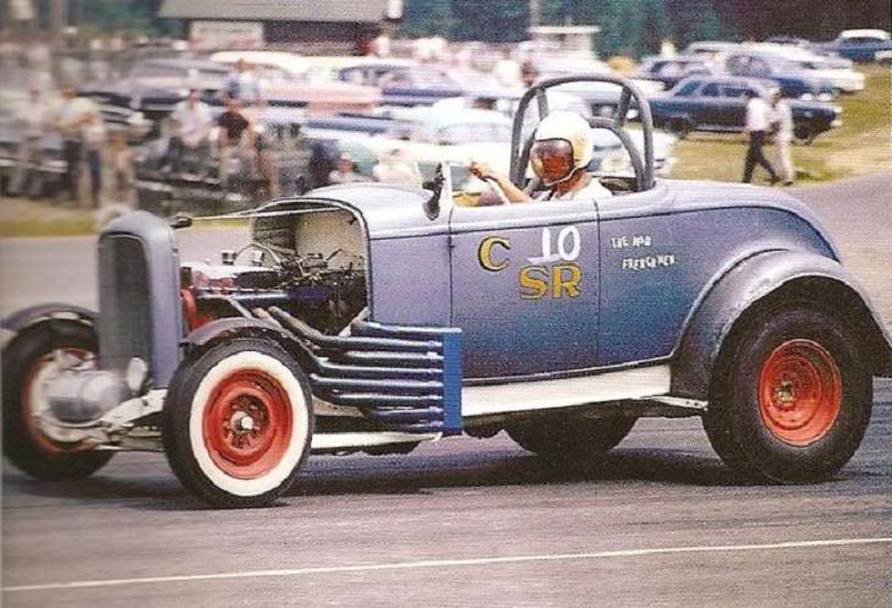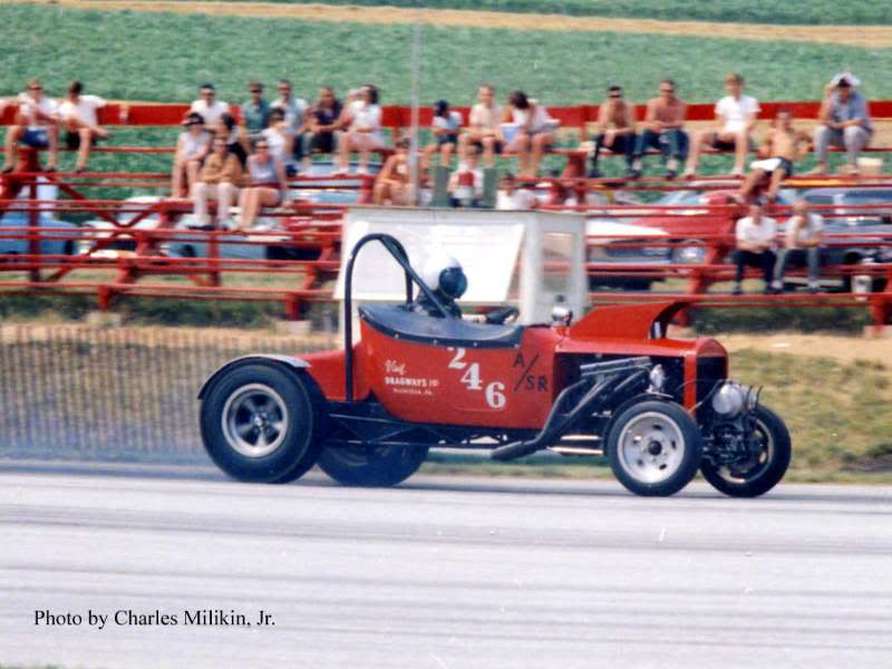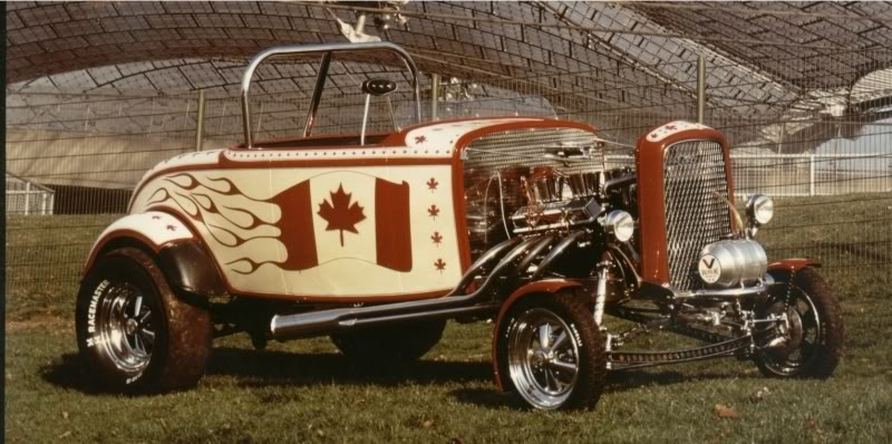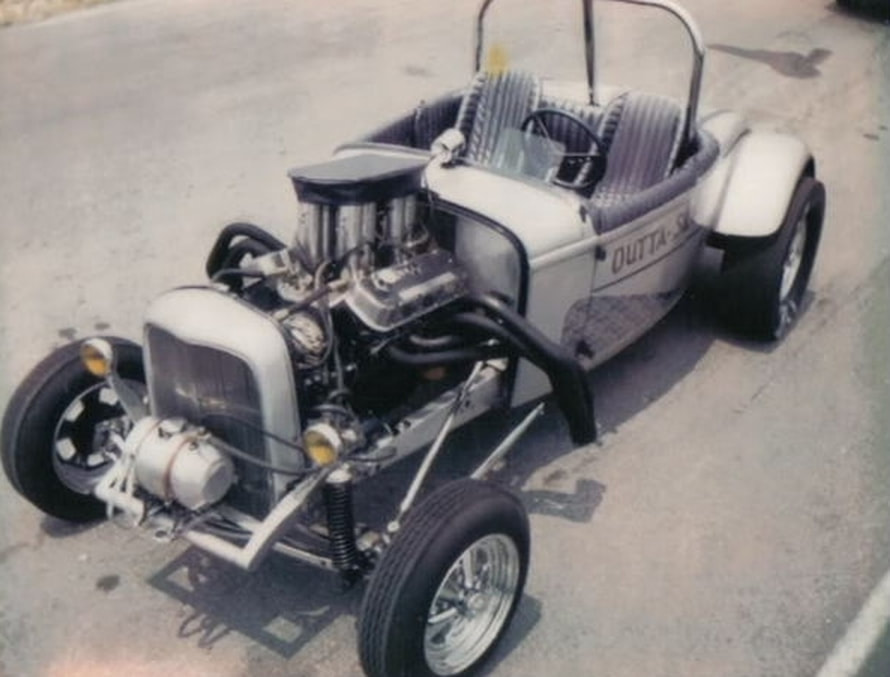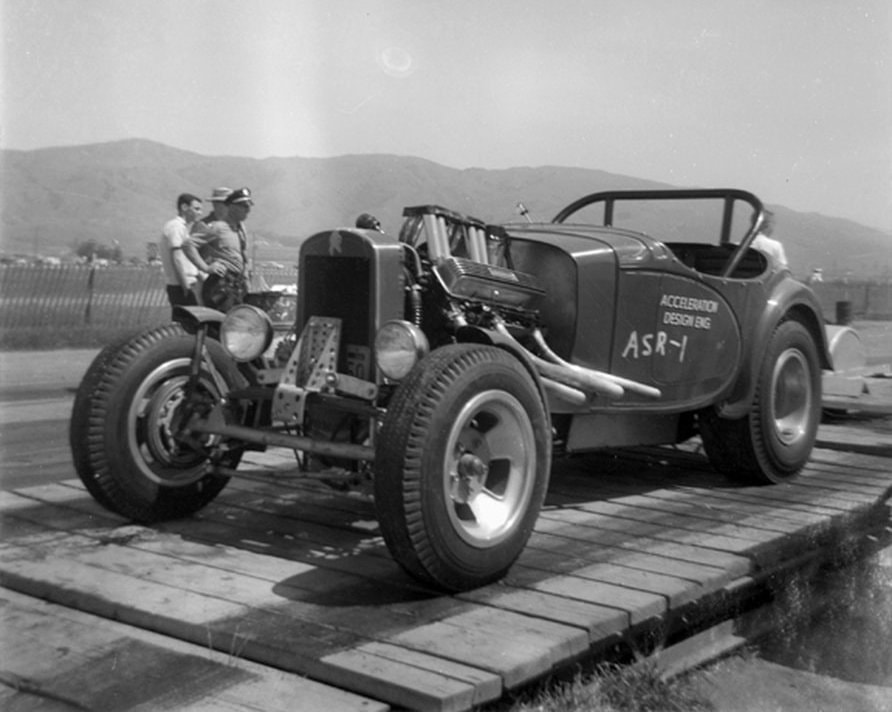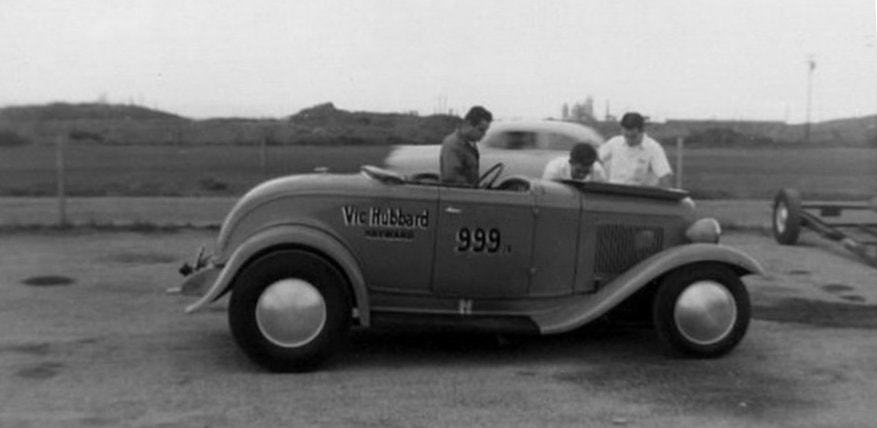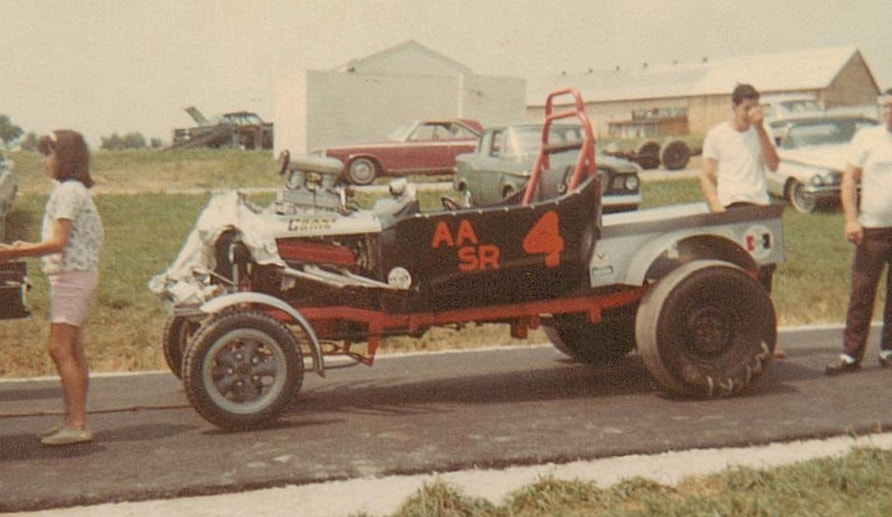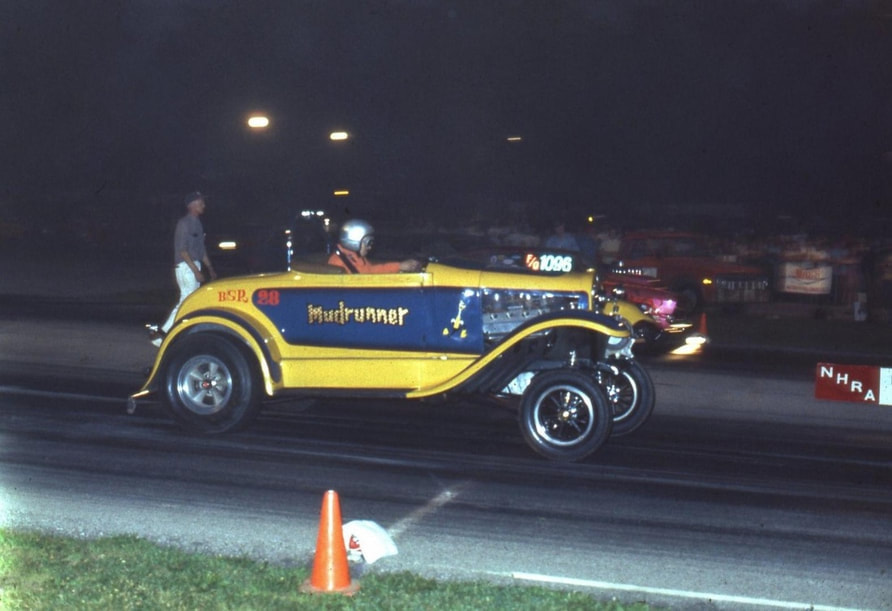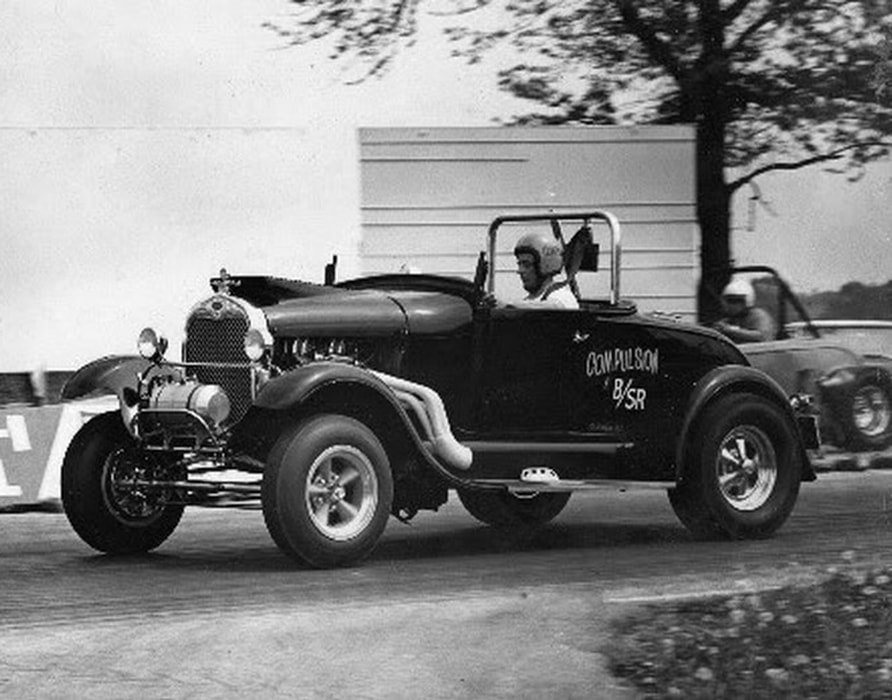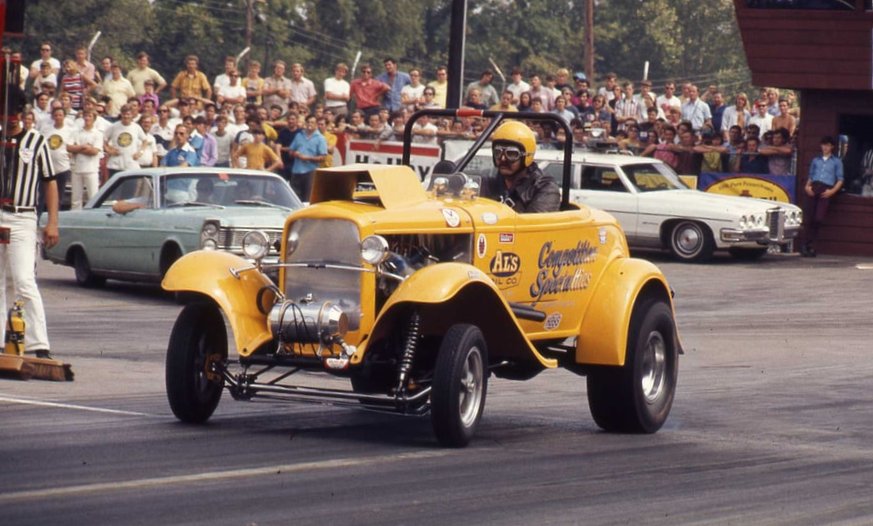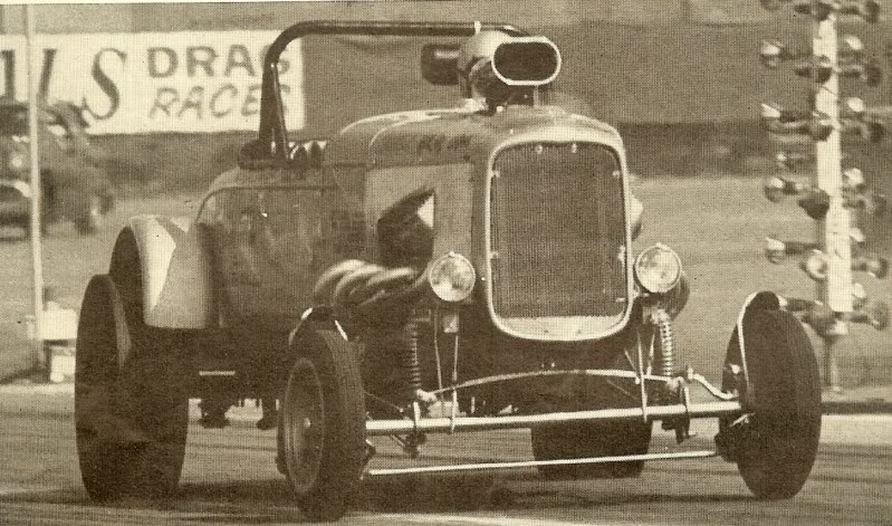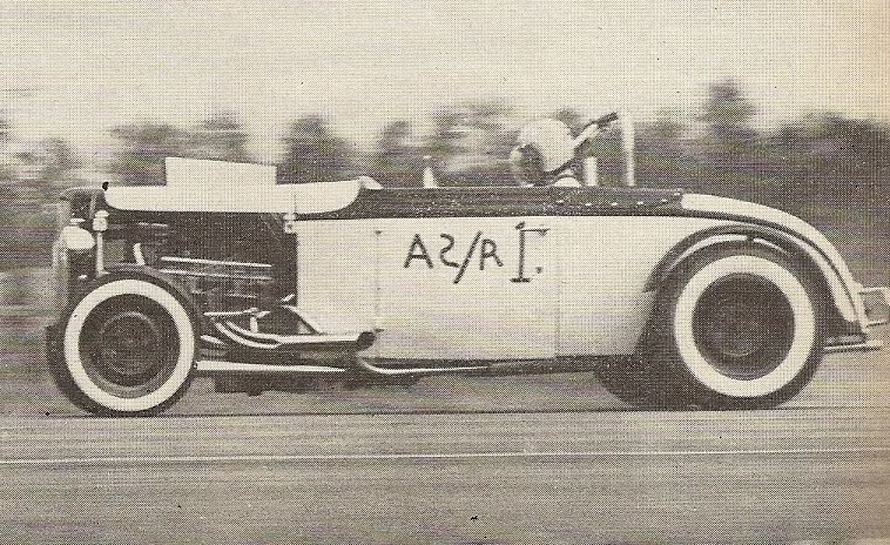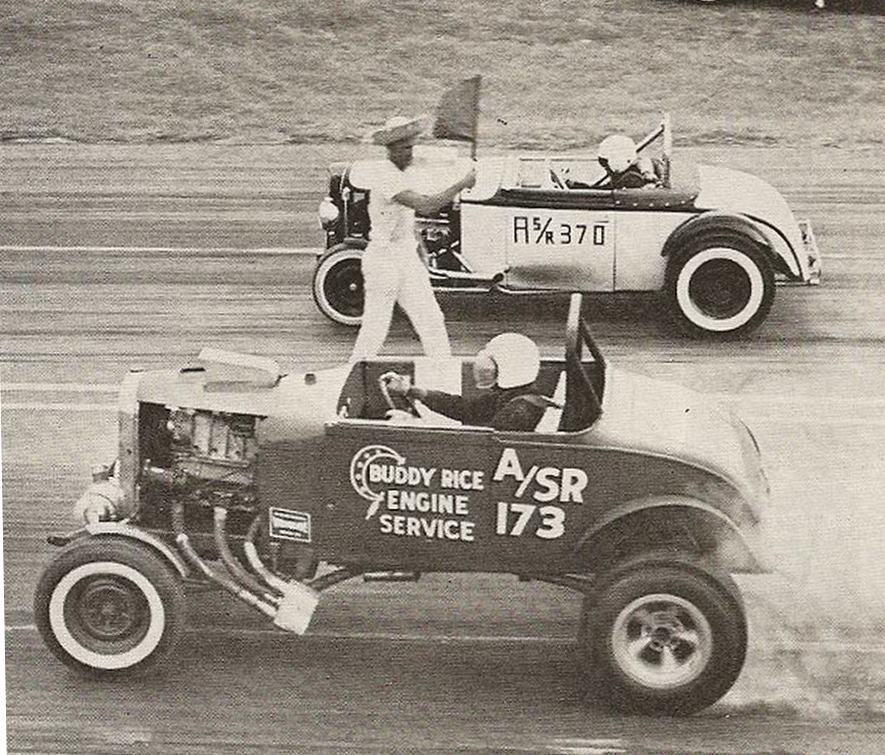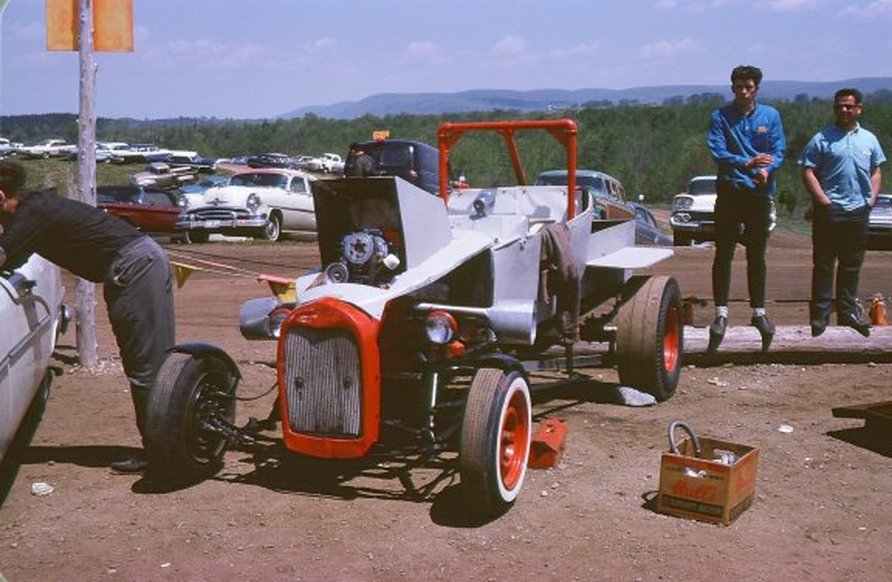STREET ROADSTERS
The Street Roadster classes were very simular to the Gasser classes, with the obvious exception that instead of coupes and sedans, the S/R classes had no tops. Most of them also used small fenders, or stock type fenders in the rear and motorcycle type fenders in the front. Headlights were required. The engines and the weight per cubic inch formulas were very simular to the Gasser classes. At some point, the sanctioning bodies discontinued the use of the motorcycle type front fenders and mandated that the cars have stock type fenders all around (running boards were optional). If you loved the Gasser classes, you probably also loved the Street Roadster classes.
It's worth noting that in many cases, the race cars you see in this section started out as street driven "hot rods" prior to being converted to all-out race cars, and in many cases, they continued to be used as "street roadsters" on the street. Race on Sunday's and drive them to school or to work the rest of the week. It was a different time...
It's worth noting that in many cases, the race cars you see in this section started out as street driven "hot rods" prior to being converted to all-out race cars, and in many cases, they continued to be used as "street roadsters" on the street. Race on Sunday's and drive them to school or to work the rest of the week. It was a different time...
I have always loved this Model-A Street Roadster...
Birds of a feather...
Dean Lowe's B/Street Roadster at Riverside Raceway in 1963. A magnificent 1929 Model-A roadster pick-up truck...
A couple of "real" street roadsters...
A real Street Roadster. Photo taken at Caddo Mills Texas Drag Strip...
Vic Hubbard had a speed shop up in the Bay Area. This beauty was his "Street & Strip" car...
A pretty nice looking Model-T roadster pick-up. Looks like most of the body is fiberglass. An injected Big Block under the hood...
Yep, a Big Block Chevy engine, with a 6-71 GMC blower...
In the 1950's and early 1960's, a Street Roadster was thought of as the ultimate Hot Rod. In my opinion, NHRA should never have let this class fade away...
I'm just guessing, but I doubt the driver's name is not "Shorty".
Clean and neat. Everything a legal NHRA Street Roadster was required to have, based on the rules that were in effect at the time...
A full fender B/Street Roadster, with a 1927 Model-T body and a Hemi under the hood...
Here is another Full Fender B/Street Roadster, with a 1932 Ford body...
Hugh Tucker and his supercharged Olds engine AA/Street Roadster, leaving the starting line with a small lead over his competition, at Lions Drag Strip. Although it may look like a 1932 Ford body, the body is actually from a 1928 Chevy...
All they need now is a grille shell, a hood, and a couple of head lights and they would be able to race in the Street Roadster class at NHRA events...
Okay, that's a little better...
Of all the cars pictured in this Section, I probably have more photos of Hugh Tucker's AA/SR that any other specific car. This photo shows the car in it's final iteration, with the Chrysler Hemi under the hood and the fiberglass body...
Talk about pushing the envelope. Headlights and fenders off of a kids bike...
A few changes to the vehicle directly above this photo. I guess that NHRA took exception to the tiny fenders, and the driver installed fenders that were finally acceptable. Also, some heavier duty front wheels and tires were added...
A 1932 Ford Street Roadster through and through. The only exception is the supercharged Chevy Small Block under the hood...
Tom McMullen and his "street/strip" 1932 Ford A/SR taking the starter's flag. Engine is a 352-inch SB Chevy...
A true street/strip "Street Roadster". Drive it to the track, race it, and drive it home...
Everything is low on this roadster, including the top of the roll bar. A hemi Chrysler engine and a Model-T body, and a very long shifter...
A pretty nice looking Model-A truck. Check out the headlights...
It says A/Street Roadster, but I suspect it's running in an Altered Roadster class, or possibly just doing some testing. It was not that unusual to see Street Roadsters running in Altered classes. To make it more competitive as an Altered, the front fenders, grille shell, and the head lights were removed. So, how do I know it's really a Street Roadster?
This should answer my question above. I found this photo, showing all the legal Street Roadster stuff bolted on...
A couple of supercharged AA/SR's having a go...
This very neat 1928-1929 Model-A Street Roadster originally raced with the motorcycle fenders over the front wheels, but then went with the stock front fenders after NHRA changed the rules. It never seemed to make a difference in speed...
A full fendered '34 Ford Roadster makes for a mighty handsome race car. I bet this ride sees plenty of street duty between weekends at the track...
For whatever reason, many racers felt that the Street Roadster class should be reserved for American built roadsters. But such is not the case. The NHRA Rulebook from the very beginning stated that cars “must be equipped with a Roadster body produced by an automobile manufacturer.” But, like the Gasser classes, it never stated that “foreign” cars were not permitted in the class. The Rulebook further stated that the “body cannot be altered in height, width, length or contour.”
As far as the rules for fenders, it simply stated that “the cars must have four legal fenders.” What constituted “legal” fenders were open to interpretation. The rules that stated that “the cars must have original fenders” did not go into effect until much later.
The British MG Sports Car in the photo above could have probably have raced in either a Street Roadster class or in a Modified Sports Car class…
As far as the rules for fenders, it simply stated that “the cars must have four legal fenders.” What constituted “legal” fenders were open to interpretation. The rules that stated that “the cars must have original fenders” did not go into effect until much later.
The British MG Sports Car in the photo above could have probably have raced in either a Street Roadster class or in a Modified Sports Car class…
This was probably the first outing for Hugh Tucker at a NHRA National Event. Dave Stoll's supercharged Olds engine under the hood...
The AA/SR in the left lane, running a blown Chrysler, had been the King of the Hill in the Street Roadster class for several years. And then the Tucker & Stoll Roadster came along, and never relinquished it's Crown...
A 1928-1929 Ford Model-A Roadster Pick-Up. The Pick-Up bed looks to be the original length...
1927 Model-T body, probably fiberglass...
Hugh Tucker at Pomona. Still running the Olds engine in this photo...
An interesting Street Roadster. I'm guessing it spends more time on the street than on a drag strip. The windshield and the mufflers are kind of a tip-off. Note the tiny rear fenders. Also note that the front fenders are missing completely, which would keep this hot rod from competing at a NHRA National event...
I love this, a Street Roadster in the "Street Roadster" class. The engine is a Y-Block Ford (with T-Bird valve covers). Bolt on a roll bar, un-cork the headers, and you are good to go...
Running in the A/Street Roadster class, with a 426 Chrysler Wedge engine. It looks like a Ford Model-T body that had been extended somewhat, to give the driver more room...
A 1934 Ford, all steel, full fendered (with running boards). Never quite as popular as the Model-A or 1932 Ford roadsters, but a roadster is a roadster so let's race...
The "High & Mighty" Street Roadster. As you scroll down in this Street Roadster Section, there are several other photos of this same car, primarily because the "High & Mighty" A/SR, (and sometimes B/SR), like the "Hugh Tucker" AA/SR, is one of the iconic Street Roadsters, built based on the NHRA rules at the time. Race cars running in the Street Roadster classes used the NHRA rulebook as if it was the Constitution of Drag Racing, which it was. The rules were the rules, however not all the rules were spelled out completely in the rulebook, leaving room for "interpretation". For instance, the rules in the S/R classes for the chassis were "automobile type frames", and not "automobile frames". This allowed racers to use lighter weight square type tubing that looked pretty much like an automobile frame, but were never designed for a production automobile. The owners of the "High & Mighty" took advantage of that. The rulebook also required that the S/R's had to have headlights, but never said they had to be automotive headlights. Motor scooters had headlights that were much smaller (and lighter) than the normal automotive headlights. The owners of the "High & Mighty" took advantage of that, also. Reading between the lines of the NHRA rulebook became an art form for many racers...
The Conant Bros. B/SR, Chevy powered. The body looks like a fiberglass replica of a 1927 Model-T Ford, with matching fenders and running boards...
Between round maintenance never stops...
The Nash & Yodock B/Street Roadster. The body is a Model-T Pick-Up Truck. It looks like the wheelie Bars are doing their job...
An ultra cool 1928/1929 Model-A Street Roadster. The license plate on the front, the windshield and the rear view mirror tells me this Roadster is at home on the street and the drag strip...
This looks to me like it's a street/strip Roadster, so why not drive it to the track instead of hauling it on a trailer? Perhaps it's not as streetable as you think. Perhaps it's not set up with mufflers. Or perhaps the trailer is "just in case" the roadster breaks something at the track...
Say what you will about NHRA requiring stock type fenders in the class, I have always loved the S/R's when they had that "open wheel" look...
Not many Phaetons were used for drag racing in the Street Roadster classes. This 1932 Ford "tub" does make for a unique A/Street Roadster... (Photo from the Petersen Archives)
The rules for Street Roadsters and Gassers allowed for ballast. Many cars in these classes used truck or bus batteries, as they were pretty heavy... (Photo from the Petersen Archives)
"Rapid Robert's" B S/R, Chevy powered. Anytime you see a Street Roadster at a drag strip with windshield supports in place, you can be sure that the car is also street driven...
A Model-T pick-up truck body and home made front fenders. This racer is going to need to find some fenders for the rear of the car, to be able to race as a S/R at NHRA National Events...
I can never get enough photos of Dean Lowe's immaculate B/Street Roadster. This car has a boat load of wins in the B/SR class. Power is from a Small Block injected Chevy, a combintaion that is at home on the drag strip as it is on the boulavard...
A 1932 Ford Street Roadster, Chevy powered. The 1932 Fords had a gasoline tank that extended a few inches behind the rear of the body, but not by this much. Look how far back the rear bumper is. My guess is that there are some lead bars under that extension to help with traction...
Carl Stone (from Texas) and his ultra neat full fendered 1932 Ford Roadster. This car kicked-ass in the B/SR Class...
Carl's roadster all lettered up for drag racing...
Jim Cassady's A/Street Roadster. A Model-T body and a Chrysler hemi under the hood. The engine is naturally aspirated in this photo, and a was eventually equipped with a supercharger, putting the car in the AA/SR class. Note the license plate in the back...
An interesting A/SR. I believe that's a Big Block fuel injected Chevy for go-power. The front of this Model-T Roadster is jacked-up for additional weight transfer. One of the NHRA rules was that the engine could not be raised more than 24-inches from the ground, measured from the centerline of the front crankshaft pulley to the ground. And then there are the "fenders". At the time, the class rules for the Street Roadster class required that the car had fenders, but what constituted fenders was not well defined. It was fenders like these in this photo that eventually led NHRA to mandate that the fenders had to be primarily what came on the car originally (less the running boards)...
Here's what I know about this Model-A Street Roadster. It looks to be all factory steel, and there is a Flathead Ford mill under the hood. Nothing particularly fancy, just the basics...
Based on the NHRA rules at the time, this Small Block Chevy powered B/Street Roadster was done RIGHT...
Geraghty Automotive built some very serious race engines back in the day. This Chrysler Hemi features six carbs. The body is a 1929 Model-A, with a '32 Ford grille shell, all sitting on a 1932 Ford frame. With the hay bales in the background, I'm guessing this photo was taken at the San Fernando drag strip...
Clean and neat, an injected Chevy powered Model-A pick-up, B/Street Roadster...
A dual purpose hot rod, Bert Leithold's '29 Street Roadster, at home on the Dry Lakes in SoCal and at the Colton Drag Strip, as shown here. The time was 1955. Clean and neat, an honest hot rod. Power came from a Ford or GM Straight-6 engine, I guess they tried both at some point in time. The tow bar is attached, so they either just showed up at the track or they are getting ready to go home. This car is said to still exist today. David Sorenson posted this photo on the Facebook page, "Pre-'55 Period Correct Hot Rods", and I stole it...
Maybe not the prettiest Street Roadster of all time, it was most likely purposely built as a drag racing Street Roadster, with a body from a 1925 Model-T. Under the slightly extended hood, a Small Block carbureted Chevy engine creates the get-up and go...
From the "keep it simple" school of thought. A 1927 Model-T roadster body, miniature fenders (legal at the time), and painted black, just like Henry would have wanted it. Power is a Small Block Chevy engine with dual 4-brl. carbs...
Normally, I would not have uploaded this photo, although its obviously a Street Roadster, probably in the AA/SR class. It lacks front fenders. On the other hand, this is Lions Drag Strip, and not an NHRA National Event. Lions was never a sanctioned NHRA track. It was sanctioned by AHRA...
How could you not love this Street Roadster? A candy-apple red 1929 Model-A pick-up truck, with a Big Block injected Chevy engine. This photo was taken in it's original configuration, when it still had it's soon to be illegal cut down fenders...
I just can't get enough photos of this roadster. This is the final iteration of Hugh Tucker's engine combinations, with the Chrysler Hemi. This car dominated the AA/SR class wherever it ran. The photo was taken at Riverside International Raceway, one of the few drag strips that used a 1/2 mile track...
From North of the border, Doug Brinjak and his A/Srreet Roadster. Doug is from London, Ontario Canada. A 426 Hemi with Hilborn fuel injection is under the hood. Many racers in the Street Roadster and the Gasser classes raised the cars higher off the ground, in the hopes of increasing traction through "weight transfer" (raising the center of gravity). Drag slicks were not nearly as good as they are now, and drag strips were not treated with the "sticky" chemicals in use today. Of course, there was an extra element of danger with this practice; if the car got out of shape going down the track, the higher center of gravity could cause a roll-over. Eventually, NHRA put a limit on how much the car could be raised off the ground. The centerline of the crankshaft could not exceed 21-inches from the ground...
Hugh Tucker's nasty Street Roadster, with Dave Stoll's supercharged Oldsmobile ski-boat engine under the hood. This is the early stages in this roadster's early life, with the all-steel body and original wheelbase. The transmission was the infamous B&M HydroStick...
Despite what many folks think, even with these non-stock fenders, an all steel body and a 1932 Ford frame was no featherweight roadster. The ultra long primary headers put the accent on mid-range torque for this small block Chevy powered roadster...
Safford & Shores NHRA legal Street Roadster. It's a SoCal area Street Roadster. I believer it had a Straight-6 Chevy or GMC engine. Note the license plate, along with running at the drag races, and at the California dry lakes, and it was also a street-legal roadster. Real Hot Rods back then could do all three of those things...
A couple of AA/Street Roadsters (supercharged) smoking the rear hides, off and running in eliminations...
This racer understand the realities of drag racing, which is that fancy paint job and a lot of chrome plating does not make you car go faster or quicker...
The Akron Ohio area had lots of hot rod activity, including drag racing sponsored by the Akron Cam Jammers. Here is Otie Smith in his street roadster at an Akron meet in 1954, as recorded by Eric Rickman who was accompanying the NHRA Safety Safari. Back then the NHRA did a lot to make drag racing both safer and more popular across the country. Otie Smith would go on to run altereds that won at the national level, and ran Otie's Automotive. He was president of the Cam Jammers and organized the first drag race held east of the Mississippi at Akron in 1951. (Photo and commentary by David Sorenson).
David posts a lot of interesting photos and comments on the “Pre-'55 Period Correct Hot Rods” Facebook page. Otie’s flathead powered ’32 Ford roadster is a perfect illustration of the “street/strip” hot rods of that era. Remove the windshield and the front bumper (leaving the bumper brackets in place) and go racing...
David posts a lot of interesting photos and comments on the “Pre-'55 Period Correct Hot Rods” Facebook page. Otie’s flathead powered ’32 Ford roadster is a perfect illustration of the “street/strip” hot rods of that era. Remove the windshield and the front bumper (leaving the bumper brackets in place) and go racing...
In the very early days (1940's and 1950's), Hot Rods (roadsters and coupes) came in three flavors. Those with stock fenders and running boards, those with cut down stock fenders on the rear and motorcycle fenders on the front, and those with no fenders at all. In California, fenders were not required on your street licensed hot rod, provided the car weighed under 1,500 Lbs. The truth is that most of these hot rods were slightly heavier than that, but the police usually didn't make a big deal about it unless you were kind of "mouthy" if and when they pulled you over for some other infraction. With or without fenders, these were all street legal and street driven cars. It's important to remember that in those days, ALL drag race cars, with the exception of Dragsters, were once factory produced street cars, that were driven everyday to work or to school. When NHRA created the Street Roadster Class, they decided that the car had to have fenders, either the stock fenders or the cut down style fenders like the roadster above. Roadsters with no fenders had to run in a different class (such as the Altered Class, once that class was created). This beauty above is a street driven car during the week, and a race car on the weekends. It's a '29 Model-A with a '32 Ford grille shell and a hot flathead under the custom made hood. The owner and driver is Bart Root, and this beautiful roadster was a Hot Rod Magazine Cover Car in 1955...
Like the roadster photo above, this is also a street roadster during the week, and a race car on the weekends. The roll bar and the windshield can be removed and replaced with little effort. This is a 1932 Ford, powered by a 331 cubic inch Cadillac engine. Other than the running boards, the fenders are relatively unmodified. If you are doing a double-take on the way the body looks, that's because the body has been "channeled". To do that, the floor has to be cut out of the car. And then, the body is lowered over the frame. In this case, the car has been channeled 7 1/2-inches. The stock frame is still in the same place, but instead of the body resting on the top of the frame, it has been lowered to where the bottom of the body is even with the bottom of the frame. Then, the builder has to raise the fenders 7 1/2 - inches to still be in the same place over the tires, which put the top of the rear fenders almost level with the top of the body. A new floor has to be fabricated and it rests on the top of the frame like before. When the door is closed, you cannot see the frame. When it's open, you can then see the frame, the bottom 7 1/2" of the doors covers the frame. This modification is no walk in the park, but when done right, it sure does make the car sleeker looking, and it's still legal for the NHRA Street Roadster class. Jim Govro, the car owner, was a 15 year old high school student when he constructed this roadster in 1951...
Jim's Street Roadster in color, known as Tweety Bird...
There is something about a roadster pick-up truck that looks "just right" on a drag strip. The stock length pick-up bed is right for this application, and in my opinion, is an advantage over the standard roadster body. It allows the racer to move his battery further toward the rear than he could with the regular roadster body...
I'm sure that everyone has seen photos of TV Tommy Ivo's beautiful T-Bucket street roadster. This is not it. Tom used to drag race his original T-Bucket street roadster at the local dragstrips around SoCal, including San Fernando Drag Strip, where this photo was taken. Apparently, Tom had been told by the tech people at San Fernando that his T-Bucket, despite being a legal, licensed street roadster, did not fit the rules for being a "legal NHRA street roadster", and therefore, was no longer eligible for the Street Roadster Class. Technically, the track was correct, Toms T-Bucket was highly modified, had no fenders, etc. So Tom decided to build a Model-T roadster that WAS NHRA legal, and at the same time. "make a statement". This is that statement, with headlights facing any which direction, foxtails waving in the air, and just generally built as ugly as you can build a race car to be. Obviously, Tom was just having a good time with this quicky project. I know Tom, and having a good time is what he is all about (plus he is as competitive as hell and does not like to be told "no")...
If it has no top, it must be a roadster. Technically, it's a 4-door convertible or Phateon, or as hot rodders referred to them, a "tub". Looks like FoMoCo for power. This photo was taken at Pomona Drag Strip...
A big 427 Ford SOHC mill under the hood...
In the early days of drag racing, a surprising number of all-out race cars were also capable of being streetable. This was particularly true of cars in the Gasser and Street Roadster classes. It must be remembered, these race cars were built out of factory production vehicles. Stock bodies, stock frames and basically stock suspension were the norm "back in the day". This holds true for this AA/SR class roadster pick-up truck, a local SoCal car. Power comes from a supercharged Buick engine. The windshield was removable, and the top could be folded down or removed, plus it had mufflers. While it could be driven to and from the drag strip, the tow bar was some insurance that they could get the car back home if they broke something at the track...
A 1932 Ford body on a 1932 Ford chassis, probably a defacto standard for an NHRA Street Roadster in the early 1960's. Conaway & Woodhouse from Cheyenne, WY, Chevy powered with a 4-71 GMC supercharger...
Jim Cassidy's Model-T, Chrysler powered. I'm pretty sure this was an all steel car. Still had the windshield frame on the cowl so he must have driven it on the street, too...
Hugh Tucker and his incredible AA/SR coming out of the hole at Lions. In this photo, I believe his '28 Chevy bodied roadster (with a '32 Ford grille shell) was still supercharged Oldsmobile powered. The Hemi powered Model-T in the left lane has Chuck Finders' name on the side, although I'm not familiar with this car...
Some take the high road, and some take the low road...
Maybe one of the last of the breed. A perfect design, a light weight replica body (that was never on a factory produced roadster), a custom frame (that was never on a factory produced car), and a pick-up bed (that was never on a factory produced pick-up truck). But based on the Street Roadster rules at the time, it was a perfect design...
Long ladder bars or short ladder bars, which is best? The truth is, it never seemed to make much (if any) difference one way or the other...
A very nasty looking AA/SR. A blown Chrysler engine in a Model-T body (probably a fiberglass replica). The pick-up bed looks home made, which was legal under the NHRA rulhe time...
Dwight Swartout, from Muskegon, MI, Hemi powered A/SR...
How many kids can you get into a roadster? At least this many...
The Nash & Yodock B/SR being pulled to the pit area at Vargo Dragway, in Perkasie, PA...
Looks like a straight-6 Chevy or GMC engine...
My guess is that this A/Street Roadster was actually a "street roadster"...
Not always alot of "street" in the Street Roadster classes, but if they met the rules for the class, they could race...
A beautiful street driven 1932 Ford Roadster, and with a perfect stance. This car has some history, it was owned by Walter "Red" Lund, from Vallejo, California. It was taken to the first NHRA Nationals, held in Great Bend, Kansas in 1955, and captured the winners trophy in the B/Street Roadster class...
Dean Lowe's immaculate 1929 Model-A B/Street Roadster, probably an early photo. Photos of this car do not do it justice. An injected small block Chevy for power. In my opinion, this is the way the Street Roadster class should have always been, with stock bodies, full fenders, and fully streetable...
This is how the class eventually evolved, based on the newer NHRA rules. Phony rear fenders and motorcycle front fenders (actually missing in this photo) should never have been permitted, again, in my opinion. I'm not knocking this car, it was very sanitary and built according to the rules in place at the time...
I can see a muffler hanging under the car, a license plate on the front, a radio antenna on the side of the cowl, and windshield brackets still in place. Race on Sunday and drive it to school or work Monday through Friday...
Nothing particularly extravagant here, just a very clean 1928-1929 Model-A roadster. The C/SR class typically featured cars powered by Ford flathead engines, so it was great whenever a GMC straight-6 powered car showed up to do battle. This engine appears to be equipped with a Wayne 12-port cylinder head...
While the American Bantam roadster was a popular body style in the Altered classes, this is the only one I have ever seen in the Street Roadster class. This car had an injected Oldsmobile engine at one time but this photo shows that a blown Chrysler was installed at some point. Looks like eight carburetors were mounted on the top of the supercharger. I really don't know much about this car or how it performed, but it should have run like Jack the bear, considering how small it was. I believe this car hailed from the San Francisco Bay area...
A Model-T roadster pick-up truck, with a full length pick-up bed. I suspect this is a true street/strip hot rod, it looks like the windshield is still in place and I can see a full exhaust system (including mufflers) peeking out from beneath the car. The front fenders (motorcycle fenders) look out of place on this car; I have a feeling they are installed for racing only, and the stock fenders are used when the car is not running on the drag strip. Just a guess...
As pretty as they come, a full fendered '34 Ford street roadster. Everything about this car spells "hot rod" to me, and I have no doubt that it still sees street duty between races...
A couple of Street Roadsters having a "go". Both these roadsters look like they have factory steel bodies. You may think that the '34 Ford in the far lane would be a heavier car than the stripped down roadster in the near lane, and you would most likely be correct. However, the class designations were determined by "weight divided by displacement", which means that the heavier car could have a larger displacement engine than the lighter vehicle, in order to keep competition even...
A stout roll bar, brings new meaning to the term "gussets". Many of the early roll bars were actually fabricated out of water pipe...
Before the class went crazy, they were all steel and looked a lot like street machines. This one was powered with a 289 cubic inch Ford Small Block. Actually, I can't get enough of Jim Stevens' awesome roadster...
What do your know, a street roadster racing in the Street Roadster Class. It would be a real shame of this neat Model-A only saw drag strip duty. By the looks of it, it looks like a street car to me. And on any given Sunday, off with the windshield, on with the small plastic wind deflector in front of the driver, and on with the front roll bar brace...
A 1927 Model-T, B/Street Roadster class. I don't know this car but it surely is worthy of a salute, right?
An NHRA Street Roadster that most likely never saw the street in this configuration. A Model-T body and an unsupercharged engine (probably a Chevy). And someone needs to notify the flagman that he doesn't appear to have a flag. Perhaps that track used a green light instead and he is pushing a button. I can't recall exactly when the "Christmass Tree" light system was introduced, but I know of several tracks that used a single green light to signal "start". Lions Drag Strip had a light. And since drag racing in the early days was always "heads-up" racing only, there was no need to come up with anything for a "delayed start" system, as in Bracket Racing...
I've been told by people that this flathead powered '29 Model-A hails from somewhere in California. If it does (or did), my guess is somewhere in Northern California. Anyway, a neat car with an interesting roll bar...
Just because it's a roadster does not mean it can't have more than two doors. This 4-door Model T tub is just the thing if being different is part of who you are. The street tires in the rear are for towing, so this Olds powered race car either just arrived at the track or it's getting ready for the tow back home...
Malcom Garrett, and his "Tush Hog". A Model T body with a hand made pick-up bed (legal in the class, provided it was about the same dimension as the stock bed). Note the Quick-Change rear end and the fiberglass "replica" fenders. Not much "street" associated with this Street Roadster...
A '32 Ford roadster resting on a '32 Ford frame. Not a lot of writing on this car, not many decals either. And in case you couldn't tell, the car number is 404...
From the "keep it simple" school of drag racing, a 1929 Model-A roadster pick-up, a perfect Street Roadster. A supercharged Buick under the hood, some kind of a full exhaust system when cruising the boulevard, and the tow bar to drag the beast back and forth to the track on race day...
This is just a great looking Street Roadster. There are some additional photos of the car in this section, but this photo shows the neat louvers in the back of the front fenders, designed to allow air to escape at speed. A perfectly detailed roadster, for street or for strip...
A run-of-the-mill Street Roadster. This was always a great class, such a shame that it no longer exists. I've always loved this class, and ever since I started collecting photos for this site, I never realized just how many drag racing Street Roadsters there were around the nation. Nothing very exotic about this car, steel body, Model-A frame, injected Chevy engine, mag wheels in the front, steel wheels from a Buick in the rear. It even has stock Model-A running lights on the cowl...
One of the nicest and cleanest looking 1932 Ford Street Roadsters ever, with a blown hemi Chrysler under the hood. Built to the NHRA specs at the time for this class...
My memory is kind of fading, but it looks like an early shot of Lions Drag Strip, although I'm willing to be wrong. On the left is a supercharged Buick powered Model-A, and on the right, Jim Cassidy's supercharged hemi powered Model-T...
What the Street Roadster class cars should have been from the very beginning. Re-install the windshield, cork up the headers, and go for a cruise. I'm willing to bet that the stock gas tank is still in the car...
A clean as a whistle 1929 Model-A body on a 1932 Ford frame. Matching wheels and white wall tires, too...
A neat Model-T pick-up truck. It looks like the engine is a Chrysler wedge...
The only thing I know about this Street Roadster is that it's blue, it's got California plates, and this is at Pomona in 1963...
A nice A/SR from Oklahoma City, either getting the once-over from looky-loos, or some needed maintenance...
"The guys" getting together to have some fun at the drag strip. Some guys hung out at the drag strip and some guys got together to play cards in the evening. Some guys did both. I never knew for sure which of these the wives or girl friends disliked the most. Anyway, how about this neat '29 Model A pick-up truck, with the body channeled over the frame? I'm going out on a limb here, but my guess is a 327" Chevy under the...well, in the engine compartment. The wheels look like they came off of a Buick Riviera...
A '32 Ford full fendered roadster. I have no doubt that this car had seen plenty of time as a street rod (or hot rod if you prefer) before undergoing the change to a race car. All steel body and steel wheels. In the early days of drag racing, the local tracks still permitted open "street cars" to race without a roll bar. The first time I went down a drag strip in my own car, I was not required to even have a seat belt...
A full fendered '29 Model-A running in the Street Roadster class. There was a time when the dominant word in this class was "street". In the early days, before NHRA and NHRA Safety Rules were in existence, each track dealt with their own definition of safety. In many areas, actual street driven cars, even roadsters like this one, were not required to have roll bars...
A 1929 Ford Model-A roadster pickup with supercharged Buick for power...
Pretty plush interior for an all-out race car. But like many Street Roadster class cars, this one could be a street-strip car. Probably couldn't pick up many guys wanting to grudge race this beauty on the street, however...
A Big Block powered Model-T yanks the front wheels and twists the stock type frame. How could anyone not love this type of racing?
Who among us would not love to have an all steel '32 Ford Roadster? There was a time in yesteryear when the NHRA Street Roadster Class was typically made up of street roadsters. This was a time when hot rodders drove their cars to the track on Sunday, raced, drove home, and drove to work (or school) on Monday...
The bare bones look on this AA/SR. No muss, no fuss, just a supercharged engine, a stout roll bar, and a pumpkin colored paint job...
A standard configuration in the very early 1960's for a Street Roadster. Small block Chevy, Model-T body, home made pick-up bed, all resting on a Model-A frame. The roll bar design was also pretty standard at the time, a single hoop behind the driver and a forward mounted support bar. I'm sure the driver would be well protected, provided that the car turned over while standing still...
I have always felt that lawyers and drag racers had much in common. First was to win at all costs. And second, show them a rulebook and they could find a loophole, a way to get around a rule. The rule in the Street Roadster class was that the cars had to have fenders and headlights. The rules were a little non-specific. Somewhere there was some kids bicycle missing it's fenders, and a couple of Mopeds with out head lights. Cars like this, legal as they were at the time, forced NHRA to re-draft their fender rules for this class.
Chevy vs. Ford in the A/SR ranks. Pappy Greenfield's 409 Chevy powered Model-A in the near lane and Yeiser, Basham & Bowles 427 Ford powered Deuce in the far lane...
Dick Burley & Jim Walker owned a performance transmission shop in South Gate, CA, and also this neat '29 Model-A Ford pick-up. Engine power came from a Keith Black built injected 394-inch Oldsmobile. The radiator shell is from a Model-T...
This 1929 Model-A roadster (on a 1932 Ford frame) was originally built in Gary, IN, and campaigned by Ray Ayers of Garden Grove, CA. It competed in the very competitive B/SR class...
A 1927 full fendered Model-T roadster pick-up truck. Looks like a front license plate so it's possible that this is a real street/strip car...
Hugh Tucker, the driver and owner of this bad ass Street Roadster (a 1928 Chevy body) is leaning against the blower scoop. The engine in the early days was this super nasty blown Olds, fresh out of Dave Stoll's ski-boat. This car was running in the 9's when most of the other AA/SR racers were in the 10's.
Along the way, the rules drawn up by NHRA got a little confused. I think they knew what they wanted, but maybe they just said it wrong. When it came to the fenders, they said that they had to be "legal". They probably should have said that they had to be "original". In not specifying that the fenders had to be "original for the body used", they left the door open for racers to use motorcycle type fenders in the front. And in the rear, they allowed fenders that were much narrower than the width of the tire tread...
Along the way, the rules drawn up by NHRA got a little confused. I think they knew what they wanted, but maybe they just said it wrong. When it came to the fenders, they said that they had to be "legal". They probably should have said that they had to be "original". In not specifying that the fenders had to be "original for the body used", they left the door open for racers to use motorcycle type fenders in the front. And in the rear, they allowed fenders that were much narrower than the width of the tire tread...
Off and running in a chassis twisting launch. The big Hemi had some serious torque...
Engine builder Buddy Rice and his '29 A-Bone roadster, an NHRA Nationals contender every time it showed up...
The highway tires on the back tell me that this roadster either just arrived at the track or is getting ready to go home, probably hooked up to a tow bar. The roll bar may have been "legal" at that track, but the absence of any roll bar supports leaves a lot to chance in the event the driver ever needs it...
Just one of the hundreds of drag racing Street Roadsters built to the NHRA rules that were in effect at the time. As far as the engine, it's tough for me to figure out what it is. If it were a small block Chevy, it would most likely fall into the B/SR classification. It does have a well braced (and tall) roll bar...
I have always felt that most race cars have a “life”, similar to the way I feel about race car owners and drivers. This car is no different in that regard. This photo was sent to me by Nick Todd, who’s father raced and owned this car. The roadster started out like many others, built as a streetable hot rod in California in the 1950’s, original builder unknown (Note the folding top and the tail pipes). At some point the roadster was purchased by Nick’s dad and hauled back to Beaver, Pennsylvania. The photo shows Nick’s dad, Bud, in the driver’s seat and his uncle, John Byron, standing next to the car. Nick’s family eventually escaped the cold and moved to California (San Gabriel area) towing the roadster with a tow-bar behind the family car. It was raced at the local SoCal drag strips, first with the original flathead power and then a small block Chevy. Bud Todd eventually stepped-up from the roadster into a Jr. Fueler and sold the roadster. It’s whereabouts are unknown…
As I've mentioned several times, the term "street-strip cars" did not exist in the early days, especially not in the 1950's. The reason was that close to 90% of the cars that raced on the drag strip were driven there. And of the 10% that were not driven there, most were flat towed there. Trailers were few and far between. This all steel 1934 Ford roadster was most likely driven to the track. Ahh, the 1950's, when drag cars were all steel and girls did not have fake boobs. Come to think of it, light weight fiberglass body parts and implants kind of started at about the same time...
Just another street roadster. But bolt in the temporary roll bar and ditch the windshield and it becomes an A/SR. This is the way it was...
This beautiful '32 roadster was built as a street/strip drag car, by Dave Stoll. As you may recall, Dave was partners with Hugh Tucker for several years. Hugh was using Dave's supercharged Olds engine. About the same time that Dave eventually sold the engine to Hugh, Dave built this neat small block Chevy (with 180-degree crank) roadster, using many of the tricks learned with the Tucker-Stoll AA/SR, such as quarter-elliptic rear springs and trick ladder bars. All steel and fully upholstered by Tony Nancy. Dave eventually sold this car to Ted Wingate...
A rare Bantam bodied Street Roadster. Looks like an injected Caddy mill in this photo, but later on it was powered by a blown Chrysler I think...
A '34 Ford roadster. In a class generally made up of Ford Model-T's, Model-A's, and '32 Ford roadsters, a '34 stands out. I guess he didn't have time to mount a pair of headlights, normally a requirement in this class...
This Pontiac powered Street Roadster was built by a neighbor of mine when we were in high school. Note the rear fenders, "approved" by the track tech when running at San Fernando Drag Strip...
Again, it's important to remember that the NHRA Street Roadster Class was originally intended to be a place where "street roadsters" could race. Unfortunately, that didn't last long. Because the cars were open, roll bars were required. The definition of "roll bars" in the early days was not that well defined and many hoop style with the single forward facing brace (like in this photo) could be unbolted when the car was not racing on the drag strip...
I believe this '29 Model A to be a Southern California car, although I can't place it. Buick power. The pick-up body style was popular with the Street Roadster racers because the pick-up bed allowed for more rear overhang than the roadster bodies, more room at the rear for a battery or ballast...
A believe this is Fremont Raceway, up in the San Francisco Bay area, and just east of the city. Most of the drag racing in that region was either here at Fremont or at Half Moon Bay just south of the city. Both great tracks with great history...
Near the end of the line for the Street Roadster class, there was no way anyone could confuse one if these cars for a street roadster...
Sitting in the pits at San Fernando Drag Strip is this 1932 Ford Cabriolet with what appears to be a Cadillac engine with a half-dozen carbs on top. There's no number on the car so perhaps he's waiting to be teched in (the roll bar will pass, despite the fact that it's too low, these were the "early days" and this is "Fernando").
Look at this, a "street roadster" in the Street Roadster Class. Bumpers, full fenders and running boards, a spare tire and license plates. Ed Martin's '32 with a 427 Thunderbolt S/S engine under the hood...
Built to the NHRA rules at the time, clean and neat. Driver's head-rest for safety, wind screen, front fenders and small headlights off of a motorcycle...
A small block Chevy B/Street Roadster. The 1929 Model-A Ford looks like it was once a coupe, and had the top cut off...
This is Jim Cassidy's supercharged Chrysler hemi A/SR (soon to be renamed the AA/SR class). Jr. Thompson was behind the wheel at many of the NHRA National Events. The car was almost unbeatable in it's class and held NHRA records in 1959 and 1960. All that was to change in 1961 when the Tucker-Stoll AA/SR showed up in NHRA events. If I'm not mistaken, they used a 3-speed manual transmission in the car...
Looks like some fresh paint on the "High & Mighty" Model-T roadster pick-up...
A full fenderd Deuce, probably an all steel car. Small block injected Chevy, most likely 301 cubic inches...
Clean and neat, and still using the stock '32 gas tank. Slap on a windshield, license plate and some mufflers, and you are ready for a cruise...
Pick-ups made for great S/R cars. The standard length bed allowed both ballast and the battery to be placed well to the rear of the body...
A '28-'29 Model-A roadster pick-up with a supercharged Buick "nailhead" for power. I would not be surprised if this all steel roadster was used on the street as well as on the strip. The tow-bar is attached so they were either getting ready to go or they just got back from the track...
Today we would call these "aftermarket fenders" and it's for sure, they were not on the car when it left Henry's factory. But this is a very nice looking Model-T Street Roadster in my opinion...
The smile on the driver's face tells me that he must have won that round...
Looks like this kid has given up on the toys in the background and found a bigger toy, dad's hemi powered 1925 Model-T Street Roadster...
A neat Street Roadster, originally a '32 Ford 3-window coupe. Someone cut the top off to make it into a roadster...
When the Street Roadster class was first conceived by NHRA, this is what they were thinking about. A street roadster, with a hopped-up engine, some drag slicks in the back, and an all steel body. The original rules called for the body to be "all steel". Permitted modifications were few and far between. You could remove the front bumper, you could remove the windshield, etc. But they wanted the rest of the car to look pretty much original. This is a 1935 Chevy roadster, a pretty rare hot rod...
Ford Model-A fenders on a Ford Model-A, as it should be...
On the left is Chris Karamesines in his 1936 Ford Phaeton. Chris would move on to Top Fuel soon after this race...
Looks like a Chevy or GMC straight-6 under the hood...
Continuing along with our discussion about how NHRA rules and rule changes effected the S/R class. As we have already discussed, at some point adding partial fenders or sheet aluminum fenders was not permitted. And then there was the rules on "Bodies". The original rules stated "Must have a roadster body originally produced by an American automobile manufacturer." The next sentence read, "No fiberglass bodies permitted."
By the way, it was permitted to make a roadster out of a coupe (by cutting the top off), that was permitted provided it was an all steel car.
Then in 1962, the NHRA rules regarding bodies changed. Instead of saying no fiberglass bodies, it read, "Fiberglass bodies are permitted". (the car in the photo above does have an original steel body)
Under Frames, the rule read, "Stock automotive type frame must be used." It did not say "stock automotive frame", it said "type frame". I really think the class would have been better off if it did not have the word "type" in there...
By the way, it was permitted to make a roadster out of a coupe (by cutting the top off), that was permitted provided it was an all steel car.
Then in 1962, the NHRA rules regarding bodies changed. Instead of saying no fiberglass bodies, it read, "Fiberglass bodies are permitted". (the car in the photo above does have an original steel body)
Under Frames, the rule read, "Stock automotive type frame must be used." It did not say "stock automotive frame", it said "type frame". I really think the class would have been better off if it did not have the word "type" in there...
Tom McMullen's iconic '32 Ford roadster, perhaps the most famous deuce roadster of all time. Tom published several different titled high performance magazines, including "Street Rodding Magazine". This all steel roadster was used as a street car as well as a race car. In 2012, it was sold at auction for $700,000...
An American Bantam roadster met the class rules calling for "a roadster from an American automobile manufacturer"...
A bit of history. This is Hugh Tucker's 1928 Chevy roadster in it's original configuration, with an unblown carbureted Olds engine. Soon after, Dave Stoll donated the supercharged Oldsmobile engine out of his ski boat, and the rest is AA/SR history...
A straight-6 Jimmy engine for power. Ultra long ladder bars were very common in the '60's...
Eventually, NHRA figured it out. I think it was 1966 or 1967, they changed the rules to require that the car had to have fenders that matched the year of the body (or exact duplicates in fiberglass). If you had a Model-A for instance, you were required to have Model-A fenders. You could eliminate the running boards if you wanted to, but the fenders had to stay. Personally, I think it made the class more like what most guys with street rods were driving on the street...
Before drag racing became the primary choice for early hot rodders, top speed events were held at several of the dry lakes in SoCal. These events were sanctioned by the SCTA (Southern California Timing Association). In this photo, the SCTA is holding a drag event at Colton Drag Strip in SoCal. This photo was taken in 1954, soon after the primary sanctioning body NHRA came into existence...
Keith Black took time off from building boat race engines to put together a small block Chevy for this racer...
Dean Lowe, in about the best looking '29 Model-A roadster pick-up to ever go down the drag strip. And it was an actual street car...
A hot running AA/SR, powered by a blown Olds engine and built and driven by Del Wiesner...
Cars like this probably saw a lot more street use than they did racing on the drag strip. Pull the windshield, add a pair of drag slicks, and you were good to go. Eventually, the tracks mandated that you had to have a roll bar...
This does not look good...
An early photo of Hugh Tucker with Dave Stoll's blown Olds engine under the hood, yanked out of his ski-boat...
Like many of these Street Roadsters, I'm sure this T-Bone sees some street duty from time to time. The windshield stanchions still being in place are kind of a giveaway. It's also possible that the motorcycle fenders (painted white) are installed only when going racing...
A Model-T bodied A/SR. Suitable for the street or the drag strip. This roadster was photographed in the pits at San Fernando Drag Strip. On this side of the track, note that there was no guard rail. On the other side of the track, nothing but hay bales...
Once the competition started to catch up with Hugh Tucker, it was time for Chrysler power...
This Street Roadster was once a 5-window Coupe. The owner cut the top off to make it into a roadster...
Nothing quite like a full fendered '32 roadster...
Because the NHRA tech officials had never seen a 1928 Chevy body before, Hugh was able to con them into believing that the stock gas tank extended that far to the rear of the body. It was not full of gasoline, it was full of lead...
This was Tom McMullen's roadster before the black paint and flame job...
McMullen's roadster going up against Jim Cassidy and his supercharged Chrysler powered Model-T, at the NHRA Winternats in Pomona. Until the Tucker-Stoll AA/SR showed up on the scene in 1961, Cassidy was the top dog in the class...
Very appropriate, a '34 Ford tow car pulling a '34 Ford race car...
Looks like a McCullouch centrifugal supercharger...
All smiles after taking home the class win as well as the Eliminator win at the NHRA Nationals. Hugh Tucker in the car, Dave Stoll in the dark shirt to Hugh's left...
Safford & Shores Street Roadster. Power came from a Chevy (or sometimes GMC) Straight-6 engine...
Motorcycle fenders were one thing, but fenders from a Schwinn bicycle was quite another...
When track officials gave Tommy Ivo some grief about his super sanitary T-bucket street roadster, he built this Model-T as a joke, complete with fox tails and a meat ax stuck on the trunk lid. The car was ugly as sin, but totally legal...
Dean Lowe with his 'chute out after a run at Pomona...
If any Street Roadster made a big impact, it was this one. The famed and feared, Tucker & Stoll AA/SR, with Hugh Tucker's 1928 Chevy roadster body and Dave Stoll's supercharged Olds engine. I had something to do with this team, as I knew Dave from Lake Tahoe. Dave had a neat V-drive ski boat powered by the blown Olds. He introduced me to Hugh, who was running his roadster with a carbureted Olds engine. I asked Dave, "why not take the engine out of your boat and stick it in Hugh's roadster and see how it runs?". And the rest as they say, is history. Hugh is a great driver and he kicked everyone's butt at every NHRA National Event they entered. Hugh eventually upgraded to a blown Chrysler hemi for power.
Did I mention that Dean Lowe's terrific street roadster was fire engine red?
Probably a Buick straight-8 engine...
The back fenders also serve as a good place to rest your beer in the pits, but a roll bar made of water pipe, maybe not such a great idea...
